Davis Brook CSO Storage Tank
Work completed 5-2-22 to 5-20-22
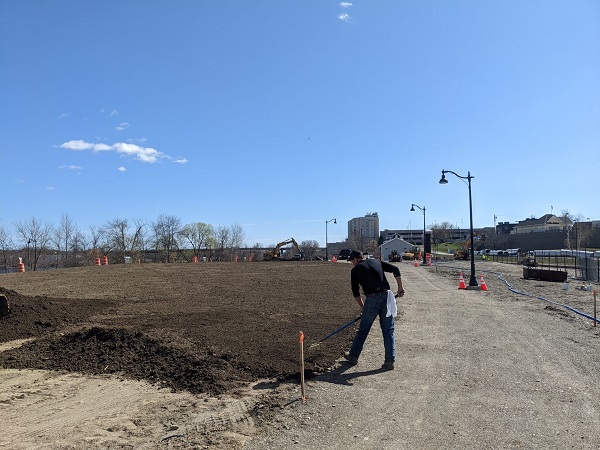
S.E. MacMillan began loaming, seeding and mulching the area of the Tank site over the Tank top and between the walkways on Monday, May 2nd.
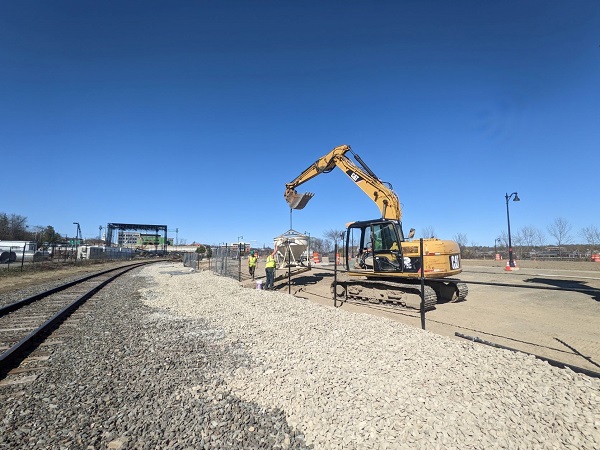
On Tuesday, May 3rd, MacMillan placed concrete for every fourth fence post hole along the railroad right-of-way fencing.
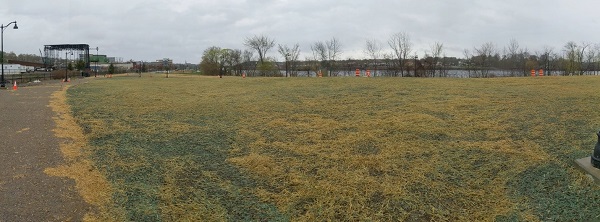
Lyford Hydroseeding was on site on the 4th of May and hydroseeded over Macmillan’s seed and mulch.
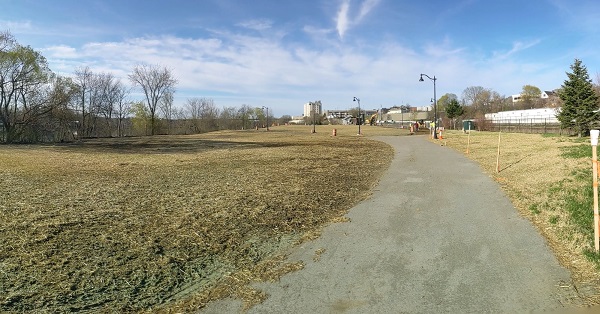
By Friday the 6th , SEM had finished loaming, seeding and mulching from the north end of the site to the electrical building and sediment pond.

SEM began fine grading the walkways on Friday May 6th.
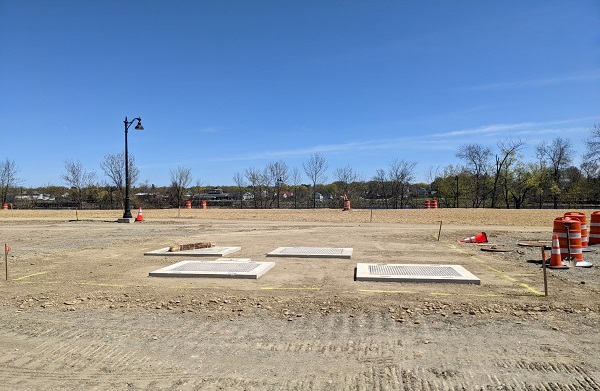
SEM fine graded the walkway and driveway around the hatches for dewatering chamber #2.

Roundy Paving used 250 tons of mix to pave the walkways on May 11th.
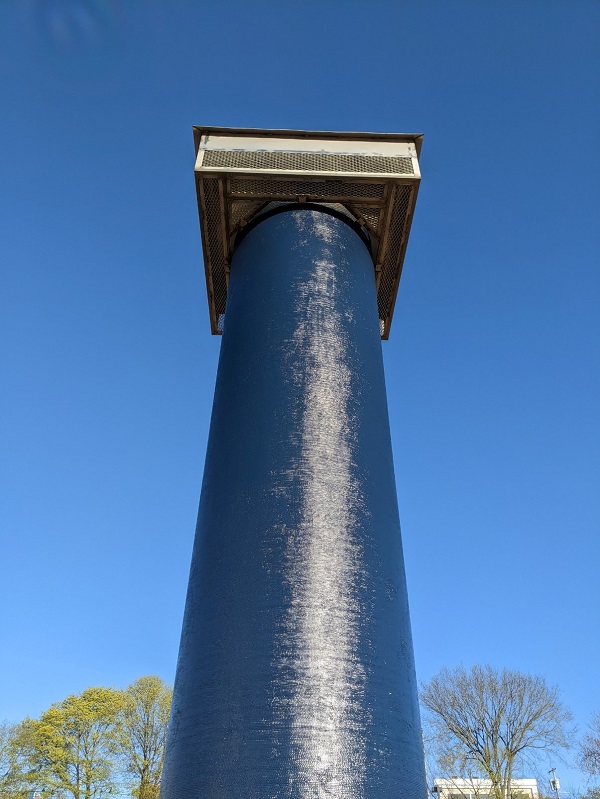
SEM painted the 48” diameter ductile iron vent stack Navy blue.

Express Electric installed the new control cabinet and wired the Rotork actuators for the 42 and 48-inch slide gates.
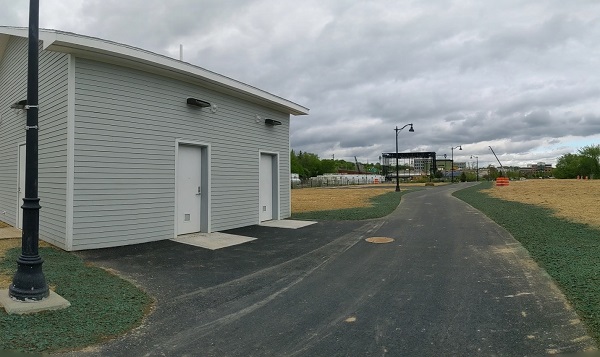
MacMillan touched up the loam and seed around the entire walkway and Lyford hydroseeded on Friday, May 20th.
Work Completed 4-18-22 to 4-29-22
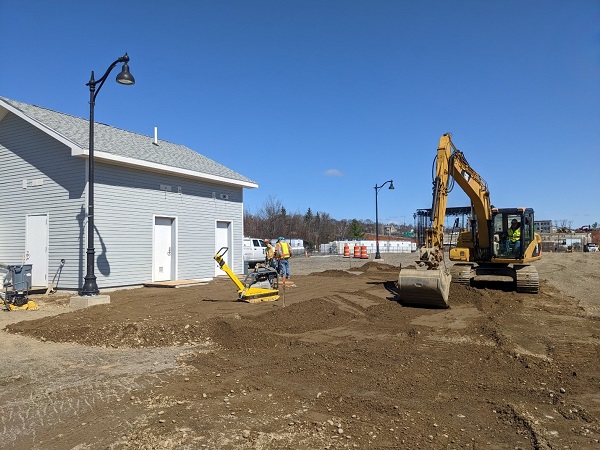
On Monday, April 18th Express Electric worked on wiring inside the CSO electrical building. S.E. MacMillan graded the walkway in front of the electrical building and began loaming, seeding and mulching on the north end of the site.
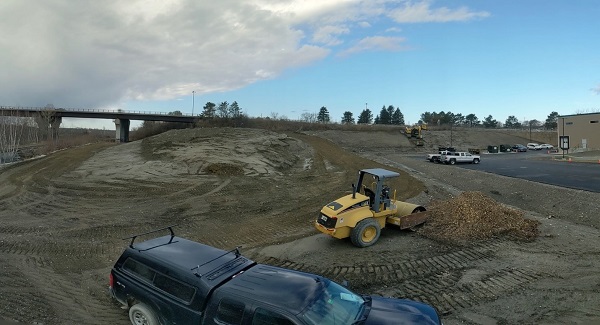
SEM started grading the Roundhouse fill site behind Geaghan’s brewery expansion. Some areas of the stockpile are too wet to grade and SEM has been trying to reach and smooth those areas with an excavator so water will shed rather than collect and further saturate the fill.
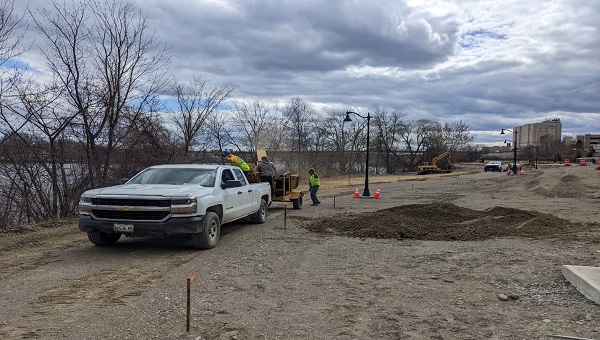
SEM loamed, seeded and mulched an area north of the Tank and along the east side. Lyford Hydroseeding hydroseeded over SEM’s mulch.
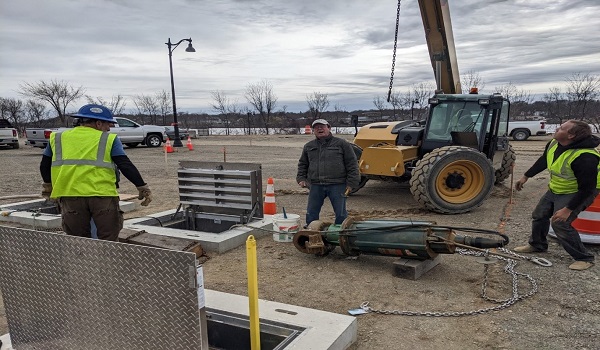
Representatives from Vaugh Pumps, Rotork Actuators and Grande Tipping Buckets were on site Tuesday the 26th. They performed some inspections and preliminary testing. All three chopper pumps were pulled, oiled, had impeller rotation checked and the pumps were reset into place. The pumps were run for a short while to verify that dewatering valves, flow meters and pressure sensors were all functioning. The tipping buckets were inspected on the inside of the three Tank cells and all nine tipping buckets were filled and dumped.
Wright and Pierce Engineering had a representative on site April 28th and 29th, working inside the PLC cabinet and checking on programing for SCADA communication between dewatering and water supply.
SEM successfully pressure tested the three-inch water supply line for the tipping buckets on August 28th.
Express Electric has completed all the process wiring and is nearly finished work on the CSO electrical building. They installed exterior and interior lights and emergency lights during the last week of April.
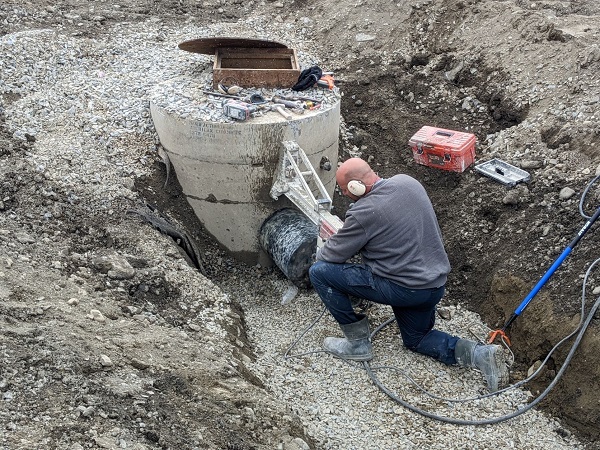
SEM began work on the sedimentation pond. Concrete Coring of Maine was on site to core a sixteen-inch hole for the pond drain structure.
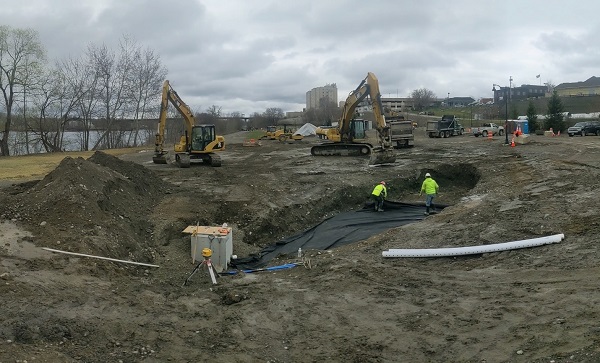
SEM excavated, put down filter fabric, underdrain piping and the soil media for the pond which will catch rainwater flow off the Tank’s grassed surface.
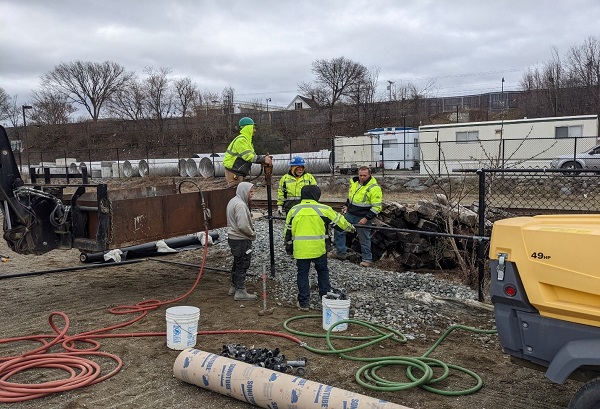
SEM began reinstalling the railroad right-of-way fencing on Friday, April 29th.
Work completed 4-11-22 to 4-15-22
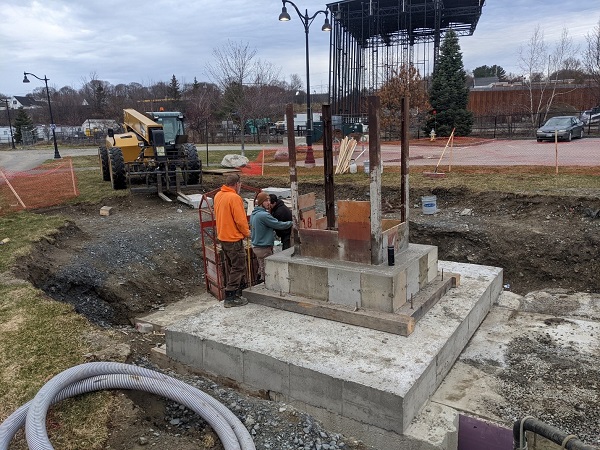
On Monday S.E. MacMillan placed the chimney walls for the north access hatch to the Davis Brook conduit. They stripped the forms on Tuesday and applied damp-proofing to the exterior face. SEM began final grading for the Roundhouse fill site this week.
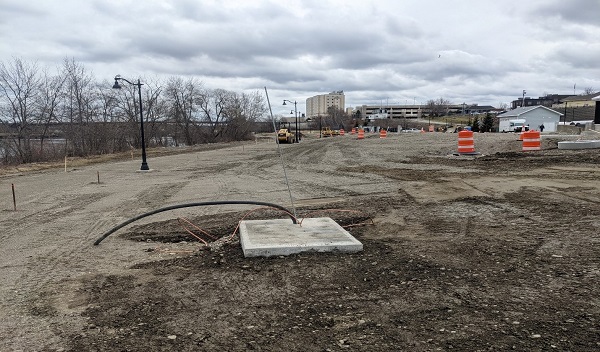
Express Electric pulled the two-foot by four-foot slab meant for the LP-3 cabinet and re-set a second one pre-cast by SEM measuring four-foot by five-foot. The LP-3 cabinet to be used by Parks and Rec is about seven feet tall and needed a larger base.
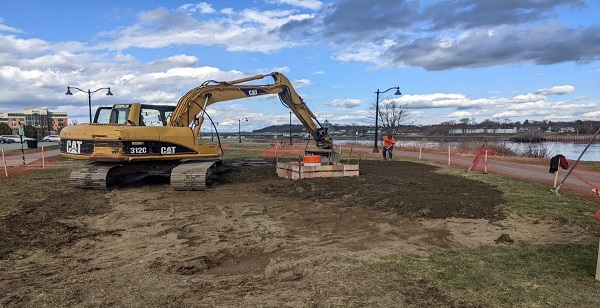
SEM placed forms to place concrete around the stainless-steel hatches in the north and south hatch access locations. The hatches are on order. They loamed, seeded and mulched up to the formwork.

Express Electric installed the meter socket and disconnect for the LP-3 cabinet. They spent most of the week wiring process equipment inside the electrical building.
Work completed 4-4-22 to 4-8-22
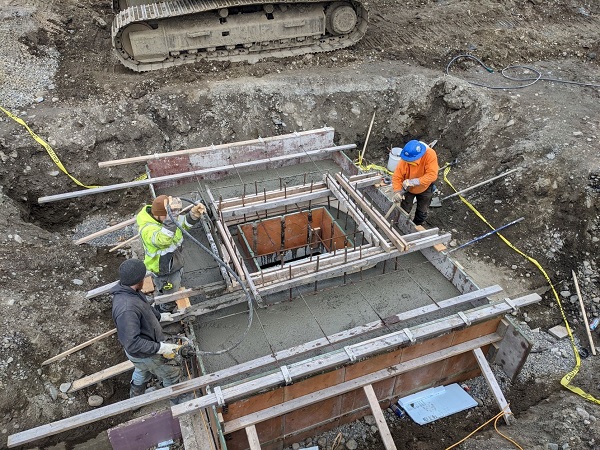
S.E. MacMillan placed eight cubic yards of Hughes Brothers concrete for the south hatch slab on Monday, April 4th. Alex Willard from S.W. Cole tested the concrete and took a set of cylinders.
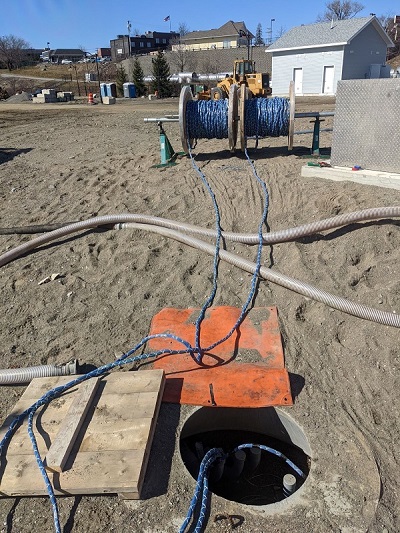
Express Electric continued wiring. They pulled wire for water supply valve actuators on Monday and Tuesday this week.

Versant Power was onsite Wednesday and Thursday. They pulled the primary cables, set the transformer and energized the service for the Davis Brook CSO Tank and electrical building.
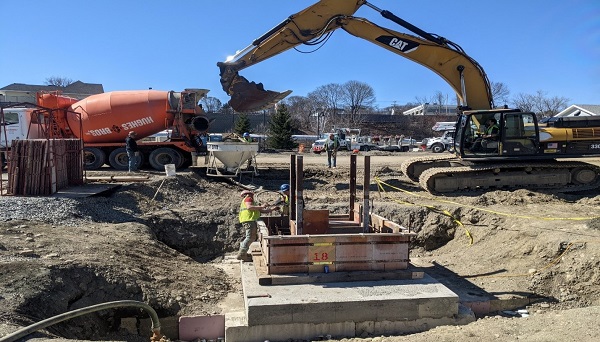
SEM placed Hughes Brothers concrete for the south hatch chimney walls which will support the stainless-steel access hatch.
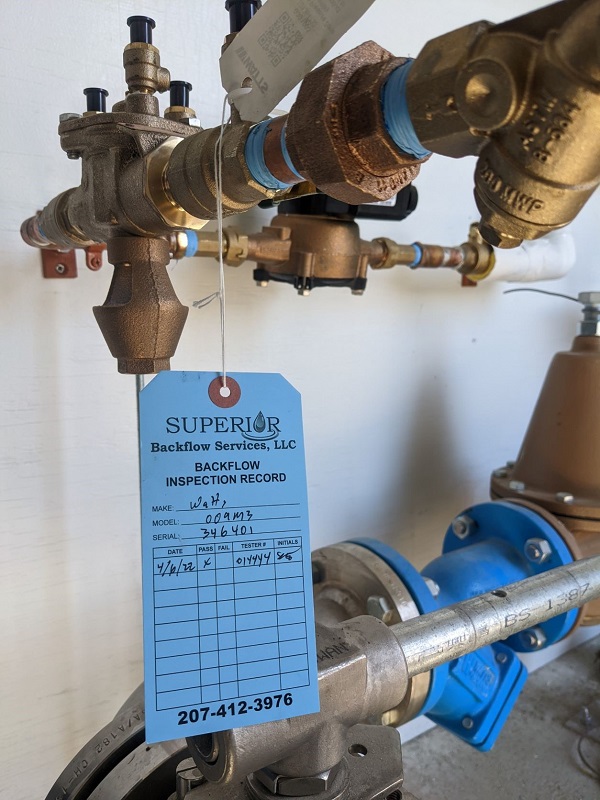
Superior Backflow Services visited the site Wednesday and tested the three-inch and ¾ inch backflow preventers in the water supply meter room of the electrical building.
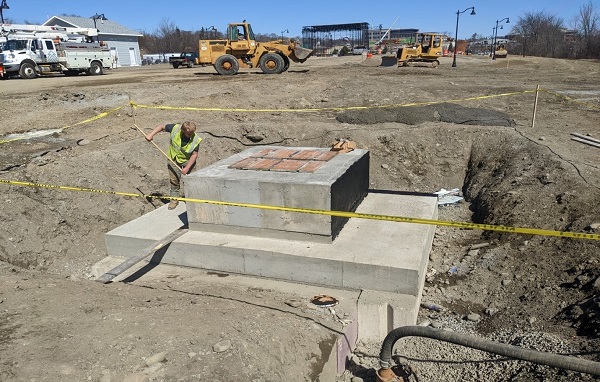
SEM stripped the formwork and damp-proofed the south hatch chimney walls.
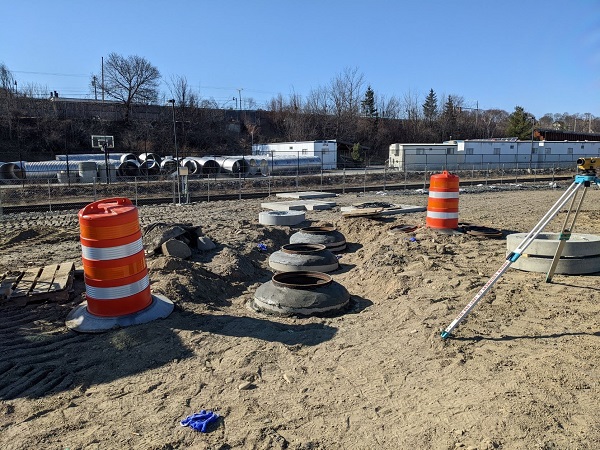
SEM set frames for the electrical handholes.
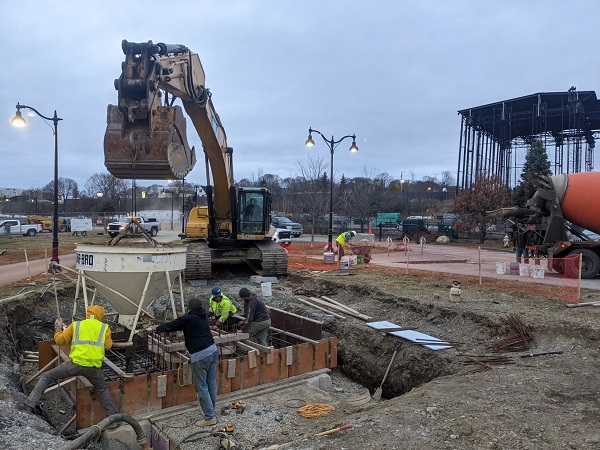
On Friday, ahead of the heavy rain later that day, SEM placed Hughes Brothers concrete for the north hatch slab. Logan Henderson, an S.W. Cole technician tested the concrete and made a set of cylinders.
Work completed 3-28-22 to 4-1-22
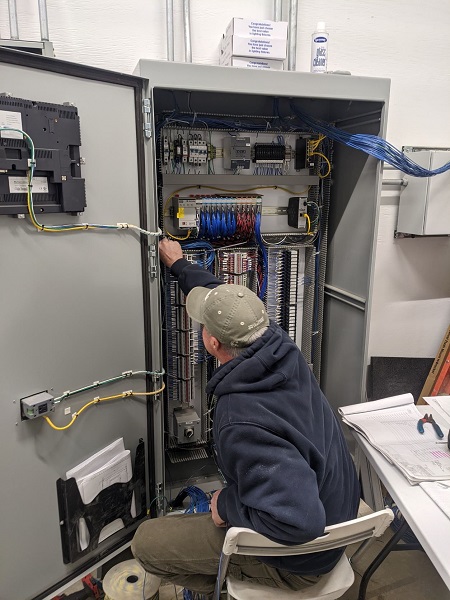
Express Electric worked during the early part of the week wiring for tipping bucket actuators inside the PLC control panel.
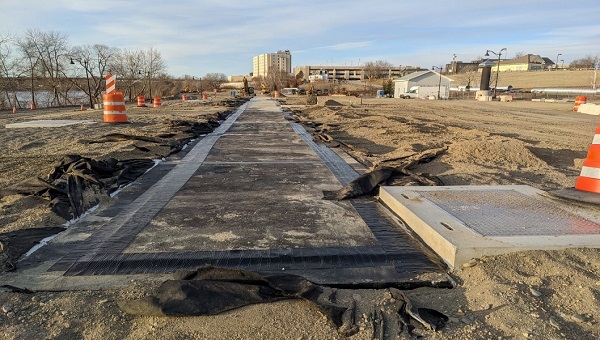
S.E. MacMillan uncovered the precast concrete planks covering the tipping bucket bays in order to re-seal their Tank contact points. These seams were dripping water inside the Tank this winter.

SEM set the last light pole base on the south end of the site. All the light poles are in place, wired and operational, although they will remain turned off until all the site surface restoration is complete.
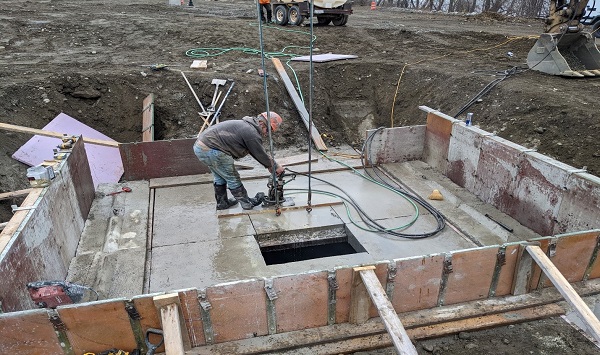
SEM began work on the two new hatch entrances on the 8’x9’ Davis Brook conduit.
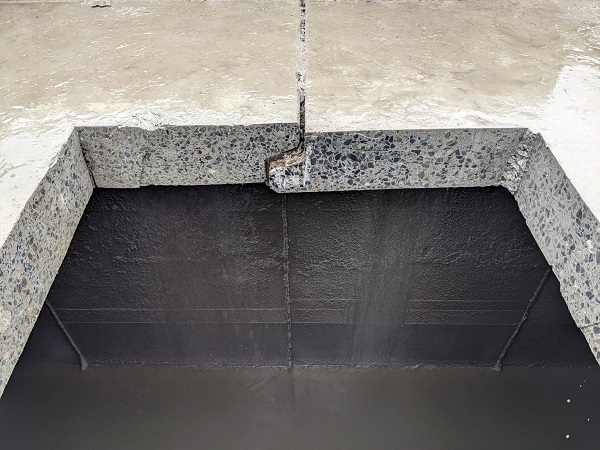
They cut a three-foot by four-foot opening in the precast box culvert. This conduit was built in 1999 using rectangular precast pieces eight feet wide, nine feet tall and eight inches thick. The seams were sealed with an asphalt-based gasket.

SEM began final grading of the site base prior to putting down loam. Loam and seed will start in mid-April.
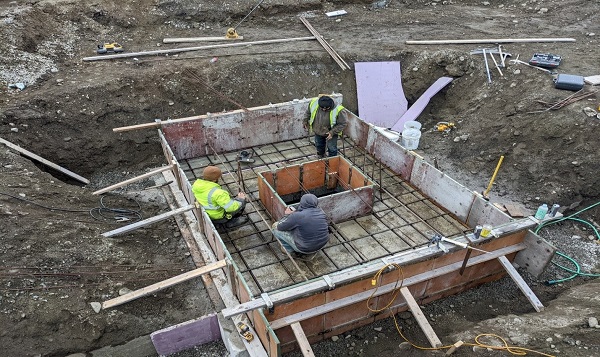
The south hatch entrance was formed and reinforcement steel was tied.

The slab being placed over the Davis Brook conduit will span the conduit. Large concrete blocks were placed against the conduit and reinforcement steel was doweled into the blocks so that the reinforcement mats span over the top of the precast conduit. Insulation was placed between the top of the conduit and the bottom of the slab for structural separation. This new slab will act as an arch and support the chimney which the new aluminum hatch entry will rest on. SEM will place the south hatch slab on Monday.
Davis Brook CSO Storage Tank
Work completed 3-21-22 to 3-25-22
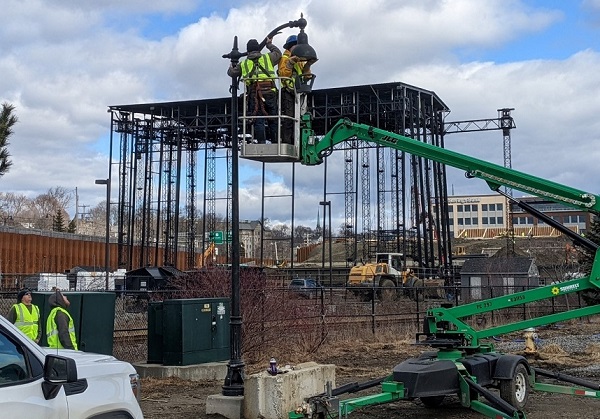
S.E. MacMillan started setting light poles on Monday the 21st. A separate crew continued setting new concrete light pole bases and a third crew began pulling wire under the supervision of electrician Scott Kenny.
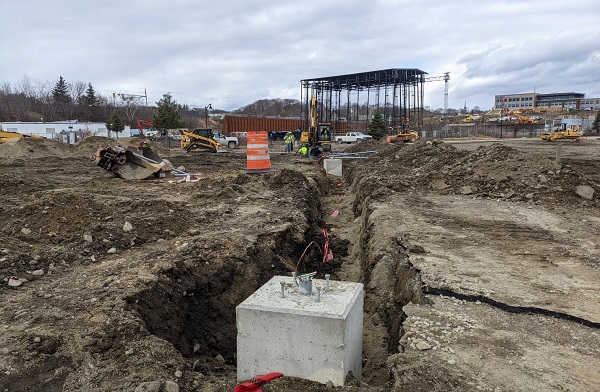
There were twenty-four bases and poles inside the Tank site, sixteen of them were planned to be relocated because of the new Tank excavation and another eight were moved because of their proximity to the work and the potential damage due to construction traffic.
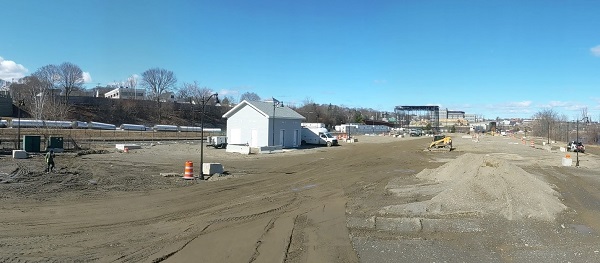
The Tank site is drying as the frost is coming out of the ground. SEM has encountered less frozen ground this week while excavating for light pole bases.
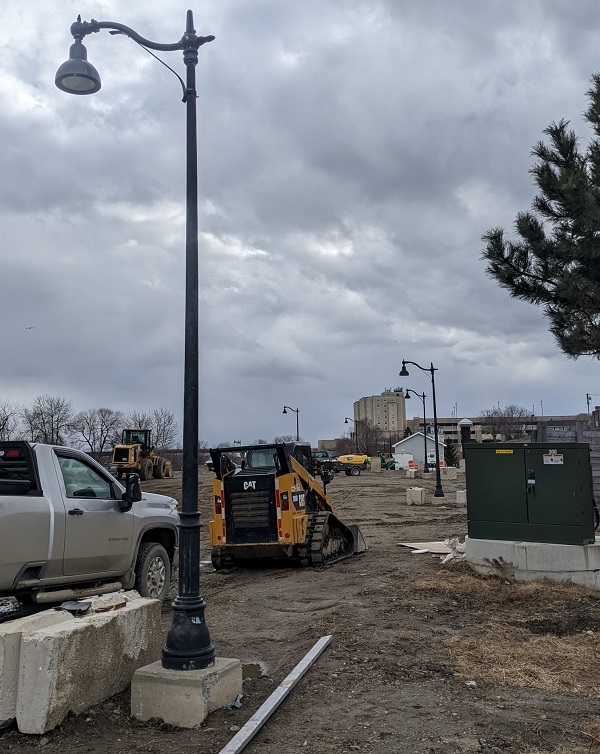
Work will begin next week on the north end of the site to build the new paved walkway which will pass along the edges of the bases.
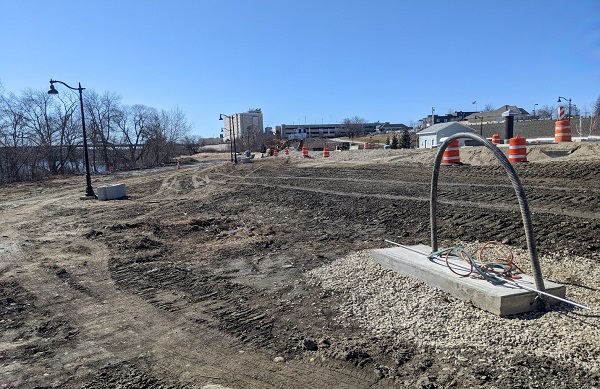
Express Electric worked with SEM to set the pre-cast pad for the new electrical cabinet near the northeast Tank corner.

Express Electric worked inside these 480V (left) and 120V(right) cabinets this week wiring valve actuators, heating units, lights and receptacles.
Davis Brook CSO Storage Tank
Work completed 3-14-22 to 3-18-22

Express Electric worked this week on wiring in Dewatering Chamber #2. They pulled wire to power gate valve flow control actuators, pressure gauges and the flow meter. In order for the pumps to operate as designed the flow and pressure of the discharge has to be measured constantly and the flow control gate valve adjusted accordingly to allow the pumps to run in a smooth rpm with minimal surge.

Express Electric will have Dewatering Chamber #2 ready for power by the end of next week. Versant Power is expected to be onsite before the end of March to pull the primary cable, set the new transformer and energize the service.
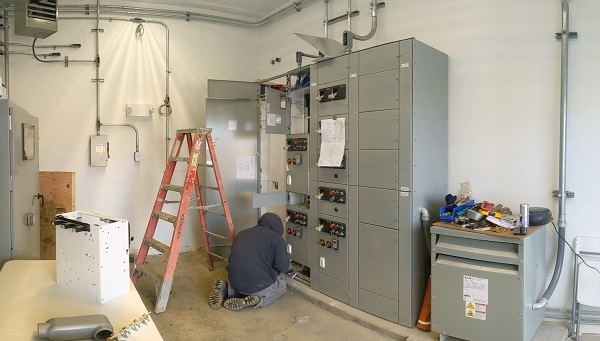
Dylan Fortin connected the Main Breaker section of the Motor Control Center which arrived this week. The delivery was a couple weeks early. Express Electric dismantled the temporary disconnect they had assembled and began wiring in the Main Breaker and connecting it to the rest of the MCC.

S.E. MacMillan began work on light poles. They precast fifteen light pole bases on site this week.
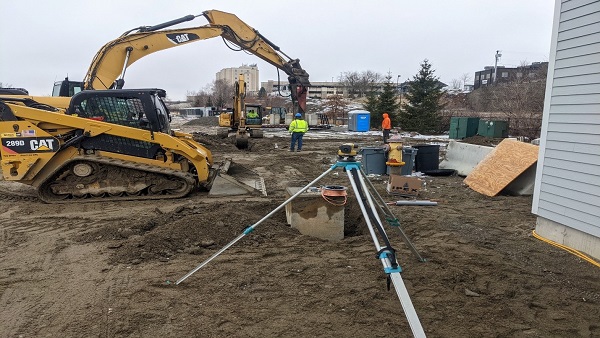
SEM also began setting bases and laying conduit, ground rods and ground wire. Scott Kenny supervised the installation while rewiring light pole lamps on site.
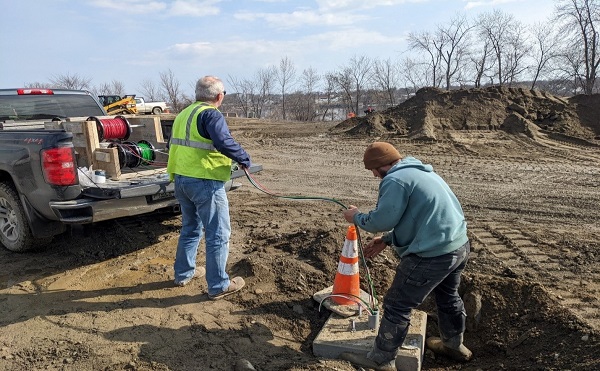
On Friday Scott Kenny and SEM pulled wire for ten light pole bases.
Davis Brook CSO Storage Tank
Work completed 3-7-22 to 3-11-22
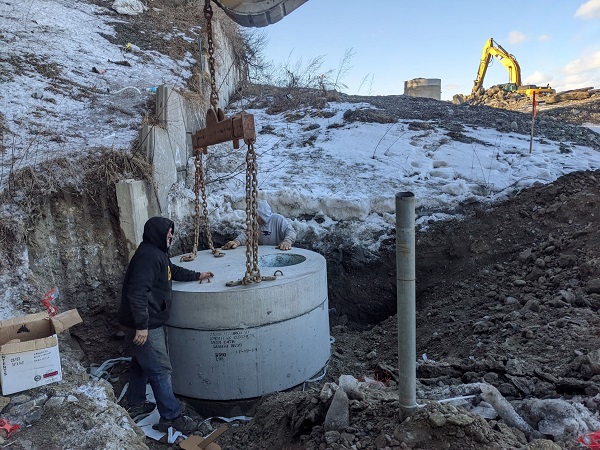
Sean MacMillan and Rick Merrithew added a barrel section and new flat top to an existing drainage structure at the base of the retaining wall and abutment for the I-395 Penobscot River Bridge. S.E. MacMillan has begun final prep work for final filling and grading of the Roundhouse fill site. The Roundhouse site is the former location of the locomotive engine garage, or “roundhouse” for the Maine Central Railroad. The City of Bangor took ownership of the Roundhouse site and most of the Maine Central waterfront property in the early 1990’s.
Thornton Construction, as part of their work on the Maine Savings Amphitheater concert venue, has started hauling excess material to the Roundhouse site.

MacMillan built forms to pre-cast five concrete pads, four of which will serve as entrance pads for the electrical building, the fifth will be support the building’s air conditioning unit. With completion of most of the work inside the Tank, MacMillan is focusing on outside work which can be accomplished prior to frost coming out of the ground. They concentrated this week on site clean-up and moving material and equipment off-site.
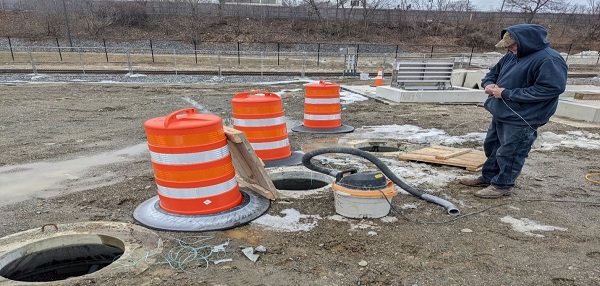
Express Electric installed pull strings and pulled wire from the Motor Control Center to dewatering chamber #2 hand holes and then into the dewatering chamber itself.
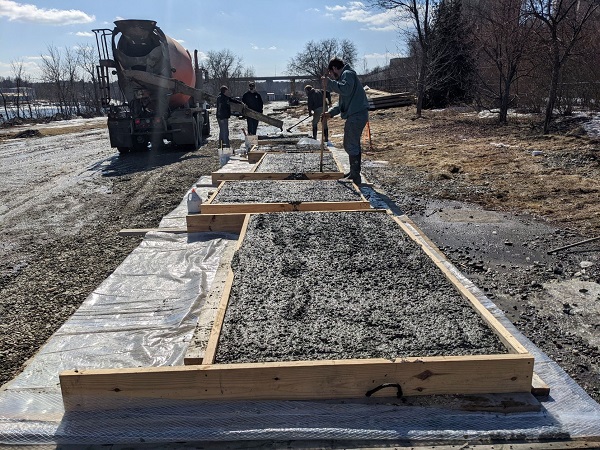
MacMillan placed concrete for the five concrete pads, finished, insulated and covered them.
Davis Brook CSO Storage Tank
Work completed 2-28-22 to 3-3-22

S.E. MacMillan worked inside the Tank this week on grinding down rough concrete edges and patching over areas where temporary formwork anchors have been removed. In the photo above Ian Hotham is footing the ladder for Rick Merrithew while Rick installs proximity switches on the tipping bucket bearing plates.
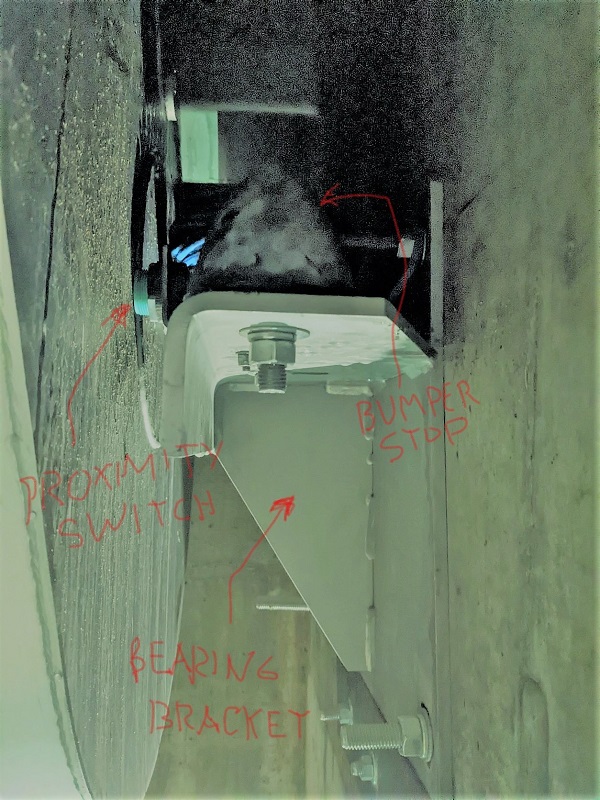
This photo shows a tipping bucket on the left and the green proximity switch which is threaded into an L-bracket mounted on the bearing plate of the bearing bracket. There are two bumper stops, one on each side of the bearing bracket, each is a dense rubber nodule which is a shock absorber-stop for when the tipping bucket is empty and at rest and when it has tipped and dumped. The face of the proximity switch needed to be exactly ½” from the side of the tipping bucket.
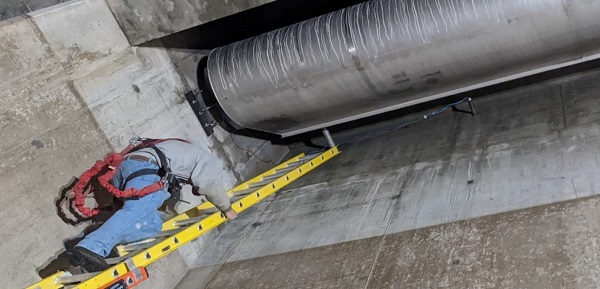
Rick Merrithew and Seath Fortin used a snake inserted into the conduit from the water supply chambers to pull the proximity switch wire from the Tank into the water supply chambers. Each tipping bucket has a proximity switch for monitoring flush activity. These switches are wired to the PLC or Programmable Logic Controller where Tank function information is gathered and sent to operating technicians at the Waste Water Treatment Plant.

The large cabinet on the right is the Programable Logic Controller.

Express Electric installed the electrical panel for the Parks and Rec side of the electrical service. Next to it mounted on the wall is the hot water heater for the bathrooms.
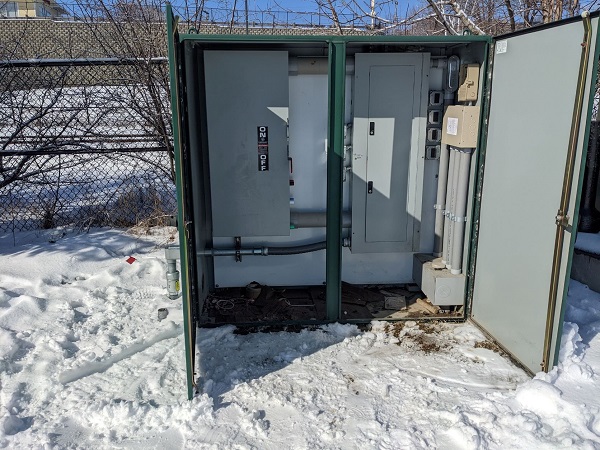
The Parks and Rec service is fed from the existing panel and cabinet installed in 2008 during the second phase of Waterfront Park development.

Express Electric installed a temporary disconnect in order to have a temporary fused entrance when the service is energized. The main breaker for the entrance is not scheduled for delivery until early April.

Wall mounted electric heaters were installed in both bathrooms this week. At the end of the week Seath and Dylan Fortin, from Express Electric, began pulling wire for lights, receptacles and heaters.
Davis Brook CSO Storage Tank
Work completed 2-21-22 to 2-25-22
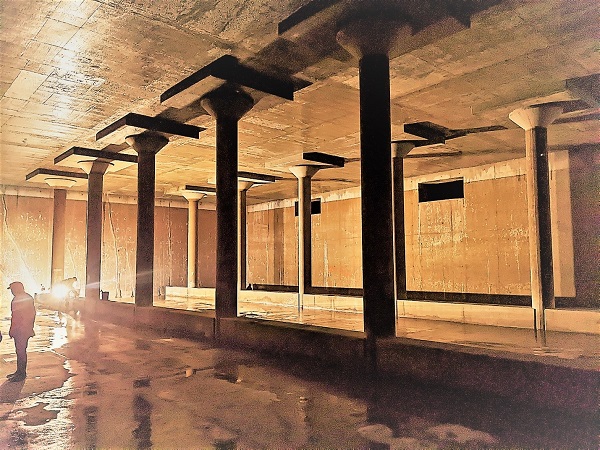
S.E. MacMillan had a crew working inside the Tank all week; grinding rough concrete edges, removing epoxy injection fittings, filling injection fitting holes in the base slab with hydraulic cement and drilling more holes in the base slab of Tank Cell #3 for more epoxy injection.
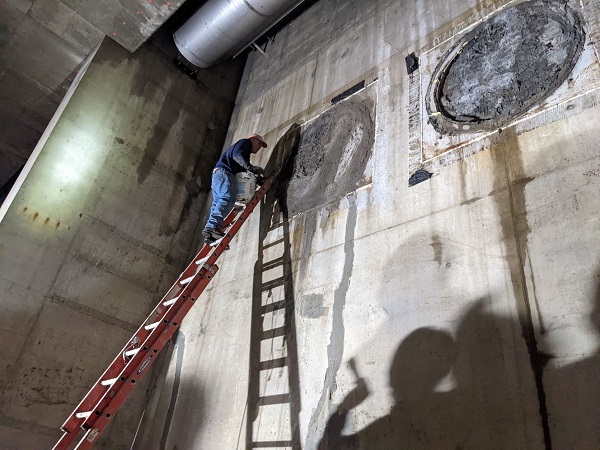
Rick Merrithew applied coats of hydraulic cement onto both plugs of the 48” Tank inlet pipes. Both of these masonry plugs have been leaking during high-flow events in the Davis Brook box culvert due to recent rain and snow melt.

The above photo is Tank Cell #3, water on the floor is a combination of cleaning water, condensation dripping from the ceiling and some ground water bleeding up through the Tank base slab.

On Tuesday, Paul Buchanan of Buchanan Mechanical, installed a ¾” copper water line for an exterior hose bid outside of the water meter/storage room door.
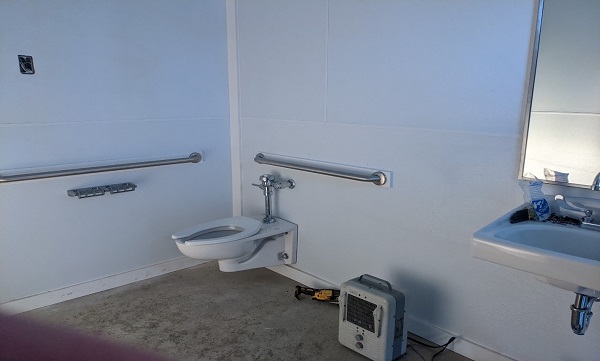
Paul installed the lavatories and toilets in both bathrooms and Earl Grover mounted mirrors, grab bars, soap and paper dispensers.
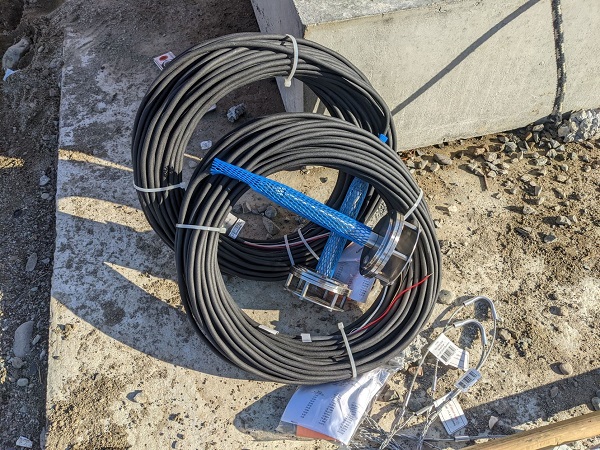
Express Electric erected both transducer cabinets for dewatering chambers 1 and 2. Seath and Dylan Fortin pulled wires for both Cell #1 sump transducers from the transducer cabinet into dewatering chamber #1. They hung the transducers into the Cell #1 sump and pulled the wire from the Tank into dewatering chamber #1.
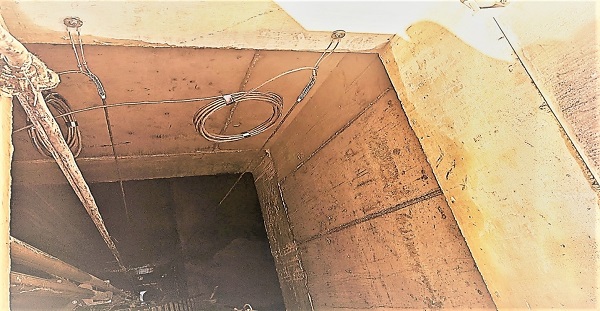
The transducer wires were mounted to the hatch skirt concrete above the Tank chimney riser wall with drop-in anchors and supported with steel drop mesh cable for stress relief. The transducers hang roughly 35 feet below the hatch skirt at elevation -12.17.
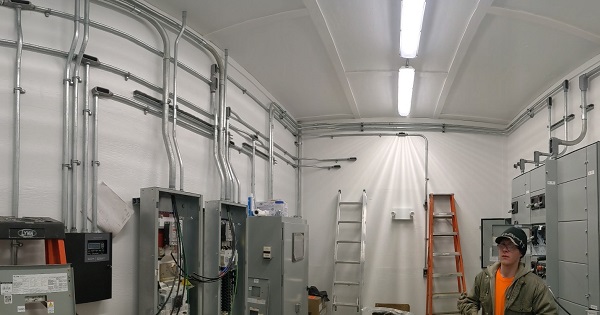
Express Electric installed a temporary power disconnect which will be necessary for a short while after energization by Versant which will allow for lighting and heating of the electrical storage building. Seath Fortin said once the main breaker arrives and is installed (back ordered and due about April 1st) the temporary disconnect will be removed. Conduit work connections for Motor Control, transformer, lighting, water supply actuators, fire alarm, programable logic and radio control inside the electrical room is near complete.
Wednesday, the 23rd had a record high sunny temperature in Bangor of 65 degrees. It was welcome but recognized as a tease as the high on Friday the 25th was 12 degrees and work was suspended at noon due to heavy blowing snow.
Davis Brook CSO Storage Tank
Work completed 2-14-22 to 2-18-22
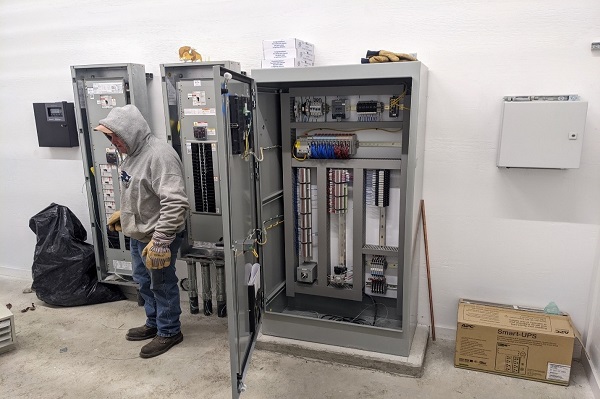
This week Express Electric worked inside the electrical room, they set the Programable Logic Controller (PLC) in place along with the fire alarm panel and the radio control panel. The PLC is an industrial computer which will allow automated control over the Davis Brook CSO pumps, valves and tipping bucket flushing systems. Technicians at the Bangor Waste Water Treatment Plant can remotely communicate with and control the Tank’s functions through the PLC. In the photo above the PLC is the largest cabinet to the right-center, to the left center is the 120-volt lighting/receptacle panel and left of that is the 480-volt distribution panel powering the flow control valves in the tipping bucket water supply chambers. The small black panel on the far left is the fire alarm panel and to the far right is the radio control panel.
With bathroom plumbing rough-in complete, S.E. MacMillan worked on insulating and finishing the south bathroom chase walls. They had a crew inside the Tank grinding rough concrete edges and cleaning. They did not receive the SIKA Epoxy for crack plugging they needed until Friday afternoon, next week they expect to complete the epoxy injection in the base slab.
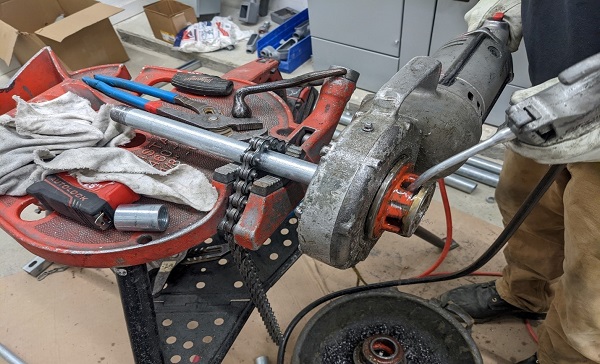
Dylan Fortin cut, bent and threaded steel conduit inside the electrical room for mounting to connect power panels and the PLC with actuators, valves and sensors.
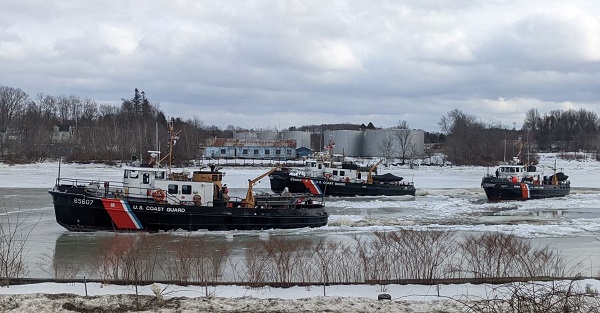
The US Coast Guard was in the Penobscot River again this week.

By the end of the week, Express Electric had better than half of the conduit connections installed inside the electrical room for fire, power, PLC and radio wiring. They expect to have the electric service meter socket inspection from City Code Enforcement next week and they’ll schedule primary power cable to be pulled, the transformer set and the Tank service electrical service energized by Versant in early March.
Davis Brook CSO Storage Tank
Work completed 1-31-22 to 2-11-22
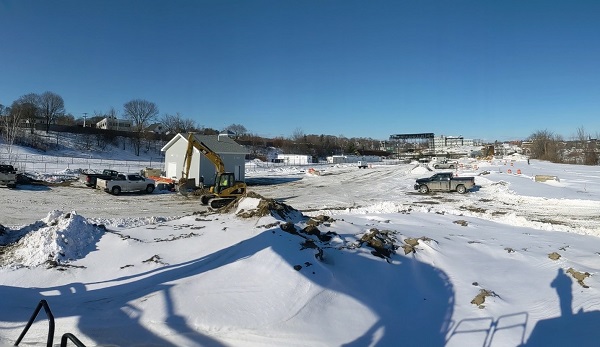
On Monday, January 31st S.E. MacMillan cleaned up the nineteen-inches of snow that fell on Saturday. Express Electric had two men bending and mounting conduit inside water supply chamber #3. SEM had a crew inside Tank Cell #1 prepping to inject epoxy into shrinkage cracks in the base slab. There is a small but regular amount of ground water weeping into the Tank through these cracks. MacMillan will use the same method and material to plug these leaks as they did with the Tank walls during pre-backfill leak testing.
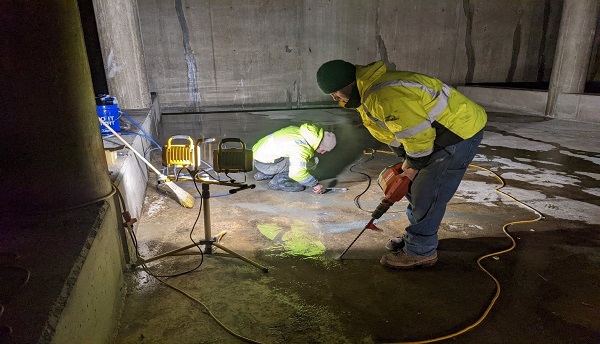
SEM drilled holes approximately ten inches deep into the slab where injection fittings are inserted.
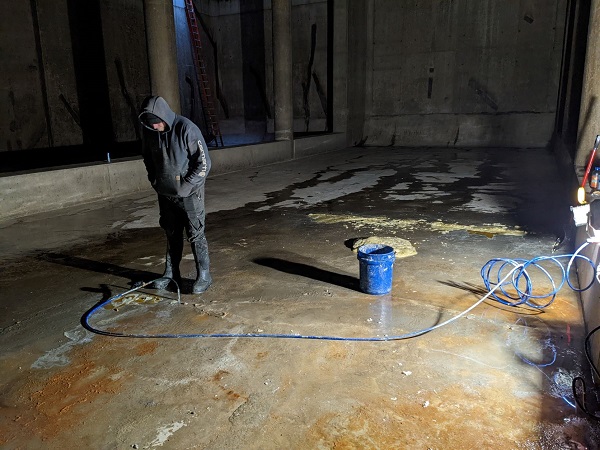
They drilled holes into the concrete at about 45-degree angles and alternated sides of the crack at about a foot on center. The injection fittings have a rubber gasket that expands when tightened into the ¼” holes. MacMillan is using Sikafix Epoxy, pump ing it through the injection fittings, into the crack until it surfaces. The epoxy travels in the crack, sets up and seals the leaks.
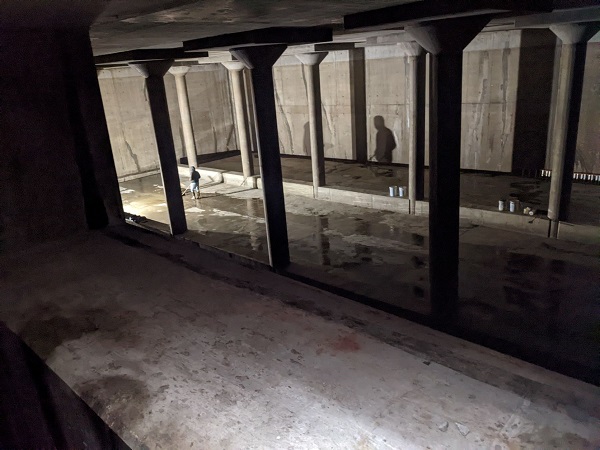
Above; SEM is cleaning Tank Cell #1 after completing epoxy injection.
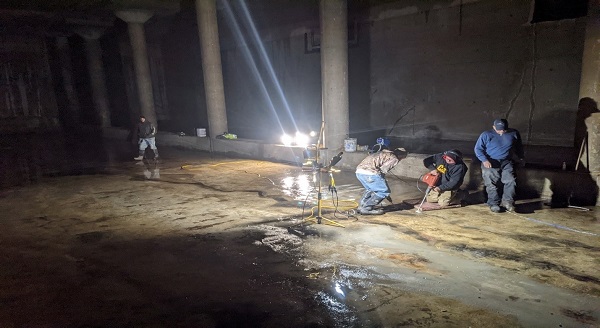
SEM started the same epoxy injection process in Tank Cell #2. Some of the moisture on the Tank floor has come from surface melt water leaking through the tipping bucket bays. The pre-cast concrete plank covers will need to be better sealed and final grading in the spring will keep water from puddling over them.

Above is Tank Cell #2; SEM drilled holes, set injection fittings and pumped in Sikafix epoxy sealant.
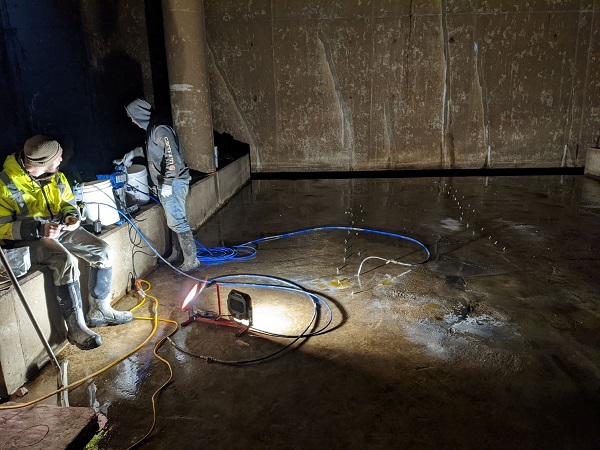
Above; in Tank Cell #2, there are two rows of injection fittings in the base slab in an alternating pattern on either side of a shrinkage crack. Ian Hotham connected the pump line and pumped epoxy into each of the fittings. SEM will need to continue with epoxy injection next week when they can take delivery of more Sikafix.
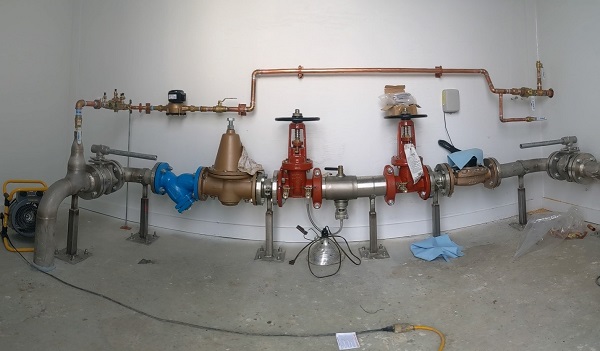
Buchanan Mechanical completed the ¾” water supply and installed the Bangor Water District’s meter.

Seath and Dylan Fortin from Express Electric installed cabinets for lighting and distribution along with setting into place the Motor Control Cabinet and the Programable Logic Cabinet.
Davis Brook CSO Storage Tank
Work completed 1-24-22 to 1-28-22
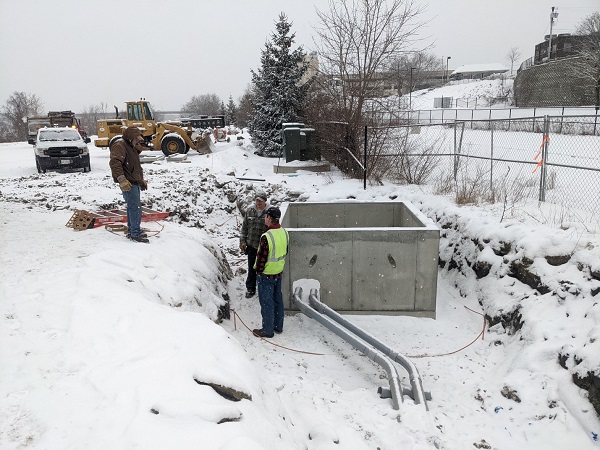
On Monday, January 24th, S.E. MacMillan excavated for and set into place the pre-cast electrical transformer base. Primary power will be fed through this structure and into the transformer to power the new Davis Brook CSO Tank, the site electrical storage building and public restrooms. Don King, from Versant Power was on site Tuesday to look at the base orientation, base drainage, conduit penetrations and grounding. Don indicated to Stanley MacMillan that once SEM has made a formal request for connection, Versant will need a couple weeks to schedule the pulling of conductors and setting the transformer into place. SEM anticipates primary power will be in place by the end of February.
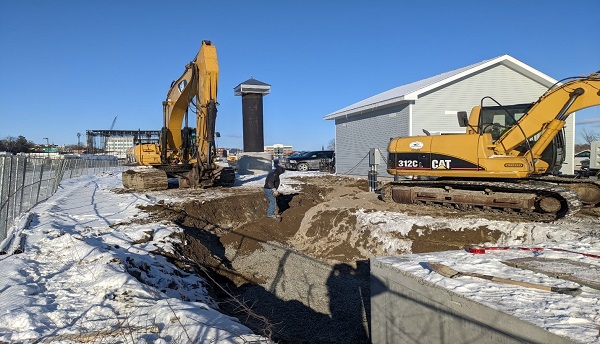
On the 26th SEM and Express Electric ran the conduit from the transformer pad to the meter socket.

The Coast Guard had three ice breakers on the river Thursday the 27th.
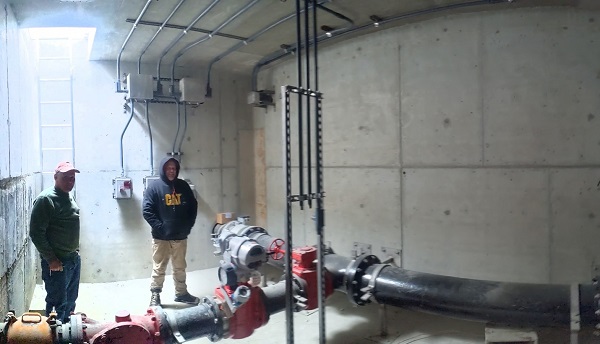
Express Electric has completed Unistrut, conduit and panel work inside both dewatering chambers.
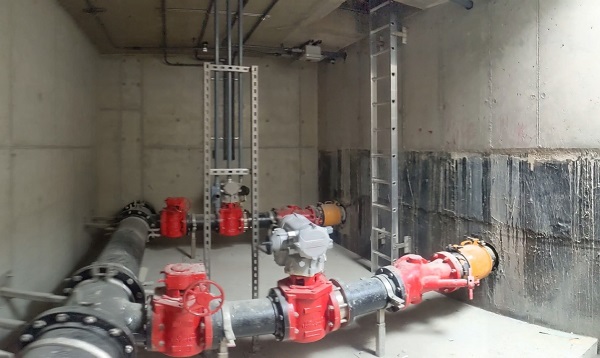
In dewatering chamber #2, Unistrut support, conduit and control panels are in place to power the gate valve actuators on the Tank dewatering lines. In the background of the above photo is the eight-inch dewatering line for Tank Cell #2, in the foreground is the eight-inch dewatering line for Tank Cell #3.
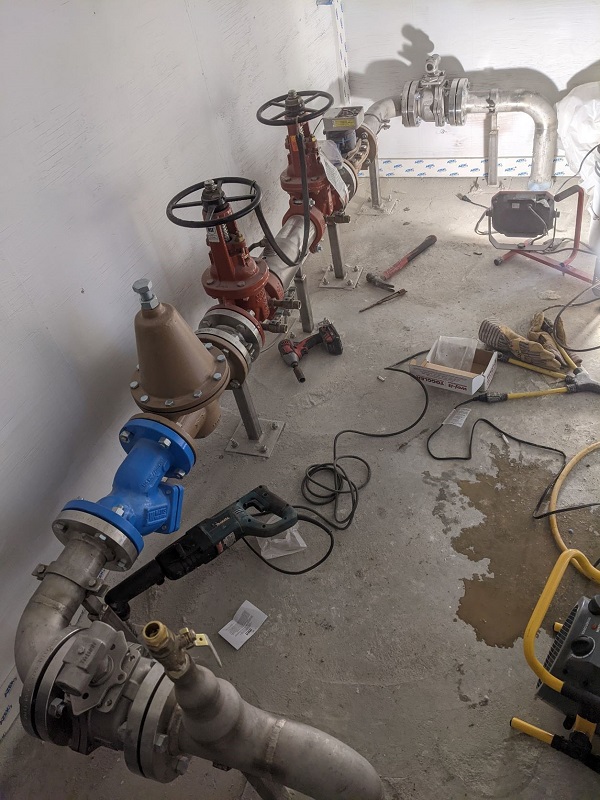
This is the three-inch water supply for the tipping buckets. Jeff Glidden fabricated the stainless-steel pipe supports and installed them this week. The ¾” riser off the three-inch stainless in the foreground will eventually feed the ¾” water supply for the public restrooms.
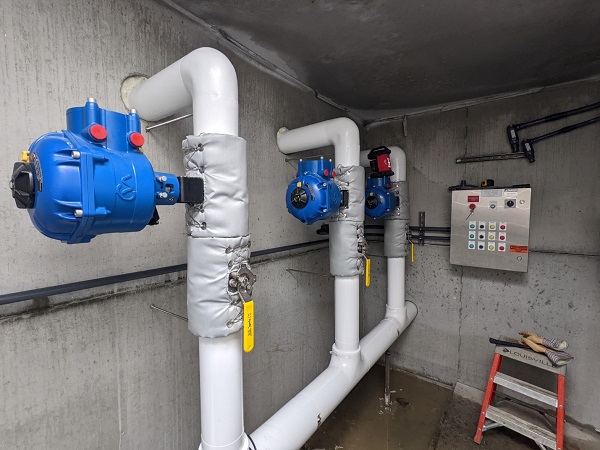
Damon Insulation completed insulating the three-inch and two-inch stainless-steel tipping bucket supply lines. This photo shows water supply chamber #3 with insulated supply lines, control panel and conduit. The blue valve actuators will be powered through the control panel mounted on the far wall. From left to right they control flow to the Tank Cell #3 tipping buckets in bays 3, 2 and 1.
Davis Brook CSO Storage Tank
Work completed 1-10-22 to 1-14-22

S.E MacMillan completed exterior trim and siding this week on the north gable end of the electrical/storage building.
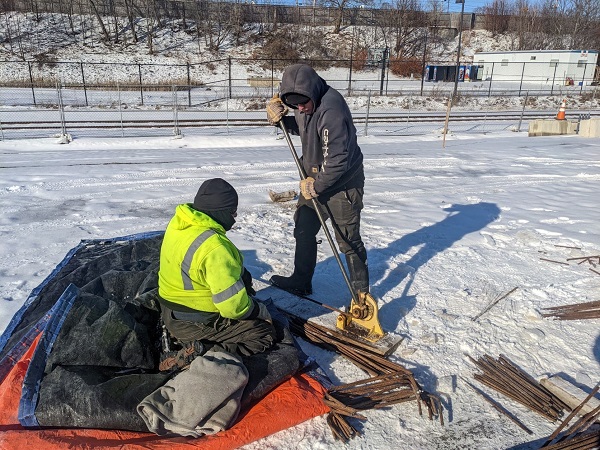
SEM cut and bent reinforcement steel for the Davit Arm manlift base sleeves.

They excavated, built cover and laid down glycol ground heat lines at the Davit base placement locations.
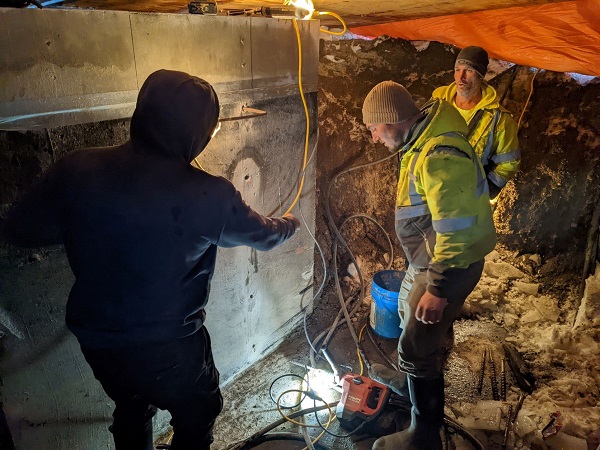
Concrete for three of the Davit base sleeves will be placed against the hatch chimney risers over the three main Tank Cells. The reinforcement steel was doweled six inches into the existing hatch chimneys and secured with an epoxy adhesive.

SEM used a glycol ground heater to heat the Davit base excavations and to heat the placed sleeve concrete during curing.

Jeff Glidden fit and tacked the stainless-steel pipe, fittings, screen and backflow preventer into place for the three-inch water supply entrance feeding the tipping bucket flushing system. SEM will have a certified welder from Sullivan and Merritt on site next week to make the finish welds.

The electrical/storage building’s exterior finish is complete.
Davis Brook CSO Storage Tank
Work completed 1-3-21 to 1-7-2
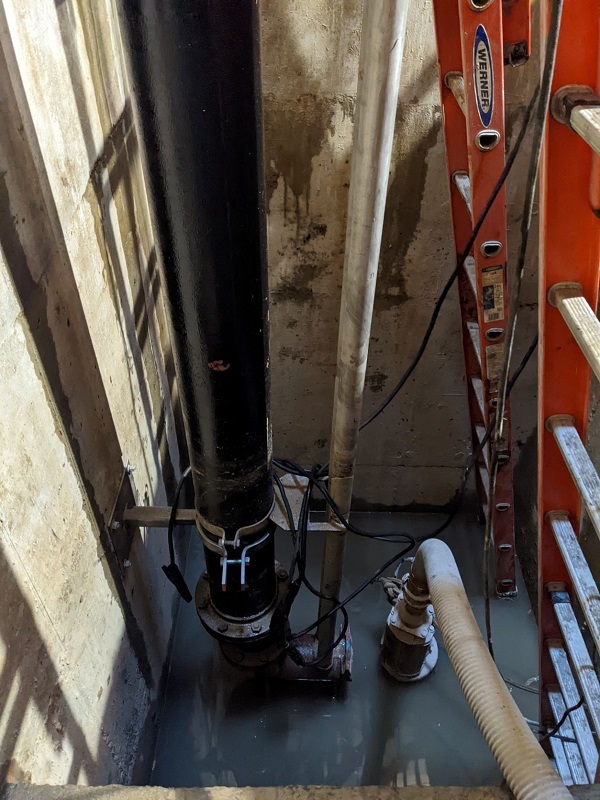
The last week of December S.E. MacMillan took delivery of four chopper pumps, one spare and one each designated for Tank Cells 1, 2 and 3. This week SEM installed the pumps.
SEM installed the last of the stainless-steel pipe support brackets which secure the eight-inch ductile iron discharge pipe and the two-inch stainless-steel pipe rail pump guides.
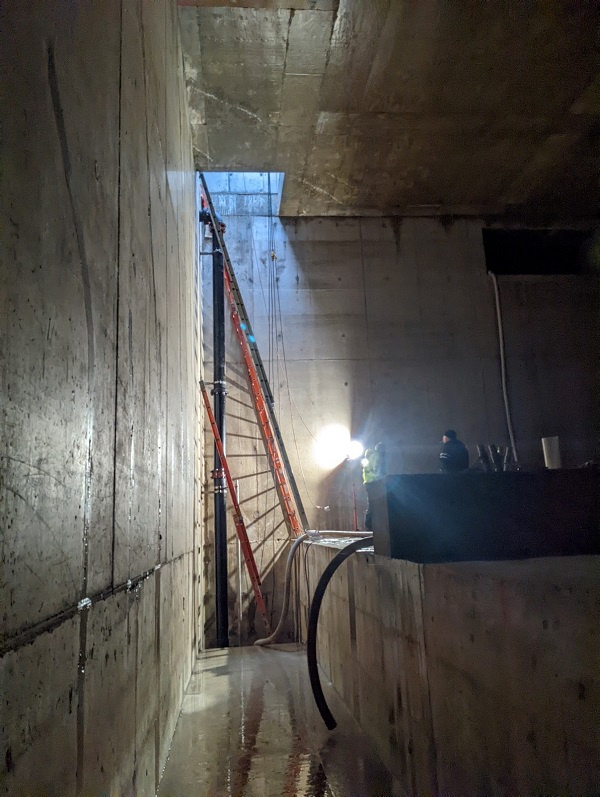
Tank Cell #2 as well as #1 and #3 has a sloped bottom with 1% pitch from below the tipping bucket flushing devices to the sump channel (seen above). The sump channel pitches about 2% from its’ high side to the chopper pump which is set into a sump that is about 4.5 feet deep.
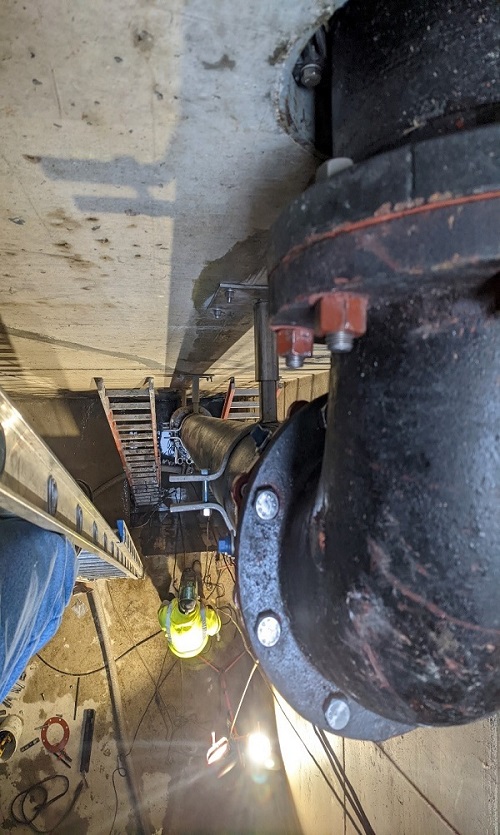
SEM’s welder, Jeff Glidden, fabricated the stainless-steel support brackets on site using Type 316 stainless-steel stock.
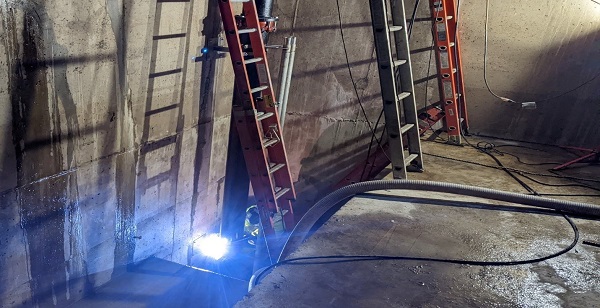
Pipe supports bolted to the pipe were sleeved into a footed bracket anchored to the tank wall and welded into place.
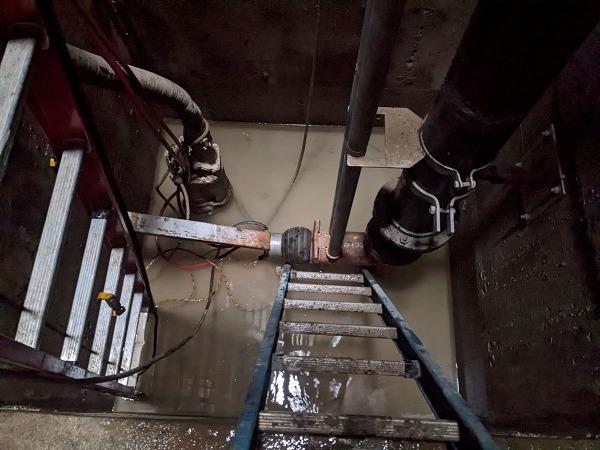
Ahead of the pump installation MacMillan completed final pressure testing on the dewatering pipe from all three pump pedestals to gate valves inside the dewatering chambers. They used a flow-through test ball to apply test pressure and seal the pedestal end.
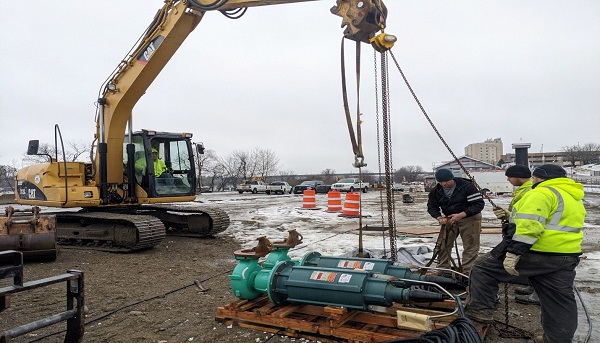
They used an excavator and a chain-fall rigged to the pump lifting bales to lower the pumps into place.
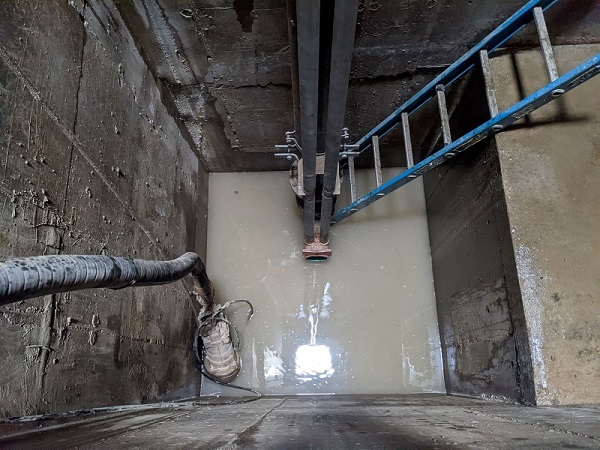
Each pump needed a small amount of pre-pumping to remove a few inches of water and expose the suction end of the pump pedestal.

The pumps came with guide rail adaptor brackets mounted to the horizontal discharge side of the pump.

This bracket slid easily into the guide rail system. Once the guide bracket and guide rail where connected the pump could be slowly lowered into the tank.

The guide rails are forty-feet long. They are bracket mounted to the Tank hatch ceiling, Tank wall and rest over nipples on the pump pedestal base.

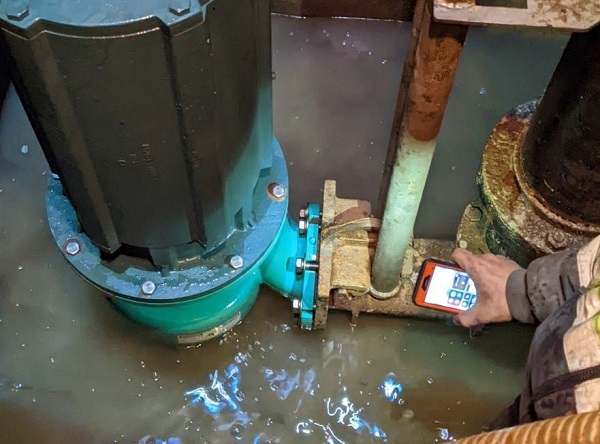
The pumps friction mount on the pump pedestal with the guide bracket coupling to the pedestal with a simple crimp stop which enables a non-mechanical removal process should a pump need to be pulled for maintenance or replacement. The pumps weight holds it in-place, tightly sealed on the pedestal. A top-retrieval lift-rig mechanism will be installed so pump removal can be done from above the Tank. This guide system to be installed will enable a hoist mechanism to hook and lift the pump off the pedestal and up the guide rails.
These are Vaughn submersible chopper pumps with Baldor 30 horse power, 460V motors. Together the pumps and motors weight 1451 pounds. They have a six-inch intake with an 6x8 pedestal reducer. They are rated at 1700 gallons per minute at 30’ TDH. The spare chopper pump has been delivered to the Waste Water Treatment Plant.
Davis Brook CSO Storage Tank
Work completed 12-13-21 to 12-24-21
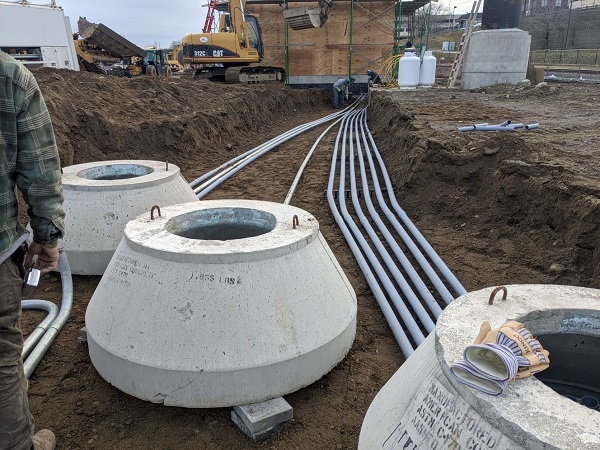
Together, during the second week of December, Enterprise Electric and S.E. MacMillan installed conduit and handholes for conduit from the electric building to both dewatering chambers

SEM cored openings for the twelve-inch dewatering pipe and the one-inch vent, connected both pipe into the Conduit with boots and placed concrete to support the 90-degree entrance into the Conduit. The six-inch electrical building 90-degree PVC sewer entrance into the conduit also received concrete for support with this placement.
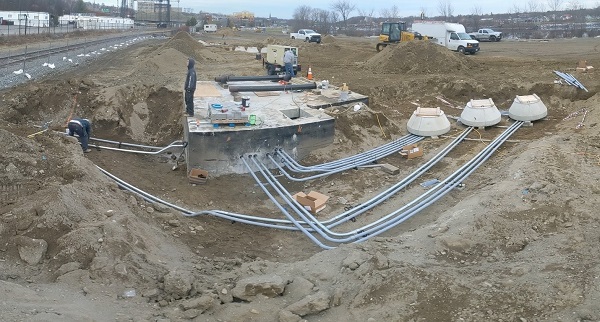
On the 15th of December Enterprise Electric finished connecting conduit into dewatering chamber #2.

SEM set the pre-cast hatches on the water supply and Tank Cells. SEM is waiting on the delivery of the Davit base sleeves for the Davit Arm confined space manlift system.
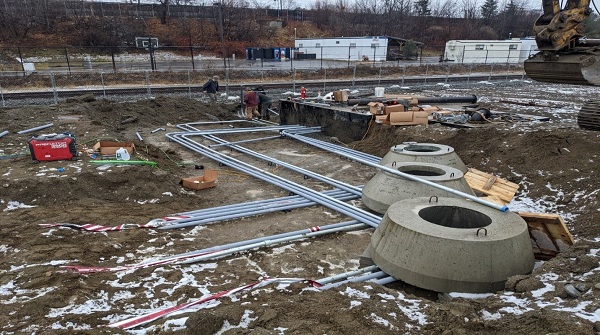
Connection of conduit to dewatering chamber #2 was completed on December 16th.

SEM finished installing sheathing, trusses, bridging, ceiling fur, wall top plates, rafter vents, roof shingles, rake trim, soffit trim, soffit vent and ridge vent by December 17th.
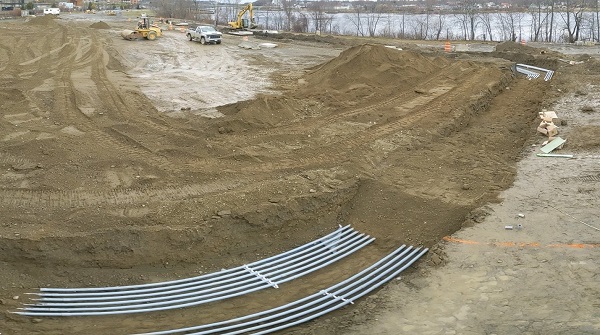
SEM and Enterprise installed the conduit run for the water supply chambers December 17th and 18th.

SEM placed concrete around and over the water supply duct-bank where the paved walk passes over.

The last week of December, SEM insulated and put on the vapor barrier inside the electrical building,
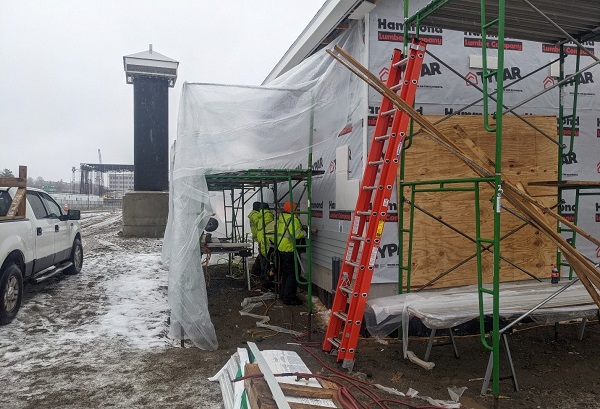
and began installing siding and electrical fixture mounting panels.
Davis Brook CSO Storage Tank
Work completed 12-6-21 to 12-10-21
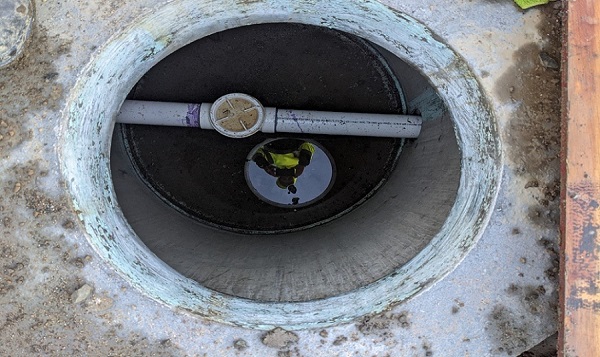
On Monday S.E. MacMillan set a manhole just outside the electrical building foundation. They laid six-inch schedule forty PVC pipe through the manhole, with a backflow preventer inside, all the way to the Davis Brook 8’x9’ box culvert sewer.
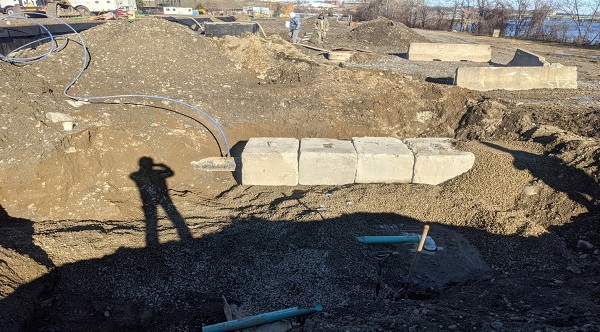
On Tuesday SEM successfully pressure tested all of the ten and twelve-inch dewatering pipe and connected the six-inch PVC electrical building sewer service into the 8’x9’ box culvert.

Enterprise Electric cored holes on Tuesday in the Tank for tipping bucket control monitors.
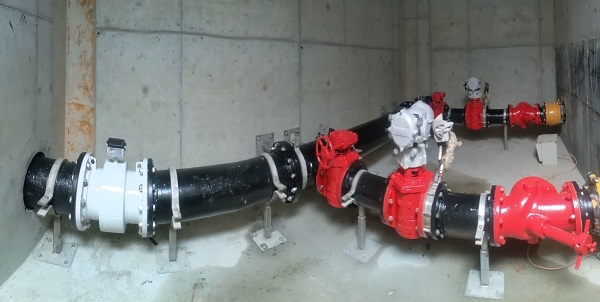
SEM, on Wednesday completed cleaning and paint touch-up for the dewatering pipe in both dewatering chambers.

SEM and Enterprise Electric laid four-inch PVC conduit for the primary electrical feed to the Tank and the electrical control building.

Earl Grover stood the premade wall panels on Monday and by Wednesday he and his crew were setting trusses for the electrical building.
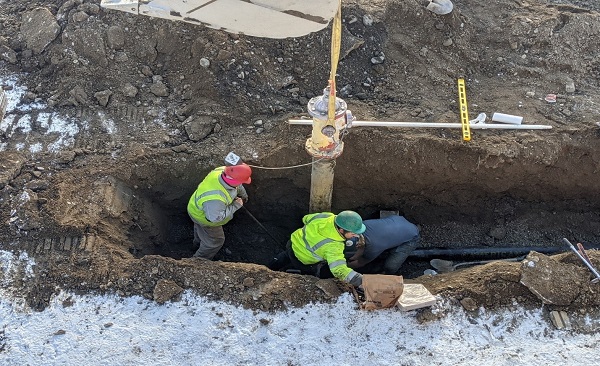
On Thursday SEM laid six-inch ductile iron water main from the 8x6 hydrant tee and set the existing Waterfront Park hydrant in the new location next to the electrical control building.
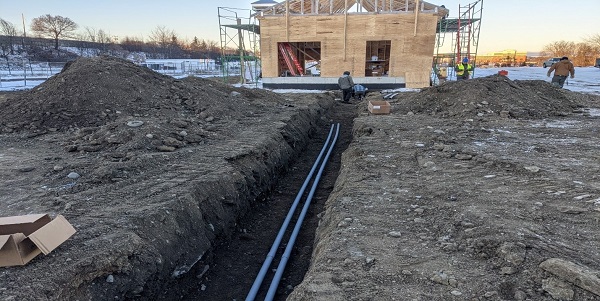
Also on Thursday, Enterprise Electric and SEM laid conduit for the Parks and Rec side of the electrical service into the control building. One side of the building will house electrical and SCADA control systems for the Tank, the other side will have two unisex public bathrooms.
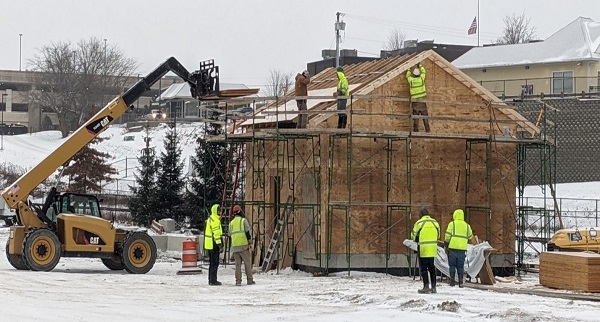
Friday, Earl and his carpenter crew began sheathing the control building roof.
Davis Brook CSO Storage Tank
Work completed
11-29-21 to 12-3-21
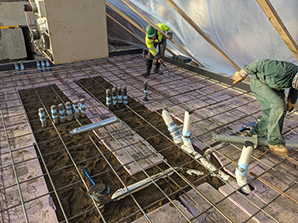
On Monday, Paul Buchanan, of Buchanan Mechanical, roughed in the plumbing for both bathrooms in the electrical building. On Tuesday S.E. MacMillan backfilled around the electrical and plumbing pipe and conduit, put down expansion joint and insulation. They tied a #5 bar reinforcement steel mat on one-foot centers.
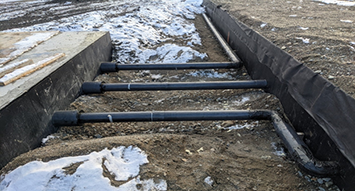
This week Damon Insulation insulated the two-inch stainless-steel tipping bucket supply piping for all three tipping buckets and water supply chambers.

Enterprise Electric cored holes in the Tank and in water supply chambers for electrical and SCADA control conduit access.

On December 1st MacMillan placed the slab for the electrical building.
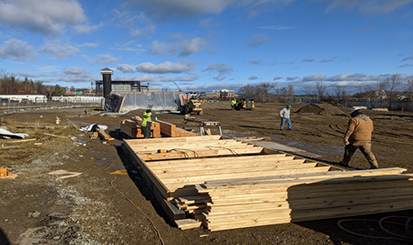
On Friday, Earl Grover, MacMillan’s carpentry sub started building walls to be set in place next week.
Davis Brook CSO Storage Tank
Work completed 11-15-21 to 11-24-21
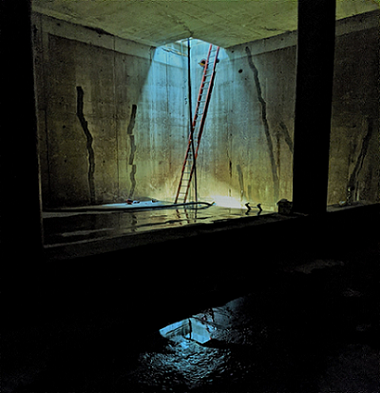
S.E. MacMillan continued installing the dewatering piping in Cell #1 and dewatering chamber #1. They set the pedestal for the chopper pump in the sump for Cell #1. They are waiting for some pieces of ductile iron pipe to arrive which have been delayed. All of the in-ground dewatering piping – aside from connection to the Davis Brook conduit – is complete.

Inside the Cell #1 sump channel Nick Hotham used a small electric pump to dewater the chopper pump sump. SEM drilled and epoxied wedge anchors into place for mounting the chopper pump pedestal. Pumps and vertical pieces of eight-inch ductile iron dewatering piping are expected to arrive after Thanksgiving.
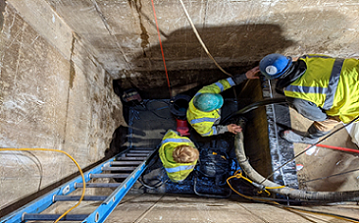
This is the sump for Cell #1, all three sump bottoms are the lowest points of the Tank, all three are at elevation -15.00, which is thirty-eight feet below finish grade.

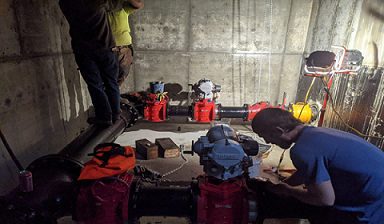
Inside dewatering chamber #2, MacMillan connected pipe, valves, actuators and flow monitors. Dewatering chamber #2 houses the piping for dewatering suction lines for Cells #2 and #3.

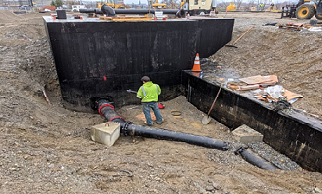
Josh Burke bolted together the pieces of twelve-inch DI dewatering pipe exiting dewatering chamber #2.
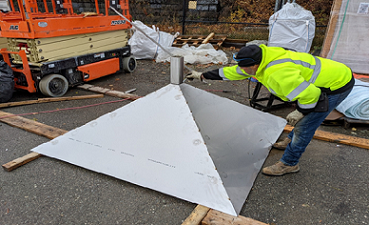
Jeff Glidden fabricated the stainless-steel cap for the 48” Tank vent stack.
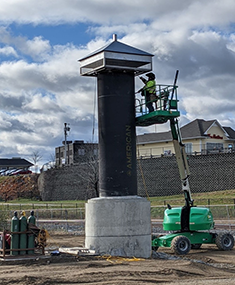
The cap was set in place before Thanksgiving. The vent’s finished look is to be determined and completed next year.
Davis Brook CSO Storage Tank
Work completed 11-08-21 to 11-12-21
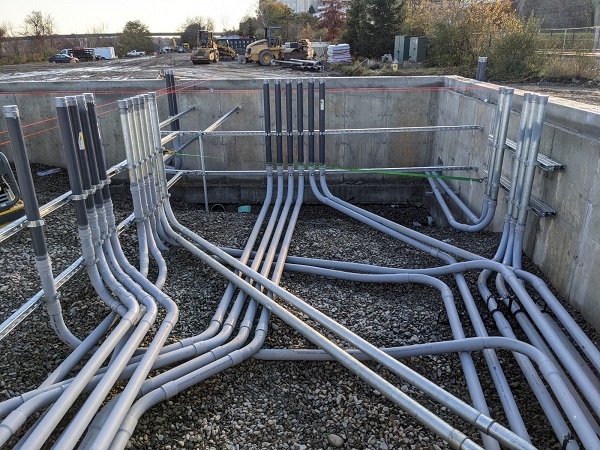
This week Express Electric was onsite. Inside the foundation for the Electrical Building they roughed in the electrical and SCADA wiring conduit for power and data control of the Tank’s pumps and valve actuators. SCADA stands for “supervisory control and data acquisition”. The SACAD system installed in the Tank and its’ integration into the existing City of Bangor sewer SCADA system will enable remote control and monitoring of the Tank’s filling, flushing and dewatering. Specialized SCADA software enables Treatment Plant operators to computer monitor flow and capacity for the entire City sewer system.
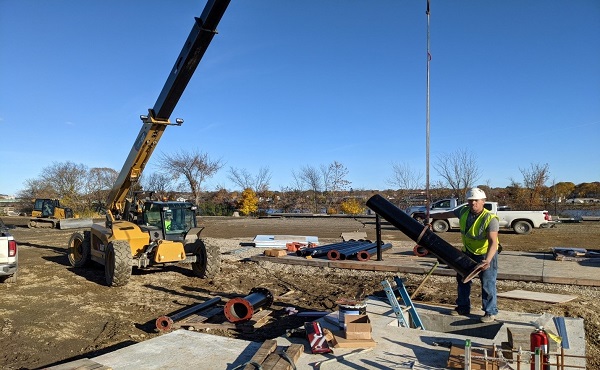
S.E. MacMillan began installing dewatering pipe in dewatering chamber #1.

Inside dewatering chamber #1 Devon Haight and Ian Hotham bolted-up eight and ten-inch ductile iron pipes, valves and actuators. This chamber services the dewatering pump for Tank Cell #1.
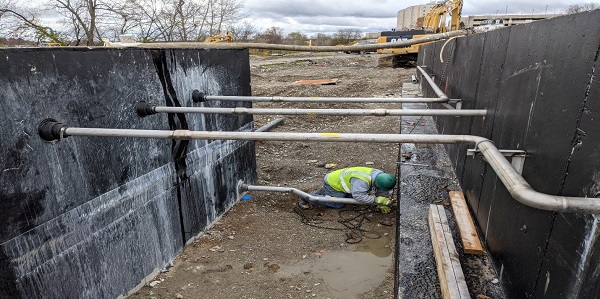
Sullivan and Merritt completed welding and mounting two-inch stainless-steel supply piping for all three Tank cells. The photo above shows Rick Merrithew between water supply chamber #3 and the Tank installing Link-Seals in the Tank wall for the water supply penetrations.
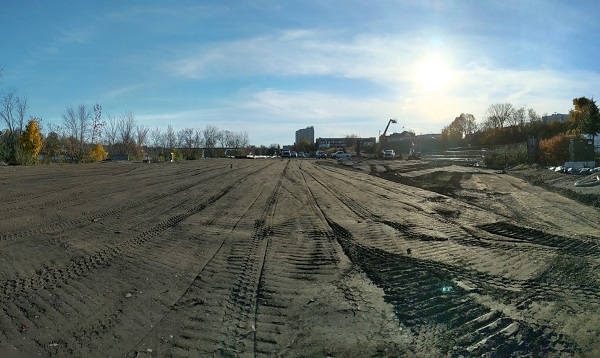
Much of the north end of the site has been graded to within a foot of finish grade. Gravel subbase for paved walking paths and loam will still need to be put down.
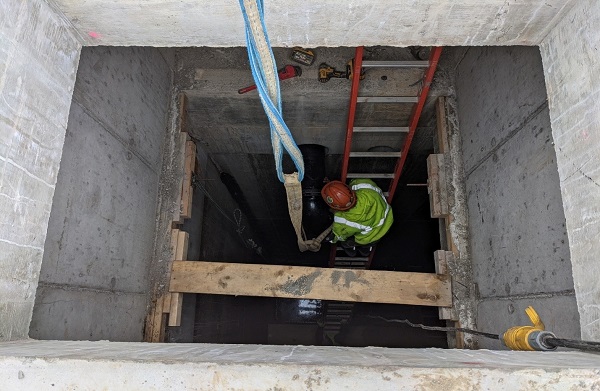
Looking down the hatch chimney into the Tank, this photo shows SEM establishing a plumb line for installation of the pump pedestal and the eight-inch discharge pipe for Cell #1 into dewatering chamber #1.
Work completed 11-01-21 to 11-05-21

On Monday S.E. MacMillan finished laying eight-inch water main. They ran the new ductile iron pipe to the electrical building and off the eight-inch main stubbed the new four-inch service into the building and laid the six-inch lead for the new hydrant.
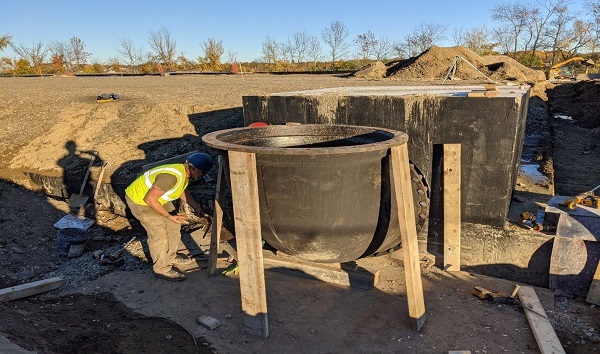
Also on Monday they set into place the 90 degree, four-foot diameter Tank Vent stack.
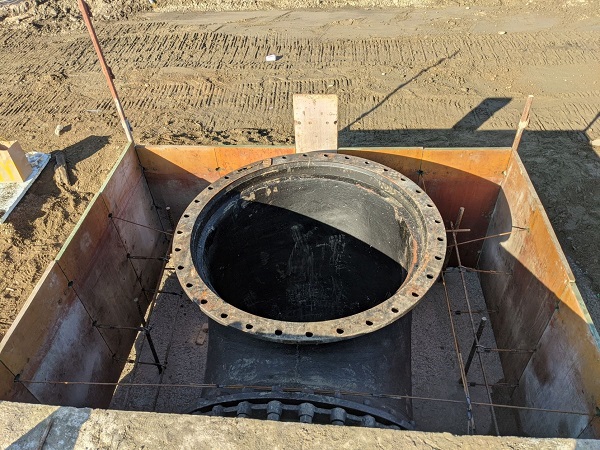
Beneath the vent elbow MacMillan excavated and put two feet of subbase stone, they laid a one-inch thick 8’x8’ piece of sheet steel and then placed eighteen-inches of concrete. On top of that they formed the base support for the Vent. The Vent will rise twenty-feet above finish grade and will vent the entire Tank.
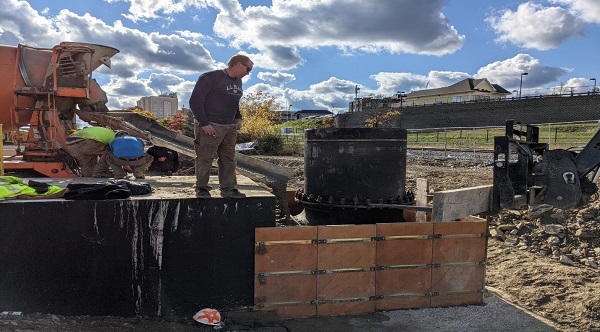
On Wednesday MacMillan placed concrete for the Vent base support slab.
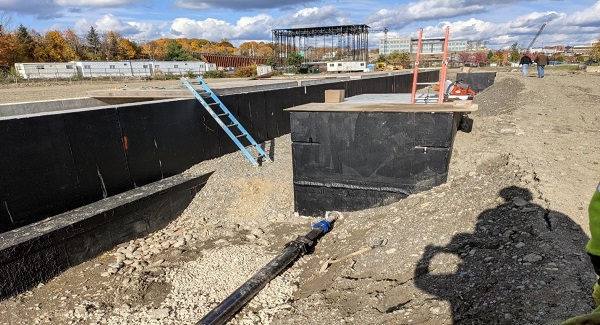
Also on Wednesday, Macmillan began connecting the water supply chambers with ductile iron supply piping. Due to availability issues, MacMillan substituted six-inch DI for four-inch DI and used mechanical reducers to connect to the three-inch stain-less steel supply vault piping.

MacMillan set a six-foot diameter pre-cast barrel section on the Vent support foundation around the short section of four-foot diameter Vent pipe. They placed concrete inside the barrel, covering the top of the elbow and the short riser mechanical connection.
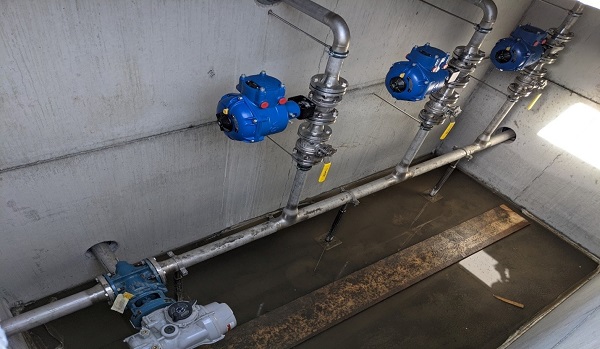
Sullivan and Merritt came back on-site Thursday. They connected tipping bucket water supply 2” stain-less steel riser piping, shut-off valves and electric valve actuators for all three water supply chambers.
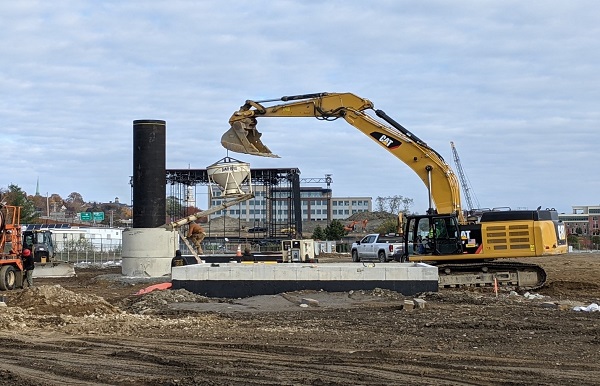
On Friday MacMillan belled a twenty-foot piece of four-foot diameter ductile iron pipe into place inside a second six-foot diameter precast barrel section and placed concrete inside the precast barrel. They also began fabricating a stain-less steel cap for the Vent stack.
Work completed 10-25-21 to 10-29-21
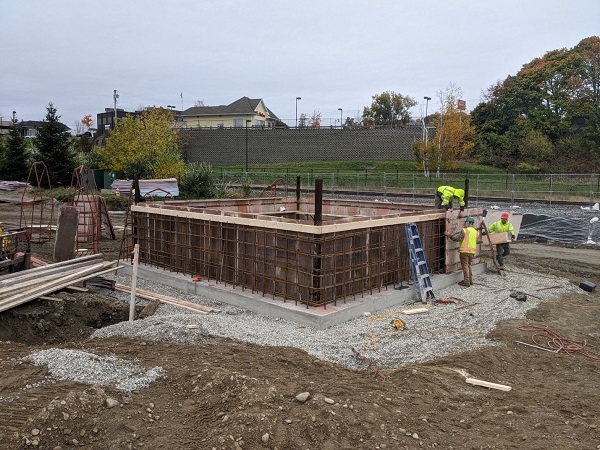
S.E. MacMillan tied reinforcement steel for the electrical building foundation and set the forms on Monday and Tuesday.
V.R. Concrete had two men on site Monday. They stripped the final form pieces from dewatering chamber #1, loaded all the remaining forms onto a trailer and moved off site. They will return once more to remove their crane.
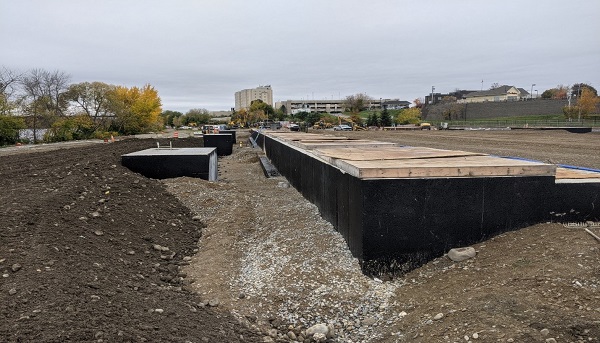
SEM continues to fill and grade around the Tank. The photo above shows the northeast Tank corner.

The three water supply chambers are backfilled against their east sides. Sullivan and Merritt had three men on site later in the week installing the stain-less steel piping inside each chamber. The tipping buckets (above) on the left await the supply water piping which will come from the water supply chambers.
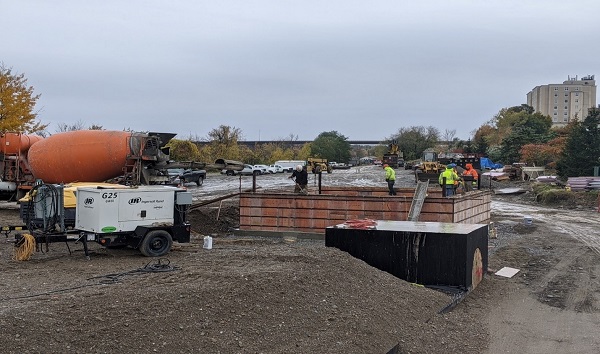
On Wednesday MacMillan placed 18 cubic yards of Hughes Brothers concrete for the electrical building foundation.
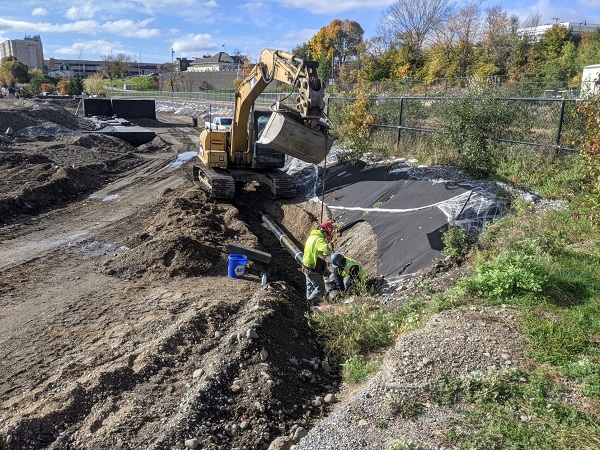
SEM began installing new eight-inch ductile iron water main on Thursday, connecting to the existing capped end on the north end of the site. The water main will run along the railroad right of way to the electrical building where it will be metered and split for separate services for public restrooms and Tank flushing.

Sullivan and Merritt installed the three-inch stain-less steel water supply piping inside the water supply chambers with 3x2 tee reducers. Each one of these two-inch risers will be run out of the supply chamber and through the three-foot thick Tank wall to a tipping bucket. Just above the flanges atop the two-inch risers, electric actuators and shut-off valves will be fitted to control the flow to the tipping buckets.
Work completed 10-18-21 to 10-22-21
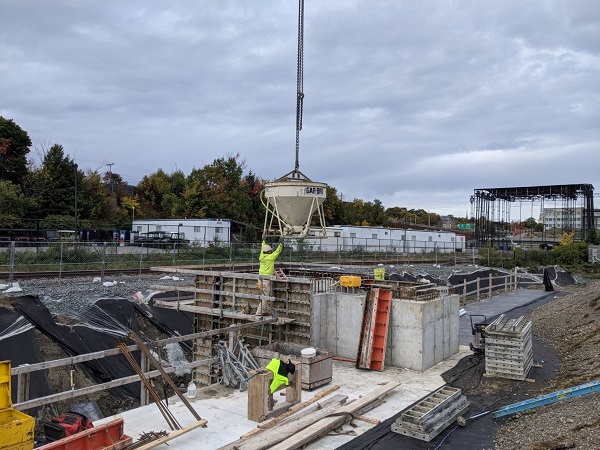
VR Concrete placed 4 cubic yards Monday. The Hughes Brothers mixer arrived at 1:30 pm with concrete for the dewatering chamber #1 (DWC #1) sloped floor. They stripped the exterior wall forms of DWC #1 and prepped to form and tie reinforcement steel for the elevated slab.
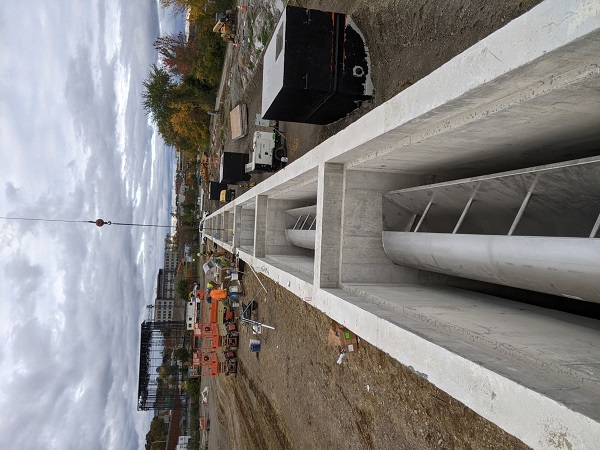
S.E. MacMillan began setting tipping buckets (TB) into place on Monday. They set seven with two left to be set in Cell 2. They tested the first TB in Cell 1, filling it with water, it tipped and dumped the 1200 gallons perfectly against the backwall and spillway radius at the Tank bottom. The stainless-steel tipping buckets are fabricated to fill to a pre-determined level at which point the center of gravity shifts causing it to tip and dump the flushing water down and onto the Tank spillway. Once empty it returns automatically to its resting horizontal position.
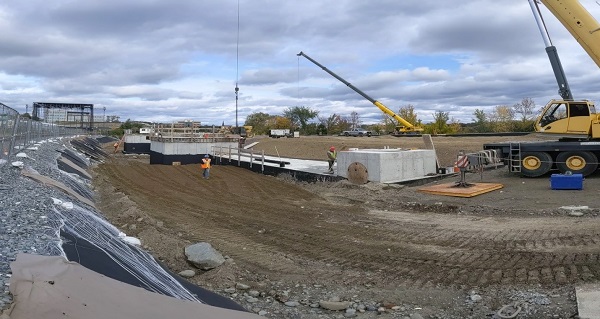
Backfilling has progressed on the west side of the Tank. By Wednesday SEM had backfilled and compacted the Tank to about elevation 14.00 between DWC #2 and the vent stack penetration.
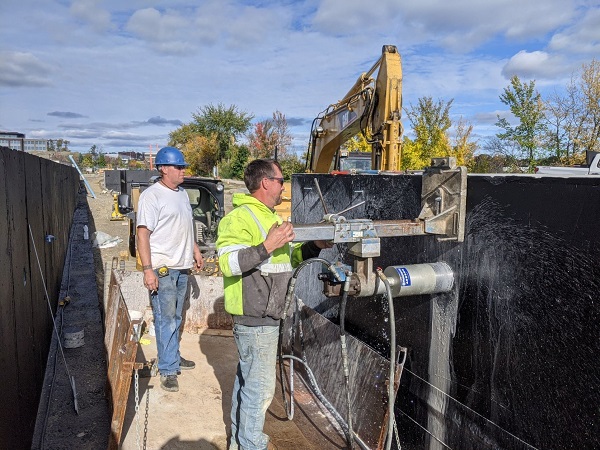
SEM cored holes in the water supply chambers on Wednesday. Each water supply chamber will house a supply manifold for three tipping buckets. SEM has hired Sullivan and Merritt to work off-site on welding the stainless-steel pipe and fittings for installation into the supply chambers. MacMillan will connect each of the three stainless-steel manifolds to the TB water supply main.
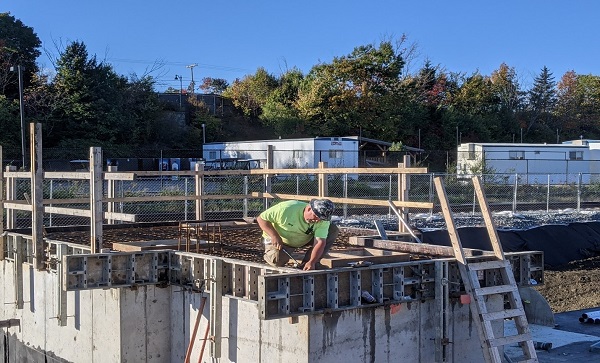
Anthony Havalotti put finish grade nails on the elevated slab form for DWC #1.
VR placed this elevated slab on Thursday using 10.5 cubic yards of Hughes Brothers concrete.
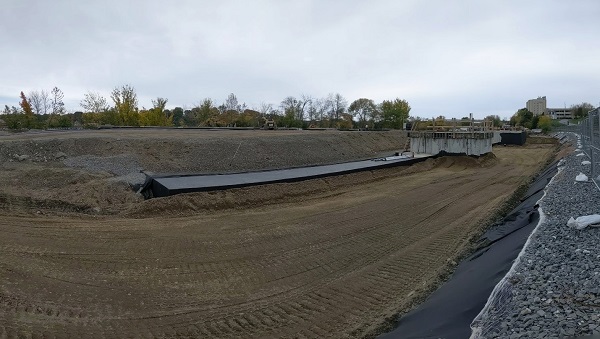
SEM backfilled against the north west end of the Tank on Friday, the entire west side is backfilled to elevation 15.00. They anticipate a pipe delivery next week bringing the 8” diameter ductile iron pipe they need for the new water main which runs at about elevation 11.00 between the tank and the railroad right of way.
Work completed 10-11-21 to 10-15-21

On Monday, VR Concrete placed 18 cubic yards of Hughes Brothers concrete, tested by Baxter Hughes of S.W. Cole, for the Dewatering Chamber #1(DWC #1) foundation slab. They also stripped forms from Dewatering Chamber #2 (DWC #2) walls, tied reinforcement steel and set wall forms for DWC #1. S.E MacMillan began drilling holes and epoxying stainless steel bolts for the tipping bucket bearing plates. They also continued backfilling with gravel on the top of the Tank, grading from the southern end toward the north.
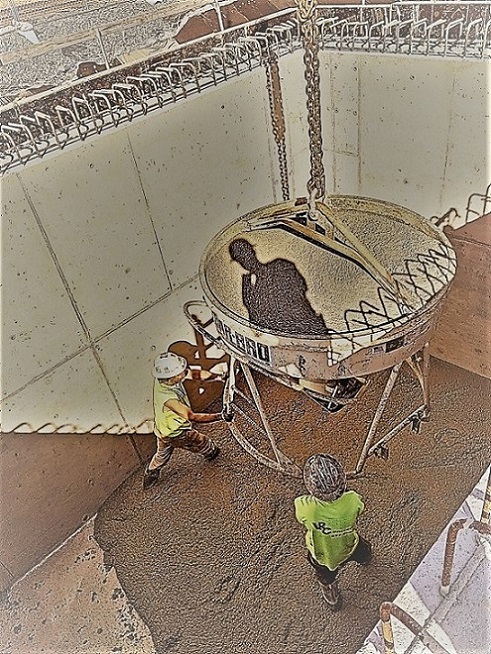
VR placed 7 cubic yards of Hughes Brothers concrete on Tuesday for the sloped floor in DWC #2. They tied reinforcement steel and set forms for DWC #1 walls and stripped wall forms and began forming the deck for the elevated slab in DWC #2.

In the photo above; Dewatering Chamber #2 is in the foreground, DWC #1 is in the background. Along the west side MacMillan has backfilled to about elevation 9.00. Finish grade will be elevation 22.00.

Levis Boutin and Bob McKinnon formed the deck for the elevated slab over DWC #2.

VR tied reinforcement steel for both dewatering chambers on Wednesday. The bond-outs in the above photo are (on the right) for dewatering pipe gallery access and (on the left) for Cell #3 chopper pump installation, maintenance and removal.
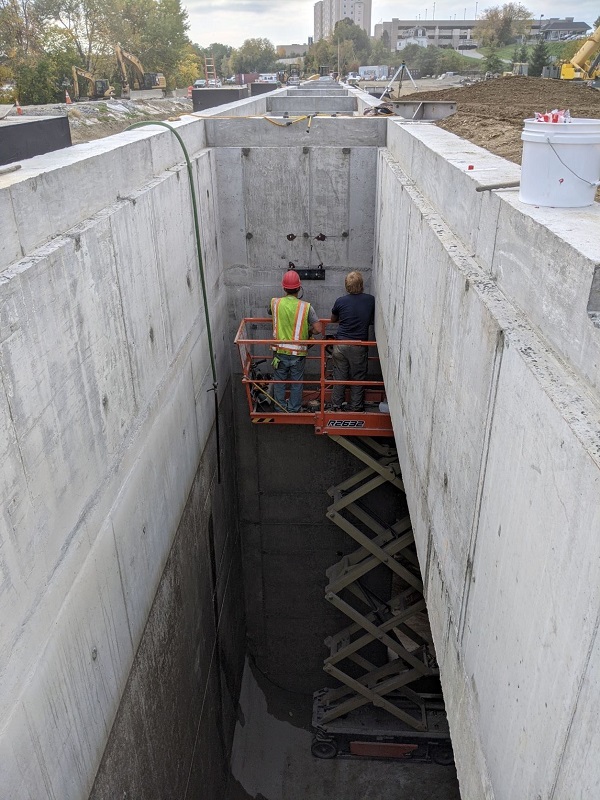
Josh Burke and Ian Hotham set ledger plates in Cell #1, bay #1 for the tipping bucket brackets. Having these ledger plates in place allowed them to hold and steady the fifty-pound stainless steel bearing brackets while drilling holes in the Tank wall and epoxying mounting bolts.
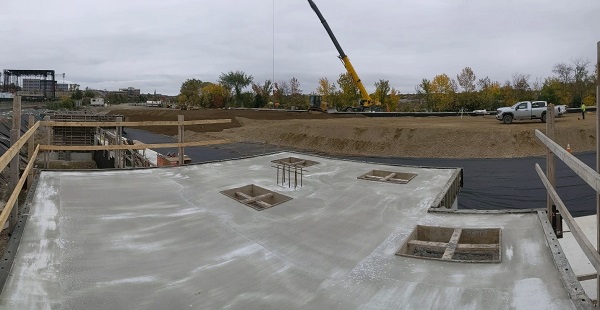
VR placed 50 cubic yards delivered by Hughes Brothers on Thursday for the DWC #1 walls and DWC #2 elevated slab. They left the site for the week on Thursday afternoon.
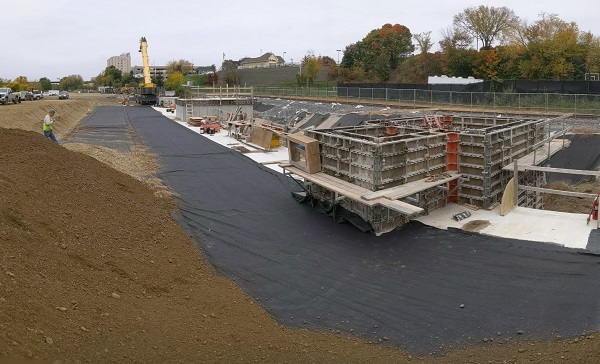
Macmillan graded gravel on the top of the Tank Friday, put on damp proofing covered with filter fabric and continued installing tipping bucket bearing brackets. Next week they will install the tipping buckets.
Work completed 10-04-21 to 10-08-21
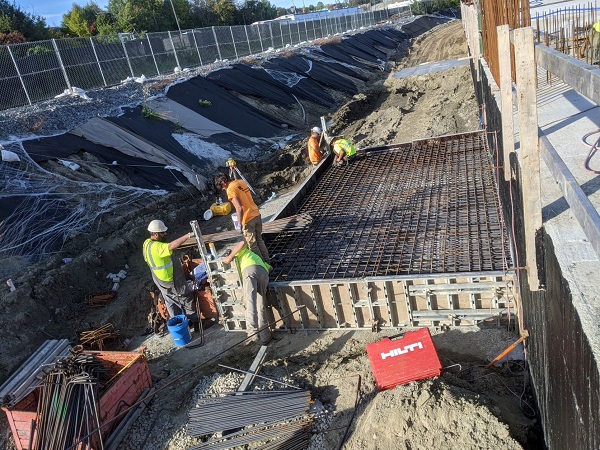
On Monday, VR Concrete returned to the site, they tied reinforcement steel and formed the Dewatering Chamber #2 (DWC #2) slab. DWC #2 will house the dewatering piping connected to the Vaughn, 30 HP chopper pumps which will pump combined sewer overflow from the Tank back into the 8’x9’ Davis Brook box culvert. DWC #2 will provide access for the dewatering piping for Tank Cells #2 and #3.
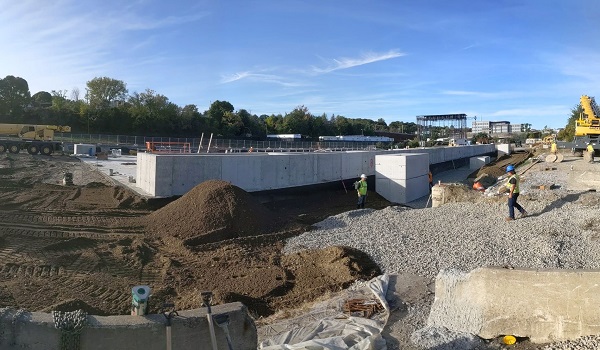
Also on Monday, S.E. MacMillan began setting into place the precast sections of the three water supply chambers. The water supply chambers will hold valves and piping for supply to each of the nine tipping buckets.
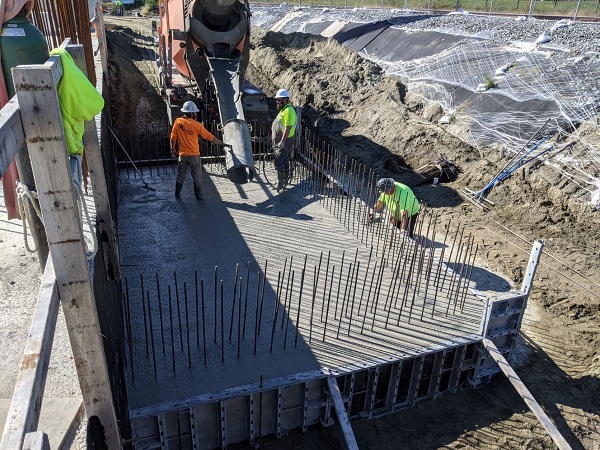
VR placed 30 cubic yards of Hughes Brothers concrete on Tuesday for the DWC #2 foundation slab. This slab sits on top of the pile cap SEM built last week. VR also began tying steel and standing panels on the Tank top slab for the DWC #2 upper walls.

SEM began backfilling around the water supply chambers and damp proofing the Tank top.

By Wednesday the northern end of the Tank is backfilled to elevation 16.00 and has about half the top damp proofed.
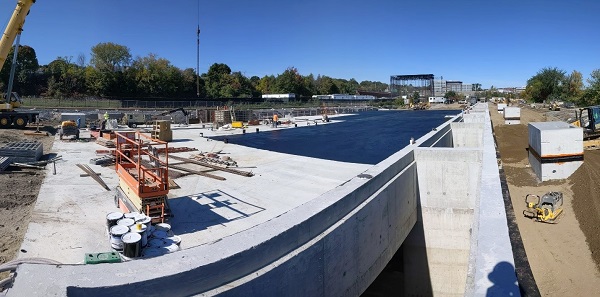
VR continued to tie reinforcement steel and set forms for DWC #2 on Wednesday. SEM laid 4” underdrain along the north Tank foundation just below the upper slab elevation of 16.00. This underdrain will ultimately tie into the small soil-filter pond to be built on the south end of the Tank site.
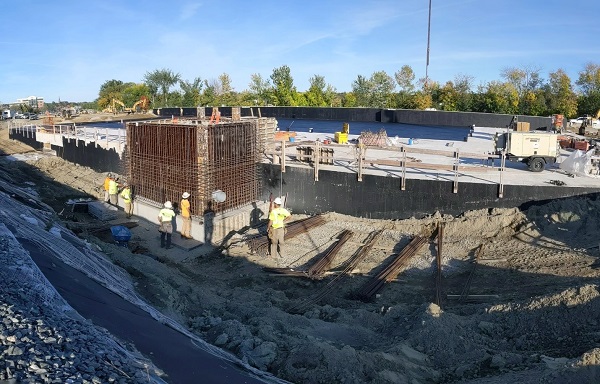
DWC #2, in the photo, has the inside face of forms standing and VR is tying reinforcement steel.
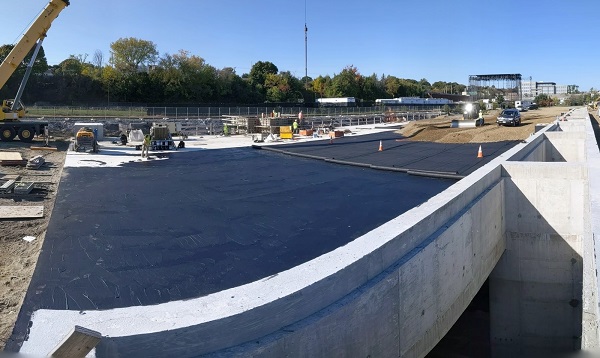
Thursday MacMillan began backfilling on top of the Tank. They rolled out non-woven filter fabric over the damp proofing.
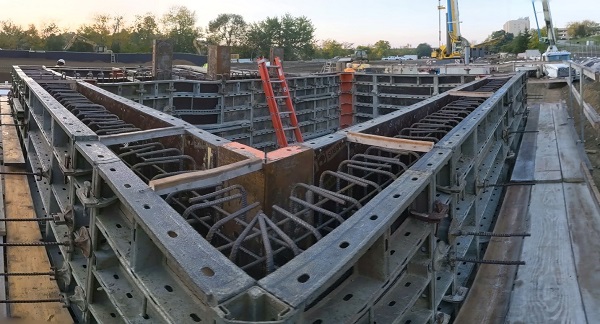
Friday morning VR had DWC #2 walls ready for concrete. Hughes Brothers delivered 50 cubic yards of concrete and Mainely Concrete Pumping pumped it into the forms.
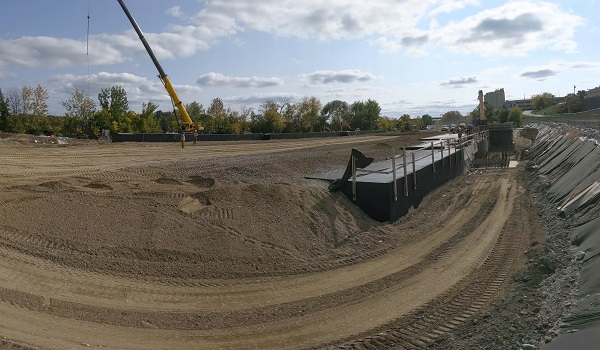
Friday afternoon the first lift of gravel backfill covered the entire top of the Tank.
Work completed 9-27-21 to 10-01-21
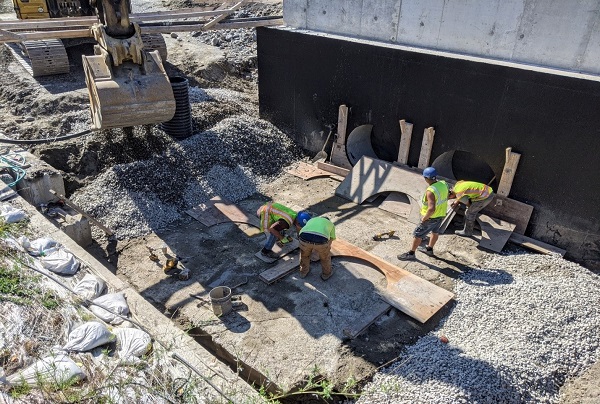
On Monday S.E. MacMillan prepped form work and reinforcement steel for connecting the Tank to the Davis Brook CSO 8’x9’ box-culvert conduit. The connection required making two cuts into the concrete conduit, inserting two 48” ductile iron pipes from the conduit and into the tank and closing both penetrations with either non-shrink grout or concrete. They also continued with backfilling operations. S.W. Cole had a technician on site Monday. Subbase gravel compaction was verified beneath the concrete pile cap to be placed on top of the left-in-place soldier and sheet piles. The pile cap gives bedrock foundation support to the Dewatering Chamber #2. DWC #2 is the below grade concrete room where dewatering piping exits the Tank and is pumped to the Davis Brook CSO 8’x9’ box culvert conduit.
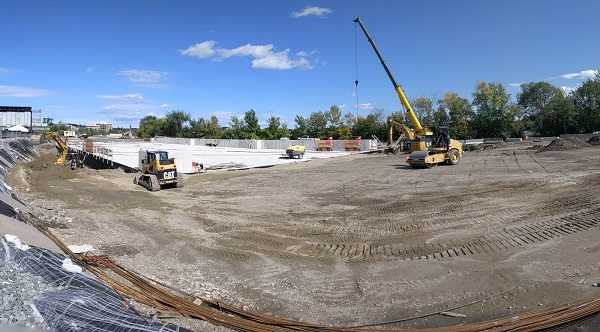
The southern end of the Tank is backfilled to the top of the roof slab at elevation 16.00. Finish grade will be at elevation 22.50.

This is looking south; all three Cell #3 tipping bucket bays are in view and SEM has a crew in the middle left of the photo prepping for the two 48” DIP connections from the existing Conduit to Tank.

Tuesday, SEM began cutting into the existing Conduit with plunge-cut concrete chain saws. They finished cutting one opening by mid-morning. Because of dry weather conditions the flow normally running in the conduit was re-routed to the still operational Penobscot Interceptor which runs parallel to the Conduit and was the original sewer main constructed in the early 1960’s.
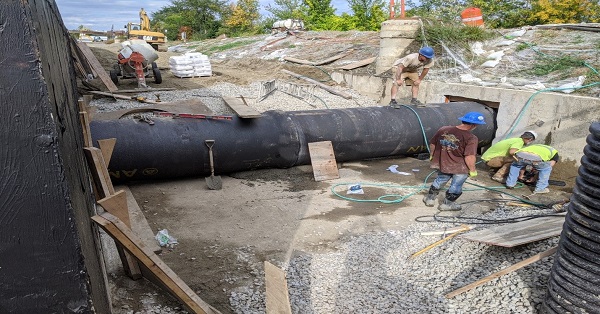
The section of 48” DIP, approximately 26.00’ long is two pieces which they pre-belled before setting into place with the crane. They closed the form to the inlet connection to the Tank and filled the void with non-shrink grout. Hydrophilic water stop was placed around the concrete opening and around the pipe.
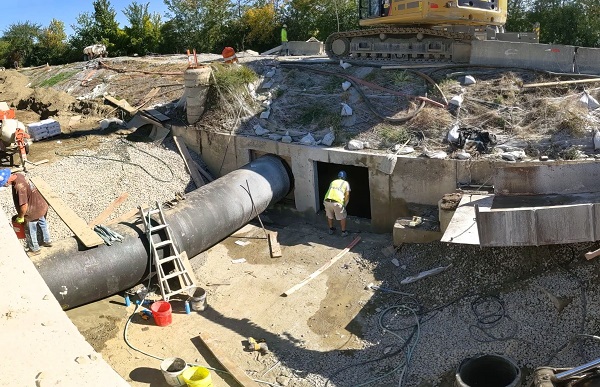
Wednesday, MacMillan cut the second opening into the Conduit. Installed the second section of 48” DIP, grouted the inlet to the tank and worked on the formwork necessary to close both 48” connections to the Conduit.
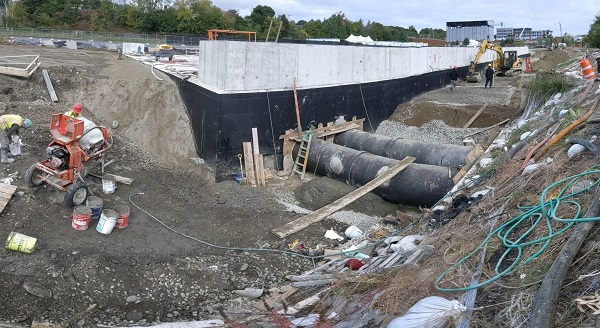
MacMillan finished both connections on Thursday, placing concrete for both Conduit closures and placing concrete to cradle both pipes securely onto the pile cap beneath them. They began tying steel for the concrete support cap reinforcing the Conduit vertically and horizontally where the penetrations were made.
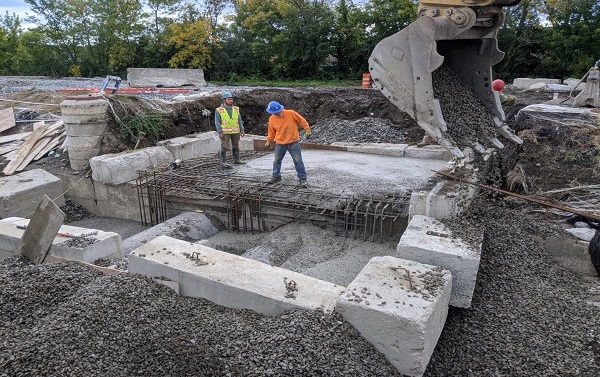
On Friday MacMillan placed 30 cubic yards of Hughes Brother’s concrete over the reinforcement steel for the support cap of the Conduit.
Connecting the Tank to the Conduit was a significant milestone. MacMillan is expecting VR Concrete to return to the site next week to begin the final concrete work on site. Macmillan will now focus on backfill and installing the tipping bucket water supply chambers and the water supply piping for the tipping buckets.
Work completed 9-20-21 to 9-24-21
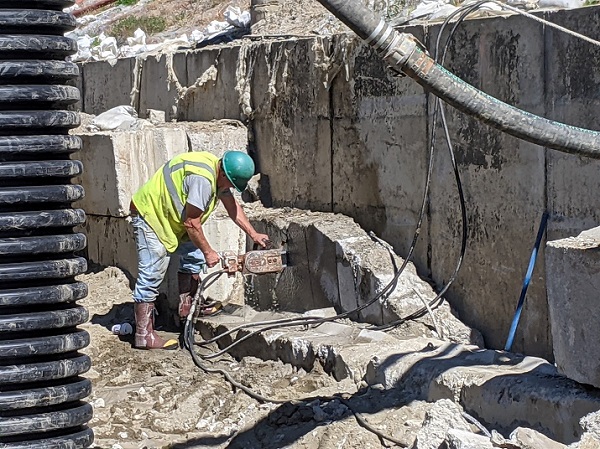
Rick Merrithew used a hydraulic plunge-cut concrete saw to cut concrete fill away from the Davis Brook conduit.
S.E. MacMillan began preparation for connecting the Tank to the Davis Brook 8’x9’ conduit which runs parallel to the tank on the Penobscot River side of the Tank. On Monday they began removing a two-layer protective wall which they put in place in the spring of 2020 as a shield against the 8’x9’ box culvert conduit.

Here against the southwest corner, SEM has screened Tank
excavation graded and compacted to about elevation 0.00 along the entire south
end and north to just beyond dewatering chamber #2.

On the west side screened fill has been graded into layers and compacted from the northwest corner south to near the dewatering chamber #2. MacMillan cut the shoring to about elevation 5.00 and removed the sheet pile tops.
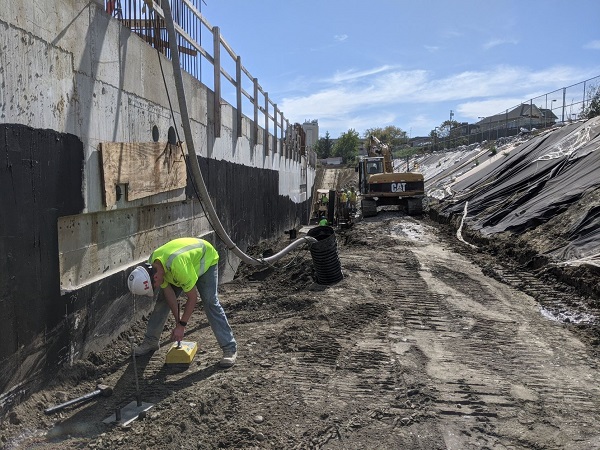
Wednesday, Zach Fitzpatrick, from S.W. Cole, was on site and took density measurements to verify compaction.
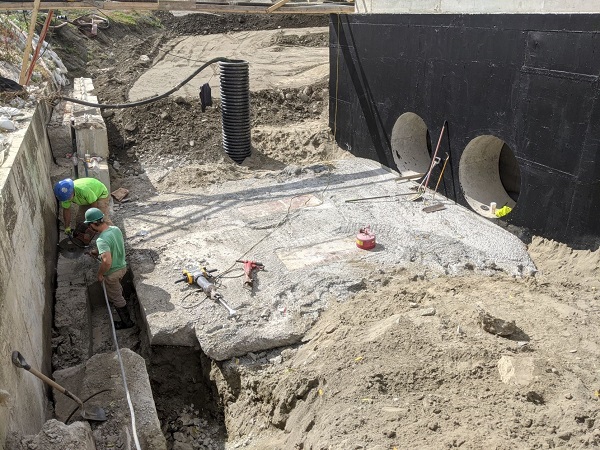
SEM completed removing the concrete and block from the conduit face where the 48” Tank inlets will be connected to both the conduit and the Tank. They placed a one-inch thick steel plate over the sheet and soldier piles where the 48” inlet pipes will rest and a foot of concrete over it to make a pile cap which will support the inlet pipes. In the top concrete layer, they set two one-inch plates to grade. These surface plates will allow the ductile iron pipe to be shimmed to permanent finish grade with steel shims.
SEM has been dewatering all three Tank cells this week, pumping each cell into an individual silt sack placed inside an erosion control barrier. All three Tank cells are near empty of leak test water.
Brandi Piers, from the Maine Department of Environmental Protection was on site Thursday to view MacMillan’s progress.
Work completed 9-13-21 to 9-17-21
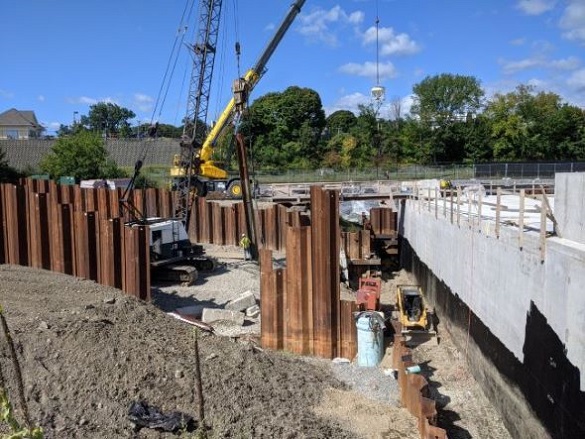

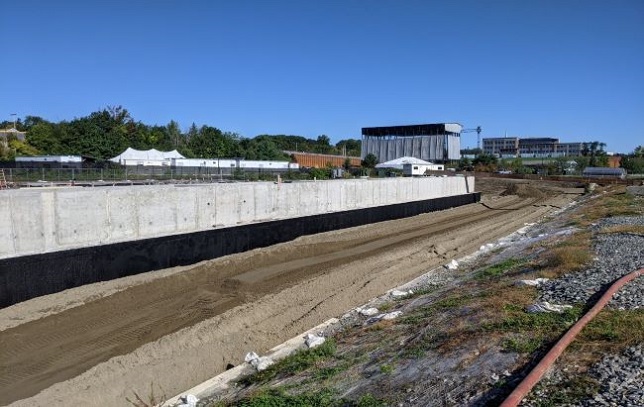
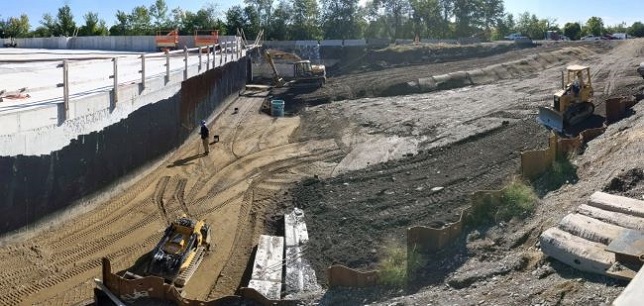
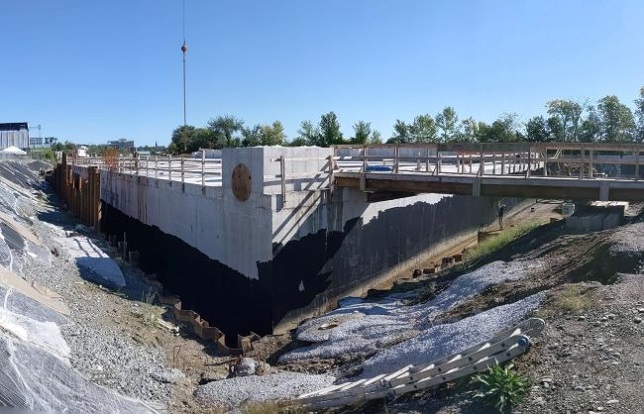
Work completed 9-7-21 to 9-11-21
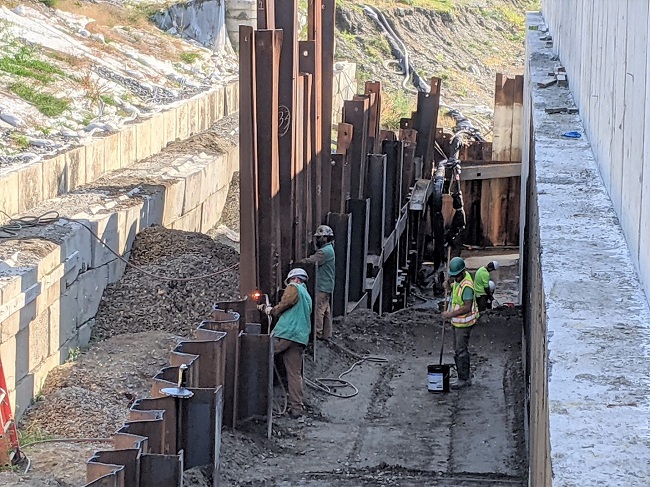
On Tuesday, H.B. Fleming finished pulling the north ramp sheets and all north Tank sheets. From Tuesday through Thursday Fleming cut the east shoring wall sheets to about elevation 6.50 and pulled the sheet tops.
After Cell #3 sat all weekend full with water to elevation 11.65, a leak test was started on Cell #3 Tuesday morning. Several locations had water lightly weeping through the three-foot thick Tank walls. S.E. MacMillan injected an epoxy solution into those locations. On Friday the final measurement was taken on the water surface elevation in Cell #3, less than 0.01’ had been lost so the leak test was successful. MacMillan began damp proofing Cell #3’s exterior walls and grading two-feet of stone over the footing and against the south Cell #3 Tank wall. The entire Tank can now be backfilled to elevation 7.00. MacMillan has already backfilled Cell #1 to elevation 7.00 and will continue to grade and compact backfill layers from the northerly end of the east side of Cell #1 toward the south easterly Cell #3 Tank corner. S.W. Cole was on site Tuesday and Wednesday to take density tests for monitoring compaction.

MacMillan is using a sixty-foot H-pile to carry groundwater discharge hoses across the northeast Tank corner from a deep sump on the north west side of the excavation.
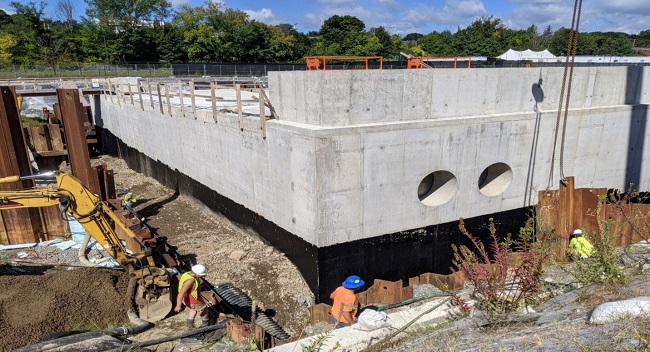
On Saturday MacMillan cut the last of the east-wall sheets and cut sheets from the south ramp east corner to the southeast Tank corner.
Work completed
8-23-21 to 8-27-21
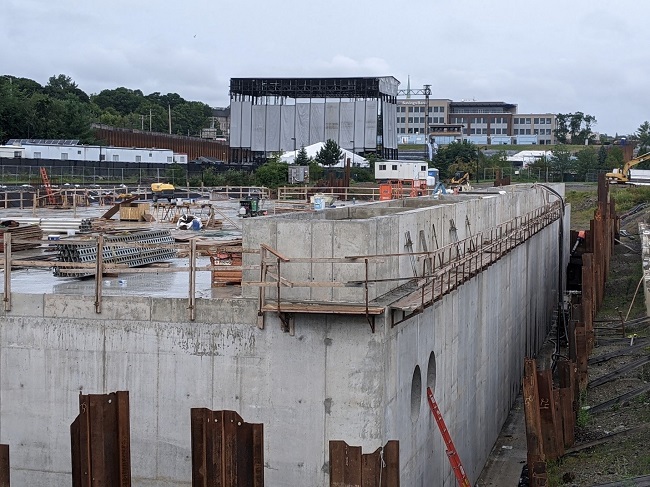
These five-foot high walls above the Tank will hold the flushing mechanisms for all nine Tank bays. Each of the three Cells has three bays. These concrete boxes will have precast covers fitting into a bonded-out shelf on their inside wall faces. Installation of the tipping bucket flushing mechanisms will begin this Fall.
On Monday, VR Concrete finished stripping the forms from the final tipping bucket wall placement. They began forming and tying reinforcement steel for the Tank vent chimney which passes through the top slab in the south west Tank corner. VR began breaking down and bundling shoring and decking from inside Cell 3 and stacking it onto of the tank for banding and return to the supplier.
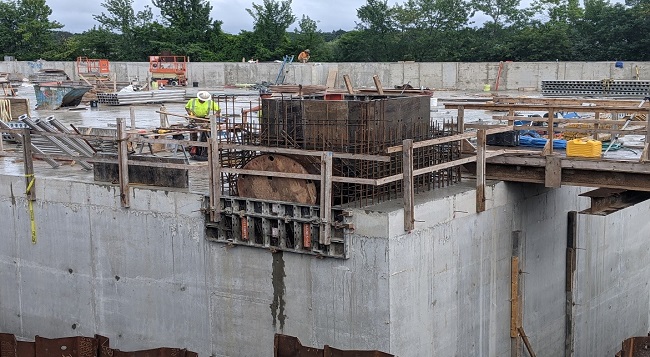
The 54” diameter bond-out for the 48” Tank vent can be seen here. VR Concrete formed the chimney walls around it and tied the reinforcement steel before closing the outside face of the forms. VR placed the chimney walls on Tuesday.
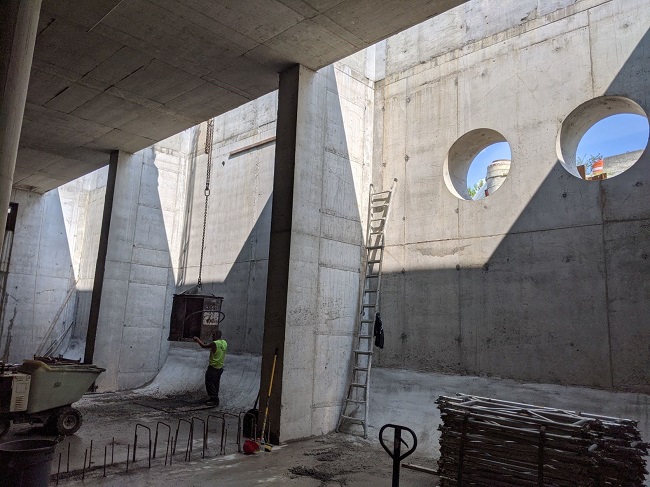
On Wednesday a concrete hopper/bucket is lowered into Cell 3’s tipping bucket bay #2. Together SEM and VR used concrete buggies to place 10 cubic yards for the first section of partition walls in Cell 3. The partition walls separate bay 2 from bays 1 and 3.
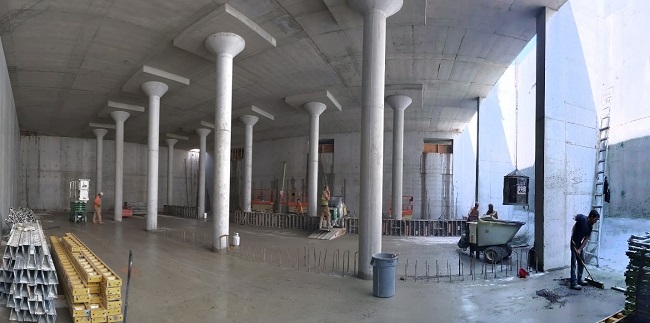
SEM and VR formed the first partition wall section in Cell 3 on Monday and Tuesday and then placed concrete on Wednesday.
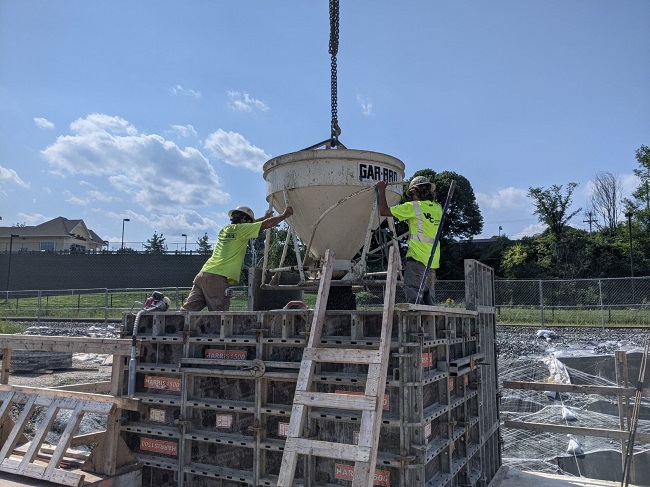
Also on Wednesday, VR placed the vent chimney slab.
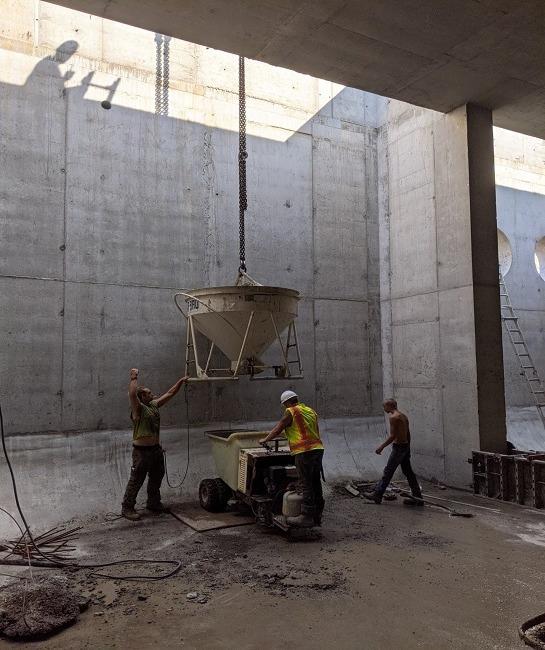
The man in the shadow above is perched on top of a section of Cell 3 tipping bucket wall using a radio to guide the crane operator in putting the hopper/bucket where it’s needed. SEM and VR placed the second section of partition wall in Cell 3 on Thursday. They placed twenty yards with this 2 cubic yard hopper/bucket.
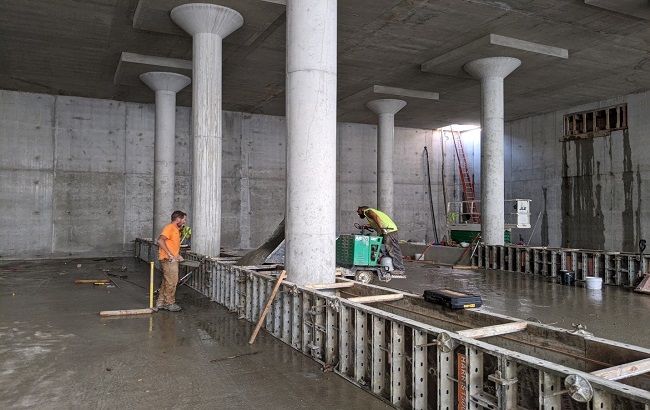
These partition walls are the final pieces of concrete inside Cell 3, completing concrete work inside the Tank.
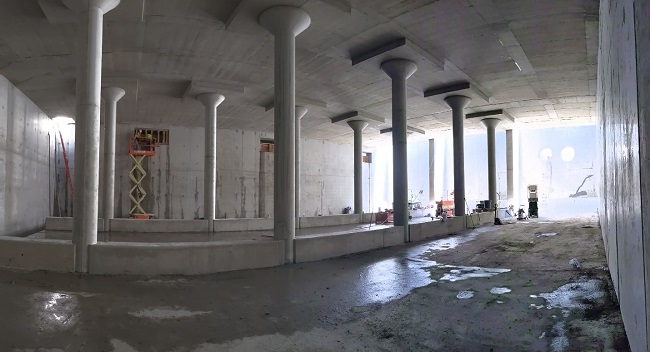
Friday afternoon the partition wall forms had been stripped and craned out of Cell 3. The men in the lift on the left are caulking a wood barrier against the Cell 2 rising water leak test.
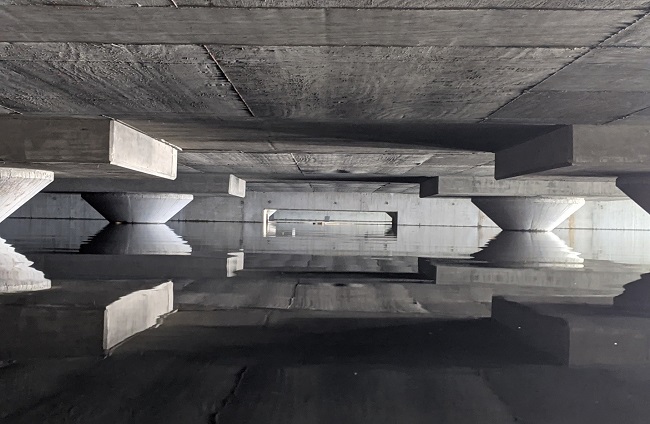
These photos were taken from the eastern weir shelf between Cell 3 and Cell 2. In the distance, through the weir between Cell 2 and Cell 1, the water elevation can be seen as full in both Tank Cells 1 and 2.
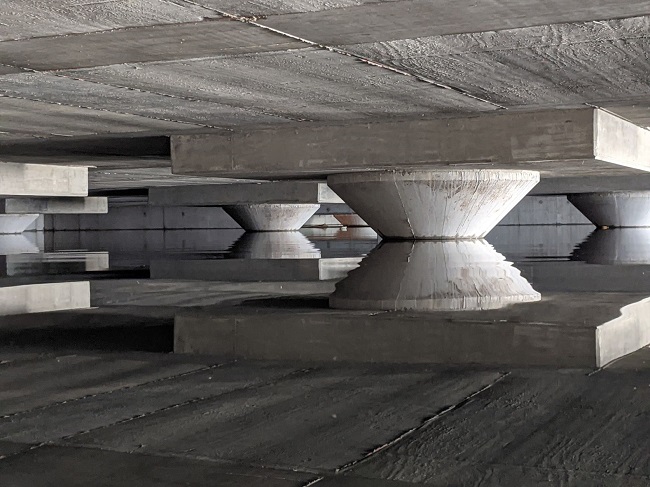
The leak test for Cell 2 began on Friday at 1:20 pm with the water elevation at 11.65. It is a three-day test. The water height will be measured again on Monday, August 30th at 1:20 pm. If the water level has not lowered by more that 3/8 of an inch, the leak test will be successful.
Work completed 8-9-21 to 8-13-21

Cell 1 was completely ready for leak testing on Monday.
On Monday S.E. MacMillan started setting up pumps and hoses to begin filling Tank Cell 1 with ground water. They estimated, based on an onsite flow test of existing ground water pumping that they could pump three to four feet of water into the tank in a twenty-four-hour period and reach the design water surface elevation in three days. Also on Monday, MacMillan prepped Cell 2 for tipping bucket radius fill concrete for all three bays and they plugged the three weir’s between Cell 1 and Cell 2 for the leak test.
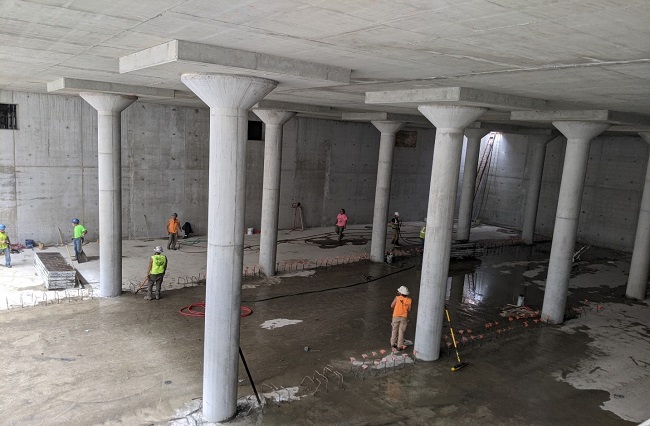
VR Concrete finished cleaning Cell 2 and began tying reinforcement steel and forming partition walls.
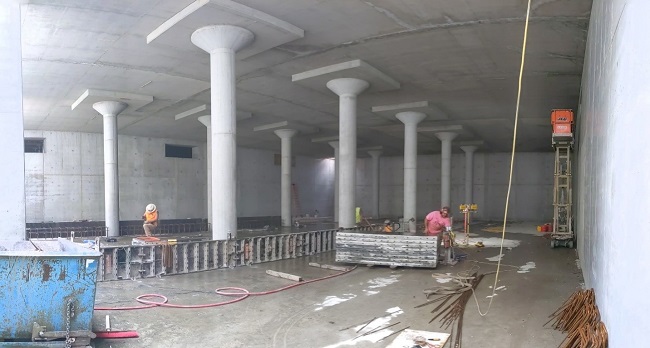
On Tuesday VR finished forming and tying half of the partition walls in Cell 2 and placed concrete with the crane/hopper-bucket and concrete buggy.

Odin Steel finished tying reinforcement steel for elevated slabs 5 and 6. On Tuesday VR placed 70 cubic yards with the crane/hopper-bucket for ES 5.
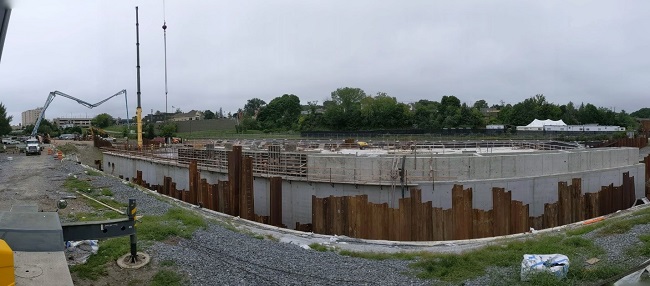
Mainely Concrete Pumping was on site for ES 6 on Wednesday. Placing ES 6 completed the Tanks’ elevated slab roof. Hughes Brothers delivered 80 cubic yards for ES 6, Cell 2 tipping bucket radiuses and Cell 2 partition walls.
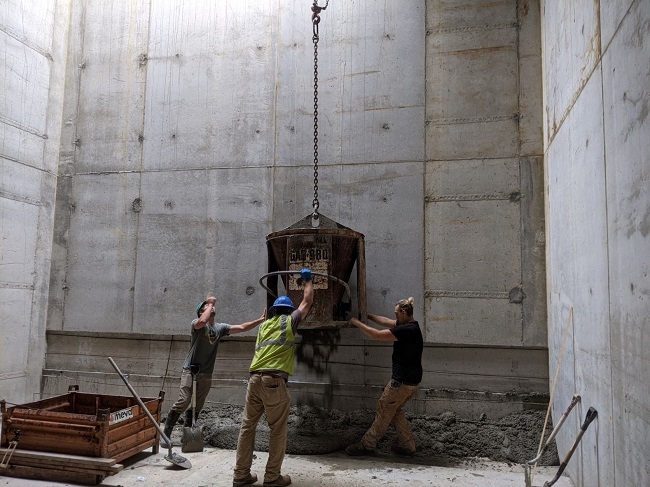
MacMillan placed tipping bucket radius fill with the crane/hopper-bucket on Wednesday.
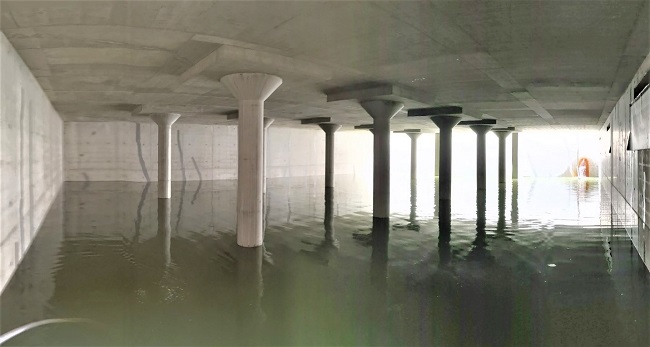
Cell 1 leak test water was at elevation 7.00 Thursday morning at 6:30.
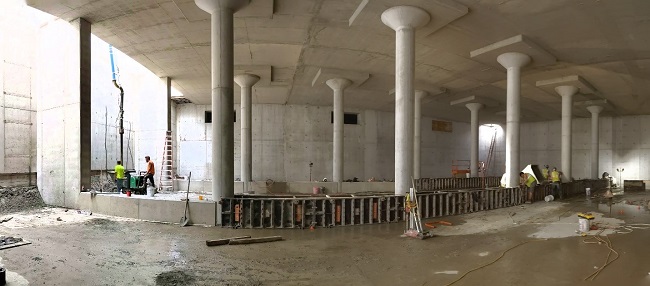
SEM and VR placed the remainder of the partition walls in Cell 2 on Thursday.
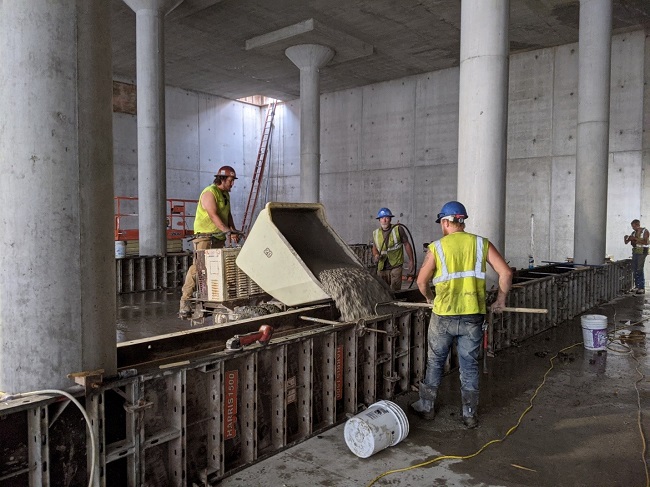
The concrete buggies are converted to be powered with propane inside the Tank to maintain air quality.

Cell 1 leak test water level was at elevation 10.00 on Friday morning, nearing the Tank design water surface elevation of 11.65.
Work completed 8-2-21
to 8-6-21
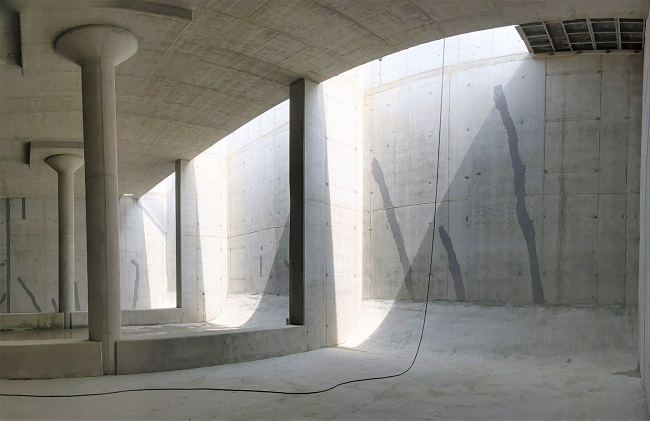
S.E. MacMillan worked the first three days of the week completing the finishing touches necessary prior to the start of leak testing Cell 1. The above photo shows Cell one’s northeastern Riverside corner with tipping bucket radius concrete in place, and minor patching and grinding complete. The entire floor of the foundation slab was touched up with a concrete “plainer” - which looks like a floor sander. All tie holes are plugged and other imperfections have been filled with grout or ground down. MacMillan plans on starting the Tank leak testing in Cell 1 next week.
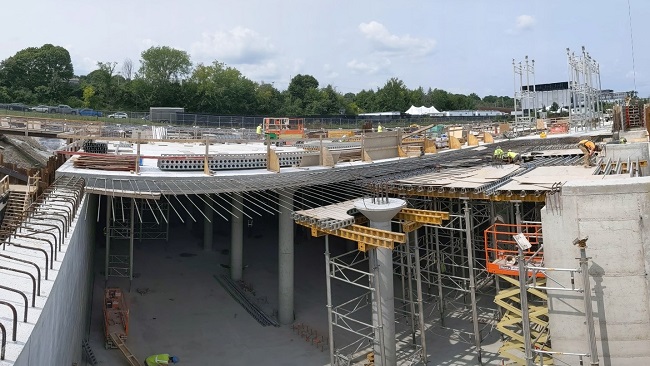
VR Concrete Placed tipping bucket wall section 4 on Tuesday. They moved shoring and decking from out of Cell 3 up top and are breaking most of it down for organizing, banding and return. Weds. and Thurs. they moved shoring and decking into Cell 3 for the final elevated slab sections, 5 and 6.
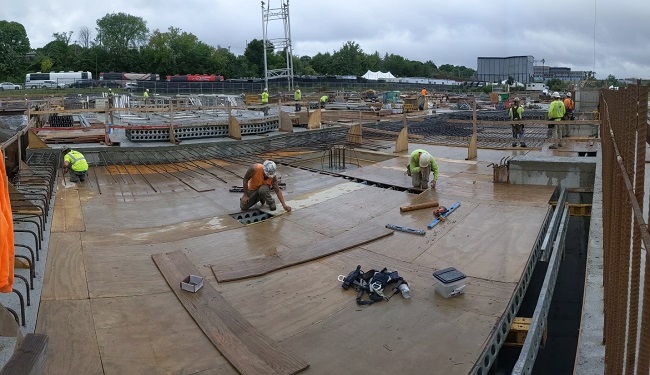
Thursday, in the off and on rain, VR finished shoring and decking ES 5 and 6 ahead of Odin Steel starting to tie reinforcement steel for ES 5. The above photo shows the southeast Riverside sections of the Tank where VR was putting down the last pieces of plywood for ES 6.
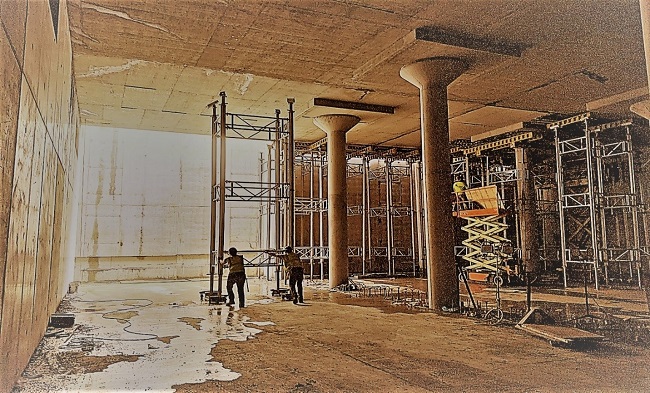
Thursday and Friday MacMillan and VR worked together lowering shoring towers, getting them onto rollers and rolling them to the tipping bucket openings in Cell 2 for rigging and removal from the tank with a crane.
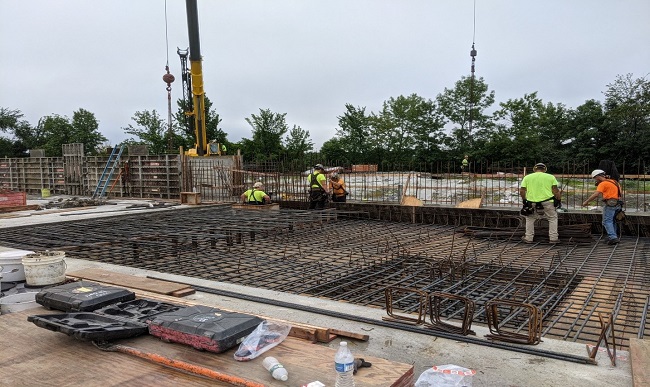
Odin finished reinforcement steel for both ES 5 and 6 on Friday.
Work completed 7-26-21 to 7-30-21
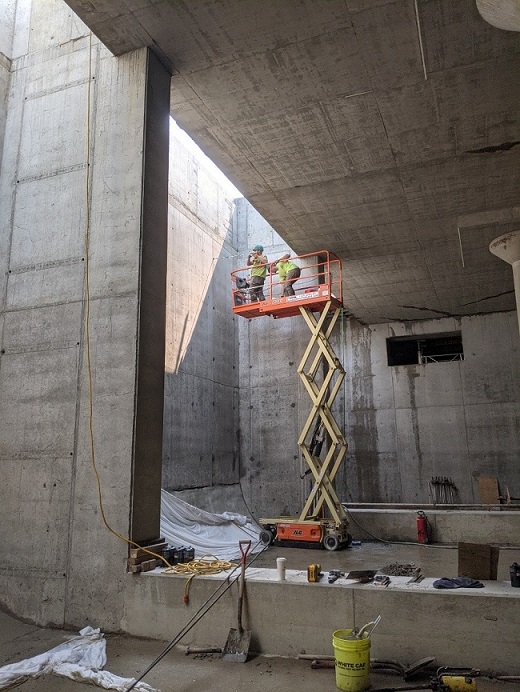
S.E. MacMillan finished placing fill concrete in Cell 1 this week. They plugged form-tie holes with mechanical plugs and non-shrink grout. They stripped the formwork for the partition walls in Cell 1 which were placed last Friday.

On Tuesday SEM placed the second lift of fill concrete in the Cell 1 sump channel.
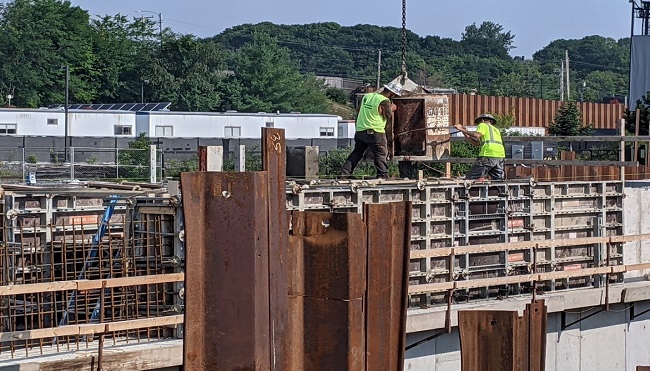
V.R. Concrete finished forming tipping bucket wall section 3 and placed 90 cubic yards of Hughes Brothers concrete with the crane and a hopper-bucket on Tuesday for elevated slab section 4. There are four more tipping bucket wall sections to place and two more elevated slab sections.
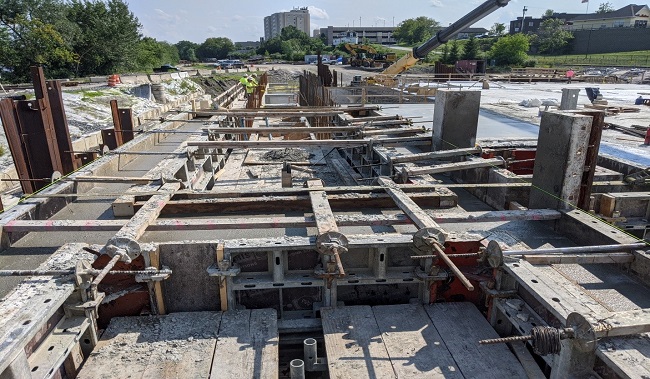
Finish grade will be approximately 18” above the formwork in this photo – 34 feet above the Tank foundation bottom. None of the structural concrete work will be visible when the Tank is finished.
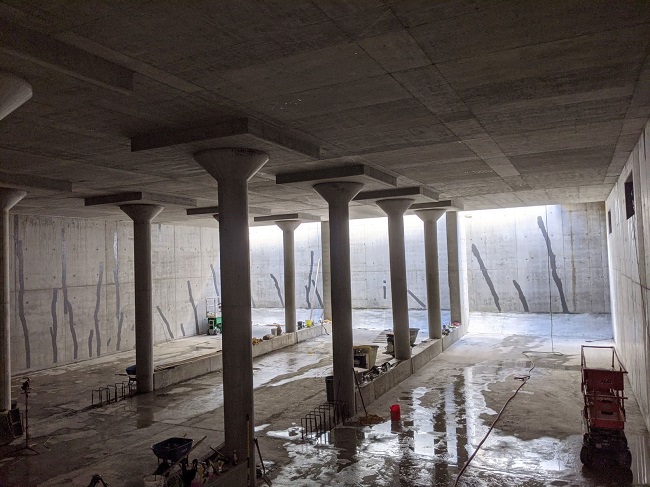
SEM spent the entire week prepping Cell 1 for leak testing. They plugged form-tie holes, drilled/cored wedge anchors out of the slab, coated shrinkage cracks with an epoxy coating and began plaining/grinding the rough surface areas on the tank slab.
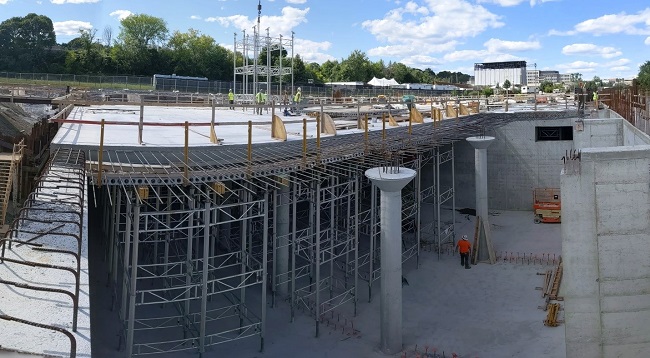
VR received concrete compressive strength break results for ES sections 11 and 18 which indicated they could begin removing shoring and decking from beneath both sections. The photo above shows Cell 3 with shoring under ES sections 17,18,11 and 12. The open are will be shored and decked for ES sections 5 and 6.
SEM had a crew all week screening excavation in the Roundhouse fill site to be used as backfill for the Tank. Leak testing will start in August and Tank backfill will start in the end of September.
Work completed 7-19-21 to 7-23-21
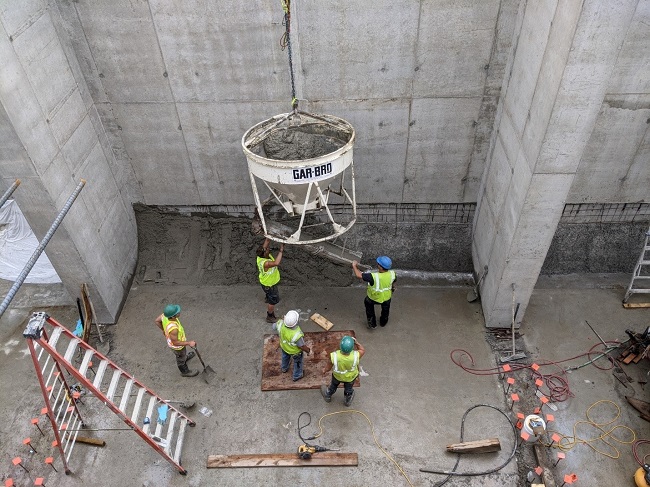
On Monday, S.E. MacMillan placed 2 cubic yards of Hughes Brothers concrete with the crane and bucket for the second lift of the Cell 3, bay 2 tipping bucket radius.
VR Concrete built the tops of the construction joint bulkheads for elevated slab sections 11 and 18. They continued moving shoring and decking support into Cell 2 for elevated slab sections 3 and 4, and they began putting down decking plywood. Odin Steel tied reinforcement steel for the vent stack chimney walls in Cell 1. They finished the top mat reinforcement for elevated slab section 12.

VR finished shoring and decking ES sections 3 and 4 in Tank Cell 2 on Monday.
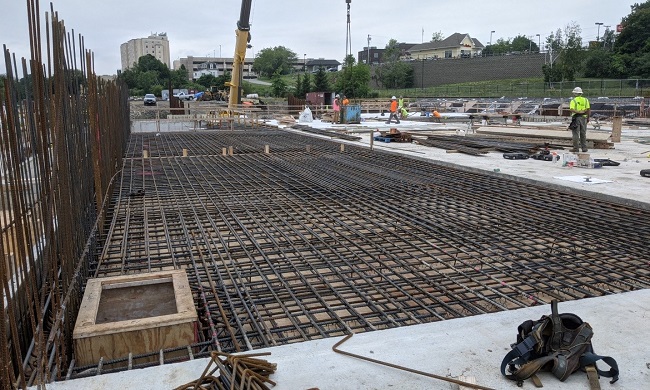
On Tuesday Odin tied the bottom reinforcement mat for ES sections 3 and 4 and started tying the top mat. VR built the middle third of the construction joint bulkhead between ES 3 and 4.
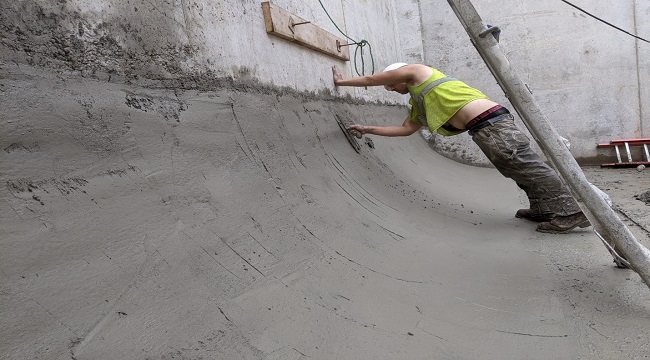
On Tuesday morning MacMillan placed another two cubic yards for the second lift of the Cell 3, bay 3 tipping bucket radius. In the afternoon they placed 10 more cubic yards for the first lift of tipping bucket radius fill in Cell 1, bays 1, 2 and 3.
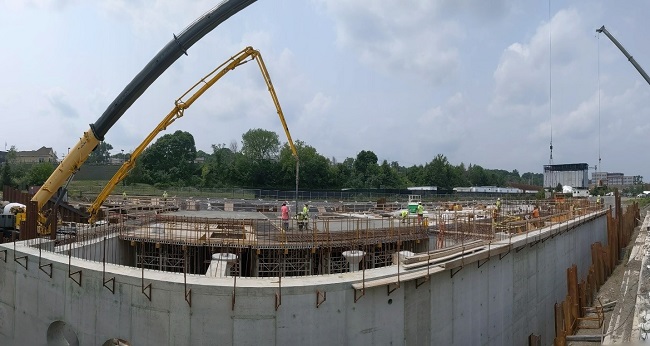
VR, with Mainely Concrete Pumping, placed 210 cy of Hughes Brothers concrete for ES sections 11 and 18. Wednesday, Odin took delivery of the last of 1,680,000 lbs. of Tank reinforcement steel. They also completed tying the top mats for ES sections 3 and 4.
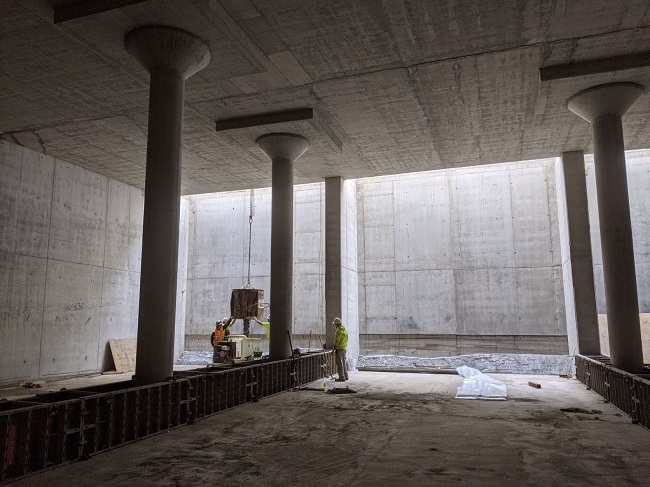
Thursday morning VR used the crane to bucket concrete into Cell 1 for the first section of partition wall. Mainely Concrete Pumping was also on site to pump 290 cy for elevated slab sections 3, 12 and 17.
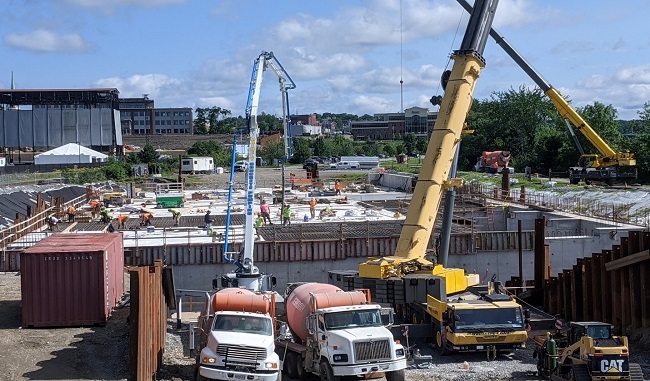
With the placing of ES sections 3, 12 and 17 on Thursday
only three sections remain; ES sections 4, 5 and 6. MacMillan placed concrete
on Friday with the crane and bucket inside Cell 1. They put down the first lift
of the sump channel and the second lift for Cell 1, bay 2 tipping bucket
radius.
Work completed 7-12-21 to 7-16-21

Stanley MacMillan discusses strategy with Jerimiah Kennett and Bob McKinnon from VR Concrete.
On Monday, S.E. MacMillan built an access ramp to reach from finish grade on the southwest Tank corner to top of concrete on the southwest corner elevated slab. MacMillan also worked on preparing for leak testing the tank by plugging tie holes in Cells 2 and 1.
VR Concrete moved shoring/decking from Cell 2 to cell 3, took down edge forms and scaffold railing on the column line G wall, stripped formwork on the first Cell 1 tipping bucket wall placement and began setting edge forms for the elevated slab sections 17 and 18 on column line 7.
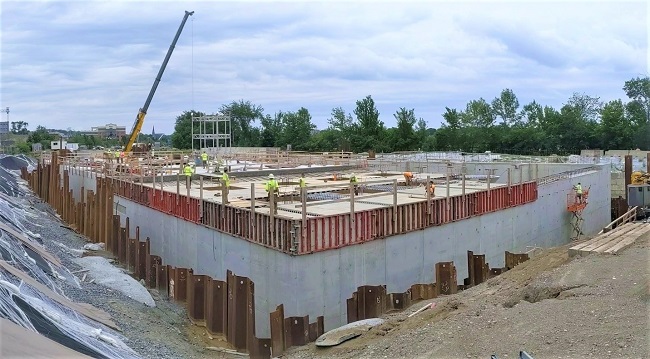
On Tuesday Macmillan continued plugging form tie holes and organized form panels for return to the supplier.
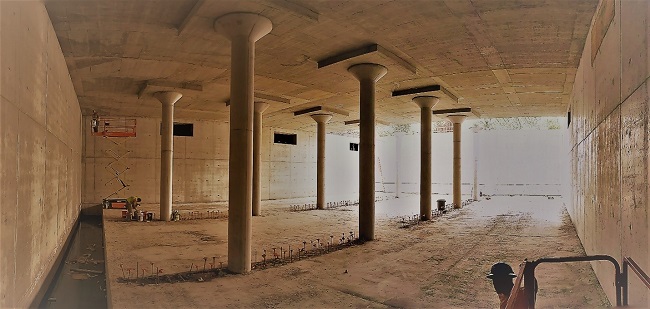
Inside of Cell 1 Macmillan is plugging approximately 800 form tie holes with mechanical plugs capped with non-shrink grout.

VR moved the remaining formwork from cell 2 and set shoring and decking into Cell 3 on Tuesday, they continued building edge forms against the southern Tank wall on column line J and began to put plywood down on the decking support for the elevated slab sections in Cell 3.
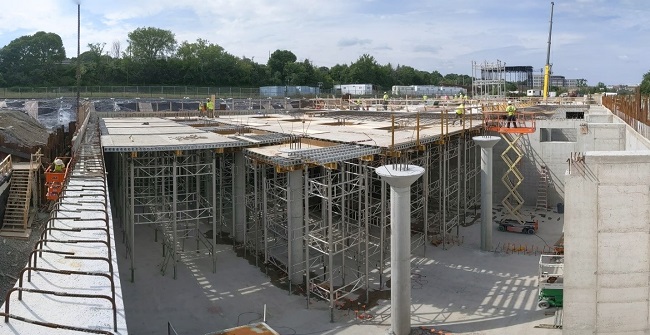
SEM began screening backfill material at the Roundhouse excavation stockpile on Wednesday. They set the southwest corner Tank access ramp into place and prepped Cell 3 tipping bucket radiuses for the first lift on concrete fill. VR continued putting plywood onto shoring/decking support in Cell 3 for elevated slab sections 11,12,17 and 18. They finished the edge forms for elevated slab sections 18 and 12 and built scaffold for work on tipping bucket wall sections in cell 2.
Odin Steel tied reinforcement steel for the column caps in elevated slab sections 17 and 18, and they tied the bottom mats for elevated slab sections 18 and 11.

On Thursday SEM placed the first lift of fill concrete in Cell 3, bays 1,2 and 3 for tipping bucket radiuses.
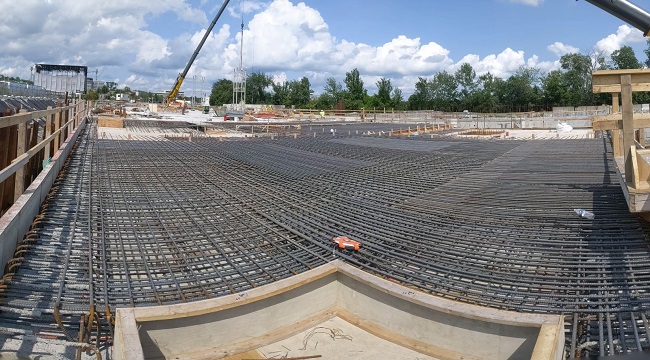
VR built the construction joint bulkheads separating elevated slab sections 11,12,17 and 18. They began to erect and move shoring/decking into Cell 2 for elevated slab sections 3 and 4, and they began to put plywood down for section 4.
Odin tied reinforcement steel for the top mats of elevated slab sections 11 and 18 on Thursday and finished the top mat for section 11 on Friday.
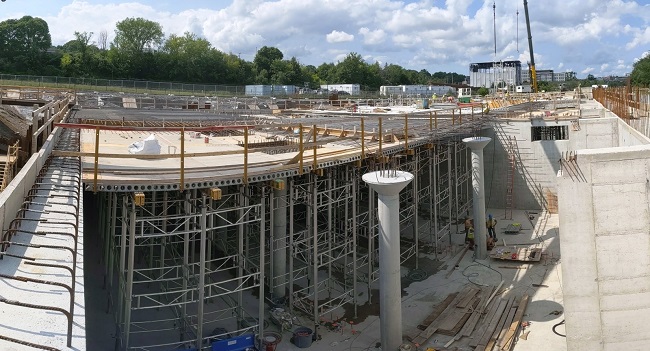
This is the Cell 3 in the southeast corner of the Tank. These last two elevated slab sections will be shored, formed and placed in the 1st or 2nd week of August.
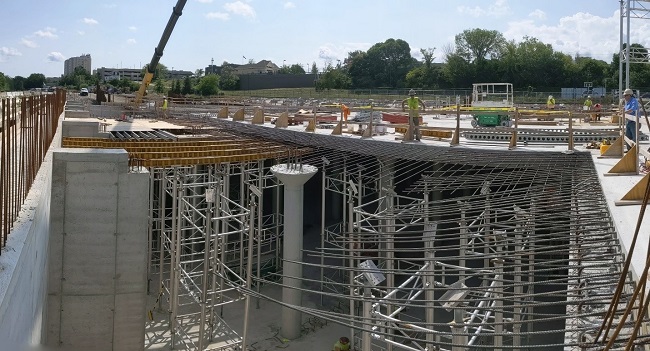
This is Tank Cell 2 on Thursday, July 15th. In the upper left photo corner elevated slab section 4 is shored, partially supported and decked. Mid and lower right in the photo shows elevated slab section 3 still needing a few shoring towers, beam supports and plywood decking. VR Concrete was off on Friday.

Friday, Macmillan put their job-built swing-screed into place to rough finish the 48” radius placed on the Tank slab beneath the tipping buckets. They placed 2 cubic yards of Hughes Brothers concrete with the crane and hopper-bucket for the Cell 1, bay 1 radius. This radius will redirect the flushing water, or channel the force of the flushing water around a 90 degree, vertical to horizontal bend from the tipping buckets into each bay of each Tank cell. Each tipping bucket holds 1,137 gallons of flushing water and this water will fall approximately 25 feet from the bucket to the radius/bend in the concrete Tank floor. This flushing water and its velocity will clean each Tank bay of solids and residue left on the tank floor after the tank has been pumped out from a CSO event.
Work progress 7-5-21 to 7-9-21
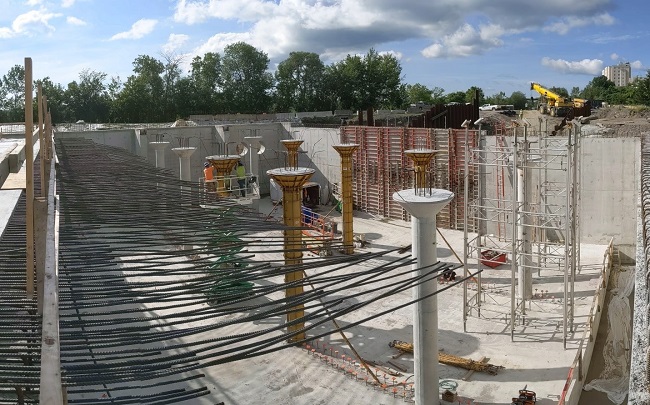
On Tuesday, after the Monday holiday, S.E. MacMillan worked on the retaining wall in the south shoring ramp. This retaining wall will hold a crane pad similar to the one they built in the north shoring ramp. SEM also stripped the scaffold, form ties and hardware from wall section 10. VR Concrete placed 33 cubic yards of concrete delivered by Hughes Brothers for the first section of tipping bucket walls (TB1) in Cell 1, bays 1 and 2. They also continued moving shoring/decking from Cell 2 into Cell 3.
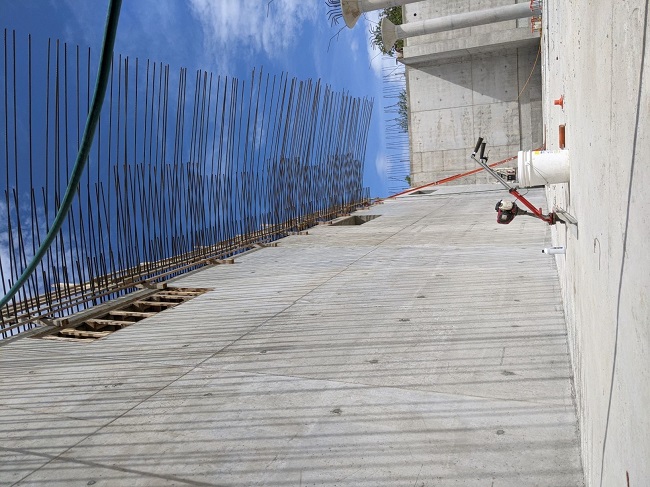
MacMillan finished the retaining wall and crane pad on Wednesday, plugged tie holes in Cell 1 and began stripping forms from Cell 3 columns. VR moved their 250-ton crane from the north ramp to the south ramp. They stripped form work from the first tipping bucket wall placement and began forming TB wall placement #2.

On Thursday SEM built stairs for access from the south ramp crane pad to the Tank Cell 3 footing and began building a ramp which will make access from existing grade to the southwest corner elevated Tank slab.
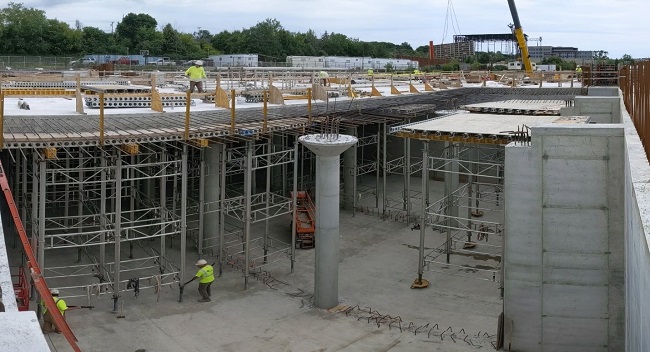
VR stripped TB 1 form work, finished forming TB 2 and on
Thursday placed 20 cubic yards delivered by Hughes Brothers for wall section
TB2. Walls over the tipping buckets are now complete in Cell 1 for bays 1 and
2. Both tipping bucket wall sections were placed with the crane and a
hopper-bucket. Friday’s work was shortened by rain. MacMillan did not work. VR
moved shoring/decking from Cell 2 to Cell 3 and left at 10:00 am on Friday when
the rain began to settle in.
Work completed 6-28-21 to 7-2-21
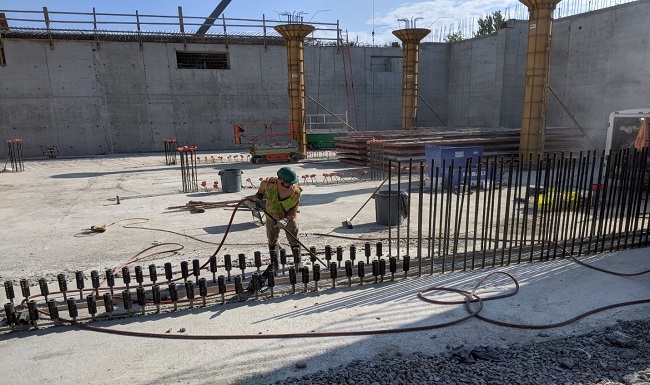
Devin Haight cleaned the water stop and construction joint for wall section 10. The wall dowels in this section were cut and had mechanical couplers attached for reinforcement continuation. The dowels were cut and a ramp was built over this Cell 1 wall section for crane and concrete pump truck access which would enable boom reach for Cell 2 concrete and material placement.
On Monday Odin Steel tied reinforcement steel for wall section 10. S.E. MacMillan drilled and doweled reinforcement steel for tipping bucket walls in Cell 1, pulled half column forms from Cell 3 columns and SEM trucks hauled fill for Thornton Construction to the Concert Venue on Railroad Street.
VR Concrete received results from S.W. Cole showing seven-day concrete compressive strength testing results for elevated slab sections 9 and 16. The breaks indicated a 7-day strength greater than 70% of ultimate design strength. With this favorable information they began lowering the shoring and decking in Cell 2 beneath elevated slab sections 9 and 16. All the shoring and decking will need to be removed from elevated slab sections 9,10,15 and 16 before another elevated slab section can be shored, decked and placed. VR worked all week on lowering and stripping the shoring and decking for elevated slab sections 9 and 16.
Odin finished tying steel for wall section 10 and MacMillan completed and closed the formwork on Wednesday.

These two photos, taken 364 days apart, (above) show the final full height wall section and columns being placed this week on Tuesday, and (below) one year ago, the first concrete placement in the northeast Tank corner of Tank slab section 1. MacMillan has placed just over 7,000 cubic yards of concrete during the past 12 months.
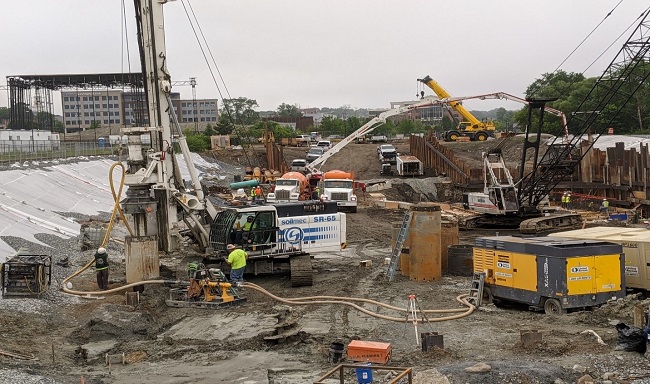
One year ago, H.B. Fleming had completed half of the Tank shoring as S.E. MacMillan was beginning to place concrete.
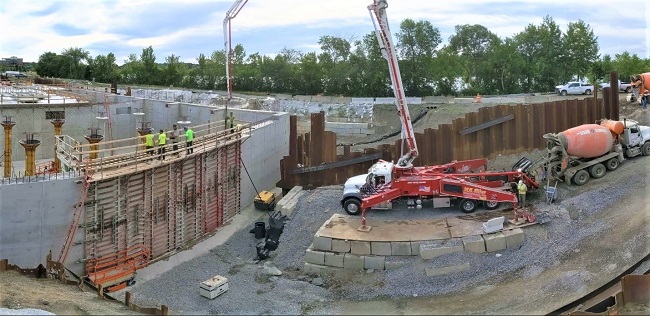
On Thursday Hughes Brothers delivered 123 cubic yards of concrete and an N.S. Giles’ pump truck pumped it into the forms for wall section 10 and the final five columns.
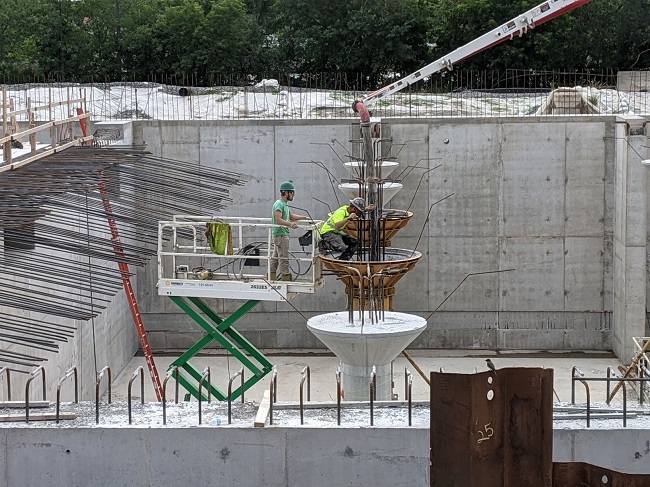
VR worked on tying reinforcement steel and erecting form work for the first section of tipping bucket walls in Cell 1. Odin set into place and tied reinforcement steel for the final five Tank columns in Cell 3. SEM began building a retaining wall and filling behind it in the south ramp to accommodate VR’s 250-ton Grove crane which will be moved to the south ramp next week.
Work completed 6-21-21 to 6-25-21

On Monday Odin Steel tied bottom mat reinforcement steel for elevated slab section 15.
This week S.E. MacMillan hauled approximately 4,000 yards of fill from the Roundhouse fill site to the Darling’s Waterfront Pavilion. Thornton Construction is having SEM haul 14,000 yards to the concert venue as part of site modifications in anticipation of coming music events. SEM also stripped off the temporary walkway decking over the Cell 3 sump channel. All three sump channels will get concrete fill to create a 1% slope across the Tank’s west side. The channels will then be pitching toward a sump. Each Cell has a five-foot deep sump channel running along the west side of the Tank, along with a five-foot deep sump on one end below the channel and a chopper pump mounted in the sump. Once on-line, after a CSO event, the three Tank chopper pumps will pump the captured CSO water out of each cell and back into the Davis Brook box-culvert conduit for subsequent treatment further downstream at the Bangor Waste Water Treatment Plant.

Monday and Tuesday VR Concrete built construction joint bulkheads and edge forms for elevated slab sections 1, 2, 10 and 15. SEM continued to plug form tie holes.
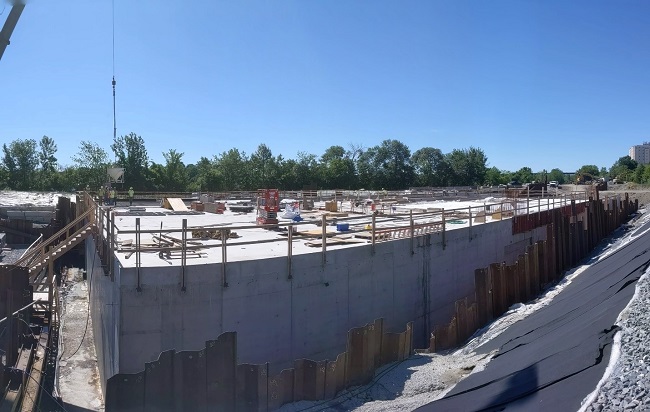
Odin tied top mat reinforcing for elevated slab section 15 and bottom mat reinforcing for elevated slab section 10. VR and SEM worked together, along with an N.S. Giles pump truck and S.W. Cole Engineering on Wednesday to place 120 cubic yards for elevated slab sections 2 and 15.

VR and SEM used one of the site cranes and a two-yard hopper bucket on Thursday to place 65 cubic yards provided by Hughes Brothers for elevated slab section 1.
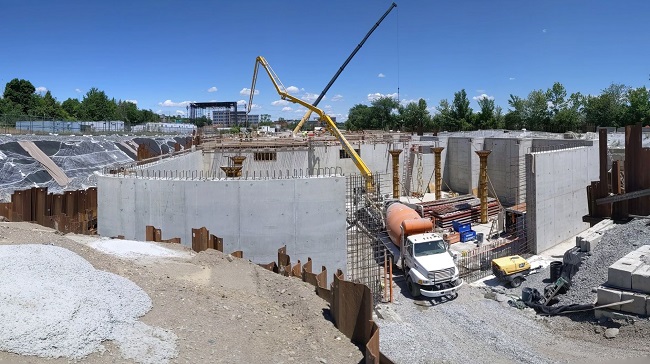
Hughes Brothers delivered a total of 190 cubic yards between 9:00 and 3:00 on Thursday for elevated slab sections 10, 1 and the Cell 3 sump channel. N.S. Giles pumped the concrete, VR and SEM placed and finished it.
Work completed 6-14-21 to 6-18-21

On Monday VR Concrete built shoring and decking supports for elevated slab section 1. Odin Steel tied reinforcement steel for elevated slab section 16. S.E MacMillan started plugging form tie holes in Cell 3.
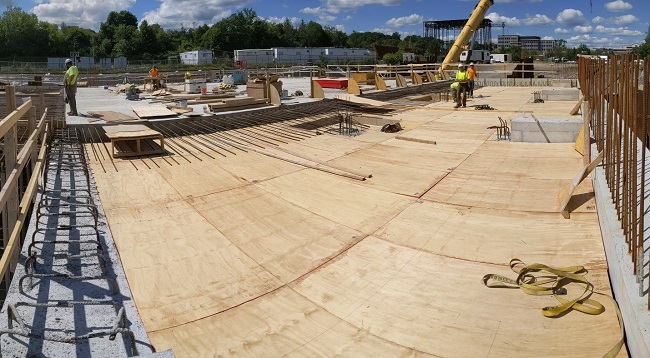
This photo shows elevated slab sections 1 and 2 on Wednesday with completed shoring and decking. Once these two sections are placed the elevated slab will be complete on Tank Cell 1. Odin worked on tying steel Tuesday and Wednesday for elevated slab section 16. VR built construction joint bulkheads and edge forms for elevated slab sections 15, 16, 1 and 2. SEM continued to plug tie holes in Cell 3 and bolted together column forms for Cell 3 columns I-2, I-6, H-2, H-3 and H-6.
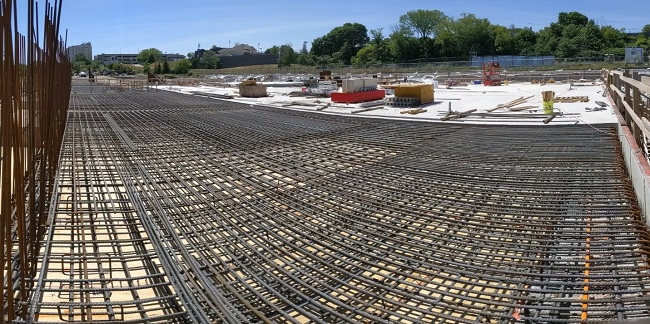
On Thursday Odin began tying steel for elevated slab sections 1 and 2, they completed the bottom mat and on Friday finished the top mat. Elevated slab sections 1 and 2 were shored, decked and had 35,000 pounds of reinforcement steel tied into place this week.
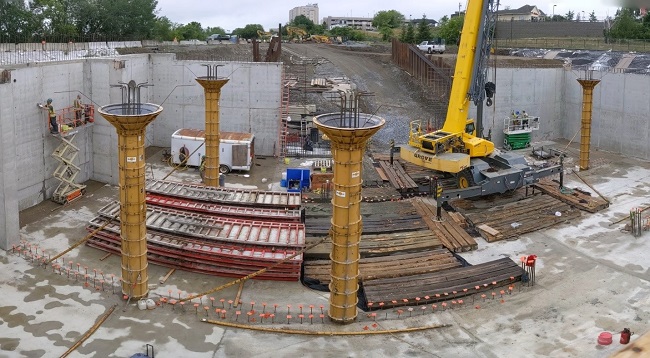
MacMillan prepped Cell 3 all week for leak testing to be done later this summer. They are plugging form tie holes with mechanical plugs and non-shrink grout.

On Thursday, SEM and VR placed concrete for Cell 2 elevated slab sections 9 and 16 along with Cell 3 columns I-2, I-6, H-2, H-3 and H-6. Mainely Concrete Pumping pumped 218 cubic yards of concrete delivered by Hughes Brothers.
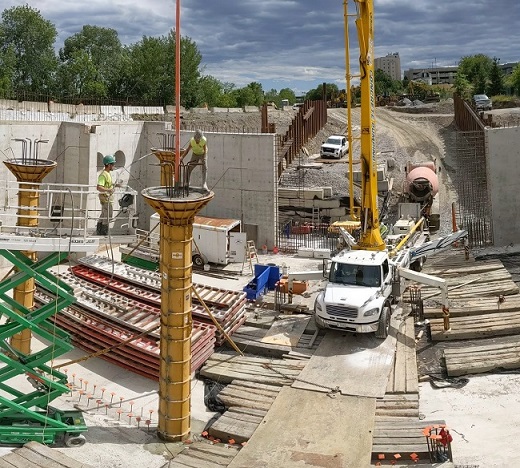
Each column is filled to half full, vibrated and them filled to finish grade and vibrated again. Each two-foot diameter column takes 3 cubic yards of concrete.
Work completed 6-7-21 to 6-11-21
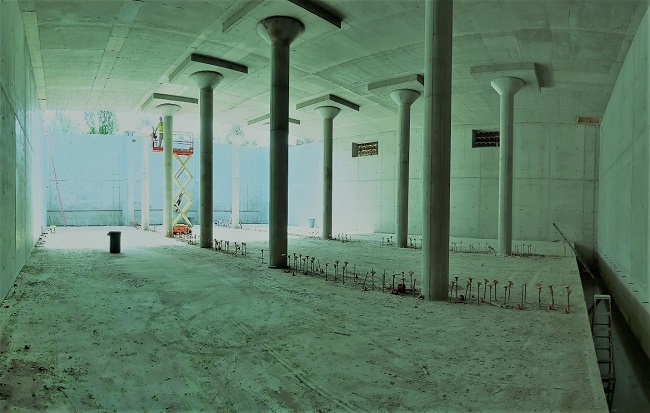
VR Concrete removed shoring and decking from Tank Cell 1.
On Monday, Odin steel tied wall-to-slab dowels for wall section 15 and column-to-elevated slab reinforcement for columns H-2, H-3, H-6, I-2 and I-6. VR Concrete built edge forms and scaffold railing along the west Tank wall for elevated slab sections 15 and 16. They set shoring tops to grade and began decking Cell 2 for elevated slab sections 9,10,15 and 16. They moved the final seven shoring towers from Cell 1 into place in Cell 2. S.E. MacMillan worked on installing wall form ties for wall section 15 along with building scaffolding and the construction joint bulkhead at the joint for sections 10 and 15. Wall section 10 is the last remaining full height wall section. This wall section is being left out for now so the concrete pump can set-up on the Cell 3 foundation slab and have the reach to pump elevated slab sections 9,10, 15 and 16.
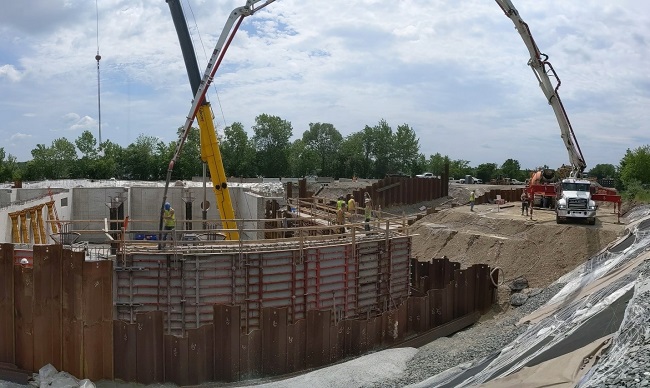
Tuesday, Hughes Brothers delivered 190 cubic yards of concrete. The placement for wall section 15 was pumped by N.S. Giles, tested by S.W. Cole and placed by S.E. MacMillan. VR decked Cell 2 elevated slab sections 9,10, 15 and 16.
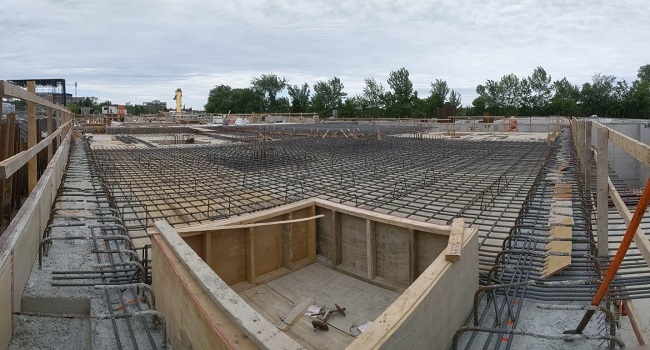
On Wednesday Odin tied reinforcement steel for elevated slab sections 9 and 16. SEM stripped ties, Hardware and scaffolding from wall section 14. VR build edge forms and bulkheads for elevated slab sections 9,10, 15 and 16.
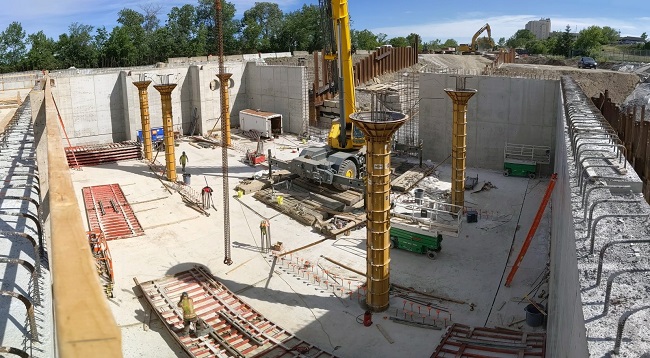
SEM stripped gang forms from wall section 15 on Thursday. VR started building and setting shoring into Cell 1 for elevated slab sections 1 and 2. Odin tied steel for elevated slab sections 9 and 16.

On Friday VR built and stood shoring and decking support in Cell 1 for elevated slab sections 1 and 2. SEM set crane mats onto the foundation slab in Cell 3 as a landing spot for the concrete pump truck to pump two elevated slab sections scheduled to be placed next week.
Retired City Engineer John Frawley and retired Waste Water Treatment Plant Superintendent Ralph Mishou visited and took a tour of the site this week. Between the 1960’s and the 1990’s these two guided Bangor through the design and construction of Bangor’s Primary and Secondary Sewer Treatment facilities. Together they represent over 60 years of engineering and water quality service to the City of Bangor.
Work completed 6-1-21 to 6-4-21
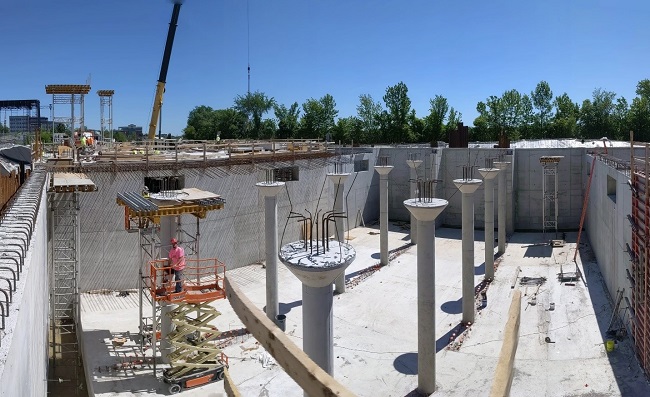
VR Concrete began moving shoring and decking from Tank Cell 1 into Cell 2.
On Tuesday, the day after the Memorial Day Holiday, there were twenty-five men on site. VR Concrete and S.E. MacMillan worked together on wall section 14. They stripped the column forms for E-3, E-4, F-3, F-4 and F-5 and stood half forms for Cell 3 columns H-2, H-3, H-6, I-6 and I-2. The weir bond-out for wall section 14 was installed into the form, scaffold and railing was built, turnbuckle braces were erected and the construction joint bulkhead between wall sections 14 and 15 was constructed. Odin Steel started ground tying reinforcement steel for wall section 15. They completed 2 mat sections of the 6 total and rigged them for the crane to set into place for the wall section 15. They also started tying wall-to-elevated slab dowels for wall section 14 and the extra diagonal reinforcement steel framing the wall 14 weir bond-out.

Wednesday morning Odin finished tying wall 14 wall-to-elevated slab dowels along with the extra reinforcement around the weir bond-out. Late morning, Hughes Brothers arrived with concrete for wall section 14. N.S. Giles pumped, S.W. Cole tested and MacMillan placed the 240 cubic yards delivered by Hughes Brothers between 10:35 am and 3:45 pm.
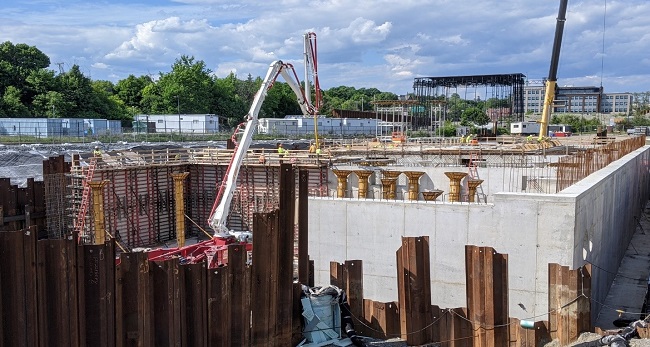
MacMillan is a week or two away from completing the full-height wall sections for Tank Cell 3.
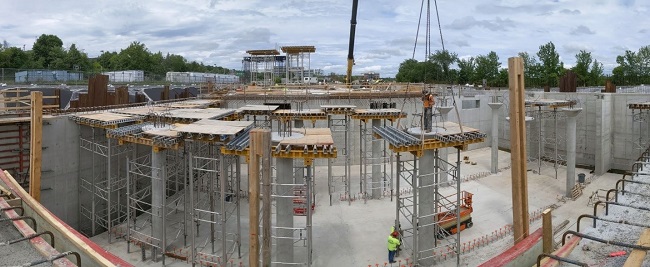
This week VR concentrated on elevated slab shoring and decking. They moved whole sections of shoring and decking from Tank Cell 1 to Cell 2. In a holiday shortened work week they moved 26 sections.
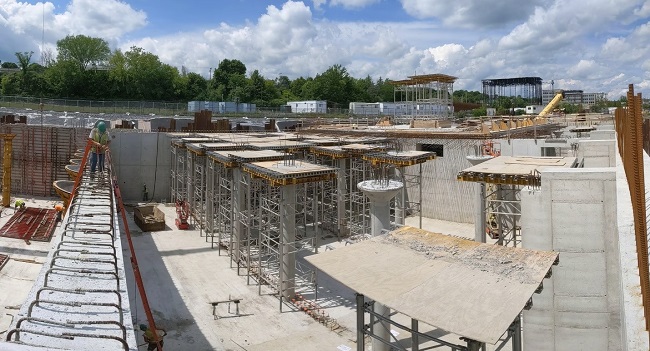
Thursday Odin tied column reinforcement steel into place for columns I-2, I-6, H-2, H-3 and H-6. They ground tied the four remaining reinforcement steel sections for wall 15 and then had them rigged and lifted into place with the crane. MacMillan stripped the construction joint bulkhead, hardware and scaffold for wall section 14. They began setting gang forms in place for wall section 15.

On Friday Tank Cell 1 had seven shoring/decking sections left below the elevated slab.
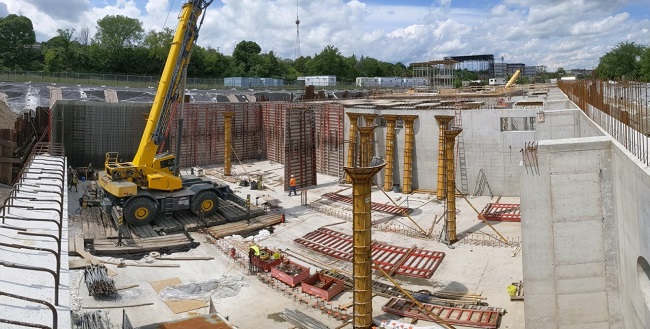
Also on Friday, MacMillan stripped gang forms from wall section 14. They cleaned and oiled them, stood them into place for wall section 15 and installed form ties and turnbuckle bracing.
Work completed 5-24-21 to 5-28-21

Monday, Odin Steel set ground-tied reinforcement mats for wall section 9 into place with S.E. MacMillan’s crane. VR Concrete and SEM worked together on removing form ties, hardware and scaffold ahead of moving gang forms from wall section 13 to wall sections 9 and 14.
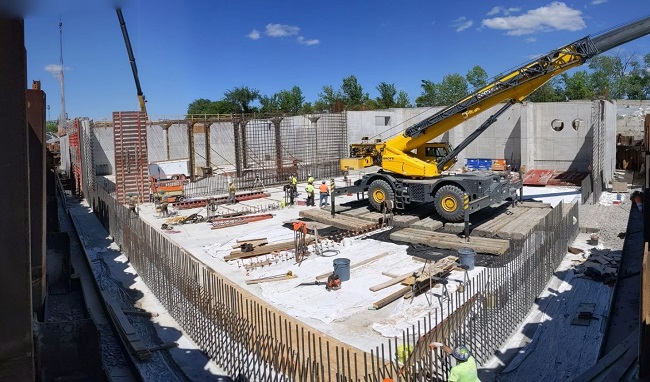
Tuesday, VR took delivery of another load of elevated slab shoring and form decking. Odin ground-tied reinforcement steel for wall section 14 and set into place one wall section 14 reinforcement mat and the remaining five column reinforcement cages for Cell 2. SEM stripped wall 13 formwork and stacked gang forms on the foundation slab for cleaning. VR and SEM set both faces of wall section 9 formwork and closed the formwork for the five Cell 2 columns.
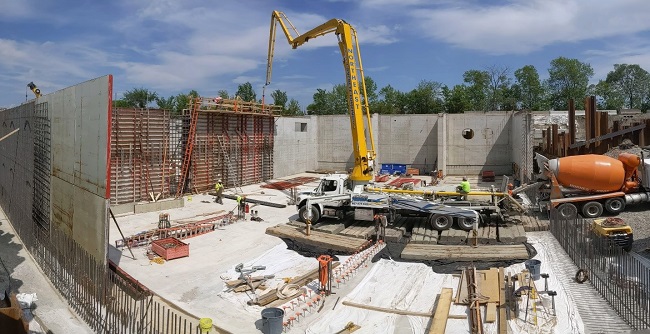
Wednesday morning Odin tied the wall-to-slab reinforcement dowels for wall section 9. VR and SEM built the construction joint bulkhead at the intersection of 9 and 14.
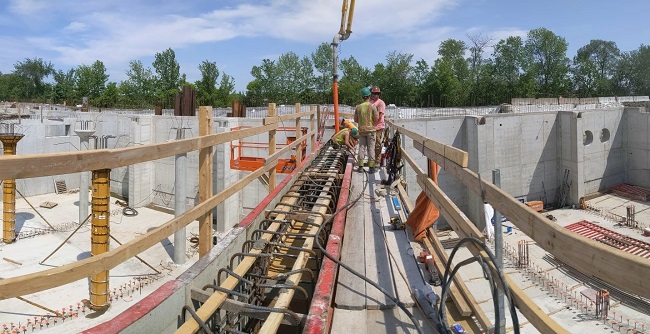
Wednesday afternoon Hughes Brothers delivered 104 cubic yards which was pumped by N.S. Giles and placed by VR and SEM. Wall section 9 was completed as well as columns E-3, E-4, F-3, F-4 and F-5. This placement brought the total concrete quantity to 1476 cubic yards for the month of May.
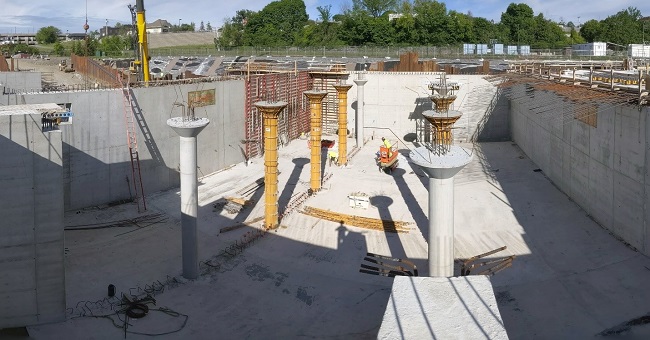
VR worked all week on stripping the formwork and plywood in Cell 1 from around the column capitals. They are lowering all the shoring/decking in order to put rollers under each shoring tower. The shoring towers will be rolled toward the eastside of Cell 1 where elevated slab sections 1 and 2 still need to be placed. Through these openings VR is rigging the shoring/decking towers and lifting them in one piece from Cell 1 to cell 2. Elevated slab sections 1 and 2 will be placed after all the shoring/decking for sections 7, 8, 13 and 14 have been moved from Cell 1 to Cell 2.

SEM has completed side slopes, gravel and loam for the new access road and parking lot to the Essex Woods Trail system. Hydroseeding will take place June 1st.
Work completed 5-17-21 to 5-21-21
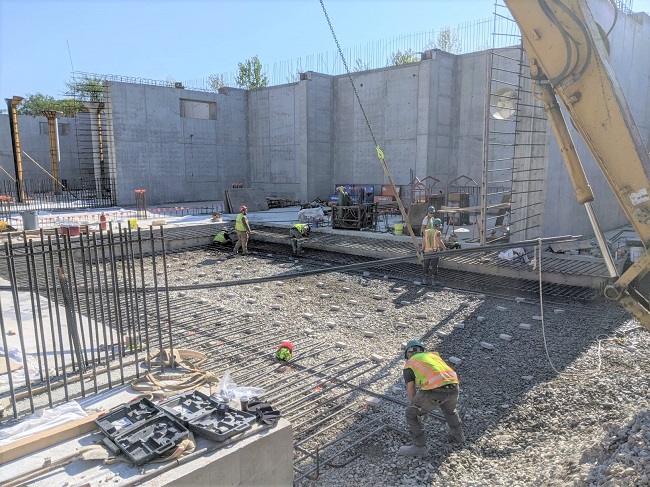
VR Concrete and Odion Steel were not on site this week.
S.E. MacMillan graded subbase stone, tied the top and bottom mat of reinforcement steel, installed forms and form ties, column dowels for columns I-3 and I-4, starter wall forms for the J-line starter wall and water stop for slab section 10.
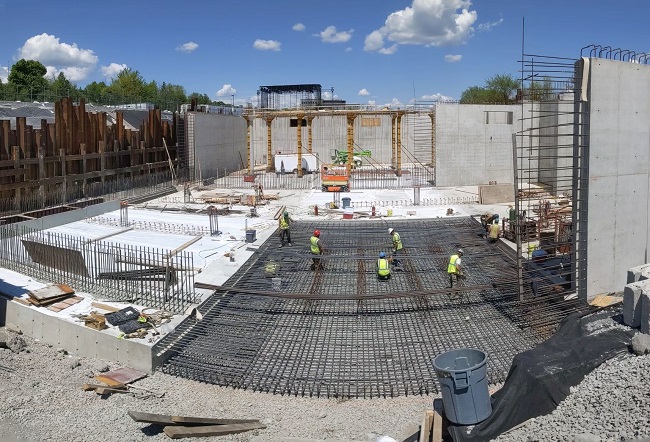
Slab section 10 is the last of fifteen foundation slab sections. MacMillan placed the first slab section on July 2nd of last year.
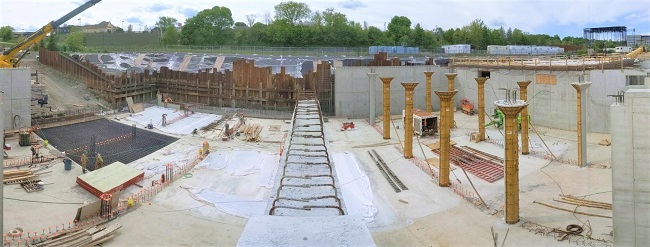
Tank Cell 2 is on the right, Cell 3 on the left. In the center is the full height G-line wall separating the two. The reinforcement bars sticking out of the top will tie the wall into the 20” elevated top/roof slab. When VR Concrete returns next week, together with S.E. MacMillan they will complete the G-line wall with two wall placements, wall sections 9 and 14. They also will begin removing shoring from Cell 1 with the crane for re-setting into Cell 2.
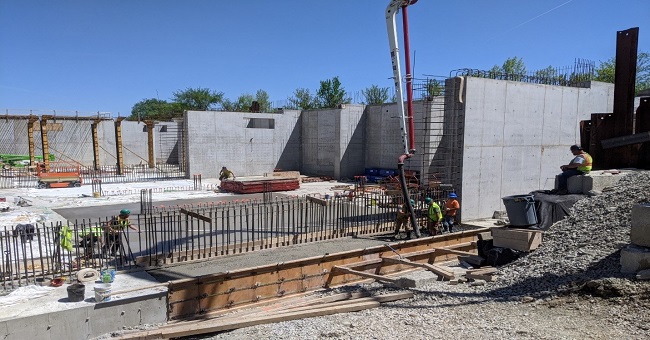
MacMillan placed slab section 10 on May 19th. Hughes Brothers delivered 190 cubic yards of concrete, Aaron McGinnis, their quality control specialist managed the control of air entrainment and slump. Brendan Auth, a concrete testing technician for S.W. Cole verified the air and slump for the City of Bangor. Ben Cookson pumped the concrete with an N.S. Giles pump truck.
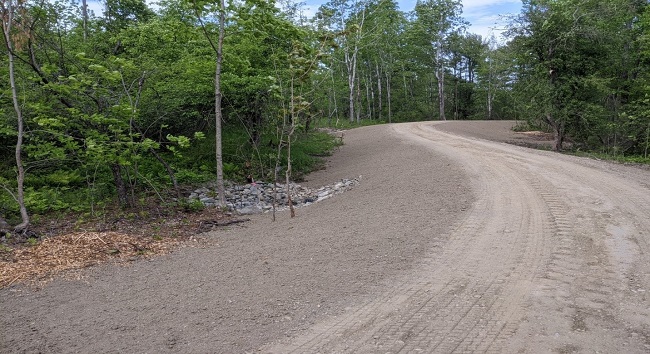
MacMillan has a crew working on finishing the access road, parking lot and trails for the new Essex Street entrance to the Essex Woods Trail system. Side slopes are being loamed, final gravel grade is being established and hydroseeding is scheduled for next week.
Work completed 5-10-21 to 5-14-21
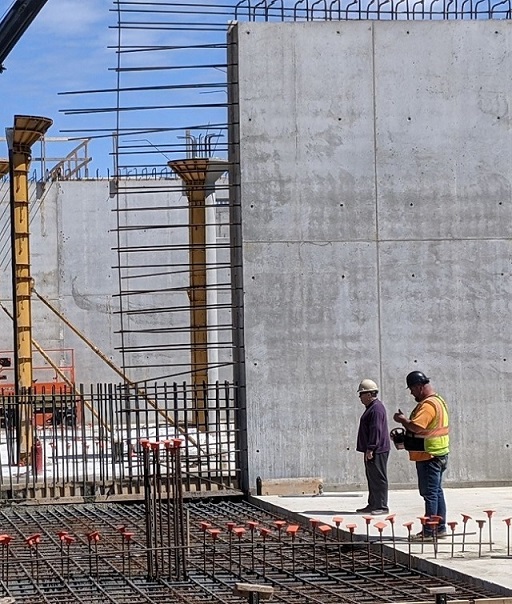
On Monday Stanley MacMillan and N.S. Giles pump truck operator Ben Cookson, watched the placement of slab section 9. O.J. Folsom delivered 216 cubic yards, pumped by Giles and placed and finished by S.E. MacMillan.
Odion Steel tied bottom mat reinforcement steel for elevated slab sections 8 and 13. VR Concrete built construction joint bulkheads for 8 and 13.
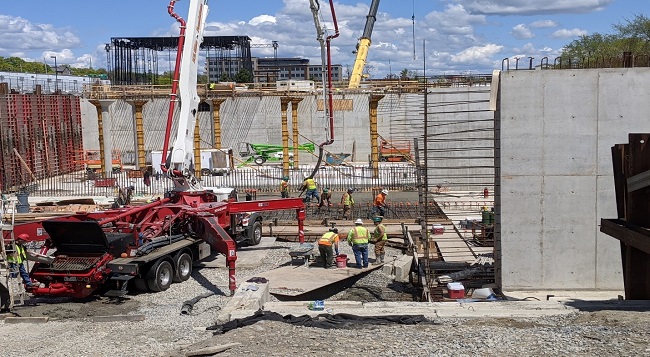
MacMillan placed slab section 9 on Monday leaving only two more foundation slabs to place.
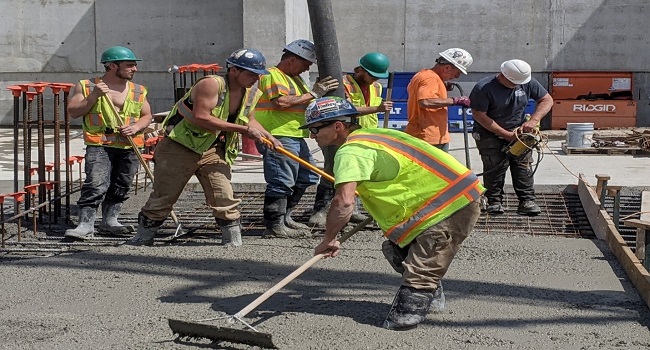
Devin Haight, Cody Hotham, James McClure, James King, Ian
Hotham, Richard Grumbach and Earl Grover placed and finished slab section 9.
On Tuesday, VR continued building bulkhead formwork for
elevated slabs 8 and 13 and Odion tied reinforcement steel for 8 and 13.
MacMillan graded subbase stone for slab section 15.3b and tied reinforcement
steel for 15.3b top and bottom mats.
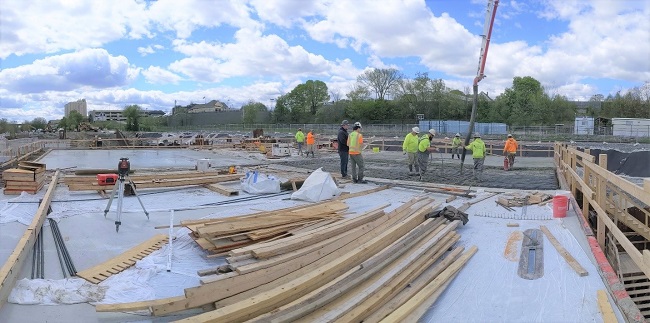
Wednesday Folsom delivered 220 cubic yards, pumped by N.S. Giles, which VR placed as elevated slab sections 8 and 13.
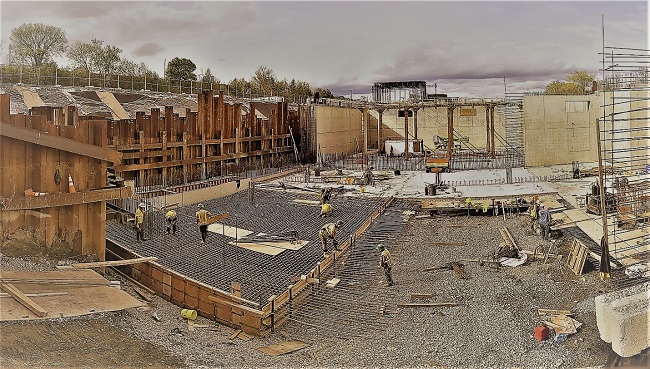
MacMillan tied column line J full height wall reinforcement steel for slab section 15.3b and stood form panels and installed form ties.
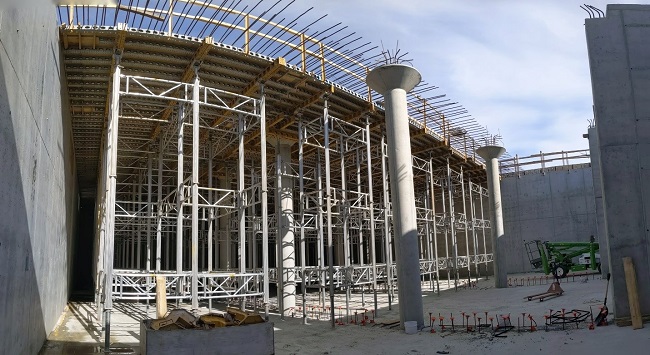
This is the inside of Tank Cell 1 looking toward the northwest corner. Four of six Cell 1 elevated slab sections have been placed. More shoring will be erected in order to support placement of the final two Cell 1 elevated slab sections.
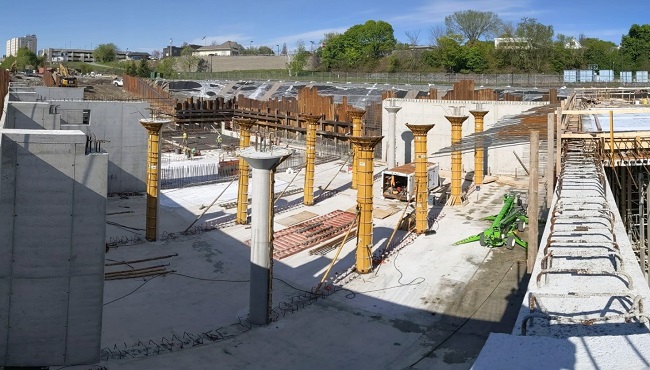
The right side of the photo shows a bit of shoring, elevated slab sections 8 and 14 and full height Tank wall for Cell 1. The column forms center and left are all in Tank Cell 2. Tank Cell 2 needs two more wall placements (#14 and #9) and it will be ready for elevated slab shoring, formwork and reinforcement steel. The elevated slabs for Cell 2 will be placed in June.

Thursday, Folsom delivered 210 cubic yards pumped by Giles
and placed by MacMillan for slab section 15.3b. One more slab section, #10, is
needed to complete the Tank Cell 3 foundation slab.
Work completed 5-3-21
to 5-7-21
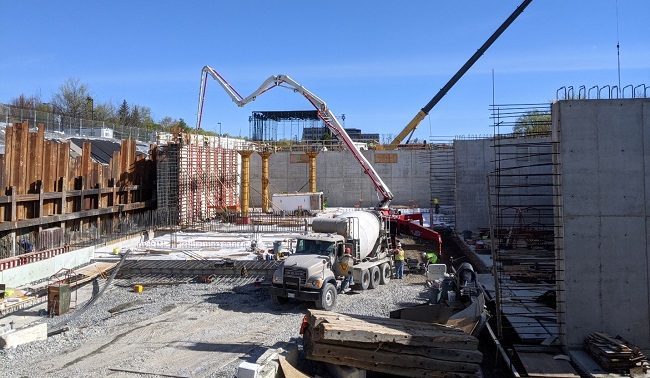
On Monday, VR Concrete placed 143 cubic yards of O.J. Folsom concrete; 128 cubic yards for wall section 13, and 15 cubic yards for columns E-2, E-5, E-6, F-2 and F-6. N.S. Giles provided the concrete pump. VR also built construction joint bulkheads for elevated slab sections 7 and 14. Odion Steel tied reinforcement steel for elevated slab sections 7 and 14.
S.E. MacMillan started the week forming and tying reinforcement steel for slab section 15.3a.
On Tuesday a structural engineer from AECOM, the Davis Brook CSO Storage Tank design consultant, came to the site to inspect the reinforcement steel for elevated slab sections 7 and 14. He found Odion had their bar lay-out, lap and concrete cover allowance all in order.
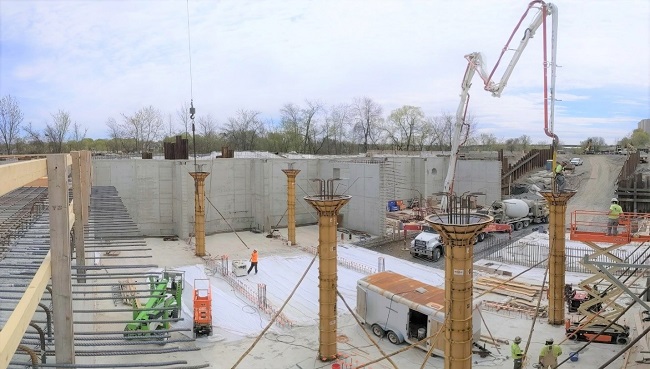
Each column form takes 3 cubic yards of concrete.
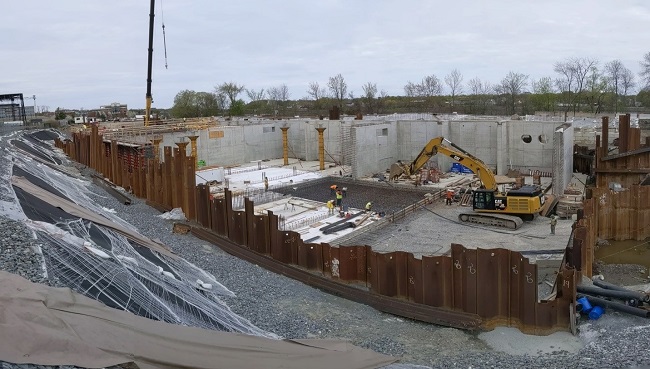
MacMillan worked Tuesday, Wednesday and Thursday on forming, tying steel, installing water stop and welding form ties for both slab sections 9 and 15.3a.

Thursday, VR placed 210 cubic yards delivered by Hughes Brothers and pumped by Mainely Concrete Pumping, for elevated slab sections 7 and 14. These are the first 2 of 18 elevated slab sections, each Tank Cell has six slab sections dimensionally defined by pre-determined construction joints.

Friday, MacMillan placed 86 cubic yards of Hughes Brothers concrete for slab section 15.3a.
Work completed 4-26-21 to 5-1-21
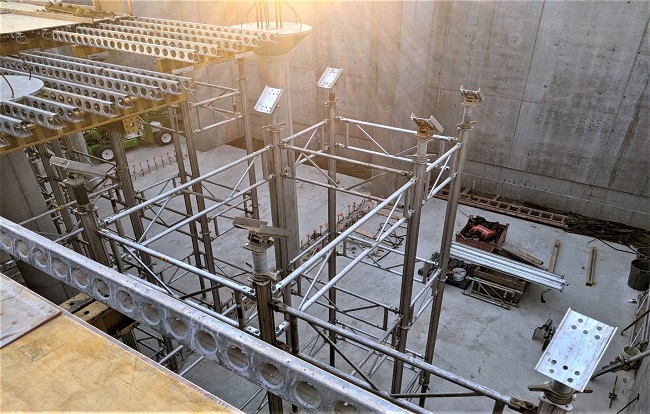
VR Concrete is using an EFCO E-Z Deck elevated slab shoring/form system. The photo above shows the shoring posts with U-Head tops, which carry the yellow Z-Beams, which carry the galvanized E-Beams, onto which the plywood decking is nailed.
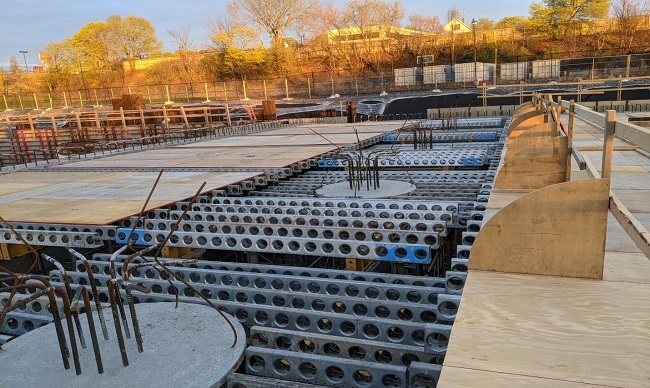
Galvanized E-Beams are ready for plywood decking. The E-Beams surrounding the column capitals are ten inches below the rest of the deck. VR will form a ten-inch-thick abacus which will top each of the round-cone capitals. Each ten-inch-thick, nine-foot square abacus acts as additional support for the elevated slab.
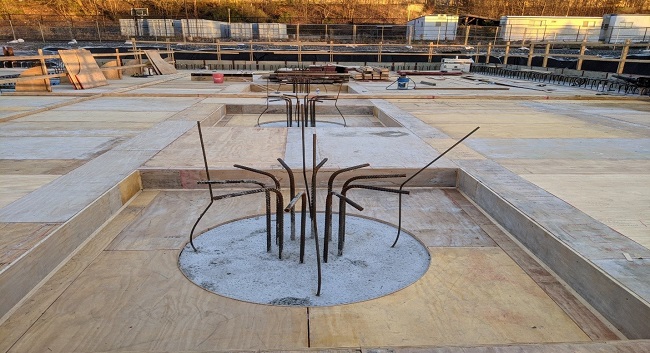
Here the 9’x9’ abacus capital tops are ready for reinforcement steel.
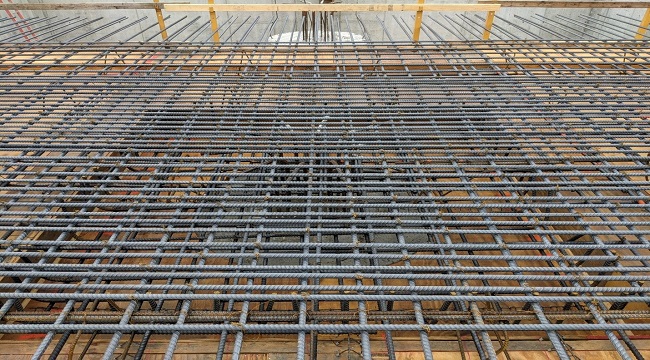
The reinforcement steel pattern is particularly tight where the columns tie the capital tops into the rest of the elevated slab reinforcement steel.
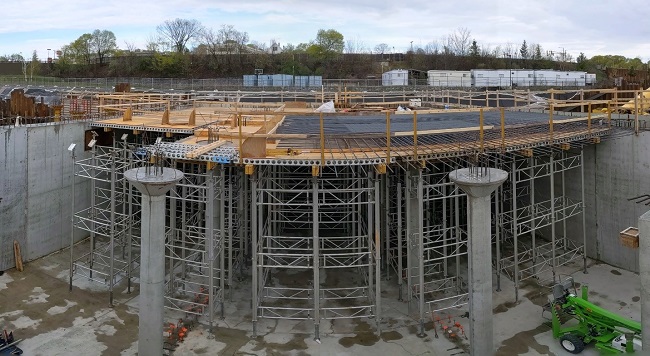
This week VR Concrete and Odion Steel got elevated slab section 7 near ready for placement next week. Elevated slab section 7 will be placed with section 14. There are six elevated slab sections inside Tank Cell #1, VR will be placing two at a time.
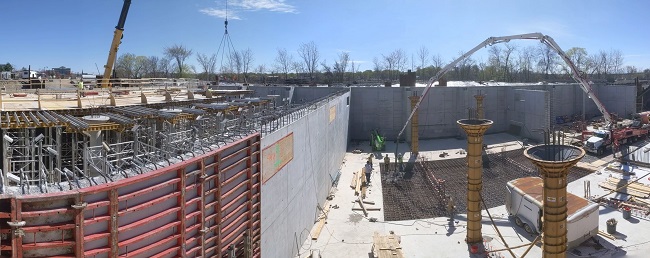
This week S.E. MacMillan placed slab sections 15.1, 15.2 and 8. In the above photo N.S. Giles’ pump truck is pumping concrete into the form for slab section 8. Section 8 is inside Tank Cell #2. Shoring and decking for Cell #1 is being built behind the full-height divider wall on the left.
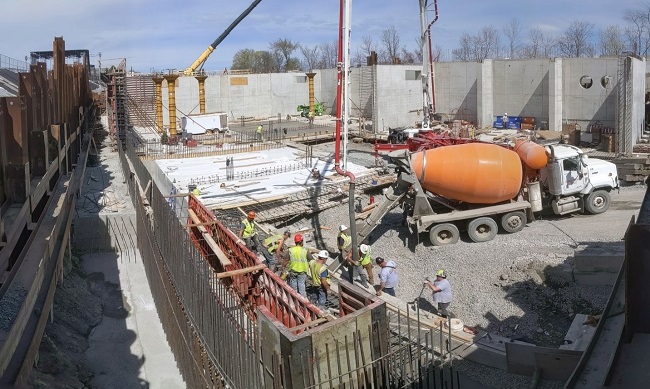
MacMillan placed slab section 15.2 using Hughes Brothers concrete and N.S. Giles’ pump truck.
Work completed 4-19-21 to 4-23-21
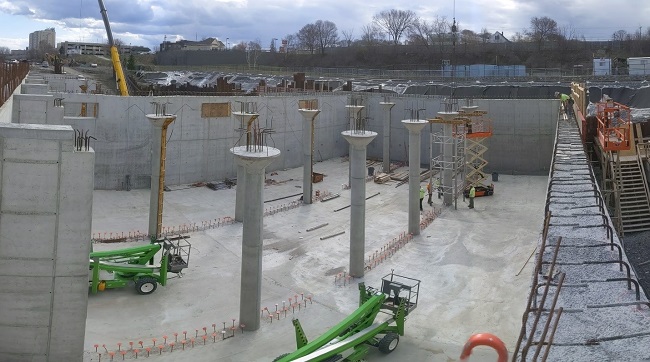
On Monday, VR Concrete began setting elevated slab shoring and decking form support in Cell #1.

S.E. MacMillan readied slab section 14.5b for Tuesday’s placement, completing slab formwork, water stop and starter wall form and tying column dowels (photo background). They also began tying reinforcement steel for slab section 15.1 (photo foreground).
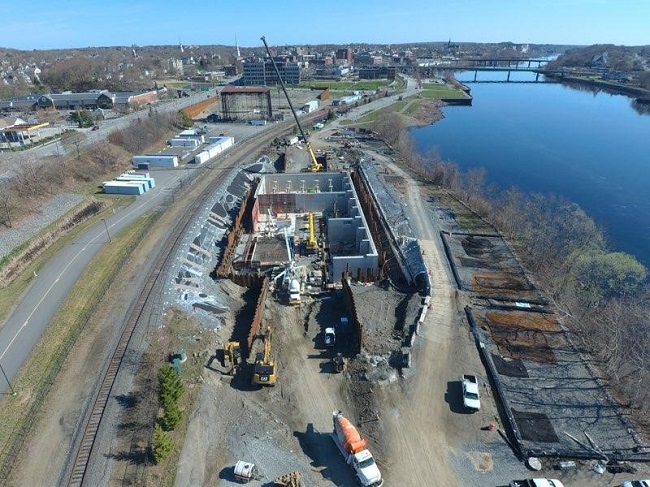
On Tuesday, Scott Kennedy, pump operator for Mainely Concrete Pumping, took drone photos of the Tank site.

Cell #1, in the north end of the Tank, can be seen to have full height walls complete. VR Concrete started setting elevated slab shoring and form decking in Cell #1 on Monday.

On Tuesday SEM placed 223 cubic yards of Hughes Brothers concrete for slab section 14.5b.
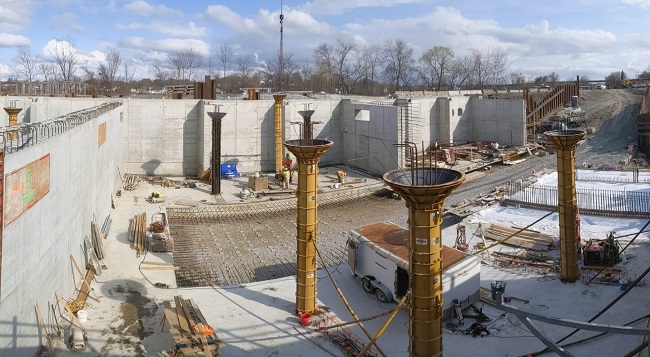
Wednesday SEM began tying reinforcement steel for slab section 8. VR stood five Cell #2 column forms for E and F column lines and continued erecting Cell #1 elevated slab shoring.
VR started placement of 145 cubic yards for wall section 13 on Thursday. In the first hour the pump truck malfunctioned, fifty yards were wasted and sent back to Hughes Brothers. VR removed a section of formwork, then shoveled and hosed out the small amount which was placed before the pump quit.
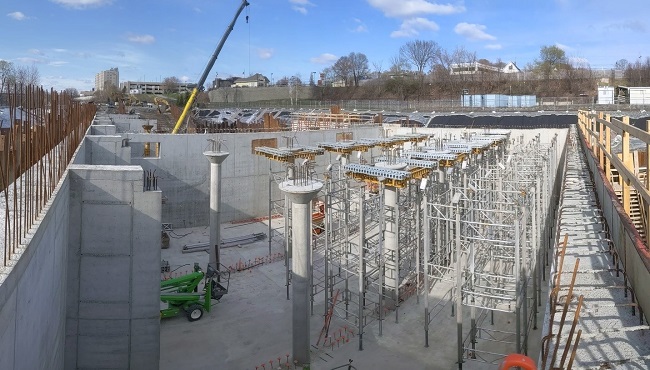
VR did not work on Friday. Above is Cell #1 showing the elevated slab shoring and formwork installed this week.
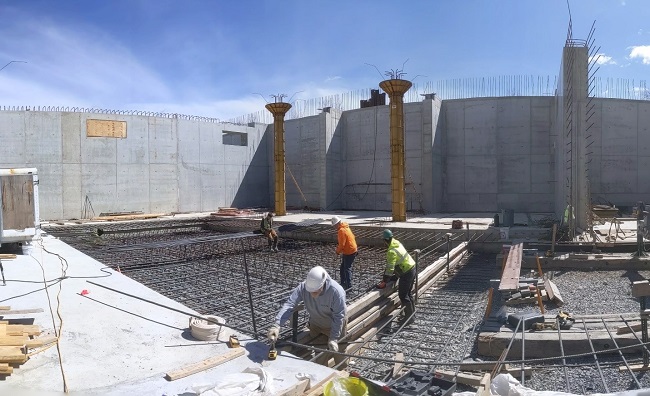
On Friday SEM worked on formwork, water stop and reinforcement steel in Cell #2 for slab section 8.
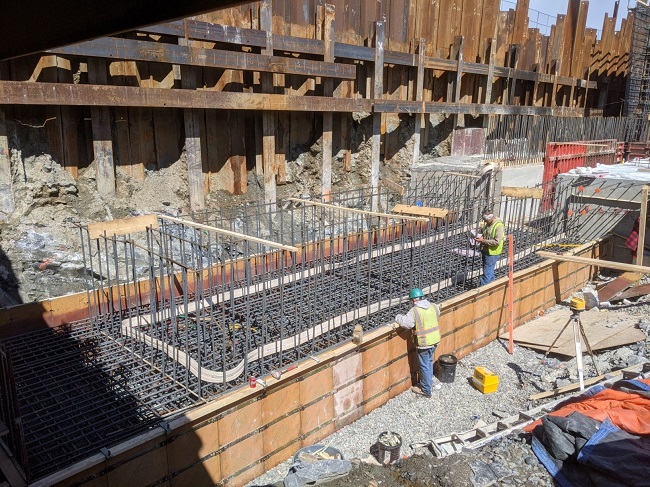
With water stop welded and hung, and finish grade marked on formwork, slab section 15.1 is ready for placement on Monday, 4-26-21.
Work completed 4-12-21 to 4-16-21

On Monday S.E. MacMillan placed slab section 14.4. Mainely Concrete Pumping, S.W. Cole and Hughes Brothers were on site to pump, test and deliver 100 cubic yards from 8:00 to 11:00 am. In the afternoon SEM began tying reinforcement steel for slab section 15.1.
V.R. Concrete received the first delivery of elevated slab scaffold and form material for Tank Cell #1. They continued work on wall section 12; installing form ties, building the construction joint bulkhead at the intersection of wall 12 and wall 13 and they completed the catwalk scaffold for the form top. Odion Steel tied reinforcement steel for wall section 12 at the intersection of column lines D and 7, along with the supplementary bars for the wall 12 weir bond-out and the wall to elevated slab dowels.
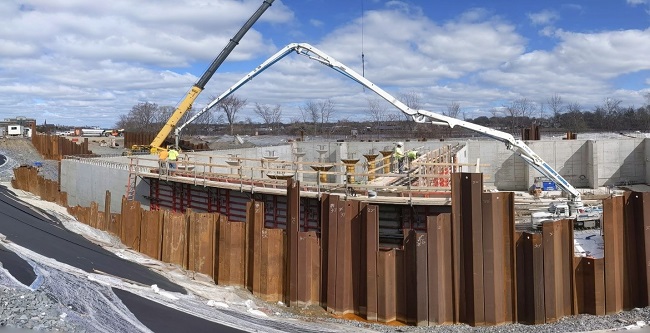
On Tuesday, VR placed wall section 12. Mainely and S.W. Cole were on site to pump and test and O.J. Folsom delivered 238 cubic yards of concrete between 2:00 and 7:30 pm. SEM tied reinforcement steel for slab section 14.5a, built formwork and fine graded stone subbase for slab section 14.5b.

SEM placed slab section 14.5a on Wednesday. Mainely pumped and S.W. Cole tested 75 cubic yards delivered by Hughes Brothers between 10:30 and 12:30. In the afternoon SEM began tying steel for slab section 14.5b. VR set half column forms for columns E-5, E-6, F-6, E-2 and F-2. VR also stripped formwork, bracing, hardware and scaffold from wall section 12.
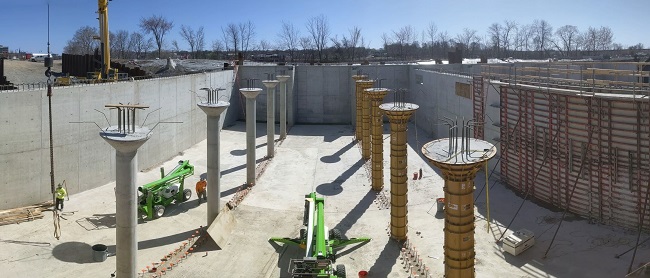
VR took the last elevated slab scaffold and form delivery for Tank Cell #1 on Thursday. The above photo shows Cell #1 near ready for elevated slab shoring. VR’s work week ended on Thursday afternoon.
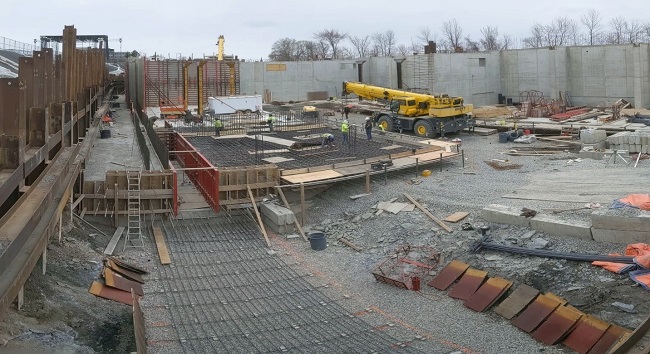
In the foreground SEM has reinforcement steel started for slab section 15.1. In the background section 14.5b was worked on both Thursday and Friday. They tied mat reinforcement steel, worked on forms, construction joint bulkheads, column and partition wall dowels, starter wall forms and welding and hanging water stop. Slab section 14.5b is scheduled to placed Tuesday, 4-20-21.
Work completed 4-5-21 to 4-9-21

This photo shows Tank Cell 1 and its northwest corner. This cell is nearing completion of full height wall construction. Wall section 12 is getting reinforcement steel tied and form panels erected for next week’s scheduled concrete placement. When the Tank is online in 2022, this northern most cell (one of three) will be able to hold 1.26 million gallons of combined sewer overflow.
On Monday, S.E. Macmillan placed 35 cubic yards of fill-concrete between slab section 14.2 and the sheet pile shoring wall. They tied reinforcement steel for slab section 13.3b and built the construction joint bulkheads between 13.3b and slab sections 14 and 8. VR Concrete stripped hardware from wall section 7. Odion Steel tied reinforcement steel for wall section 12.
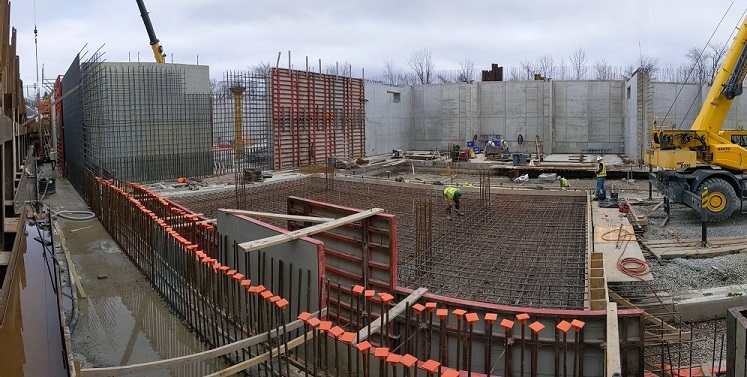
On Tuesday, (in the foreground) MacMillan tied reinforcement steel for slab section 13.3b, including four sets of column reinforcement dowels. There are 21 tons of reinforcement steel in slab section 13. VR Concrete set panel forms, installed form ties and scaffold hardware for wall section 12.

On Wednesday morning Macmillan placed concrete for slab section 13.3b. Hughes Brothers delivered 220 cubic yards, Mainely Concrete pumped it into the form and S.W Cole tested the concrete for air, temperature and slump. Later in the day MacMillan moistened the slab and covered it with a synthetic curing fabric.

In this photo (the Penobscot River flows south on the left) MacMillan is working southward on Tank foundation slabs. Slab section 13 is curing in the foreground, sections 14 and 15 will complete the west side Tank foundation to the southwest shoring corner. Center section Tank slabs are numbered (north to south) 6 through 10. Center sections 8, 9 and 10 remain to be placed. Foundation slab placements will be complete around the middle of May.
Thursday and Friday MacMillan worked on slab section 14.4. They graded the crushed stone subbase, partially set edge forms and began tying the bottom mat reinforcement steel. VR Concrete closed the forms for wall section 12. They hung the weir bond-out, built scaffold on the form top and began building the construction joint bulkhead between wall sections 12 and 13.
Work completed 3-29-21 to 4-2-21
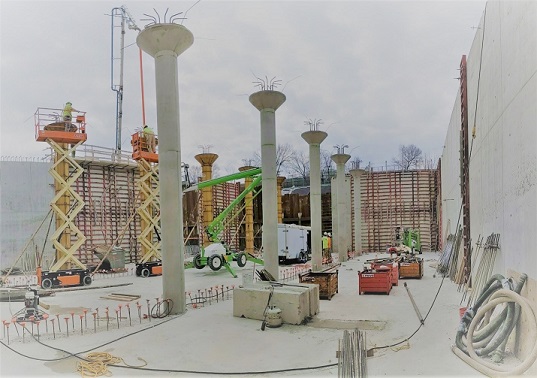
This week VR Concrete removed the formwork from the five B-line columns. Their cone-bell tops await a ten-inch high, nine-foot square abacus to complete their capitals. Ten of these Doric order columns will support each of the twenty-inch thick cell sections of cast-in-place concrete roof slab. Shoring erection, building formwork and tying reinforcement steel for the Cell 1 roof section will begin the second week of April. Once the roof slab has been cast and the tank is operational, these columns will remain unseen.
S.E. MacMillan made two concrete placements this week. On Tuesday O.J. Folsom delivered 35 cubic yards which was tailgated into the forms for slab section 14.2. Slab section 14 has six separate placements, the third (14.3) was made on Friday. Folsom delivered 106 cubic yards pumped by Mainely Concrete Pumping’s pump truck.
On Wednesday V.R. Concrete placed concrete for wall section 7 and the five B-line columns. O.J. Folsom delivered 106 cubic yards and Mainely Concrete Pumping pumped it into the forms.
Odion Steel had seven iron workers on site. They used VR’s crane to set pre-tied column steel into place for both C-line and B-line columns. They also tied reinforcement steel for wall section 7.

A drone camera took this photo of the Tank during wall section 7 placement on March 31st.
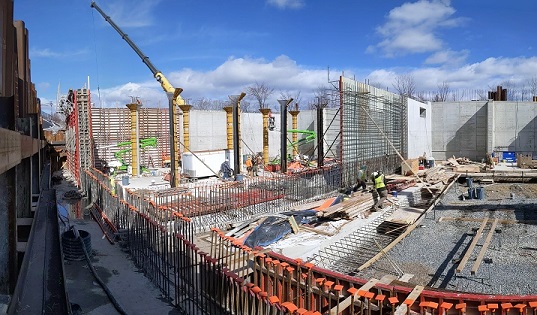
The southwest corner, wall section 12, is the last wall section needed to complete Tank Cell 1.
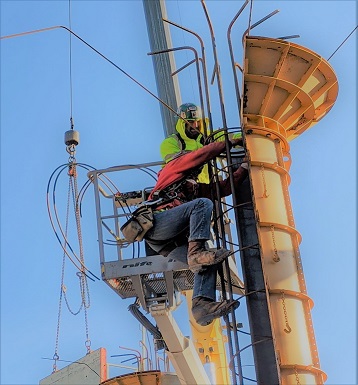
Two Odion ironworkers tie reinforcement steel for connecting a C-column bell-cone and capitol to the Tank Cell 1 roof slab.
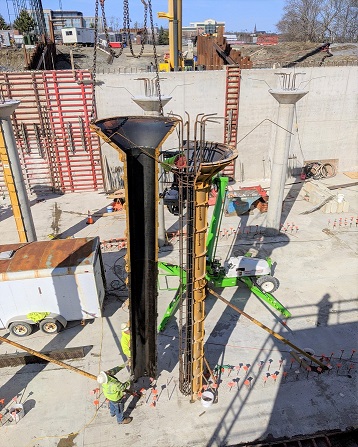
The column forms are set in halves. One half is set, plumbed and braced, then the column steel is set into place, then the second half is set and bolted to the first. Each column form holds 3.25 cubic yards of concrete.

Two O.J. Folsom mixers are backed up to the Mainely Concrete pump hopper for placement of slab section 14.3. This slab section has two sumps, one each for Tank Cell sections 2 and 3.
Work completed 3-22-21 to 3-26-21
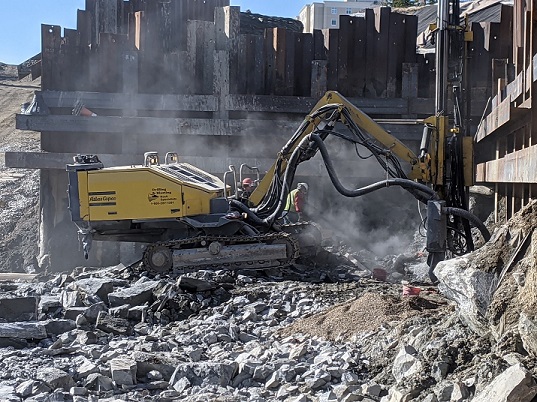
Drilling and Blasting Rock Specialists made three shots on Monday and it is expected the blasting is complete. S.E. Macmillan began excavating the broken bedrock on Monday afternoon.
V.R. Concrete made their first placement on Monday. Hughes Brothers delivered 108 cubic yards of concrete, tested by S.W. Cole and pumped by N.S. Giles, for wall section 6 and the five columns on the B-column line. VR covered the top of the wall and wrapped the columns with insulating blankets. Odin Steel tied the outside corner steel for wall section 11, this will be put in place by the crane. VR set the outside corner forms for wall section 11.
SEM tied steel and formed slab section 14.1, which is the base of two of the Tank’s three dewatering sumps. These sumps are the lowest parts of the Tank from which thirty-horse-power chopper pumps will pump the CSO dry.
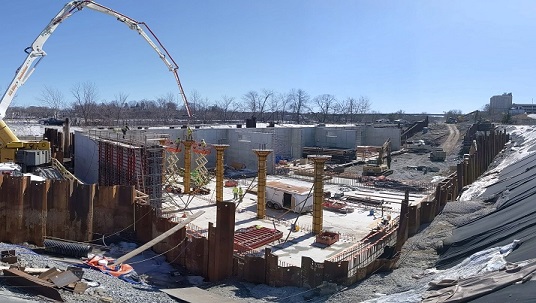
N.S. Giles set up the pump in the north ramp area for wall section 6.

Parker McKinnon vibrated the concrete for one of the columns on the B-column line.
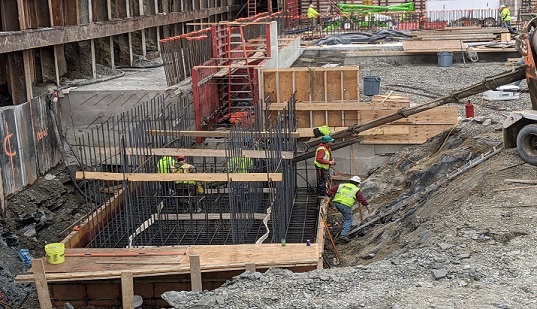
Hughes Brothers brought 50 cubic yards Thursday for SEM’s placement of slab section 14.1.

SEM worked all week removing the broken bedrock and hammering some high spots with an excavator/hammer where bedrock had been fractured by dynamiting but was still too tight to excavate freely. By Friday, the southwest Tank corner was excavated to subgrade.
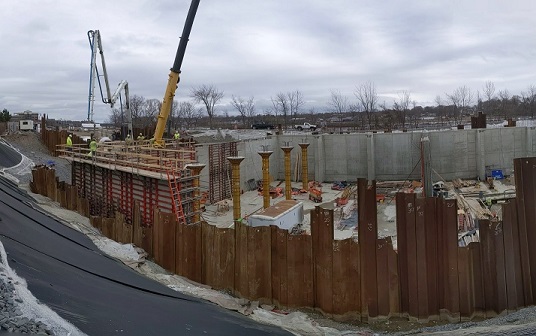
Also on Thursday, Hughes brothers delivered 210 cubic yards that Mainley Concrete Pumping pumped into the forms for wall section 11.
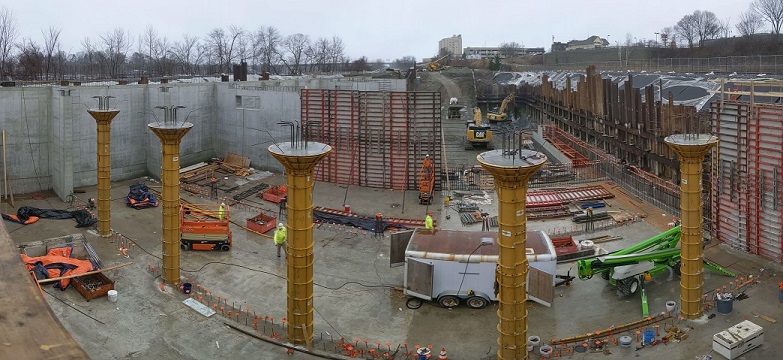
With two more wall placements – sections 7 and 12 – full height walls for Tank cell #1 will be complete. Shoring for the roof slab over cell #1 will begin the second full week of April.
Work completed
3-15-21 to 3-19-21
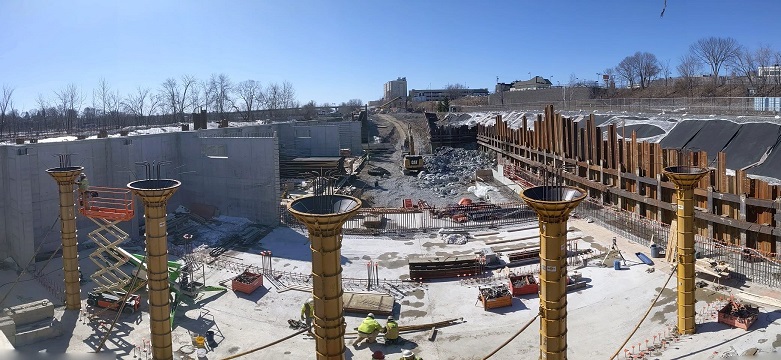
S.E. Macmillan was joined on site this week with three other contractors. Drilling and Blasting Rock Specialists (DBRS), V.R. Concrete (VR) and Odion Steel (OS).
DBRS started drilling and blasting on Monday. They drilled and loaded eighteen total holes, made six shots and did not have seismograph reading higher than 0.49 PPV (avg of VHT). They started near where SEM had left off with slab section 13 and designed shots for relief away from the new concrete with shots progressing toward the southwest corner shoring wall. SEM tended to DBRS, moving blasting mats and bringing stem stone as necessary. Drilling and blasting took place until Thursday. They reached the southwest shoring corner bracing Thursday, drilling and blasting as far as they could. SEM and a subcontractor for H.B. Fleming took down the cross bracing on Friday. For the week, DBRS made twenty shots with a total of 116 holes and no seismograph reading higher than 0.96
VR arrived on site Monday and began setting up their job trailer and surveying the site. They started doing layout for B columns and wall sections 6, 11 and 7.
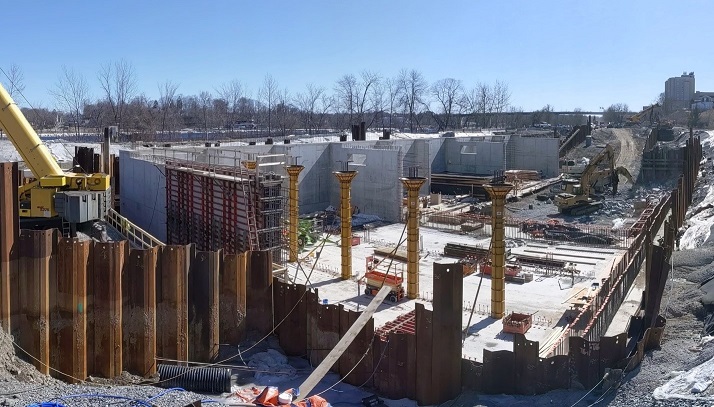
OS came to the site on Wednesday. This week they tied and set reinforcement for wall section 6 and all five B column-line columns. They also began pre-tying steel for wall section 11.
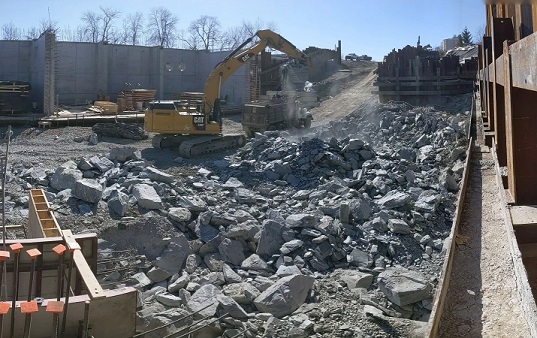
SEM excavated dynamited bedrock. Most of the crew spent the week organizing equipment, lumber, form material and reinforcement steel in anticipation of splitting the remaining concrete work with VR.
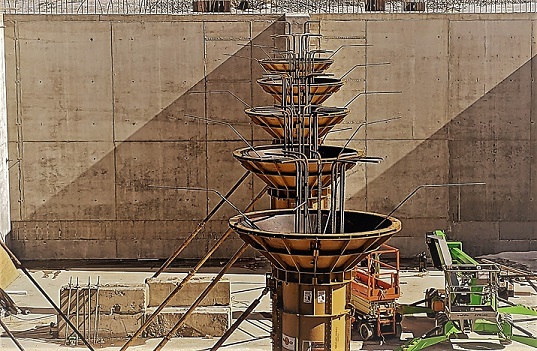
VR made both wall section 6 and all five columns for column-line
B ready for a concrete placement at 8:00 am on Monday, 3-22-21.
Work completed 3-8-21 to 3-12-21

On Monday, S. E. Macmillan placed slab section 13.2b. O.J. Folsom delivered fifty cubic yards pumped by Mainely Concrete Pumping and tested by S.W. Cole. In the afternoon Macmillan began to tie steel for slab section 14.1. They tightened the insulating cover over the ground heater hoses for slab section 8.
SEM on Tuesday began excavating the southern end of the Tank to expose the high bedrock. Drilling and Blasting Rock Specialists will be on site next week to start drilling and blasting. It is estimated that there is as much as 1,000 cubic yards to be removed.
In anticipation of the arrival of VR Concrete, a concrete construction contractor from Colebrook, New Hampshire, Macmillan undertook significant house cleaning on the slab and over the entire site. During the week they organized material, equipment and formwork. VR Concrete, along with Odin Steel Inc, from Plainfield, N.H, will start on wall section 6 Monday. VR and Odin are expected to complete the majority of concrete and reinforcement steel construction on the tank.
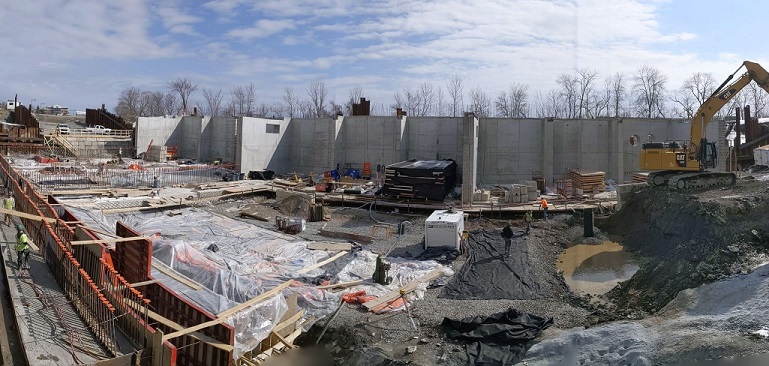
Subbase for slab section 8 is covered and heated against frost penetration.

Macmillan built a retaining wall of concrete blocks across part of the southern ramp. They have regraded the ramp lowering the travel angle for truck and crane traffic. Tank excavation, aside from high bedrock, was completed on Friday. SEM worked half a day on Saturday to complete the new ramp angle which will allow access for the blasters.

S.E. Macmillan’s crew, left to right; Matthew Gamache, Garrett Burke, Richard Grumbach, Fred Massow, Nicholas Hotham, Jeff Glidden, Jon Robertson, James King, Devin Haight, Cody Hotham, Ronald Beal, Joshua Burke, James McClure, Mike Zallen, Earl Grover, Richard Merrithew. (Missing from the photo, Stanley and Sean Macmillan)
Work completed 3-1-21 to 3-5-21
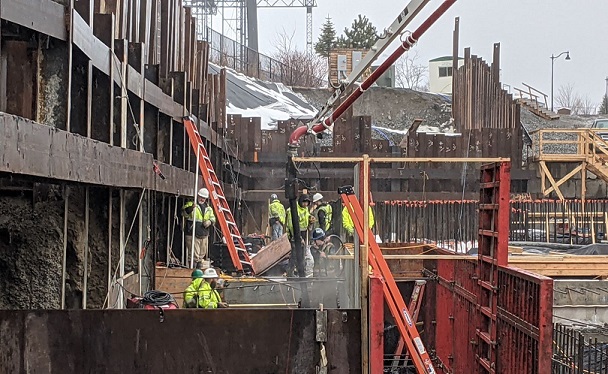
S.E. Macmillan had a crew of fifteen on site this week. On Monday, Drilling and Blasting Rock Specialists brought a hydraulic track drill to the site to continue drilling into the high bedrock in slab section #14. Also on Monday, Brendan Auth from S.W. Cole and Wyatt Sylvester from O.J. Folsom were on site at 9:30 am to provide quality control for the fifty cubic yards of concrete Folsom delivered to the site and placed as slab section 13.2a. N.S. Giles pumped the concrete.
Macmillan unloaded a truck load of reinforcement steel from Dimension Steel, of Scotia, New York, for slab section #14.
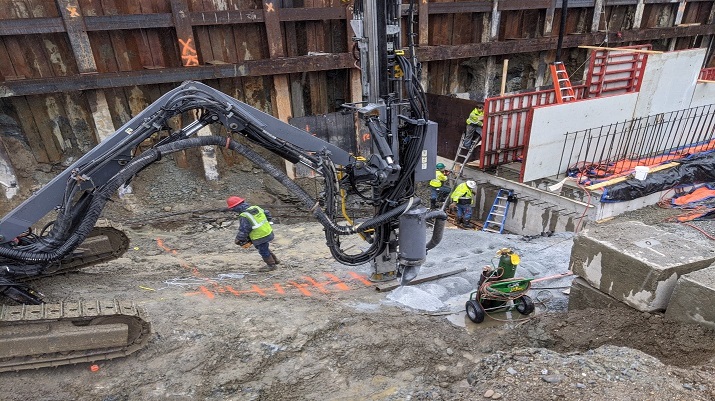
Drilling and Blasting Rock Specialist’s drill operator, Jason Pierce, line-drilled the outline of the rectangular double sump location in slab section #14. He drilled four-inch diameter holes about twelve inches on center. When the rock is broken these lines will make a vertical face, a box in the rock for the initial sump form work (#14.1) to set into. The second and third (#14.2 and #14.3) phases of #14 will fill the bedrock box outside of the bottom slab area with concrete. Line-drilling will continue in the high bedrock on a parallel line about three feet inside of the west and south side shoring line. This line-drilling and the vertical face established, will protect the bedrock shoring toe - which the soldier piles are drilled into - from losing toe integrity when rock is blasted/excavated on the Tank side of the vertical rock face.
Macmillan had work to do with the crane on Tuesday, but it was canceled due to 20-30 mph winds with gusts to 40 mph. The crew came in, checked heat and cover on the previous day’s concrete placement and went home early.
On Wednesday, Macmillan worked on slab section 13.3a. They tied reinforcement steel, plumbed the sump channel wall forms and welded DYWIDAG threaded anchor rods as form ties to the shoring wall.

Thursday, in the morning Macmillan completed the south-end construction joint bulkhead and hung the waterstop into place. S.W. Cole and O.J. Folsom quality control technicians along with Ben Cookson, the operator of the N.S. Giles pump truck, got set up just before noon. Folsom delivered 90cubic yards between 12:10 and 2:30 pm. Macmillan finished and covered the fresh slab section with glycol heating hose and insulating blankets.
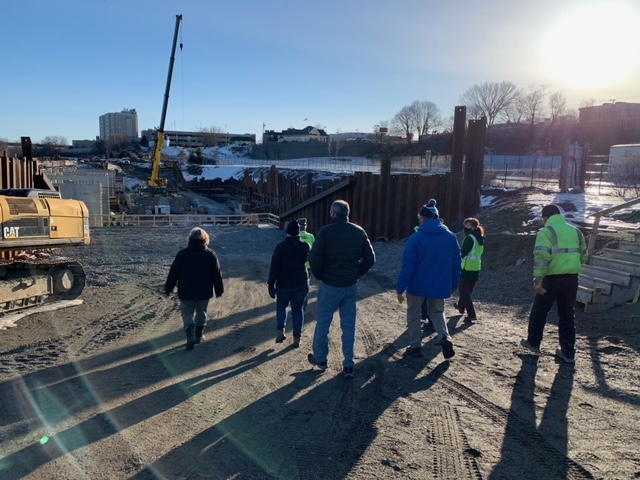
Thursday afternoon the Tank site was visited by Bangor’s City Manager, Cathy Conlow and five members of the City Council – Chairman, Dan Tremble and Councilors Sarah Nichols, Rick Fournier, Clare Davitt and Jonathan Sprague. Accompanying the City Manager and City Councilors were Amanda Smith and Wade Duplisea from the Waste Water Treatment Plant and John Theriault, the City Engineer.
Friday, Macmillan began forming and tying reinforcement steel for slab section 13.2b.
Work completed 2-22-21 to 2-26-21

On Monday S.E. Macmillan placed slab section 13.1. O.J. Folsom delivered 80 cubic yards, the concrete was tested by Brenden Auth, from S.W. Cole Engineering. N.S. Giles’ pump truck set up at noon, the placement lasted until 3:00 pm. The following day N.S. Giles pumped structural fill concrete for Macmillan. O.J. Folsom delivered 60 cubic yards of 4000 psi concrete and Macmillan placed and finished it between slab section 13.1 and the shoring wall.
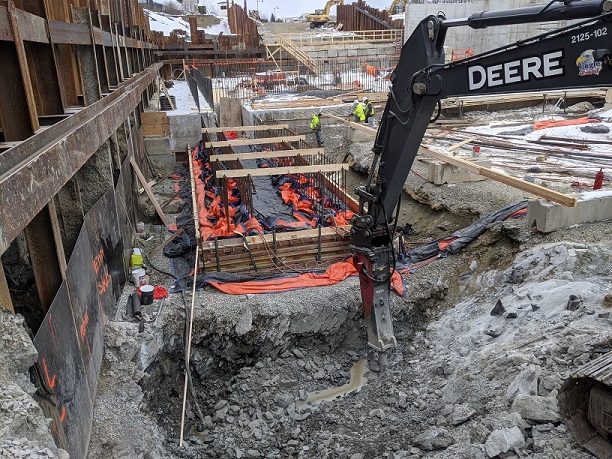
Macmillan hammered perforated bedrock on Wednesday and
formed slab section 13.1a.
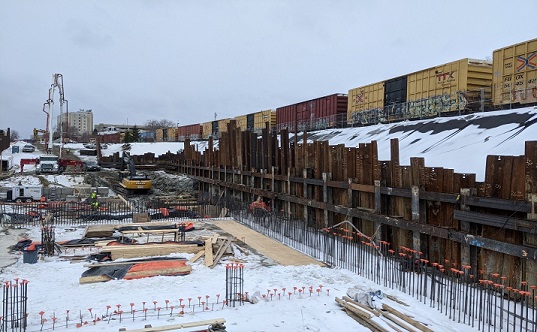
Thursday, they finished forming and tying steel for 13.1a. They used the crane and a three-yard hopper bucket to place 20 cubic yards of concrete delivered by O.J. Folsom. Chris Raymond and Brenden Auth were on site from S.W. Cole to test the concrete. Wyatt Sylvester was on site as O.J. Folsom’s quality control technician.
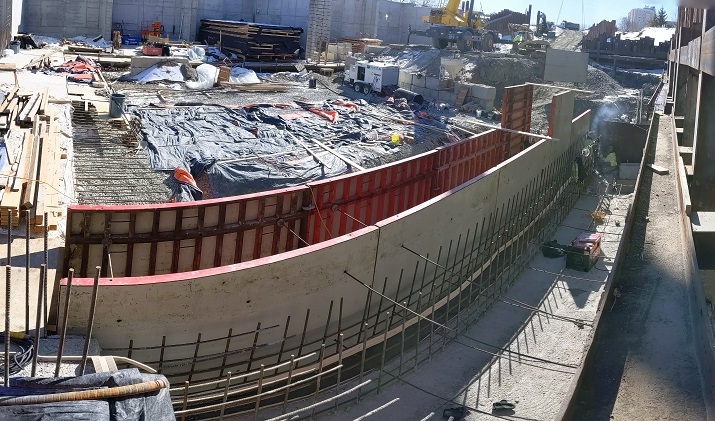
Macmillan worked both Thursday afternoon and Friday on forming the sump channel in slab section 13. Both days Macmillan excavated to clean off the high bedrock evident in slab sections 14, 15 and 9. They plan on placing section 13.3 to the top of the foundation slab against the shoring. They will then complete the borrow excavation of the Tank, expose the remainder of the high bedrock and then drill and blast to remove the bedrock working from the south eastern side of the tank toward the shoring wall on the south west side. This plan enables them to establish blasting relief away from the shoring and the blaster will design the shots such that the dynamited rock will move into the previously shot area away from the shoring. Ahead of drilling and blasting, Macmillan will have 4” diameter holes drilled to below slab subgrade, approximately 6” on center in a line within a few feet of the shoring wall to create a vertical rock face. The tank will sit down into this carved out bedrock.
Work completed 2-15-21 to 2-20-21

On Monday, President’s Day, David and Patrick Eastman continued drilling four-inch diameter holes into bedrock. They drilled a tight “line drill” pattern to establish a vertical break line. They line drilled (about 12” on center) the perimeter of the section of bedrock which needs to be removed for slab section 13.1 and where 13.1 meets the construction joint for slab section 14. This area is part of the deep sump channel section of the Tank. Making a clean vertical rock face is especially critical along the shoring wall where the soldier piles were drilled and socketed into bedrock. Subgrade depth of the Tank sump channel slab is six to eight feet deeper than where the pile sockets penetrate the bedrock.
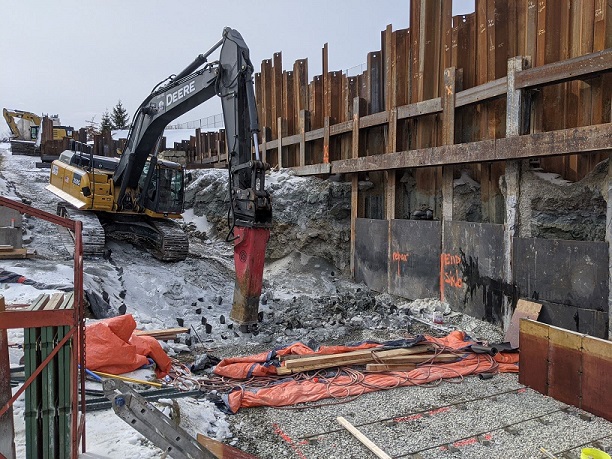
S.E. Macmillan had a crew of eighteen on site this week. On Monday, along with drilling for ledge removal, SEM finished building the north ramp crane pad. They completed the stairs and landing from the crane pad to the north Tank foundation slab. They began decking over the sump channel in slab section 12 with plywood as protection against falls and also as a shelf for the inside form face of the exterior west side Tank wall.
There was no work on site Tuesday - snow, sleet and freezing rain paused the work.
On Wednesday SEM plowed back the fresh sugar-like snow and continued drilling perforation into bedrock. They moved the glycol ground heating unit from the north ramp crane pad onto the excavated area for slab section 8. Thursday, they received delivery of a rental John Deere 350 excavator with a 7,500-pound Chicago Pneumatic hammer attachment. Where the bedrock has been perforated the hammer is breaking it. It is a time-consuming process. SEM is acquiring a blasting permit from the City of Bangor and will at some point in the future drill and blast to remove the bedrock. By Thursday enough progress had been made drilling and hammering ledge that SEM could begin moving reinforcement steel and formwork into place on the subbase stone of slab section 13.1. They stood the forms and covered the subbase with glycol ground heating hose and insulating blankets.
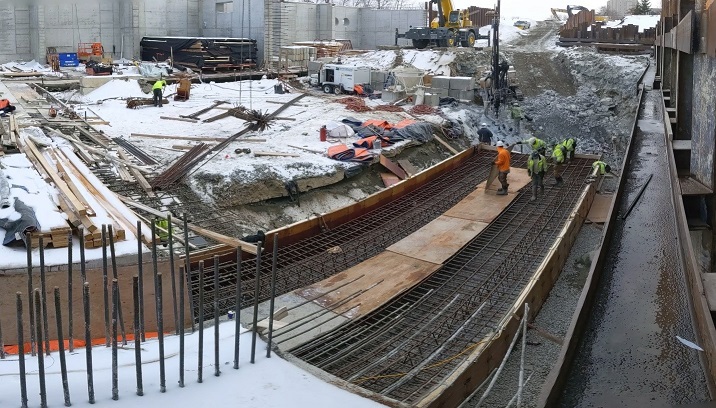
Friday, along with drilling and hammering bedrock, Macmillan finished forming slab section 13.1. They tied reinforcement steel for the bottom and top mats and built the end construction-joint bulkhead which holds the top mat steel and water stop. SEM worked Saturday tying channel wall L-bars, hanging the water stop for the channel walls and at the end of the shift covered the formwork and reinforcement steel with glycol heater hose and insulating blankets.
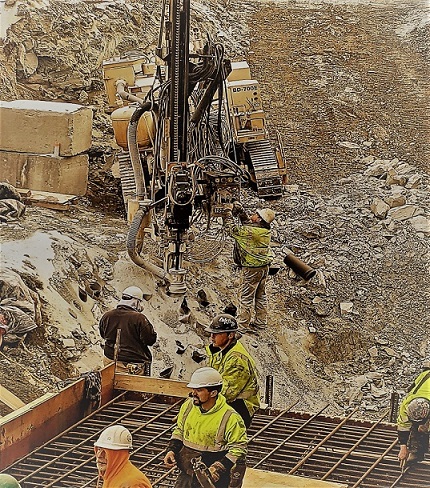
In the background, Dave Eastman drills bedrock. Left to right; Rich Grumbach, Earl Grover (back to), Josh Burke, Cody Hotham and Jim King (head down) tied reinforcement steel.
Work completed 2-8-21 to 2-12-21
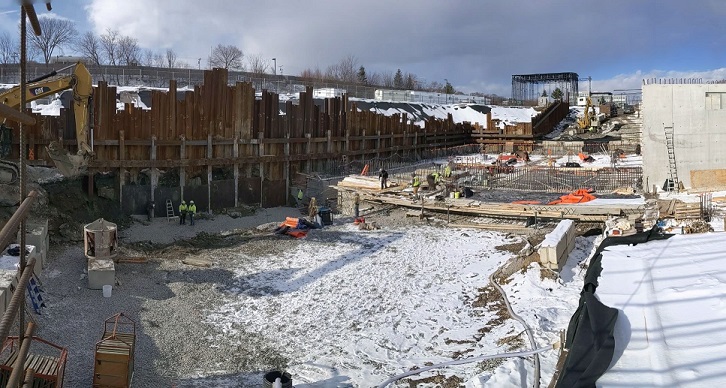
On Monday, February 8th S.E. Macmillan (SEM) stacked concrete dead men blocks along the construction joint between slab sections 13-14 and 8-9. They finished excavating for slab section 13.1 and placed fabric and crushed stone subbase to grade (elevation -18.00). High bedrock is evident near the shared edges of 13.1 and slab section 14. SEM began hammering the high ledge with a large hydraulic hammer mounted to a Cat excavator. Tuesday the 9th they began welding steel plates between soldier piles to cover the sheet bays where either high bedrock or boulders have stopped sheet pile from being driven to design depth. Macmillan plans to place concrete behind the sheet steel to seal off these sheet voids against soil migration. The form crew worked on stripping construction formwork from the construction joint bulkhead which ran from slab section 7 to section 12. They also began building a crane pad filling the full width of the north shoring ramp. A second crane will be set up there later this winter or early spring for use building Tank Cell #1 full height walls, columns and roof slab. Carpenters started building a set of stairs and a landing to carry foot traffic from the Tank slab to the crane pad. Thursday and Friday Macmillan began the process of obtaining a blasting permit from the City of Bangor. SEM had Northern Drilling and Blasting’s drill brought to the site and they began line drilling along the shoring wall and across the construction joint for slab sections 13-14.

Above, in the middle left, Macmillan has heated slab section 13.1 with the glycol ground heater and covered it with insulating blankets.

Northern Drilling and Blasting started line drilling on
Friday.
Work completed 2-1-21 to 2-5-21
.jpg)
On Monday February 1st Macmillan placed slab
section 7. Mainely Concrete Pumping, S.W. Cole, Hughes Brothers and O.J. Folsom
all participated. Mainely pumped, S.W. Cole tested and both Hughes Brothers and
O.J. Folsom supplied the concrete. 220 cubic yards were delivered, 60 by O.J. Folsom
and 160 by Hughes Brothers. Pumping started at 8:45 and finished at 4:15. There
are six more slab sections to complete.
The snow on Tuesday shut the job down but did not damage the
heated enclosure for slab section 7.
.jpg)
On Wednesday Macmillan took down the enclosure and began stripping the construction joint formwork along the abutting faces of section 7 and 8. They kept the fresh slab covered with ground heater hose loops and insulating blankets.
.jpg)
Thursday and Friday, Macmillan continued to strip formwork from section 7 and began to remove steel form panels from the sump channel in section 12. They began excavating to subgrade and grading subbase crushed stone for slab section 8. The last two days of the week were also devoted to general house cleaning.
Work completed 1-25-21 to 1-30-21
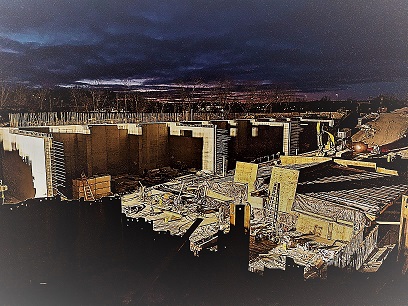
On Tuesday the 26th , an hour before concrete will arrive, the Tank excavation is illuminated by a diesel powered light tower.
Macmillan began the week completing formwork and tying reinforcement steel for slab section 12.5b, the sixth and final placement for section 12 and the eighth of fifteen, three-foot-thick Tank slab sections. They have managed steady progress so far this winter partially because of the relatively mild temperatures but also because of their use of a Greenthaw Hydronic Glycol ground heater. The trailer mounted boiler has a hose reel carrying 5000 feet of flow reversing hose for consistent heating temperatures across ground or curing concrete. This heating system can run from Friday to Monday without refueling, the heater hose is easy to lay-out and maintain and constant and consistent temperatures for ground and concrete are confidently achieved.
Mainely Concrete Pumping, S.W. Cole and O.J. Folsom were onsite Tuesday. Mainely pumped, Cole tested and Folsom supplied concrete for slab section 12.5b. The placement started at 8:00 am and finished at 1:00 pm. Folsom delivered 230 cubic yards of concrete. Macmillan finished the slab and covered it with heater hose and insulating blankets.
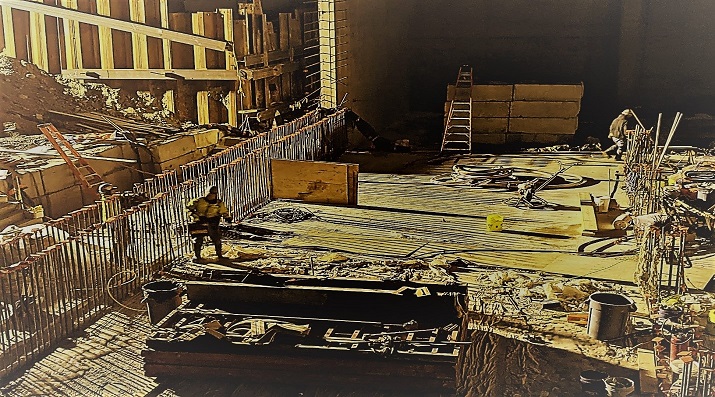

Mainely Concrete Pumping set up on site at 7:00 am, Tuesday, Jan. 26th.
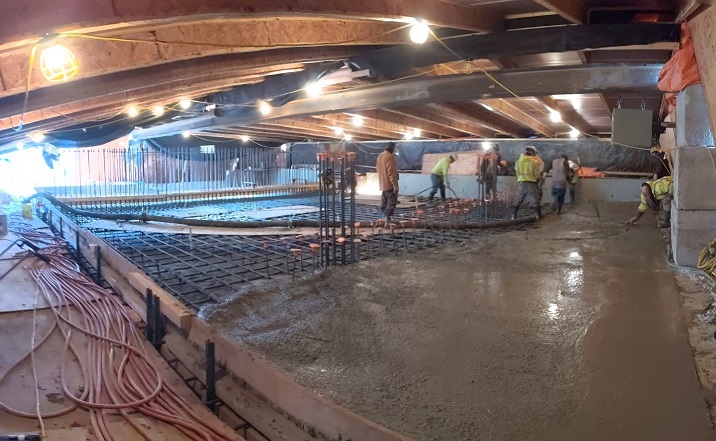
The ground heater hose is set aside on a walkway while Macmillan places concrete for section 12.5b.
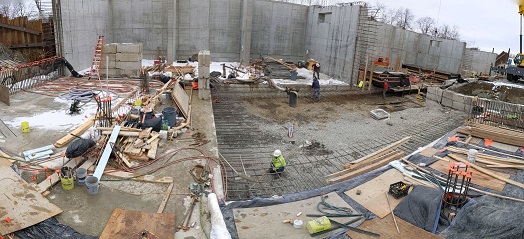
On Wednesday Macmillan took down the enclosure, stripped the construction joint formwork between section 12 and section 7 and began prepping to place section 7. They graded sub-base stone and rigged reinforcement steel to be ready for swinging into place with the crane. For the overnight they covered the sub-base stone with heater hose and insulating blankets.
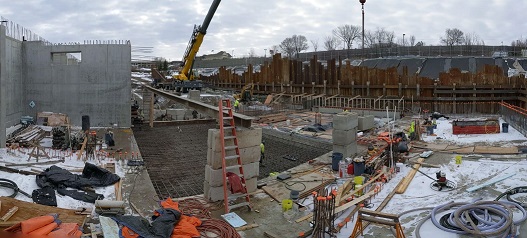
Thursday Macmillan began erecting an enclosure for slab section 7 by setting two 73-foot-long carrying beams which will support their insulated roof truss panels. They tied bottom mat reinforcement steel, built the construction joint bulkhead against the section 8 face and began tying steel for the top mat.
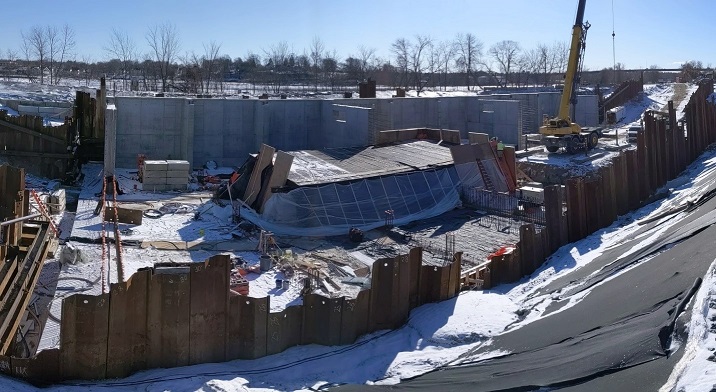
Friday and Saturday Macmillan finished tying top mat,
column, full height and knee wall reinforcement steel. They completed the
enclosure, installed two propane heaters, looped ground heater hose over the
top reinforcement mat and covered the hoses with insulating blankets.
Work completed 1-18-21 to 1-23-21
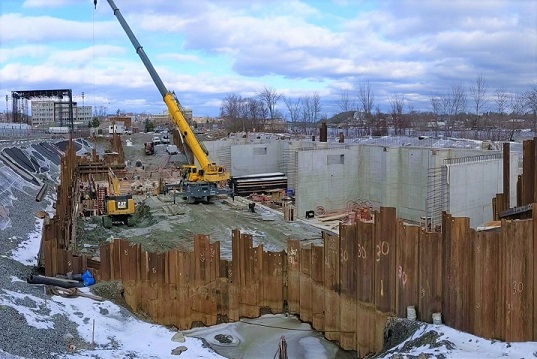
S.E. Macmillan worked six days this week. On Monday, Martin Luther King, Jr. Day, the concrete crew tied top and bottom mat, L-bar full-height wall and channel wall reinforcement steel for slab section 12.5a. Slab section 12 has been broken down into six different placements - 1 through 4 and 5a and 5b. The excavation crew hauled VRAP fill to the Essex Street Access Road site. The fill is being spread, compacted and graded for a parking lot and two-foot trails which lead to the existing Essex Woods trail system.
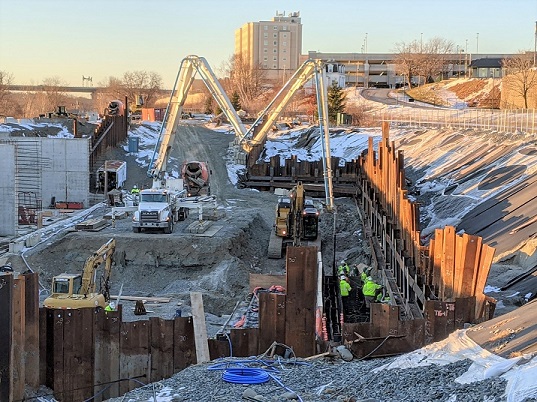
Hughes Brothers, S.W. Cole and Mainely Concrete Pumping were on site Tuesday morning at 7:00 for the section 12.5a slab placement. Hughes delivered 75 cubic yards, S.W. Cole tested slump and air and Mainely pumped it into the formwork. Macmillan finished and covered the footing section with plywood, ground heater hoses and insulating blankets.
In the afternoon Macmillan began prepping for section 12.5a. They cleaned the previously excavated area of stockpile lumber, steel, form debris and began to grade the crushed stone subbase. They formed a small subbase section where structural concrete fill will be added because of excess excavation necessary for the previous deeper placements of slab section 12.
The excavation crew hauled VRAP fill to Essex Street.
Brandi Piers, an Engineer with the Maine DEP visited the Tank and Essex Street sites in the afternoon.
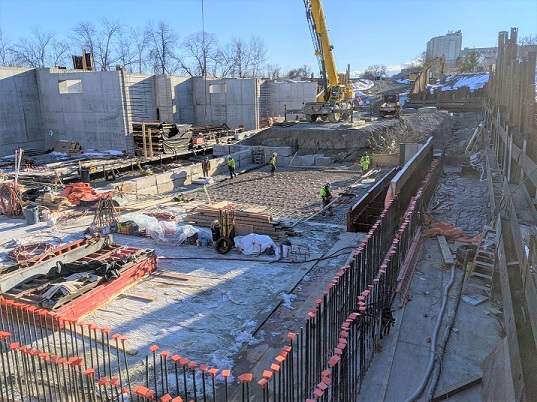
On Wednesday Macmillan finished grading the crushed stone subbase. Hughes Brothers brought 10 cubic yards of 5000psi structural fill concrete and it was placed in the south west corner of the slab section. They put down the concrete brick/chairs on which the bottom mat reinforcement rests and began to tie the reinforcement steel for section 12.5b. They set concrete block dead men a few feet outside of the construction joints along slab sections 7, 8 and 13. These blocks are used as part of the structure for heated cover. Macmillan’s excavation crew continued to haul VRAP material to the Essex Street site.
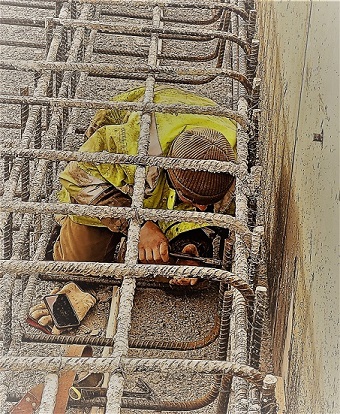
Cody Hotham tied bottom mat reinforcement steel for slab section 12.5b.
Thursday, Macmillan built construction joint formwork against slab section faces 7 and 13 and tied bottom and top mat reinforcement steel. They finished setting concrete dead men along the south edge of the 12.5b excavation. Two concrete block pedestals were built to be used as bases for the roof panel carrying beam. At the end of the day Macmillan looped ground heating hoses around the inside of the forms and covered them with two layers of insulating blankets.
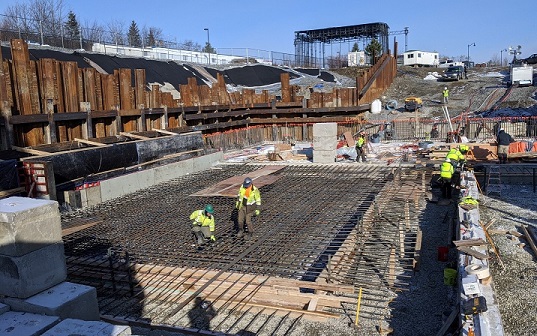
On Friday Macmillan’s concrete crew finished building the construction joint formwork faces against slab sections 7 and 13. They set the ridge beam on the block pedestals and stood insulated wall panels on the east and west sides. The top reinforcement mat was completed. They looped ground heater hoses and covered the formed area with insulating blankets.
Macmillan’s excavation crew hauled 1,920 cubic yards of VRAP material to the Essex Street site this week. They have hauled an approximate total of 10,000 cubic yards to Essex Street since the end of October.
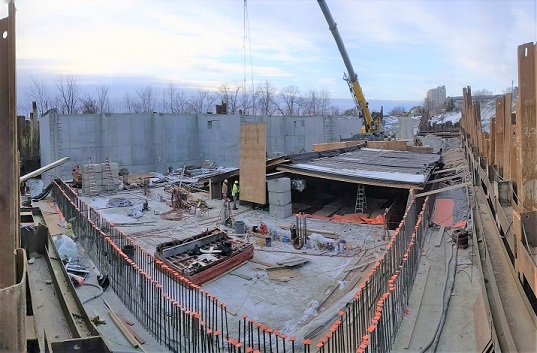
Saturday, Macmillan set the gable-end insulated wall panels, filled gaps with fiberglass insulation bats and covered seams with insulating blankets. Inside the enclosure they hung and fired a 200,000 BTU propane heater. The formwork was covered again with ground heater hoses and insulating blankets. Macmillan plans on placing this slab section, 12.5b on Tuesday, 1-26-21.
Work completed
1-11-21 to 1-15-21
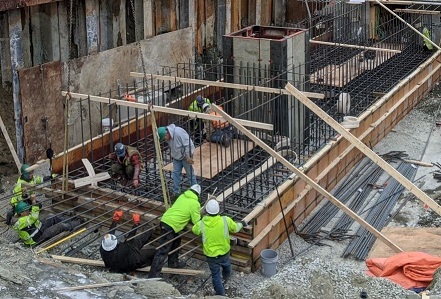
On Monday S.E. Macmillan continued work on slab section 12.3. In the photo above, they are tying top mat and wall reinforcement steel, installing welded water stop and building the lower form section of the construction joint bulkhead against abutting slab section 13.
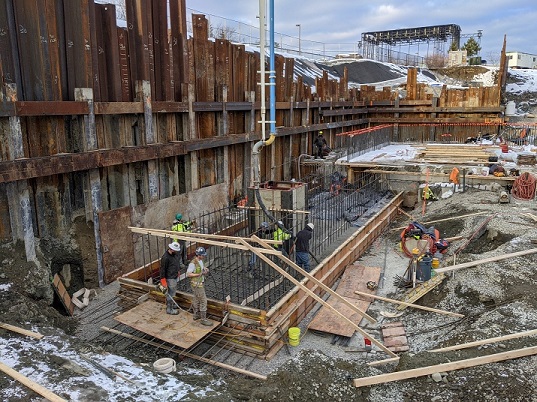
Macmillan placed concrete for slab section 12.3 on Tuesday. In the morning they finished installing the water stop, securing the form ties and bracing the construction joint bulkhead. Mainely Concrete Pumping, S.W Cole Engineering and Hughes Brothers all arrived on site at noon to pump, test and deliver 90 cubic yards of 5000 psi concrete. The placement was complete at 3:15 and Macmillan covered the slab with a layer of insulating blankets, a layer of doubled-up heating hoses and another layer over everything of insulating blankets.
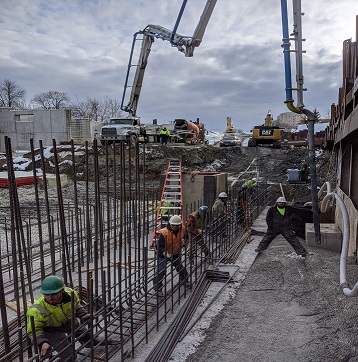
The following morning Macmillan stripped the panels on the east and west sides of slab section 12.3. They backfilled the east side of the slab with stone. On the west side, Mainely returned and pumped forty more cubic yards of Hughes Brothers’ concrete as structural fill between the foundation and the shoring. The fresh concrete in the above photo is at elevation -14.00. The soldier piles in this area were set into drilled and concreted bedrock sockets to elevation -30.00. Together the Tank footing slab and the structural concrete fill make a final bracing against the excavated side of the shoring. In the afternoon Macmillan tied sump channel wall reinforcement steel for slab section 12.4. They double blanket covered and double looped heater hose over the fresh structural concrete fill.

On Thursday, Macmillan tied slab section 12.4 wall reinforcement steel for the sump channel and bottom mat reinforcement steel for slab section 12.5. They stood sump channel wall forms and against slab section 12.5 they built the construction joint bulkhead using 4’x4’x2’ concrete blocks. They completed installing welded water stop and hanging it into place.
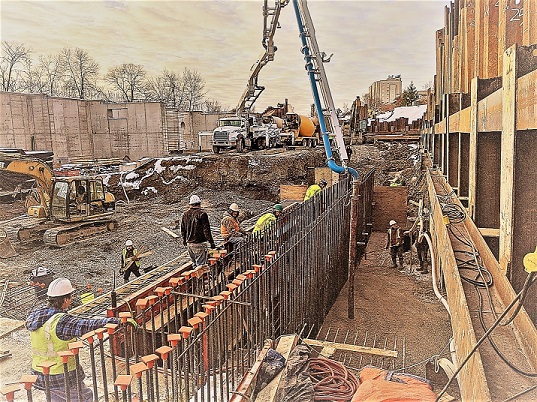
On Friday, Mainely, S.W. Cole Engineering and O.J. Folsom arrived on site at 7:00 am. Together they pumped, tested and delivered 104 cubic yards of 5000 psi concrete for slab section 12.4. The placement was finished at 10:15 am. Macmillan began clearing the subbase area of slab section 12.5a of steel, lumber and miscellaneous debris. They started to grade the subbase stone for section 12.5a. They bull-float finished the fresh concrete and covered it with double insulating blankets and double looped heater hose.
Work completed 1-4-21 to 1-9-21
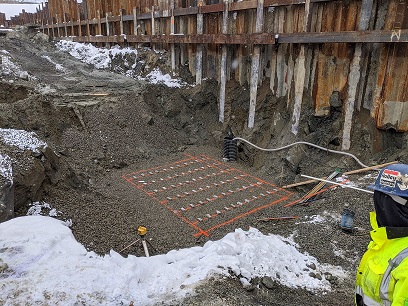
Subbase stone for slab section #12.1 is at elevation -22.60.
S.E. Macmillan completed excavation for slab section #12. There are five separate placements necessary for this section, 12.1 to 12.5. On Monday they finished grading the subbase stone. They had tied the reinforcement steel for 12.1 outside of the excavation, loaded it onto a trailer and then swung the mat cage into place.
On Tuesday, Nate Strout from S.W. Cole came to the site to verify the elevation of the undisturbed river bottom. The Tank design requires that the Tank be built on solid, undisturbed material. In the mid-nineteenth century railroad activity filled in Dutton Cove and the Tank is in the middle of this filled area. In March of last year intact railroad ties with rail still attached were excavated at elevation 5.00. The river bottom at the time of the railroad construction was approximately elevation -6.00, or eleven feet below what appears to be the original single track which ran over the man-made land in Dutton Cove. “A Bird’s Eye View of the City of Bangor Maine, 1875” (Library of Congress website image) shows two rail lines and ships moored along the edge of an already partially filled Dutton Cove.
Wednesday morning Macmillan completed tying steel and building formwork for slab section #12.1. In the afternoon Mainely Concrete Pumping, S.W. Cole’s testing technician and Hughes Brothers concrete came to the site. Macmillan placed 35 cubic yards of Hughes Brothers concrete for #12.1, covered the fresh concrete with insulating blankets and looped the heat piping over and around the slab. On Thursday morning they stripped the forms, backfilled with stone to grade and against the concrete slab and tied reinforcement steel for slab section #12.2. This section of slab only needed the sump box, shoring wall and excavation bank walls as form. In the afternoon, Mainely, S.W. Cole and Hughes came back again and Macmillan placed 90 cubic yards of concrete for section #12.2.
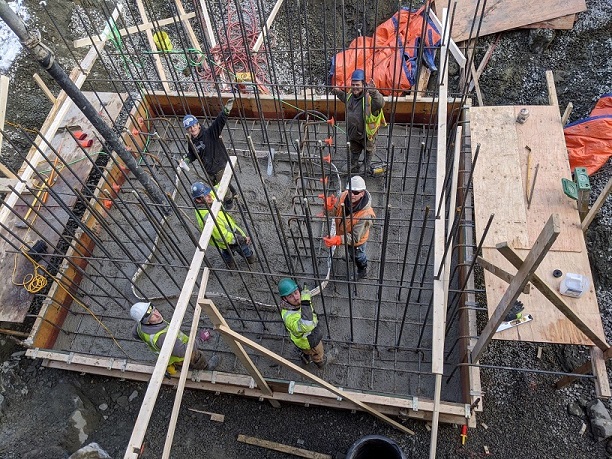
Above: slab section #12.1, below is slab section #12.2. The square in the middle is the sump form.
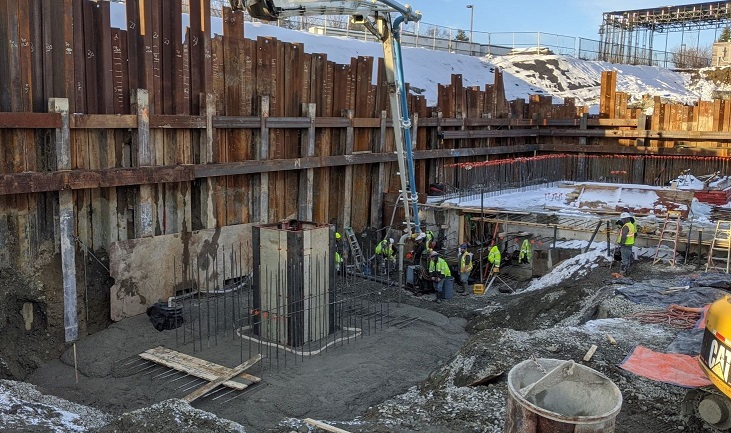
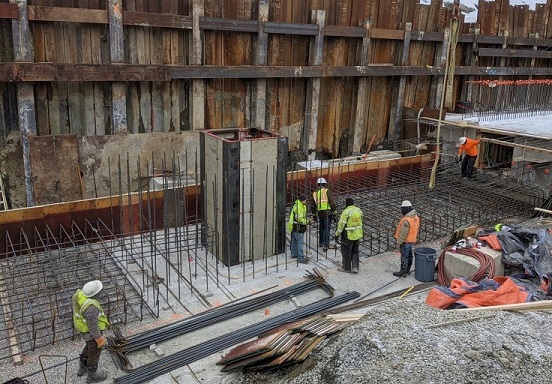
Friday and Saturday Macmillan began tying reinforcement steel and building the formwork for slab section #12.3.
Work completed
12-28-20 to 1-1-21
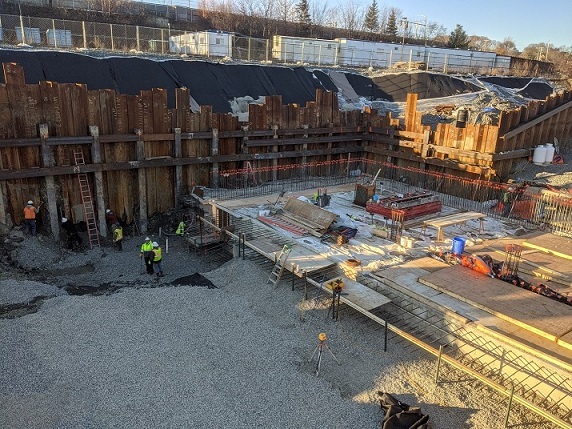
Macmillan’s crew worked in the deepest Tank section this week. The men in photo above are standing forty-one feet below finish grade.
S.E. Macmillan’s 20-man crew excavated for the next two slab sections, #12 and #7. Section #12 is one of three sump sections where the 30 horsepower, six-inch grinder pumps will be located for dewatering each of the three separate Tank cells. The sump slab sections are the deepest points in the entire excavation and they are located along the west side shoring wall.
Macmillan has hauled approximately 8,000 cubic yards of material from the onsite Roundhouse stockpile to the Essex Street location of the access road and parking lot for the Essex Woods trail system. At the access and parking lot site they have a foreman, two operators and three trucks working on hauling and grading excess Tank excavation to be used as subgrade for the gravel road and parking lot.
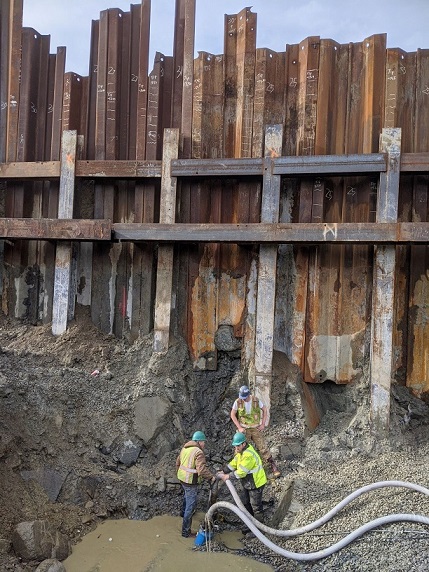
Macmillan’s crew pumped groundwater while excavating for slab section #12. At different locations inside the shoring they have five three-inch electric pumps running around the clock.
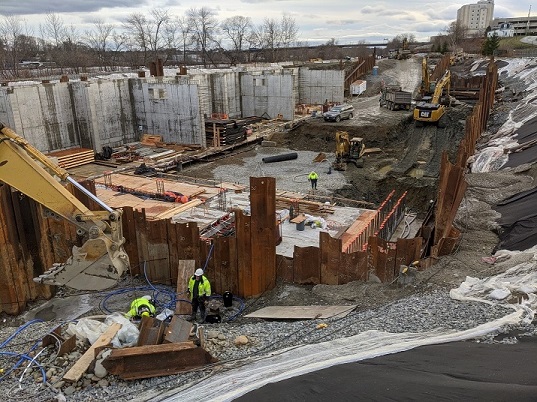
Looking south into the Tank excavation; the west side shoring wall is on the right, the east side full height concrete exterior Tank wall is on the left with three full height Tank walls started and temporarily terminated at construction joints. Concrete for all remaining full height walls (two cell dividers, both end walls) and the tank roof - will be placed in the summer of 2021. Each of the three separate combined sewer overflow (CSO) holding cells can be individually flushed and dewatered after a CSO event.
Work completed 12/14/20 to 12/25/20

S.E. Macmillan took down the insulated enclosure used during the previous placement and initial cure for slab section #11. They kept the mobile heater unit heat-piping in close loops on the fresh slab and covered with insulated curing blankets. They stripped the construction joint bulkheads bordering slab sections #6 and #12.
Macmillan hauled screened VRAP excavation from the Roundhouse stockpile to the Essex Woods access road and parking lot site just north of I-95 on Essex Street. They currently are filling and grading side slopes along the access road between Essex Street and the parking lot location. Some of this road and parking lot will have five or six feet of fill placed over the existing subgrade.
They tied reinforcement steel and erected formwork for slab section #6. They graded subbase crushed stone, tied the bottom mat and set the first formwork course. Top mat chair supports were installed and they connected the second formwork tier. Concrete blocks and steel beam frame work for the insulated roof panels were installed along with insulated wall panels.
Early in the week of Christmas Macmillan completed tying mat and wall reinforcement steel, constructed the vertical keyway starter-wall forms and waterstop support brackets. The insulated enclosure was completed, hanging propane heaters installed and heat piping looped and covered over the top mat. Air temps inside the enclosure, outside the formwork and four feet above subbase elevation were in the 70f range for twelve hours before the placement.

On Wednesday, 12-16-20 one of Macmillan’s crews tied reinforcement steel for slab section #6. Cold and windy, with a high of 16 degrees, it was the first day this winter with ice on the Penobscot.
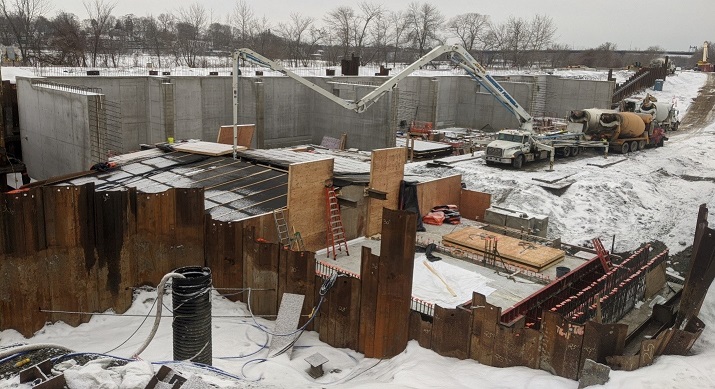
On Tuesday, 12-22-20, Macmillan placed concrete for slab section #6. Seven of fifteen slab sections are now complete.

The insulated enclosure meant vertical concrete pump access was limited, so Macmillan’s crew had to wrestle horizontal hose extensions to place the concrete for slab section #6.
Work completed 12/7/20 to 12/11/20
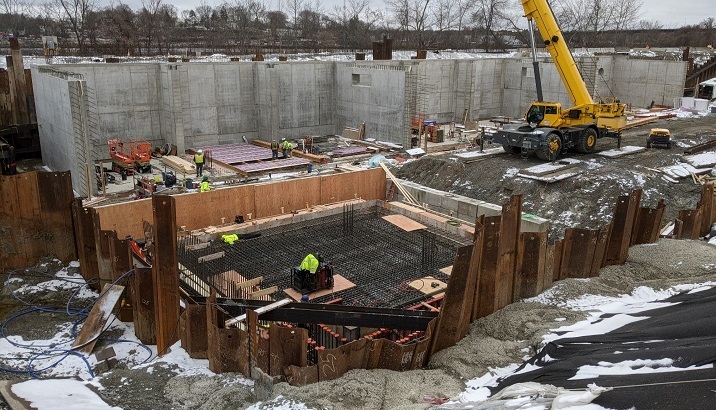
S.E. Macmillan had twenty men on site this week. Macmillan intends to proceed through the winter with concrete work. When warmer weather arrives the crew size is likely to be increased in order for overhead concrete slab work to follow along with completion of slab and wall construction.
This week Macmillan continued working on slab section #11.3b. They built and assembled forms for the east and south construction joint bulkheads. They tied reinforcement steel for both top and bottom reinforcement steel mats as well as for the full height, three-foot-thick, A-column line exterior wall. Inside the two curtains of the A-column line wall steel they installed waterstop brackets for tying up the waterstop and forms for the starter wall vertical keyway.
On Wednesday Macmillan began building a temporary enclosure for heating and covering the reinforcement steel and formwork. They used wall panel sections they had previously built but also used 32’ long floor trusses for framing insulated roof panels. They finished setting the wall and roof panels into place on Thursday. They had two, 250-gallon propane tanks set into place near the enclosure and hung two propane heaters inside the enclosure against the north wall. Macmillan rented a portable hot water heating system, set it up near the enclosure and looped six hot water heat lines over the top mat of reinforcement steel and covered the glycol-filled heater lines with insulating blankets. Friday morning the temperature inside the enclosure was over 70f.
On Saturday Hughes Brothers delivered 200 cubic yards of concrete. Mainely Concrete Pumping attached hoses to their pump boom and Macmillan moved the hoses as necessary into place.
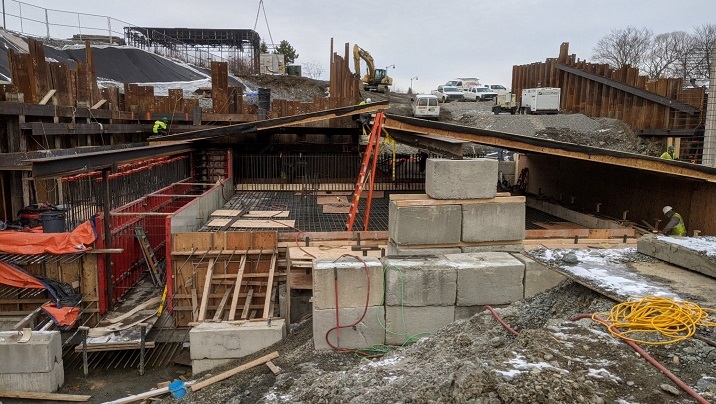
The sump channel for Tank cell #1 is in the lower left-hand corner of the above photo.
Work completed 11/30/20 to 12/4/20
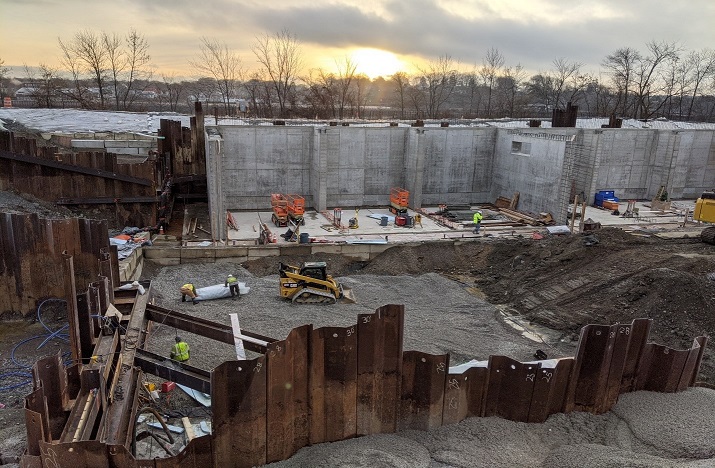
S.E. Macmillan had twenty men on site this week. On Monday they finished grading subbase crushed stone for slab section #11.3b, started tying the bottom mat of reinforcement steel, set concrete dead-men blocks for a temporary retaining wall against the excavation on the east and south #11.3b slab section and built a tented enclosure as work shelter for expected rain.
3” of rain fell from 7:00 pm Monday night to late Tuesday afternoon, the crew got wet but was able to work all day Tuesday. On Tuesday they installed brackets for hanging waterstop, starter wall (keyway) forms, bottom mat reinforcement steel, top mat chairs, top mat steel, slab forms along column line A and the perpendicular construction joint bulkhead.
On Wednesday, N.S. Giles’ pump truck arrived on site at 8:45 along with S.W. Cole’s concrete testing technician. Hughes Brothers delivered 70 cubic yards of concrete from 9:45 to noon. Macmillan finished and covered slab section #11.3a and installed inside the enclosure an electric heater. They welded form ties, set more concrete deadmen, graded stone for slab section #11.3b and laid out the north footing line for slab sections #11.3a and #6.
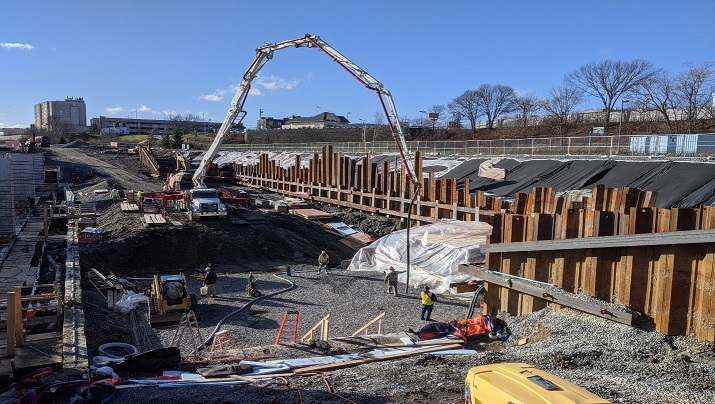
Thursday, Macmillan began tying reinforcement steel for the bottom mat of #11.3b, building and setting formwork and moving top mat steel from the stockpile to a flatbed and craning it into the excavation.
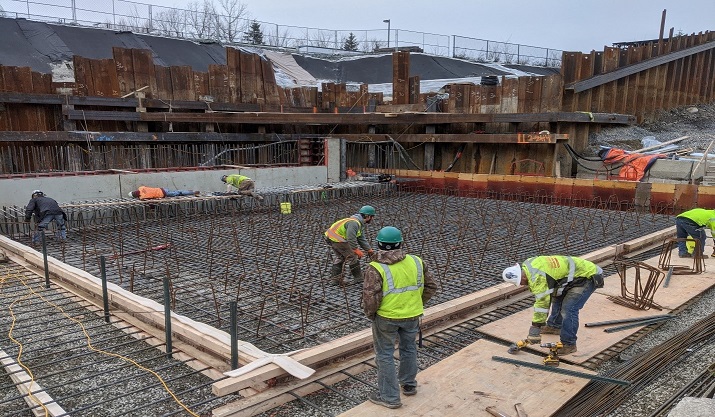
On Friday Macmillan finished tying the bottom mat steel, installing and welding the horizontal construction joint waterstop, tying into lace the top mat chair supports and they began to install the bottom course of form ties.
Work completed 11/23/20 to 11/27/20
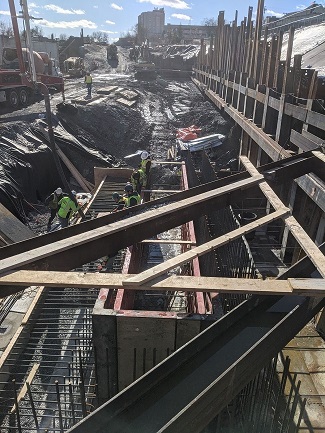
In the short Thanksgiving Holiday week S.E. Macmillan had twenty men on site. Monday, they did not work, they canceled and rescheduled the concrete placement for slab section #11.3 for Tuesday. Over an inch and a half of rain fell on site Monday. Tuesday, N.S. Giles’ pump truck, along with an S.W. Cole concrete testing technician arrived on site at noon. Hughes Brothers delivered 110 cubic yards to the site between 12:30 and 2:00 pm. Macmillan covered the placement with insulation blankets, six-inch-thick insulated roof panels and stretched reinforced poly over everything. An electric heater was placed under the cover.
Stanley and Marie Macmillan sent each crew member home on Wednesday with a choice of fresh turkey or ham, a ten-pound bag of Maine potatoes, fresh deli-cubed squash, Bell’s stuffing, cranberry sauce and a choice of fresh baked pie from Hampden’s R+K Variety – pumpkin, apple or chocolate cream.
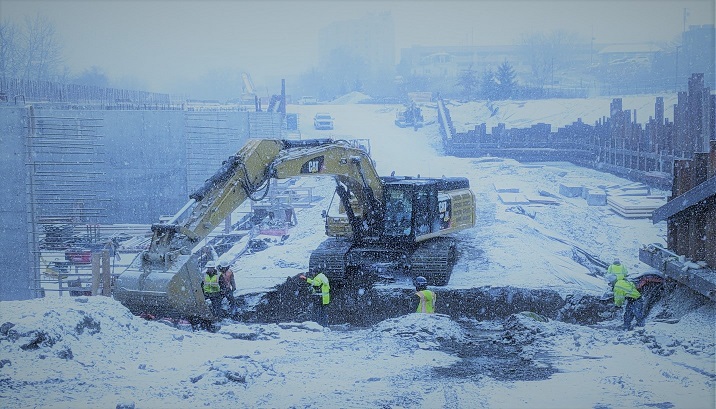
In the morning snow on Wednesday, Macmillan buried some dewatering pump discharge lines.
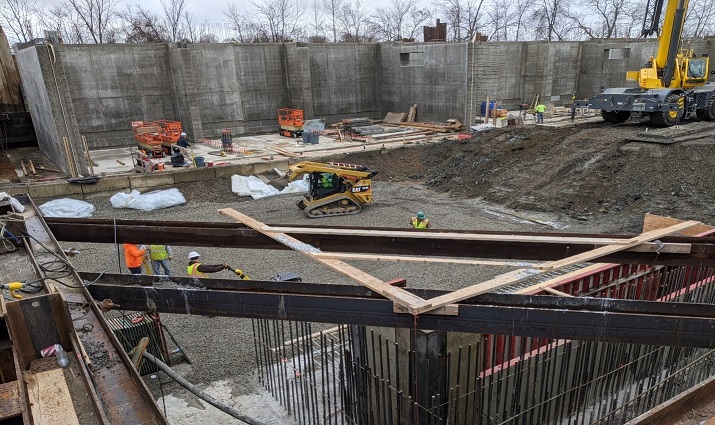
Friday, the 27th they excavated to sub-grade and put down subbase crushed stone for slab sections #6 and #11.
Work completed 11/16/20 to 11/20/20
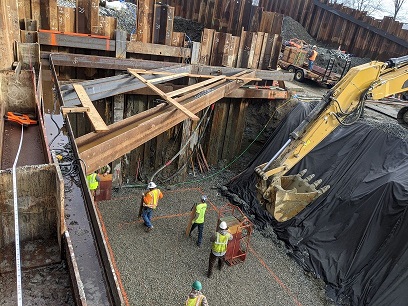
In the northwest Tank corner Macmillan formed slab section #11.1.
S.E. Macmillan had twenty men on site this week. Two surveyors from Plisga and Day Land Surveyors were on site to check Macmillan’s Tank layout and to monitor the west shoring wall soldier piles for vertical displacement.
On Monday and Tuesday Macmillan finished placing and grading subbase crushed stone, built formwork for slab section #11.1, tied reinforcement steel for the northwest corner Tank sump channel walls and steel for the full height exterior Tank Walls. The entire Tank will drain from east to west. A channel, four-to-five-feet deep along the west wall will direct flow to three sumps with dewatering pumps.
Wednesday, the 18th, Mainely Concrete Pumping arrived at 12:30 pm along with two S.W. Cole concrete testing technicians. Between 1:30 and 4:00 pm Hughes Brothers delivered 81 cubic yards for slab section #11.1. Macmillan used insulating blankets to cover the three-foot-thick slab. On Thursday morning the temperature beneath the blankets was 95F. Macmillan placed concrete on Thursday between slab section #11.1 and the north and west corner shoring walls. Work on the sump channel formwork and reinforcement steel was begun on Friday. Slab section #11.2 will be placed early next week.
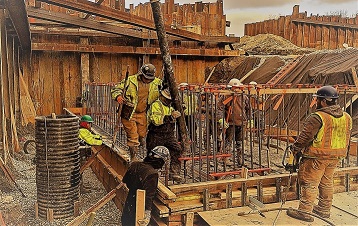
S.E. Macmillan placed slab section #11.1 in the northwest Tank corner on Nov.18th.
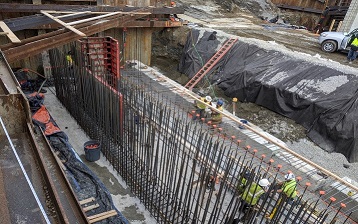
Formwork and reinforcement steel for slab section #11.2 was erected on Friday Nov. 20th.
Work completed 11/9/20 to 11/13/20
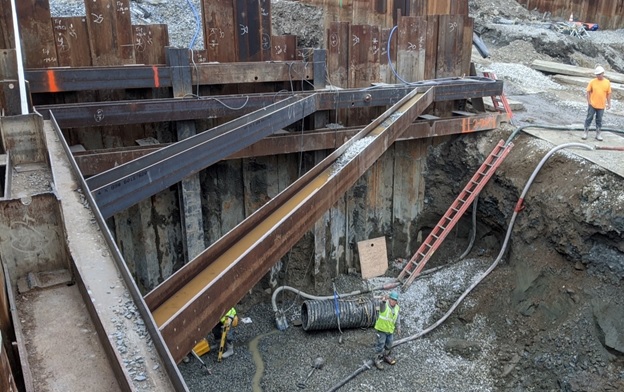
Rick Merrithew stands
on elevation -18.00 in the northwest corner of the Tank, forty-one feet below
finish grade.
S.E. Macmillan had twenty men on site this week. H.B. Fleming sent two men to the site along with a vibro hammer and a power pack for hammering sheet pile to depth. During the original sheet installation some sheets were driven into obstructions which left those sheets above the designed shoring depth. Macmillan excavated to the obstructed depth of several sheet piles, removed the rock hinderances and Fleming drove those sheets to the desired depth. Fleming and Macmillan focused on the northeast Tank shoring corner. Macmillan plans to place the next slab section there. Fleming was on site for one day and will return later in December when they continue with the process of obstruction removal and driving high sheets to design depth ahead of Macmillan’s excavation and concrete work.
Macmillan excavated the northwest corner Tank area for slab section #11. This is the deepest area of the tank excavation. The three pump sumps for dewatering the Tank will be at elevation -19.60, forty-three feet below finish grade. Elevation -19.00 is equal to the depth of the Penobscot River bottom along the Bangor Waterfront.
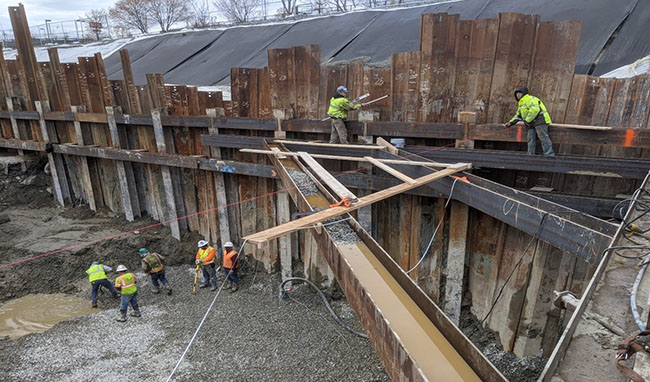
Nick Hotham and Jim
King laid out a template on the northwest Tank shoring corner bracing for
plumbing to the northwest concrete wall face.
Slab section #11 (of 15 total slab sections), is three-feet thick and measures 15.5’x 47.37’. It is a concrete slab built beneath the three holding-cell slab sections of the Tank. This slab supports the dewatering sump channel and runs the length of the west side of the Tank. Each individual cell will hold about 1.26 million gallons and will drain into the sump channel, which will slope to three separate dewatering pump sumps. Macmillan will place this sump channel slab next week.
Currently, one three-inch, three-phase electric pump is handling the ground water in this deep northwest Tank corner. Managing ground water was a major design and construction consideration for this project. Macmillan prepared by purchasing more than thirty, three phase, three-inch and six-inch electric pumps. They installed a three-phase transformer, meter socket and ran power underground for two separate multi circuit breaker panels. Currently there are four three-inch pumps handling the ground water across the eastside and northwest corner of the Tank excavation. All of the discharge piping has been winterized.
Work completed 11/2/20 to 11/6/20
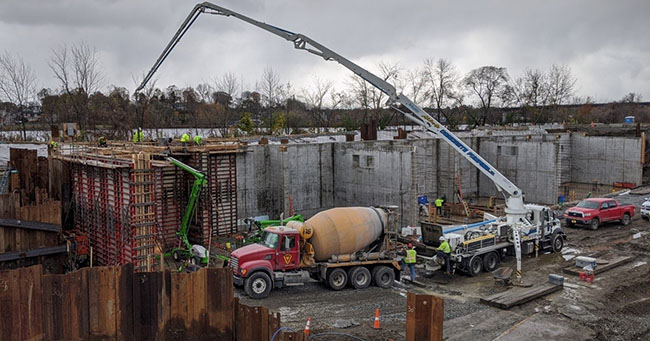
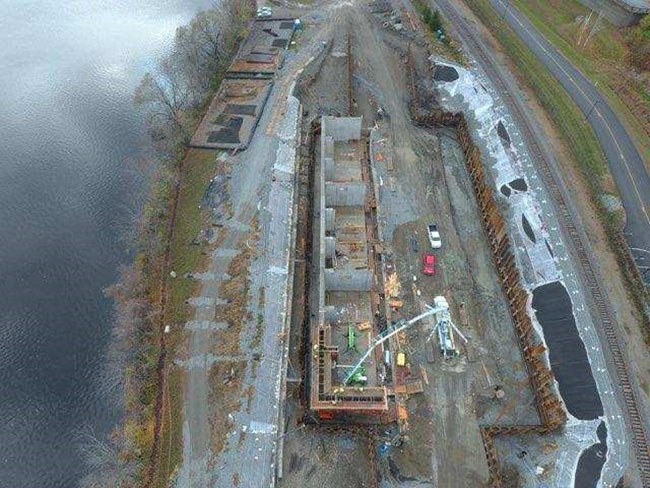
Ground and aerial(drone)
views of S E Macmillan’s concrete placement, 11-2-20.
S.E Macmillan had twenty men on site this week. On Monday, Nov. 2nd they placed concrete for the #5 wall section. Mainely Concrete Pumping’s pump truck and two S.W. Cole Engineering concrete testing technicians set up at 6:30 am. O.J. Folsom delivered 215 cubic yards of concrete between 7:30 am and 1:30 pm. The aerial photo above shows the pump truck set up on wall placement #5 and the formwork’s connection to the rest of the existing east side Tank walls. With the placement of the wall section #5, one third of the Tank wall and slab is complete. Macmillan needed four months to complete that section of the Tank and it took 2,246 cubic yards of concrete and 504,000 pounds of reinforcement steel.
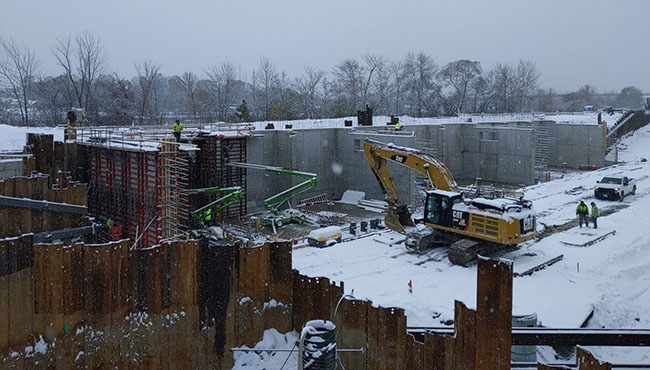
Tuesday, Nov.3rd, snow melted on the formwork of the still very warm concrete placed the day before.
On Tuesday Macmillan began preparations to shift from vertical concrete work back to horizontal concrete work. They began stripping hardware, bracing and scaffold from wall placement #5 and moving material involved with wall placements into short term storage for use later this winter. They kept insulating blankets on the new concrete wall top and on the vertical construction joint and monitored the temperature beneath that insulation. 24 hours after the placement it was between 95 and 105 degrees beneath the insulating blankets. By the end of the week day-time and night-time temperatures had moderated enough to allow for stripping the construction joint bulkhead and some of the form panels.

On Friday, Macmillan had a crew of six working on the access road to the Essex Woods’ trail head and parking lot.
Work completed 10/26/20 to 10/30/20


S.E. Macmillan had twenty men on site this week. Last Friday they set the outside face forms in place for the column line A/1 corner. Monday and Tuesday they tied reinforcement steel for both inside and outside mat curtains. On Wednesday they closed the wall section #5 form and began installing the form ties. Thursday and Friday they installed ties and built the bulkhead for the construction joint on column line A. This wall section completes the full height walls on the east side of the tank. In just under four months they have tied into place 504,000 pounds of reinforcement steel. Wall section #5 will be placed Monday 11-2-20.
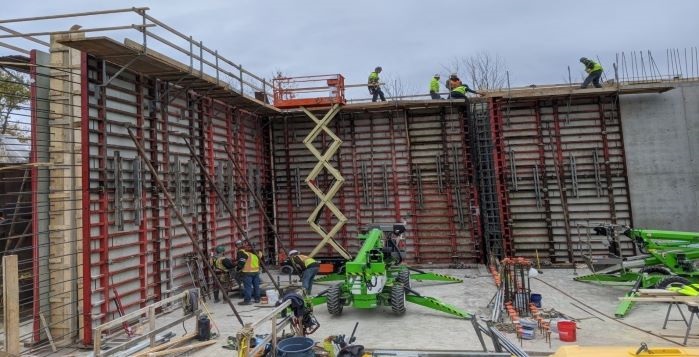
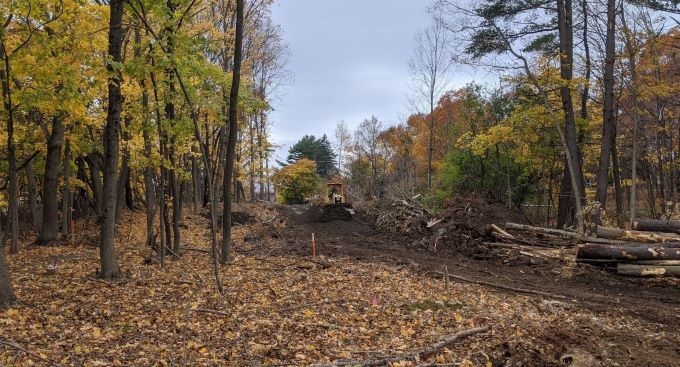
S.E. Macmillan began access road construction off Essex Street for a new parking lot.
The City of Bangor has worked for several months with S.W. Cole and the Maine Department of Environmental Protection in order to achieve a Beneficial Use of Soils Permit. The permit allows the City to use excess excavation from the Davis Brook CSO Tank construction as base fill for a thirty- space gravel parking lot, a five-hundred-foot access road and two eight-foot-wide trails totaling 1300 linear feet. The new trails will connect to the existing Essex Woods trail system. Weather permitting, construction of the access road, parking lot and connecting trails will be completed in the spring of 2021.
Work completed 10/19/20 to 10/23/20
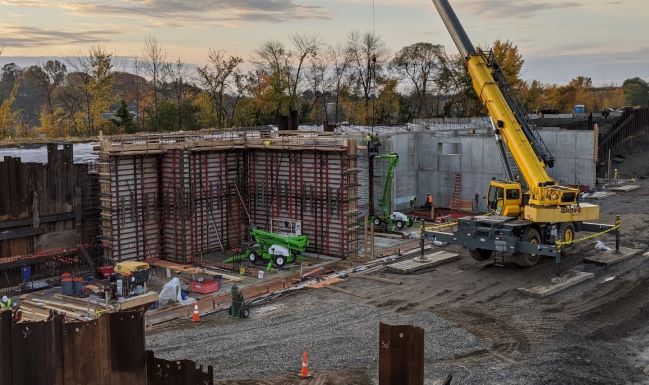

S.E. Macmillan had a crew of twenty this week. They finished forming wall section #4 on Monday and completed tying the L-bar reinforcement steel which connects the full height walls to the top slab. They marked finish concrete grade on the forms and did a final check on alignment and plumb. On Tuesday they stripped all the remaining formwork and bond-outs which had been left in place on previous placements. They organized form material, reinforcement steel, waste lumber and started cleaning and assembling gang forms for wall placement #5.
On Wednesday SEM placed wall section #4. Mainely Concrete Pumping arrived at 6:00 am, two S.W. Cole concrete testing technicians arrived at 6:30. The first Hughes Brothers concrete mixers arrived at 7:00. Hughes Brothers delivered 245 cubic yards with the last load pumped into place at 1:30 pm.
On Thursday and Friday SEM pulled the form ties from wall section #4, stripped the construction joint bulkhead, took down the plumbing braces and started taking down the form-top scaffolding. They started tying vertical and horizontal reinforcement steel on column lines 1 and A for wall placement #5. They set outside face form panels on column line 1 to the intersection of column line A. Wall placement #5 is scheduled for Friday, October 30th. In four months, they will have made five wall and five slab placements totaling 2,236 cubic yards of concrete.
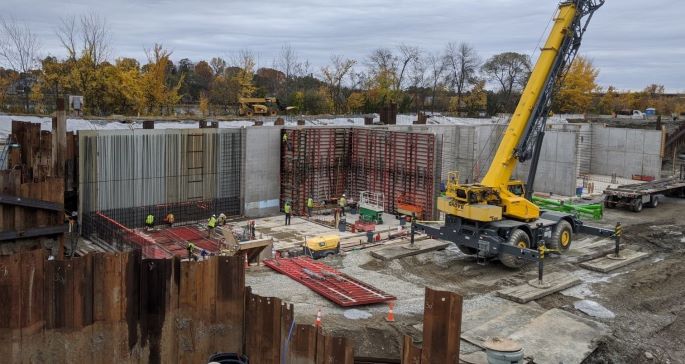
Work completed 10/12/20 to 10/16/20

The left fore ground is the southwestern corner of the shored CSO Tank excavation. Formwork is taking shape for wall placement #4 in the northeast corner. Three separate concrete wall placements have taken place along the eastern tank wall, progressing south to north.
S.E. Macmillan had a crew of twenty men on site this week. SEM stripped formwork from wall sections #2 and #3. They dismantled those gang forms, cleaned and oiled the individual panels and then reassembled them for wall section #4. One form face of both the exterior and interior #4 wall sections were set in place and then both curtains of reinforcement steel were tied. The closing form face was set into place and SEM installed the form ties and plumbing braces. Construction joint bulkheads were built for the exterior and interior full height tank walls. Scaffold framing and walk planking was put into place along the form tops for construction foot traffic. On Friday Macmillan needed another day to complete final wall-to-roof reinforcement steel tying and final form adjustments. Wall placement #4, about 240 cubic yards, is scheduled for Wednesday, 10-21-20. Concrete construction is anticipated go through the winter of 2020-2021 and into the Fall of 2021.

On Wednesday, 10-14-20, Josh Burke and Aaron Gardner tied reinforcement steel for the three-foot-thick, full height wall dividing the Davis Brook CSO Tank cell #1 and cell #2.
There are three CSO holding cells inside the tank, each will have a holding capacity of approximately 1.26 million gallons. When completed in 2022 the entire tank (3.8 million gallons) will be the largest under-ground tank in the State of Maine.
Work completed 10/5/20 to 10/9/20

S.E. Macmillan’s manpower for the week numbered nineteen. Monday and Tuesday Macmillan worked on completing formwork for wall section #3. They tied the last of the wall-to-slab reinforcement steel. They installed the form panel wall ties and adjusted them for wall thickness. They plumbed the formwork, checked alignment to square and marked the form tops for grade. Wednesday, 10-7-20, N.S. Giles’ pump truck arrived on site at 8:00 am and got set up for the placement. Two S.W. Cole concrete testing technicians also arrived ahead of the first mixer from O.J. Folsom. Folsom delivered 185 cubic yards to the site between 9:30 am and 3:00 pm, for an average of 34 yards placed per hour.
Thursday and Friday Macmillan pulled the form ties from the forms, stripped the east wall construction joint bulkhead and began dismantling form hardware. They stood a section of gang form panel for wall section #4 and started tying reinforcement steel for the three-foot-thick, full height eastern Tank wall.

H.B. Fleming had a crew of three men on site this week. On Monday and Tuesday, they erected and welded into place the two south east interior corner braces. On Wednesday they gathered their equipment, packed welders, cutting gas, hand tools and along with their crane moved everything off site for approximately a month. They will return in November to install raker braces along the west shoring wall.
Work completed 9/28/20 to 10/2/20
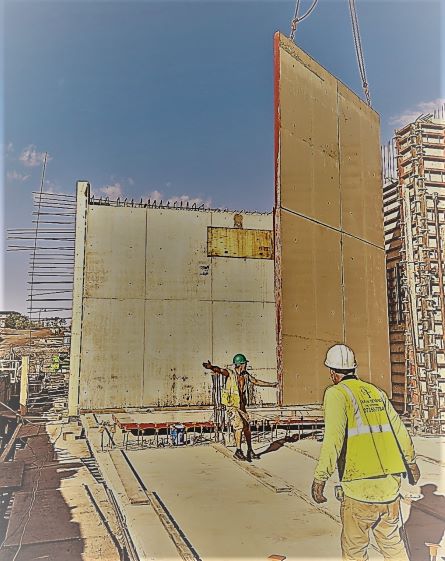
S.E. Macmillan had nineteen men on site. In order to move tools, make space for mechanized lifts and in preparation for forming wall section #3, they spent half a day cleaning and organizing slab surfaces #3 and #2. They stripped the wall placement section #2 construction-joint bulkhead and pulled the tapered form ties. They stripped formwork and scaffold from wall placement section #1, began breaking down those gang forms for cleaning and then reassembled them for wall section #3. They began tying reinforcement steel for wall section #3, assembled, stood and plumbed gang forms and installed tapered form ties for wall section #3. Wall section #3 is scheduled for placement next week.
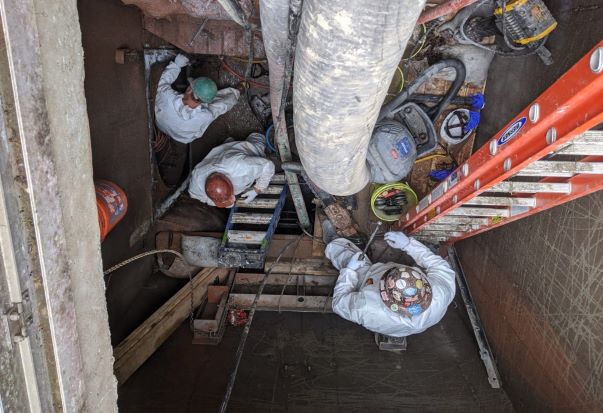
Macmillan had six men working on two sluice gates. They set up five 6” electric pumps in the eight-foot diameter Davis Brook CSO manhole and pumped into two separate downstream Penobscot Interceptor manholes. To isolate the CSO gate chamber from all flow, they inserted three large inflatable test plugs; one into the 42” CSO inlet, one into the 48” PI inlet and one into the 48” PI outlet. Once the pumps and plugs were in place and operational, they removed the Rodney Hunt frames, gates and actuators and replaced them with Whipps gates, frames and Rotork actuators. The Whipps gate frame bolted perfectly over the existing Rodney Hunt mounting bolts. The new valve stem also fit well through the existing ceiling stem bond-out.
H.B. Fleming had a crew of four on site. They finished welding and blocking the elevation -3.00 (raker brace) wailer, from soldier pile #21 W to the northwest ramp corner. They moved their welding equipment and crane to the southwest corner to finish raker wailer brace work next week.
Work completed 9/21/20 to 9/25/20
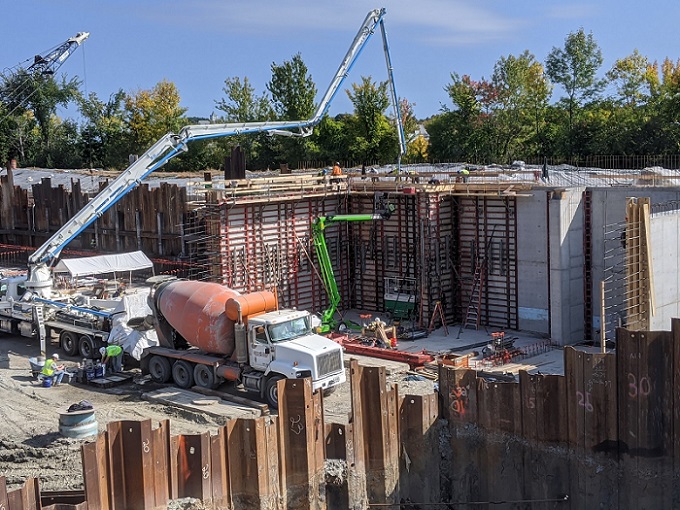
S.E. MacMillan had a crew of 19 on site this week. Working on wall placement #2, they finished tying reinforcement steel, building and mounting the first weir bond-out, standing concrete framework, connecting form ties, plumbing the formwork with bracing, and erecting form-top scaffolding. Concrete pump trucks are currently in high demand locally and MacMillan had intended to make the wall placement on Thursday but could not get a pump truck until Friday. Mainely Concrete Pumping set up at 7:30 a.m., two S.W. Cole technicians were on site at 8:00 a.m. for concrete batch testing, and Hughes Brothers delivered the first batch of concrete at 8:30 a.m. They tested, pumped, and placed 244 cubic yards, or about 45 cubic yards an hour, and finished at 4:00 p.m. Eddy Hughes was on site observing quality control. Friday was his last day at Hughes Brothers; he is retiring after more than 40 years overseeing more than two million yards of batched an delivered concrete.

H.B. Fleming had a crew of five on site this week. They welded interior corner bracing against the southwest and northwest shoring walls. They also installed threaded corner tensioners in both locations which act as an opposing tensioned force through the shoring wall and connected to wailers on the box wall and the ramp walls.
Work completed 9/14/20 to 9/18/20
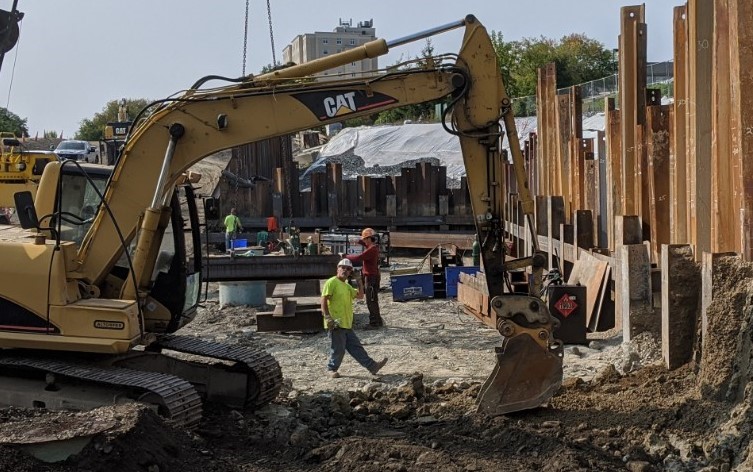
H.B. Fleming had five men on site this week. They welded wailers in the southwest shoring corner between soldier pile SP#14W to SP#1W, and they welded into place two upper inside corner braces. They also welded wailers between soldier pile, from #20W to #31W.
S.E. MacMillan had a crew of 19 on site this week. They stripped some formwork from last week's wall placement #1 and began tying reinforcement steel and standing gang forms for wall placement #2. With favorable dry weather conditions in place, they split the crew and began removal and replacement of two sluice gates which control the sewer flow at the intersection of the 48" RCP Penobscot Interceptor and the Davis Brook 8'x9' CSO box culvert conduit. On Tuesday, MacMillan set up five 6", three-phase electric pumps for bypass pumping. On Wednesday, they removed the frame and gate for the 42" Davis Brook conduit and installed the new 42" frame and gate. On Thursday, they removed the gate for the 48" Penobscot Interceptor. At a later date, they will continue removal of the 48" Penobscot Interceptor frame, installation of the new 48" frame and gate, and installation of new actuators for both gates.
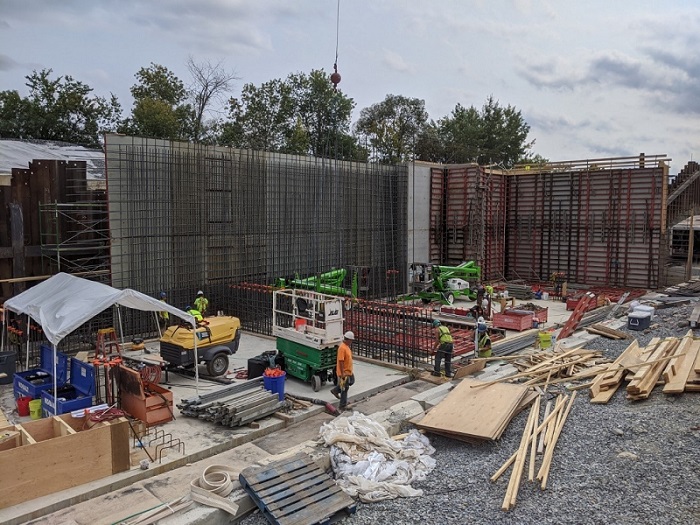
Work completed 9/7/20 to 9/11/20
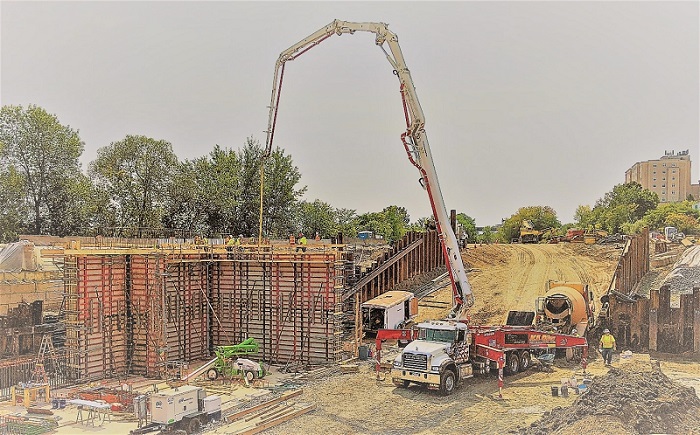
S.E. MacMillan had a crew of 15 on site for the short Labor Day holiday week. They completed the formwork and reinforcement steel for wall placement #1, located in the southeast corner of the Tank and on foundation slab #5. On Thursday, N.S. Giles' pump truck set up at 6:00 a.m., along with two concrete testing technicians from S.W. Cole. O.J. Folsom delivered 210 cubic yards of concrete between 7:15 a.m. and 1:00 p.m. and Giles pumped the concrete into the forms. Each concrete truck was tested for air, slump and test cylinders were cast for later compressive strength testing. MacMillan placed the pumped concrete into the forms in 4-5' lifts, vibrating each successive lift together. The wall placement was 3' thick and just over 24' high. There are 14 more 3'-thick, 24'-high Tank wall placements. MacMillan plans on continuing with Tank wall placements until cold weather concreting is necessary, and then they will switch back to placing foundation slabs through the winter. MacMillan also began the process of removing and replacing the 48" and 42" slide gates in the gate chamber on the southern end of the project.

H.B. Fleming had a crew of three on site this week. They completed threading and driving sheet pile into place and closed the shoring box for the Tank in the northwest corner. They began welding wailer bracing between soldier piles and installed wailers from SP#20W to #14W.
Work completed 8/31/20 to 9/4/20
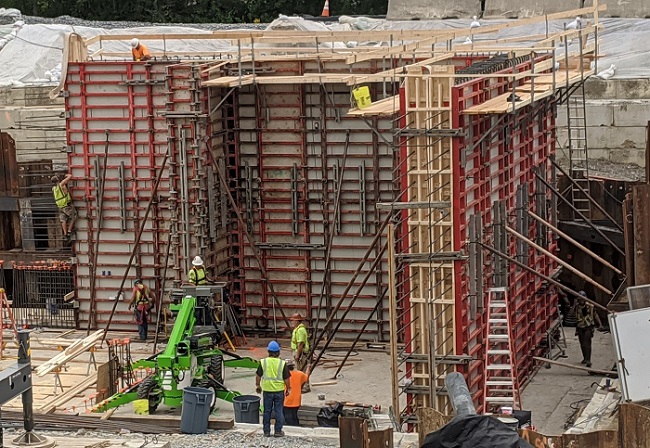
S.E. MacMillan had a crew of 14 on site this week. They completed standing/closing the wall form panels for wall placement #1, which is scheduled for Wednesday, 9/9/20. They worked on installing form ties, wailer braces, and construction joint bulkheads, and they tied reinforcement steel for wall connection to the top slab. They began excavating to elevation 0.00 in the southeast shoring corner so Fleming can install wall wailers next week.

H.B. Fleming had a crew of two on site this week. They spent two days moving drilling equipment off site, organizing their work space, and taking delivery of sheet pile. They drove sheets about 100 linear feet, from soldier pile #24W to #38W. #38W is on the northwest corner of the shoring system. They have approximately 40' to close the entire sheet pile shoring system. They expect to close early next week and then begin installing wailers and raker braces.
Work completed 8/24/20 to 8/28/20
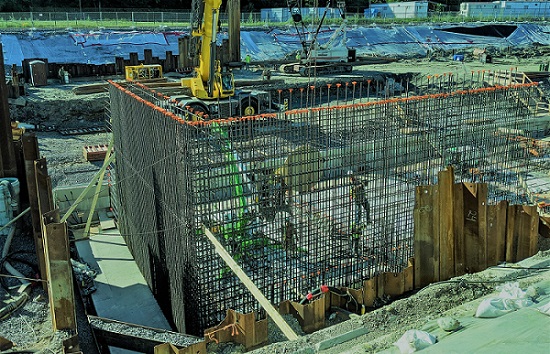
S.E. MacMillan had a crew of 14 on site this week. MacMillan took delivery of a Meva wall form system and another delivery of reinforcement steel. They tied 19.5 tons of reinforcement steel in place for wall section #1. They set the first two sections of gang forms on the outside wall face of the southeast tank corner. They expect to make the first wall placement next week.

H.B. Fleming had a crew of three workers on site. They drilled in the final casing and determined that the bedrock depth had fallen off enough that another soldier pile was not necessary. They spent a couple of days loading out miscellaneous tools, casing, steel, and equipment. On Thursday, they brought the vibro-hammer back to the site and began driving sheet pile against the soldier piles. They drove approximately 80 linear feet of sheets to bedrock or refusal, from soldier pile #9W to #24W.
Work completed 8/17/20 to 8/21/20
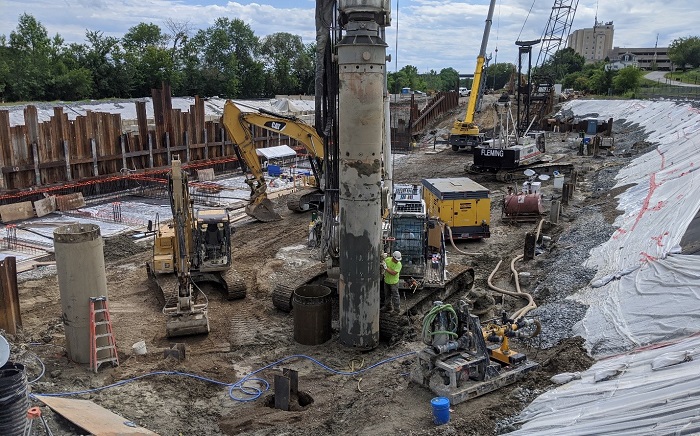
H.B. Fleming had four workers on site this week: two worked days, and two worked nights. The night crew predominantly drilled soldier pile sockets into bedrock. The day crew drilled and set casing into place for #36W, #37W, #38W, and #39W piles. Three days this week, Fleming placed Hughes Brothers' concrete for setting soldier piles #36W to #39W. With #37W pile, Fleming completed the west side soldier pile line, and also turned the corner and set two piles on the northwest shoring line. They have one more soldier pile to set near the northwest ramp wall. On Thursday, they removed the upper corner brace in the southeast shoring wall, which allowed MacMillan to start tying vertical wall reinforcement steel.
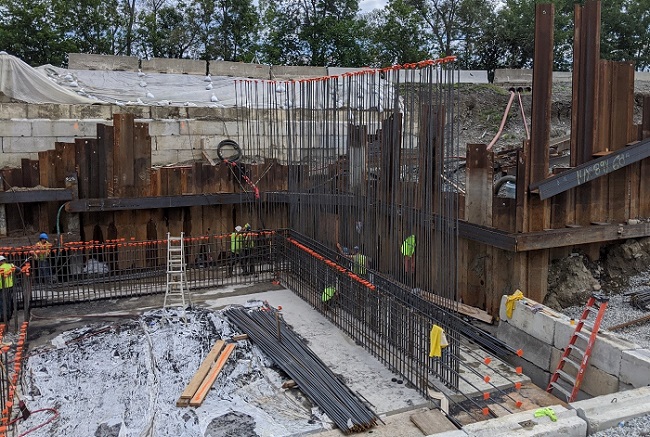
S.E. MacMillan had 14 workers on site this week. They transitioned from excavating, forming, and tying steel for foundation slab placements, to starting work on concrete wall construction. They spent four days moving, cleaning, and organizing slab formwork and related materials to a lay down area on the south end of the site. They excavated a 30'x70' Tank section about six feet deeper (to +/- el. -3.00) just north of the north ramp wall. This gives them a lower platform for better crane pick radius. On Thursday, they tied all the horizontal steel they could reach for the first wall section. On Friday, they started tying the 22.5' tall vertical bars for the exterior face of the wall over slab section #5.
Work completed 8/10/10 to 8/14/10
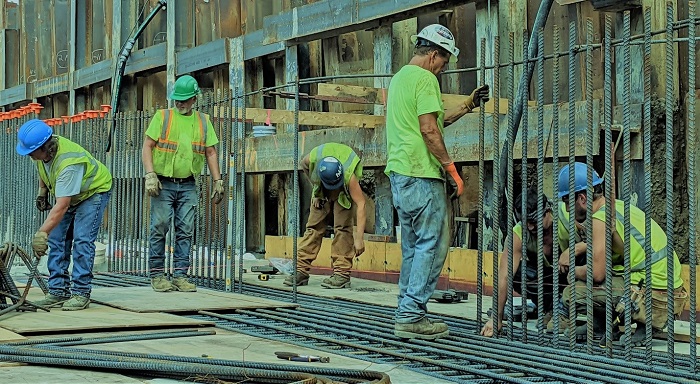
S.E. MacMillan had 14 workers on site this week. They completed tying the steel for the southeast Tank corner, slab section #5. They built and installed starter wall forms for the full height Tank walls and secured water stop in place for all construction joints. On Thursday, N.S. Giles' pump truck and S.W. Cole testing technicians arrived on site at 4:30 a.m. and set up slab placement #5. Hughes Brothers delivered 216 cubic yards of concrete, N.S. Giles pumped it into place, and MacMillan finished it with mag floats and steel trowels. On Friday morning, SEM stripped the form panels. N.S. Giles arrived at 9:30 a.m. and Hughes Brothers brought fill concrete to be pumped into the space between the new foundation slab and the shoring wall. MacMillan used about 40 cubic yards to fill the slab-to-shoring gap. The entire east shoring wall is securely pinned between the Tank slab, fill concrete, and undisturbed earth. Ground water is evident in the Tank excavation but not to the extent to which it was expected. SEM has six 3" electric pumps set in deep sumps and they are easily handling the groundwater. Next week MacMillan will transition to ganging together panel forms, tying wall steel, and placing the full height Tank walls onto the five east-side slab sections they have in place.
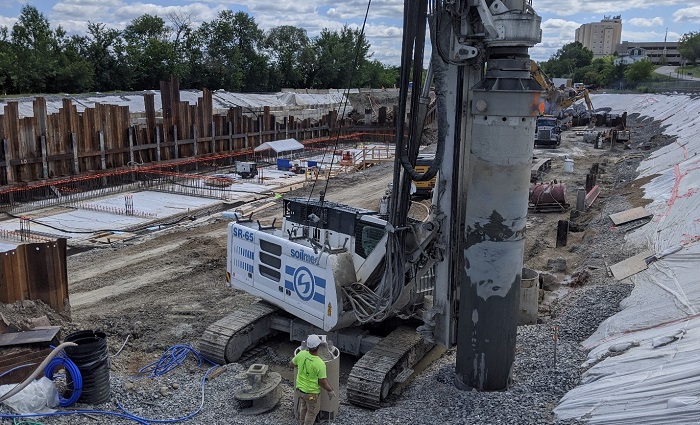
H.B. Fleming is still running a two-man day crew and a two-man night crew. This week they drilled six casings to bedrock, drilled six sockets to depth in bedrock, and set in concrete, soldier piles 29W, 31W, 32W, 33W, 34W, and 35W. They have five more soldier piles to drill and set. Once the soldier piles are in place, the drill and drilling crew will move off site and a sheet pile crew will return with a vibro-hammer to drive the remaining 250' of sheet pile and complete the shoring wall behind the soldier piles.
Work completed 8/3/20 to 8/7/20
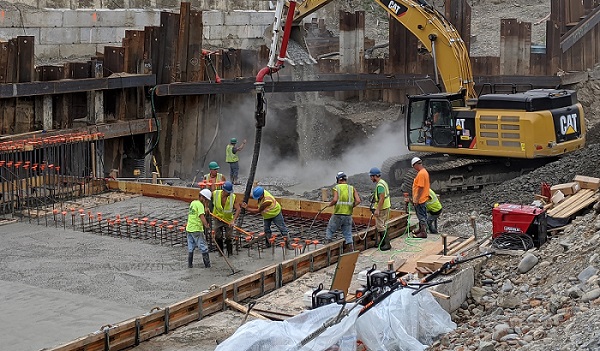
H.B. Fleming had a crew of four on site this week: two worked days and two worked nights. They drilled casings to bedrock, augured soil out of the casings and drilled bedrock piling sockets. They placed concrete for and set soldier piles 23, 24, 25, 26, 27, 28, and 30 West. They have 14 more soldier piles to drill and set, and then they will finish driving west side sheet piling behind the soldier piles. Fleming and MacMillan are considering a couple different bracing systems to complete the shoring system once the west side sheet pile wall is complete.
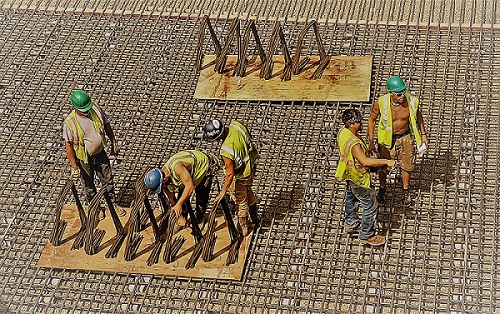
S.E. MacMillan's crew numbered 14 this week. They completed installing reinforcement steel and formwork for slab section #4, and placed concrete on Tuesday. N.S. Giles' concrete pump truck was on site at 4:30 a.m., S.W. Cole had two concrete testing technicians on site, and O.J. Folsom delivered 248 cubic yards of concrete between 5:00 and 10:45 a.m.
On Wednesday, SEM finished excavation for slab section #5. On Thursday and Friday, they put down filter fabric, graded 1.5" and 0.75" base stone, tied the bottom mat of reinforcement steel, built formwork, and connected form ties from existing slab concrete to #5 slab form panels. They will complete reinforcement steel and formwork and place concrete for slab section #5 next week. Once #5 is complete, they will begin construction of the full height wall sections, working from slab section #5 north along the east side Tank wall, back toward slab section #1. The concrete Tank walls will be 23' high and 3' thick.
Work completed 7/27/20 to 07/31/20

S.E. MacMillan had a crew of 14 on site this week. They started the week having completed the excavation for slab section #4 last week. They fine-graded the base stone and set the concrete brick which provide the correct spacing between the reinforcement steel and the slab bottom. They set up the first lift of formwork on the three sides away from the existing concrete, put the bottom reinforcement steel mat into place and built the second tier of formwork. The lower steel mat is held between the bottom and second tiers of formwork. Once the lower mat is in place and the second tier of formwork has been erected, they tie the "chairs" which hold the top mat and install the form ties, which holds the form in place. Each slab section is a rectangle, three feet thick. The form ties are steel rods running north and south about 50' long, and east and west about 40' long. After all the tie ends are secured in steel slots at the forms, both the N/S and E/W tie sets have their ends welded inside the formwork. After the ties are in place, the top reinforcement mat is partially tied into place and vertical steel is tied. The vertical wall steel is tied to both the top and bottom mats, therefore for better accessibility only part of the top mat is tied before the wall steel is tied. The final top mat bars are placed and tied last, along with formwork for bond-outs and water-stop. MacMillan has needed about seven work days to complete formwork and reinforcement steel construction for each slab section. They will place number four (of 15) next week.
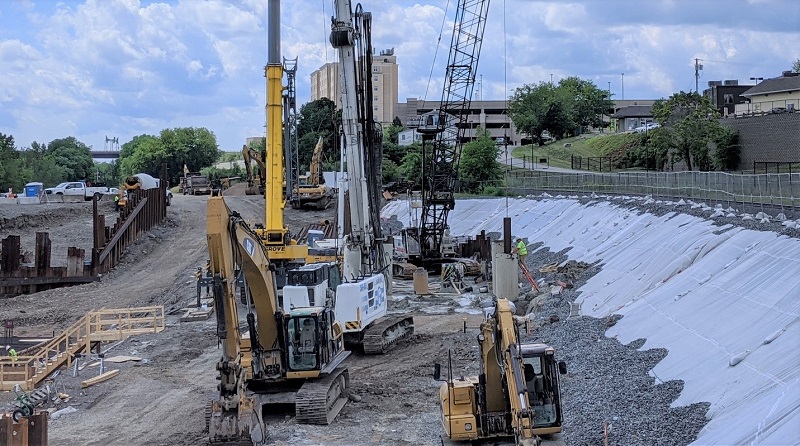
H.B. Fleming ran two work shifts this week, two men on days and two men on nights. They are drilling through soil overburden and into bedrock. They drill into bedrock to make a "socket" which, along with concrete fill, provides a solid anchoring cylinder for the "H" shaped soldier piles. The soldier piles are the structural support for the sheet piles which will be driven behind them, forming an interlocking sheet wall once all the soldier piles are in place. Fleming has about 20 more soldier piles to install. They're drilling to a design depth and the bedrock height has varied. This week they were drilling fairly deep into the rock, about 15' of rock socket depth for each pile. The piles are about 37.50' long and just barely can be seen above the current ground surface where Fleming is working. Fleming drilled the casings and set the piles #21West and #22West this week, and drilled casings #23West and #24West to bedrock.
Work completed 7/20/20 to 7/24/20
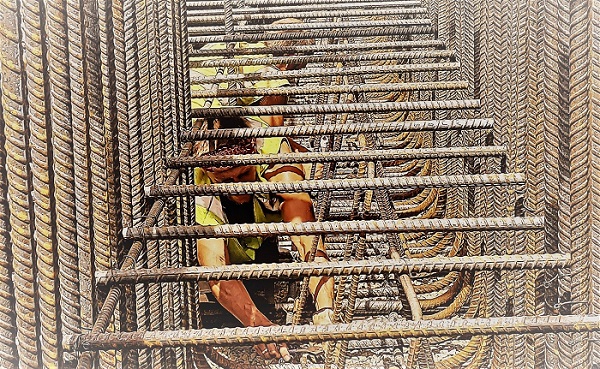
S.E. MacMillan had 14 people on site this week. They finished tying the reinforcement steel, formwork, form ties, and water stop for Tank slab section #3. On July 23rd, N.S. Giles set up their concrete pump truck at 4:30 a.m. Hughes Brothers began delivery of 240 cubic yards of concrete at 6:30 a.m. The concrete was placed by 11:15 a.m. and the slab was finished by hand with steel trowels. MacMillan excavated to subgrade, hammering out bedrock 1-3' above subgrade, put down fabric and base stone for slab section #4 to be placed on August 4th.
H.B. Fleming had four people on site week split into two-person crews: one crew worked a ten-hour day, and the other worked a ten-hour overnight shift. They installed west side soldier piles #16, #17, #18, #19, and #20.

Work completed 7/13/20 to 7/18/20
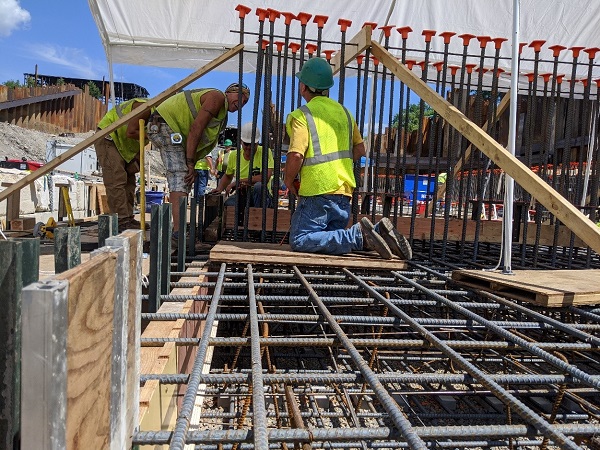
S.E. MacMillan completed formwork and reinforcement steel for the second (of 15) Tank slab concrete placements. On Tuesday, July 14, Owen J. Folsom delivered 245 cubic yards of concrete and N.S. Giles' pump truck pumped it into the forms. Eighty cubic yards an hour was placed from 5:45 to 9:45 a.m. The slab was finished by hand with steel trowels, covered with a curing blanket, and kept moist with a sprinkler. The forms were stripped the following day and fill concrete was pumped between the slab and the shoring wall for extra sheet pile anchor. MacMillan excavated to subgrade for the next slab section, put down fabric and fine graded the stone base. They started formwork and tying reinforcement steel. They plan on making another slab pour, #3, next Thursday, July 23.
H.B. Fleming set piling #15West in place on Thursday, July 16. They are into a section of the shoring on the west side shoring wall that requires a deeper design depth and the bedrock there is higher than anticipated so their progress has been slowed. They are drilling soldier piling sockets 15 to 20' into bedrock at about 6" an hour. They are drilling 42" diameter casings, 24' long through about 10 or 15' of overburden to bedrock. The soldier piles are H-14/89 and are 37' long. The casings act as formwork for setting the H-pile into place.
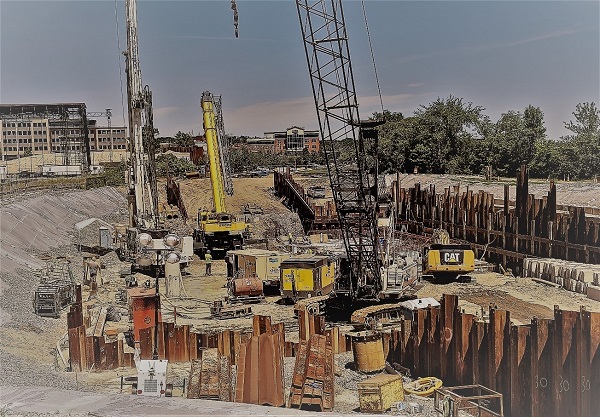
The photo above is a view from the south looking north into the Tank excavation. The Penobscot River is on the right, Pan-Am's rail tracks are on the left. MacMillan is working on placing the Tank concrete base slab on the right and Fleming, on the left side, is working on the west side shoring wall. Fleming has installed roughly 640' of shoring wall, about 230' remain to be installed. On the east side, MacMillan is working 30' below finish grade. On the west side, Fleming is drilling and setting soldier pile 53' below finish grade. Ground water has been managed so far by four 3" electric pumps.
Work completed 7/6/20 to 7/10/20

S.E. MacMillan had 14 people on site this week. They excavated to subgrade, put down fabric, crushed stone base, formwork, and tied both bottom and top reinforcement steel mats. Concrete placement #2 is scheduled for Tuesday, July 14.
H.B. Fleming's crew size was diminished this week by four, with only two on site the last three days. They completed drilling sockets in bedrock, placing concrete and settling soldier piles for #11West, #12West, #13West, and #14West. They have been drilling about 15' into bedrock at a rate of 6" of depth an hour. The sheet pile crew will return once the drilling crew has moved far enough ahead to warrant more sheet pile work
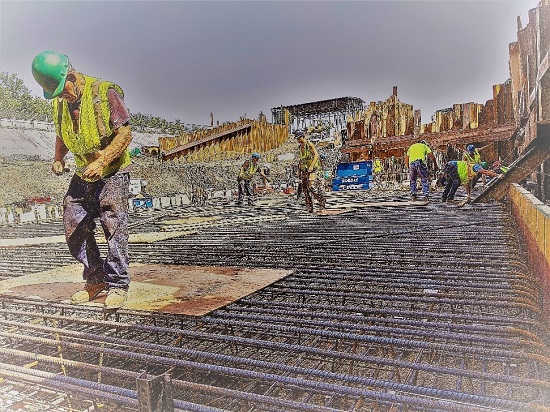
Work completed 6/29/20 to 07/03/20

S.E. MacMillan had 15 people on site this week. They completed formwork, installed water stop, reinforcement steel, and form ties for placement of the first Tank foundation slab section. On July 2, N.S. Giles' concrete pump truck arrived on site at 4:00 a.m. The first Hughes Brothers mixer arrived on site at 4:30 a.m. Hughes Brothers assigned six mixers for the placement. Two S.W. Cole technicians, along with a Hughes Brothers representative, were on site to monitor concrete quality and take test cylinders. They started pumping concrete at 4:45 a.m. and finished at 8:45 a.m. 210 cubic yards were pumped into the formwork. An average of five trucks per hour were delivered, tested, and pumped into the formwork.
H.B. Fleming had a crew of six people on site this week. They finished work on the east side shoring wall. They welded the final wailer braces, finished checking and driving all sheet piling to a final depth. Fleming also determined that no further raking braces will be installed on the east side. MacMillan will dig to subgrade as necessary for each slab section, place the slab, and then place fill concrete between the slab and the shoring wall. Fleming finished drilling sockets in bedrock for #6West and #10West soldier piling. Drill depth into bedrock for these two sockets was 19.30' for #6W and 13.68' for #10W. Both of these piles were set in concrete. Casings for #11W and #12W were drilled into place.
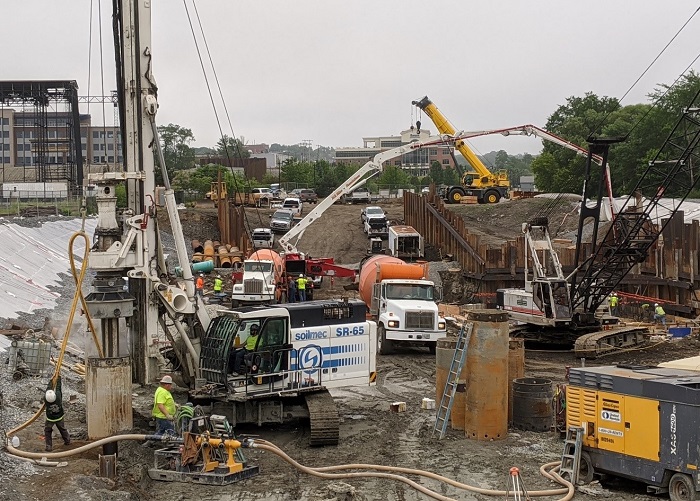
Work completed 6/22/20 to 6/26/20
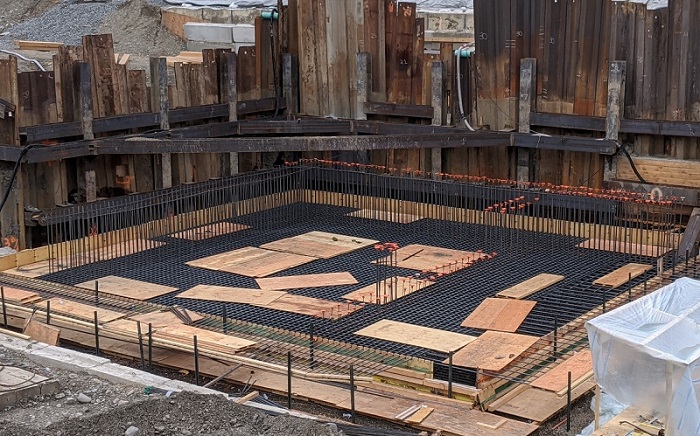
S.E. MacMillan had 13 people on site this week. They received the first reinforcement steel delivery on Tuesday, about 50,000 pounds out of 1,600,000 pounds to be delivered to the site before the end of next year. MacMillan bought a Grove hydraulic crane and it was delivered to the site on Monday. The first concrete section to be placed is the northeast corner of the tank, a 41' x 47' section, 3' thick. They excavated to subgrade, put down a non-woven filter fabric, put down 1' of crushed stone to grade, set formwork, and tied about 90% of the reinforcement steel. The first placement is scheduled for Wednesday, July 1, 2020. MacMillan had an excavator operator excavating for Fleming at sheet locations where obstructions were impeding full sheet depth.
H.B. Fleming had six people on site this week. They welded wailer braces on the east shoring wall and hammered sheets to full depth where there had been obstructions. Fleming worked on connecting the southeast ramp and shoring walls with threaded corner anchors. They drilled 10' deep sockets into bedrock for soldier pile #8West and #9West, placed concrete into the sockets, and set the piling into place. On Wednesday, their drill suffered a breakdown and a man was sent to Pennsylvania for replacement parts. There is a total of 46 soldier pile on the west side Tank shoring wall.
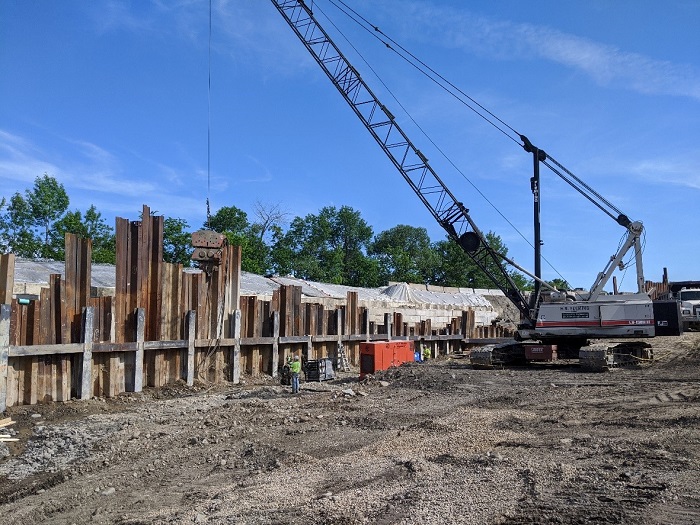
Work completed 6/15/20 to 6/19/20
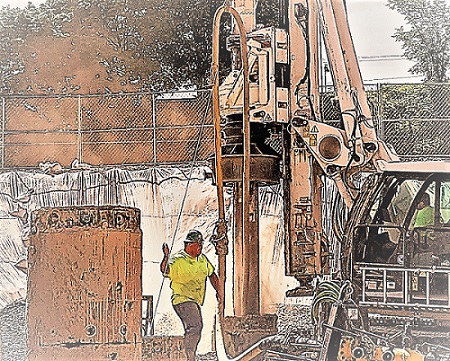
S.E. MacMillan had a 12-person crew on site this week. There are 15 separate concrete placements necessary for the base of the Tank. The first section is in the northeast corner of the Tank, is 3' thick, and measures 41' x 47'.
MacMillan excavated to subgrade for placement #1, put down a non-woven geotextile and then a foot of crushed stone to a fine grade. On top of the stone they will set the form work, tie reinforcement steel, and place the first section of the concrete Tank foundation slab. There were four men building concrete forms which will be hauled to the site and assembled. MacMillan hopes to make the first concrete placement on July 1st.
MacMillan bought a 100-ton Grove hydraulic crane this week and will have it delivered to the site on Monday, June 22nd. This crane will move forms and reinforcement steel into place.
H.B. Fleming had six people working on site this week. The drilling crew drilled casings, sockets into bedrock, and set piling into concrete for soldier pile #1W, #2W, #5W, and #7W. Fleming says the bedrock is at about elevation -10.00, or about 9' along the southwest shoring wall.
The pile driving crew worked on bracing. They hung and welded corner bracing into place for the southeast Tank corner and ramp wall and welded another 40' section of raking brace wailer between soldier pile #22E to #28E. Fleming also installed another course of threaded through-wall, wailer to wailer tie backs, from the southeast Tank wall the southeast ramp wall.
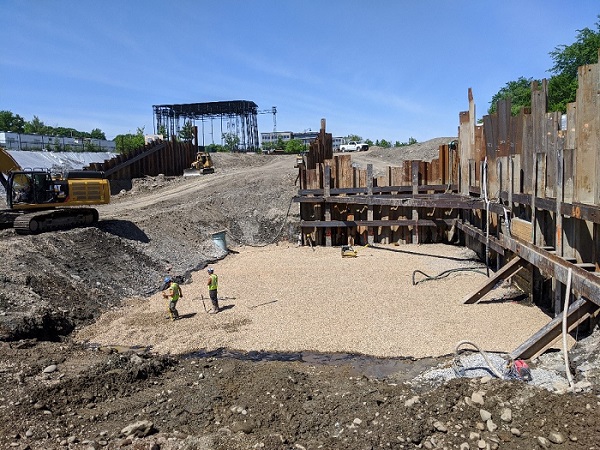
Work completed 6/8/20 to 6/12/20
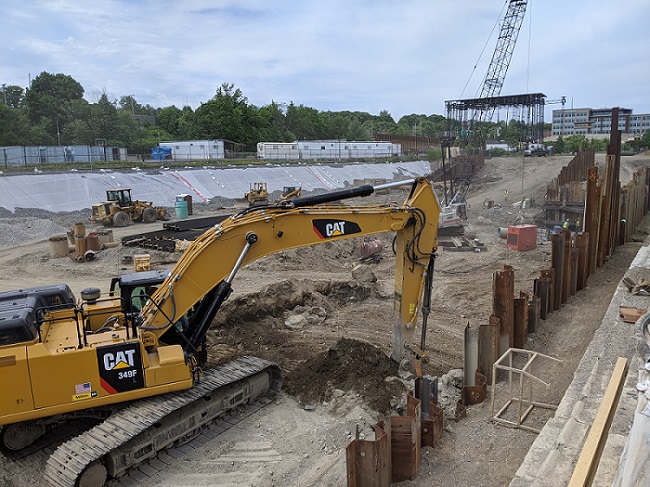
S.E. MacMillan had ten men on site this week. MacMillan worked on excavating the northeast corner of the Tank. They worked with H.B. Fleming on timber lagging between soldier pile #8East and #9East and welded steel covering to patch voids in the sheet pile wall where obstructions denied the desired sheet depth. MacMillan excavated to elevation -6.00 in the northeast corner, where the first concrete placement will take place. Elevation -6.00 is 28' below finish grade (elevation 22.50). MacMillan will still need to excavate six more feet to -12.00 where a foot of crushed stone will be placed, on top of which the concrete tank will be built. De-watering is currently being managed with three 3" electric pumps. Previous soil borings had indicated more ground water than is currently being realized. If necessary, MacMillan has over 40 three-phase electric pumps ready for de-watering.
A representative of Dimension Steel from Scotia, New York was on site this week to discuss the first reinforcement steel delivery on June 23rd. The first concrete placement will need 26 tons of reinforcement steel and 220 cubic yards of concrete.
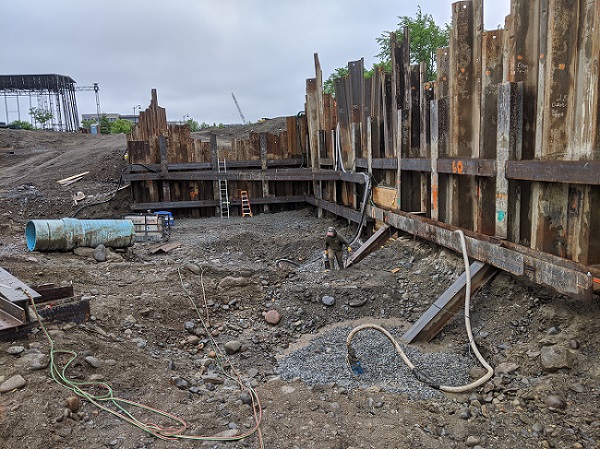
H.B. Fleming had six men on site. Fleming set soldier pile #3West and #4West. They hammer-drilled sockets in casings #1W, #2W, and #5W. They encountered bedrock at elevation -9.00. Ten feet deeper at -19.00 is the sub-grade elevation in the southwest Tank corner, 41 feet below finish grade.
Fleming installed threaded shoring anchor restraints in the corner of the northeast shoring wall to the northeast ramp wall. They finished driving the east side sheet pile to desired depth and installed wailer bracing at elevations -6.00 and -2.00 between SP#1E to SP#12E.
Work completed 5/26/20 to 6/5/20
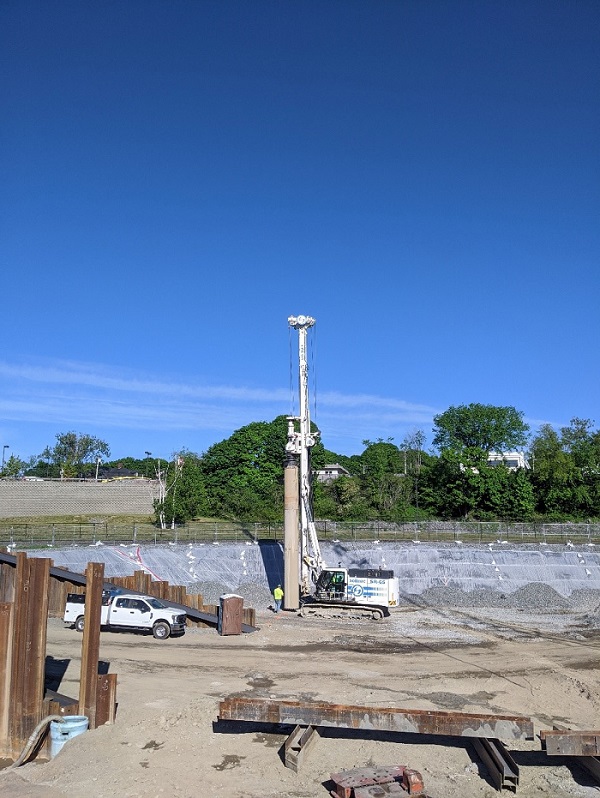
H.B. Fleming had a crew of six men on site during the last week of May, and five men for the first week of June. S.E. MacMillan was not on site during the last week of May, and had ten men on site for the first week of June.
The primary activities on site were pile driving and iron work. Fleming has completed about a third of the shoring system. MacMillan can begin the final excavation phase on the east side in earnest once Fleming has completed the soldier pile, sheet pile, and bracing on the east side of the Tank excavation.
MacMillan's construction progress schedule indicates Fleming is on schedule and likely to complete the shoring system by September 1, 2020. The first concrete placement is shown on the schedule for September 1, 2020.
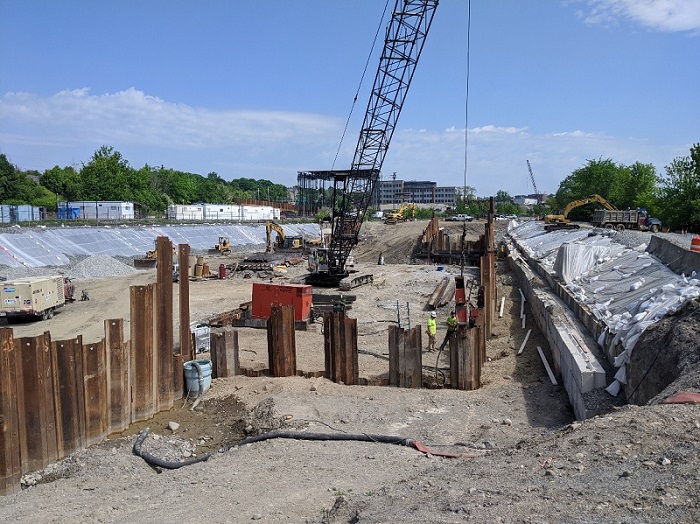
Fleming drilled anchors through the shoring wall which were meant to act as tie-back restraint. They drilled in four anchors and began to use a hydraulic testing mechanism to pull tension against the anchors. The anchors would not achieve desired test resistance pressure and so Fleming decided to use an alternative, inside the wall, bracing method. The inside bracing method was initially less favorable for reasons of space limitations inside the shored area. The anchors did not pass because of the granular nature of the soils and their instability due to the ground water pressure.
Fleming set the last four east side soldier pile in place and completed the east side sheet wall from the north to south ramp walls. Fleming also braced the northeast corner, attaching wailers to soldier pile and between soldier pile.
S.E. MacMillan excavated to elevation -5.00 (about 32 feet below original grade) in the northeast corner for the installation of an added wailer which will be part of the change from drilled anchor restraints to a bracing system. A few of the sheets are still above the desired depth, leaving voids in the sheet pile wall. Some of these voids will be covered with 8x6 timbers placed inside the vertical soldier pile flanges. MacMillan worked with Fleming to excavate boulder obstacles and try to drive sheets to the full desired depth.
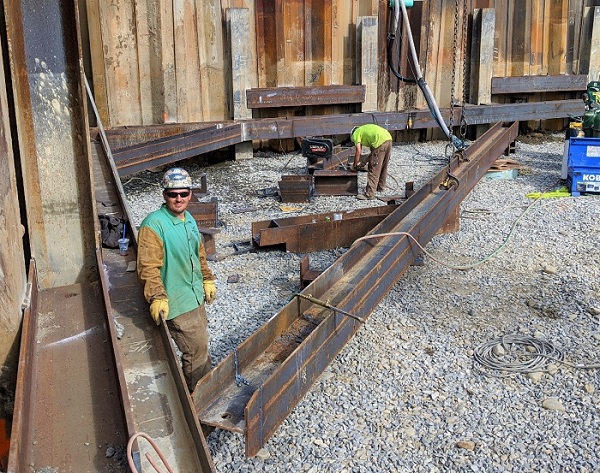
Work completed 5/18/20 to 5/22/20

H.B. Fleming had a six-man crew on site. They welded H-pile wailer sections between soldier pile. These are part of a shim system providing complete support for the sheet wall against the continuous wailer which will be put in place across the Tank side flange of both the vertical soldier pile and the H-pile wailer filler. These shim/filler wailers are complete across soldier pile bays from SP#1 to SP#14, and are necessary as the sheet pile are in place on an irregular line.
Fleming installed SP#22, SP#23, SP#24, and SP#25. They drilled into place casings #26 and #27.
S.E. MacMillan was not on site this week.
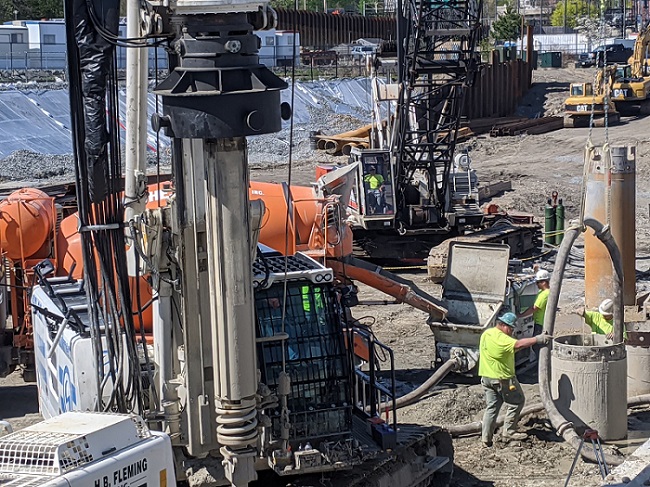
Work completed 5/11/20 to 5/15/20

H.B. Fleming had a crew of six on site. They installed soldier pile #19, #20, and #21, and they drove sheet pile approximately 100 linear feet from soldier pile #18 and they attached the 14x89 H-pile wailer to the northwest shoring ramp wall.
S.E. MacMillan had a crew of ten on site. They began excavating east of the Tank centerline to elevation -2.00 from soldier pile #4 to pile #14, and also cleared the wooded strip of MDOT land between the I-395 Main Street off-ramp and the Roundhouse fill site.
S.W. Cole had a crew of five on site for two days this week. They made ten soil sample borings. Lab analysts will determine whether the deeper site soils have not been contaminated and therefore can be safely used off site.
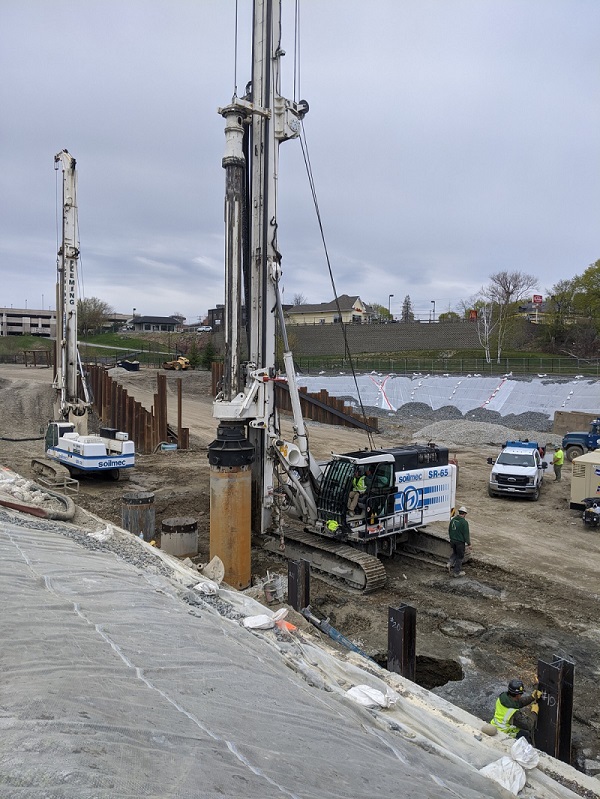
Work completed 5/3/20 to 5/9/20
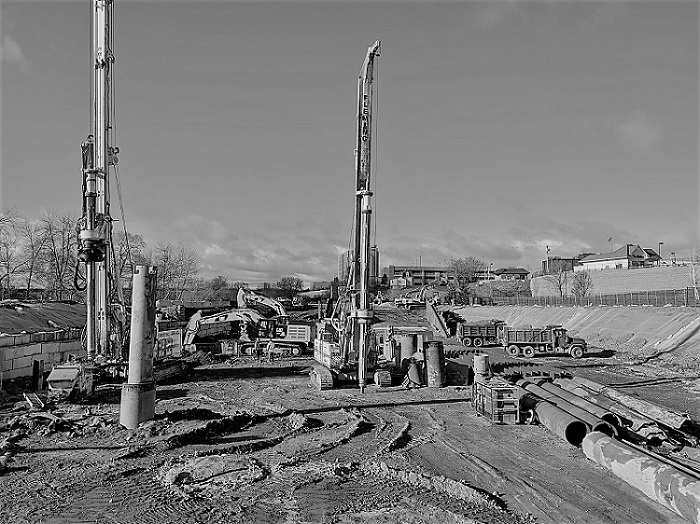
H.B. Fleming had two men on site this week. They drilled in the casings and installed four soldier pilings: #15, #16, #17, and #18 along the east side of the Tank excavation. Soil conditions have prompted MacMillan to pre-dig casing locations.
S.E. MacMillan had an eight-man crew this week. They excavated to remove boulders and timber obstacles at casing locations to facilitate pile work along the southeast line of the Tank excavation. They also finished rip-rapping the soil filter pond outlet, screened loam at the Roundhouse site, installed perforated pipe for dewatering along the entire length of the west side of the Tank excavation, and stockpiled gravel on the former Barret Paving site.
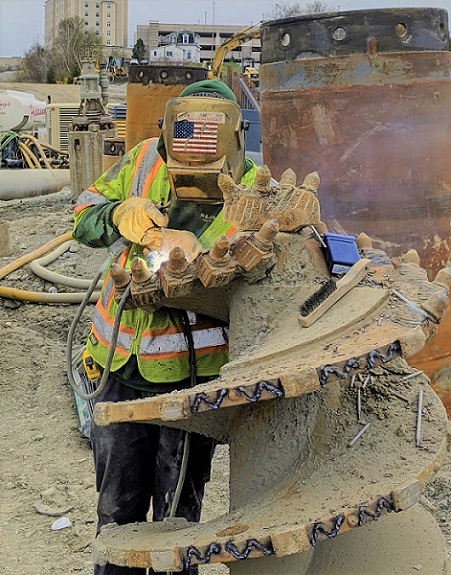
Work completed 4/27/20 to 5/3/20
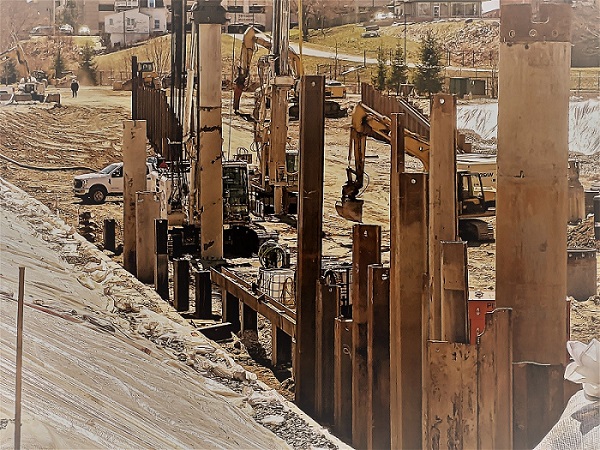
H.B. Fleming had a five-man crew on site. They drove about 38 linear feet of sheet piling along the northeast end of the Tank excavation, around the corner, and south along the east wall of the Tank. There are boulders below grade in some locations holding the sheets up from their designed depth and these boulders will have to be excavated out.
Fleming also drilled casings to bedrock for soldier pile. Two casings this week had sockets drilled into bedrock. Fleming pumped concrete into these two sockets this week, set the soldier pile into the concreted sockets and removed the casings. Sixteen of 32 soldier pile have been set into bedrock on the east side of the Tank excavation. The west side of the Tank excavation has another 45 soldier pile to be installed.
Fleming began building the bracing necessary for the ramp wall shoring. Three of four wailer braces were welded into place, two on the south ramp and one on the north ramp.
S.E. MacMillan had an 11-man crew on site. They put up a fence and a gate between the Roundhouse fill site and the haul road as a barrier against the public's access to the VRAP material being stockpiled there.
MacMillan ran an underground temporary power cable from temporary panel #1 to temporary panel #2. Each of these panels will service ten three-phase electric pumps meant to dewater the north and east sides the shored excavation. Another 20 pumps will be powered by mobile generators.
MacMillan built the rip-rapped outfall for the soil filter pond, ran the 12" pipe and set the 4' diameter catch basin. The pond itself will not be built until the Tank is completed and finish grade is established. They also built a gravel lot for rebar laydown and fabrication.
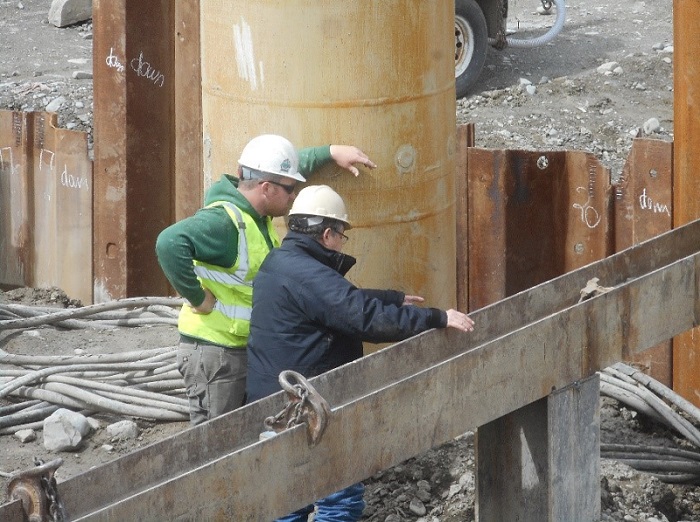
Work completed 4/20/20 to 4/24/20

S.E. MacMillan excavated for dewatering sumps and ran discharge lines to silt bags in sediment ponds this week. They have been running pumps off generators from sumps on the west and east sides of the Tank excavation in an attempt to gauge the ground water elevation ahead of the sheet pile shoring construction. The shoring system is meant to hold back the earth outside of the construction area and provide a cofferdam-type barrier, not completely watertight but impermeable enough that existing ground/tide water elevations can be successfully managed and pumped out of the excavation area into the sedimentation control ponds.
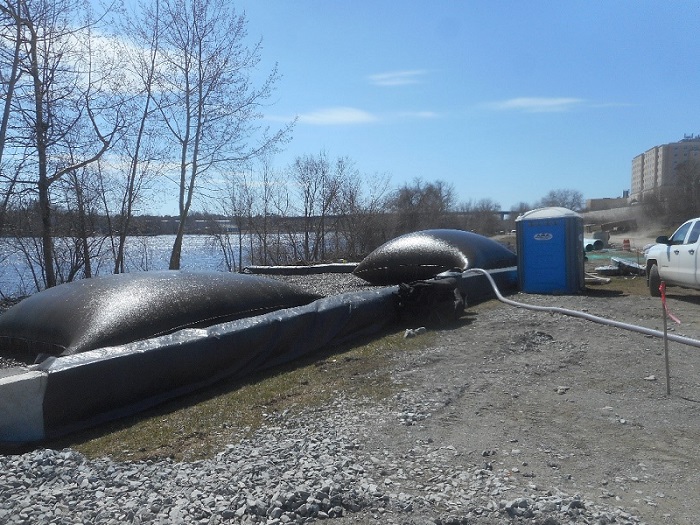
Pictured above: Two silt bags filter water inside MacMillan's southern-most sedimentation pond.
MacMillan added to the concrete cover wall they've been placing along the face of the existing Davis Brook 8'x9' box culvert sewer. This is an added support against the exposed joints/seams in the structure.
H.B. Fleming set four soldier piles into concreted bedrock sockets this week; piling #9, #10, #11, and #12. They started drilling/excavating for #13 and #17 casings. They also finished driving sheets for the southern ramp walls and began to weld bracing support on those walls.
Work completed 4/13/20 to 4/17/20
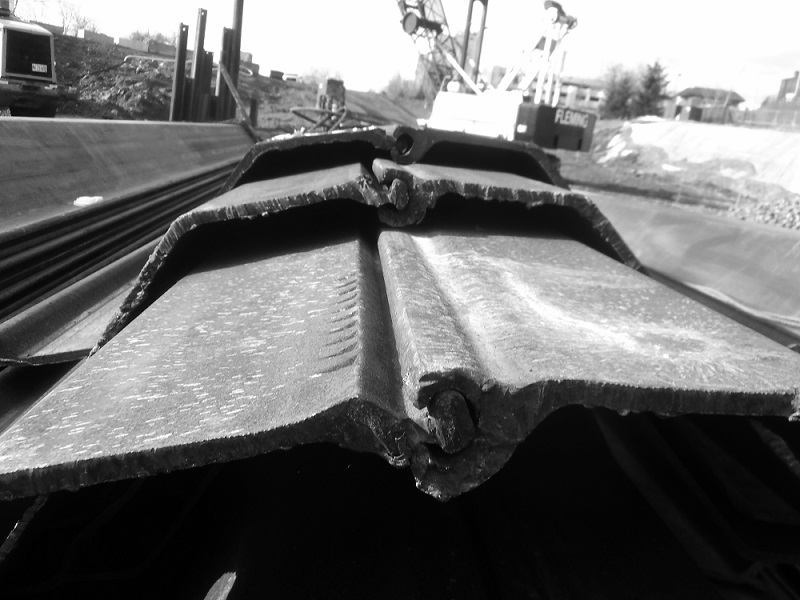
S.E. MacMillan excavated to install vertical pipe as sump sleeves for dewatering pumps. They installed three of these sumps, each used 36" diameter PVC pipe. They cut slots in the spigot pipe ends and stood them on a bed of 2" crushed rock. MacMillan buried these sumps to elevation -16.00, about 30' below the original walking path finish grade. They connected these sumps to each other with a stone trench wrapped in non-woven filter fabric. Each sump can accommodate a 6" or 3" pump as necessary. This sump/trench line when finished, will extend across the entire length of the Tank foundation. Once the shoring has been installed around the entire foundation excavation, MacMillan will have to dig some of these sumps down another 5' in order to be dewatering 2' below the lowest Tank concrete foundation elevation.
H.B. Fleming drove sheet pile for the south east and west ramp walls. These walls will provide shoring for the ramps on the north and south ends of the Tank. The ramps will be used for further excavation access. Fleming is using an 11,000 pound vibrational hammer to drive the sheet pile.
Fleming also drilled casings into the ground for soldier pile. They are working on the northeast corner of the Tank excavation. They drilled/excavated into place casings for piling 3, 8, 9, 10, 11, and 12. Casings and soldier pile are numbered consecutively from the northeast Tank corner to the southwest Tank corner. They also set H-piling 3, 4, 7, and 8. There are 37 soldier pile on the east side of the Tank.

Work completed 4/6/20 to 4/10/20
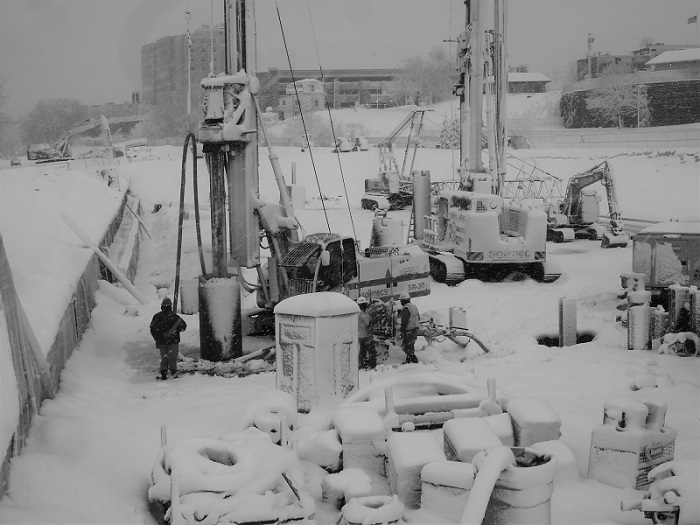
S.E. MacMillan had a ten-man crew this week. They built a six-foot high concrete wall as protective cover against the exposed 8'x9' box culvert sewer. Soldier and sheet pile shoring will be installed near this sewer conduit. MacMillan also worked on site access roads, dewatering sumps, and pump discharge piping.
This week, H.B. Fleming had a four-man shoring crew. Fleming is working in the northeast corner of the Davis Brook CSO Tank. They are building the shoring system necessary for excavating the deepest material from the Tank foundation. Fleming has two Soilmec drill rigs on site, they are built for large diameter drilling into soil and rock. Both drill rigs are capable of drilling over 100 feet into the earth. They are drilling 30 and 36 inch steel casings down to bedrock. Inside the casings, they drill through and excavate out soil and rock. Once the casing is at refusal they drill inside the casing, into the bedrock, with a large pneumatic rock drill. Into these bedrock drill holes, or sockets, Fleming pumps concrete and then stands thirty-foot long H-pile into the concreted socket. These are soldier pile, embedded in the bedrock and reinforcing the entire sheet pile shoring wall. The soldier/sheet pile system will remain in the ground after the 3.8 million gallon Davis Brook CSO Tank has been built. The bottom of this shoring system will be approximately 40 feet below finish grade.
Fleming installed four soldier pile this week on the northeast Tank corner and drilled casings for two more. There are 83 soldier pile to be installed, 37 on the east Tank wall and 46 on the west Tank wall. Two of the four casings have sockets drilled into bedrock and are ready for concrete and soldier pile next week. They are progressing south along the east side of the Davis Brook CSO Tank foundation.

Work completed 3/23/20 to 3/27/20
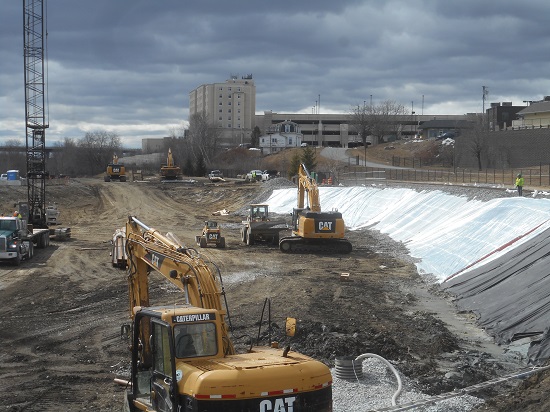
S.E. MacMillan completed their first Tank excavation phase, which included the removal of the amphitheater mound (finish grade elevation 32.00) to elevation 5.00. MacMillan has hauled just over 50,000 cubic yards of soil to the Roundhouse fill site. This fill has been compacted and graded up against the MDOT's retaining wall along the I-395 Main Street off-ramp. The second phase of excavation will take place after shoring has been installed. This second phase excavation will reach elevation -24.60 to the bottom of the deepest footing, or 56' below the top of the amphitheater mound.
MacMillan stabilized the east and west backslopes of the Tank excavation with a cover of stone ballasted 6 mil reinforced poly on the east (river) side and non-woven filter fabric and 6 mil poly over the west (railroad) side. The permanent fence against the railroad right of way was taken down and a temporary fence was erected closer to the tracks to allow for the erection of sharing and Tank concrete construction.
Shoring contractor H.B. Fleming continued to mobilize. They started driving sheet pile for the north side access ramp on Monday and finished the east side sheets of the ramp on Wednesday. They have been receiving a steady stream of sheet pile deliveries. They have received the entire H-pile pieces for the project, 41 sixty-foot H-beams each weighing 10,680 pounds. Fleming started drilling the first H-pile to be set into the bedrock with concrete. There are 83 of these soldier piles in the shoring system. Each 30'-long soldier pile will be placed in a 30" diameter socket drilled 6' into the bedrock and then set in concrete.

Work completed 3/16/20 to 3/20/20
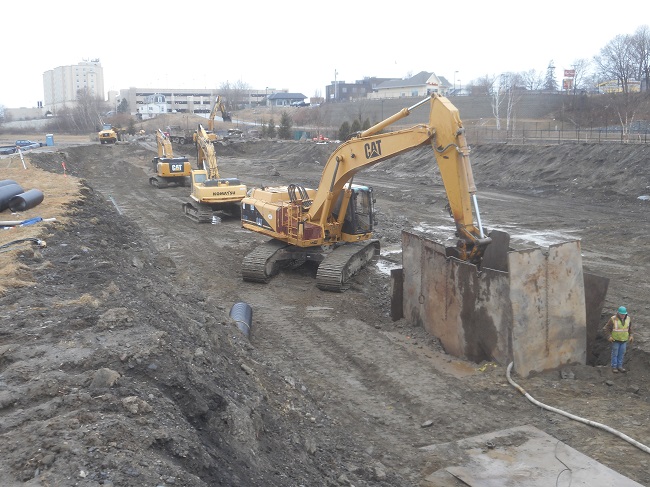
S.E. MacMillan excavated about 9,000 cubic yards from the CSO Tank location and hauled it to the roundhouse fill site. They are excavating to elevation 5.00 around the entire perimeter of the CSO Tank, with another twenty feet outside the tank perimeter to accommodate the necessary shoring system to be constructed.
H.B. Fleming, the shoring contractor, arrived on site Tuesday. They hope to start driving sheet pile on Monday, 3/23/20. They set up a crane, a 90-ton augur drill, and unloaded sheet pile and 30" diameter augur bits.
Surveyors from Plisga & Day were onsite to survey recently established monitoring points on the railroad and 8'x9' Davis Brook sewer. These points are markers indicating the existing locations of the train rail and the sewer structure and the points will be continually monitored for movement throughout the excavation, dewatering, and construction process.
S.E. MacMillan dug a test sump to elevation -7.5, which is still about six feet above subgrade or bottom of stone bedding for the new CSO concrete tank. This depth is about 39.50 feet below the top of the amphitheater mound's original existing finish grade elevation 32.00. They dug this well/sump to see what the soil condition is at that elevation and see if it was possible to lower the water level in the sump pipe with one three-inch, three phase electric pump. They found they could lower the water in the sump even at high tide on Wednesday morning.
A section of in-place railroad track and ties was excavated this week at elevation 5.00, which is about ten feet below the elevation of the rail yard when it was closed in 1992.
The roundhouse fill site has risen to near the top of MDOT's retaining wall at the I-395 Main Street off-ramp.

Work completed 02/03/20 to 03/06/20
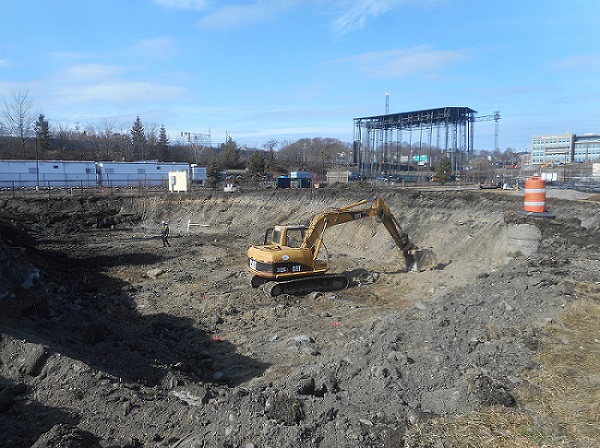
Fenced and closed to the public the lower end of the Waterfront Park and walkway from the southern end of the Railroad Street parking lot to Dutton Street beneath the train bridge.
Installed erosion control for the 3.8-million gallon CSO tank site and roundhouse fill site. The roundhouse fill site is part of the land acquired by the City from the railroad, as well as a VRAP site that MaineDOT has agreed to allow the City to fill up against the I-395 retaining wall. VRAP is the City's agreement with Maine DEP for voluntarily managing the contaminated soils from the acquired railroad property.
MacMillan built four 50'x100' sedimentation control ponds for handling the dewatering pumps. MacMillan expects to use 32 three phase electric pumps: 16 3" and 16 6". They are excavating to elevation -12.00 and the average height of ground water at high tide is elevation 5.00.
MacMillan built haul roads for the CSO tank excavation and the roundhouse fill site. The lower end of Dutton Street has been closed to the public and a ramp was built at the entrance of the roundhouse to ease truck access and to safely separate the haul traffic from the public.
Eighteen light poles from Waterfront Park have been taken down and stored for reinstallation in 2022.
MacMillan has excavated and hauled about 13,000 cubic yards of material to the roundhouse site.
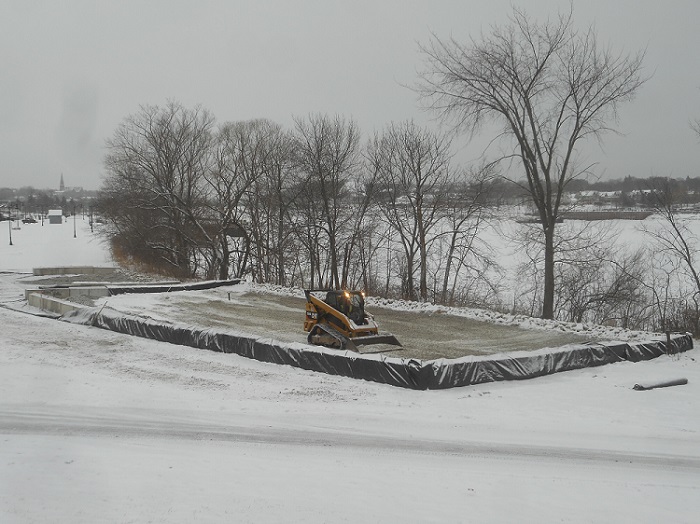
Davis Brook CSO Storage Tank project details
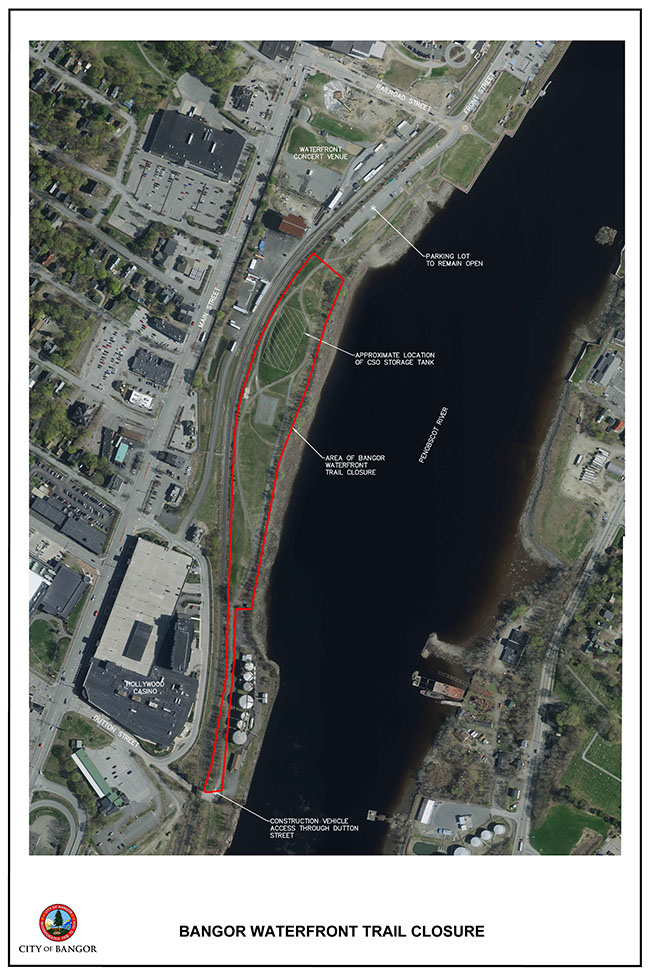
In preparation for the 3.8 million gallon Davis Brook CSO storage tank, the City of Bangor will close a portion of the Bangor Waterfront trail beginning Monday, February 10, 2020. The Davis Brook CSO storage tank is a significant project that will reduce the number and volume of combined sewer overflows that enter the Penobscot River. The project is expected to take two years to complete. The closure will begin at the south side of the parking lot behind the Waterfront Concerts venue and will continue to Dutton Street. No public access will be allowed during the closure to allow for a safe and secure construction zone.